Exhibit 99.4
Hong Kong Exchanges and Clearing Limited and The Stock Exchange of Hong Kong Limited take no responsibility for the contents of this announcement, make no representation as to its accuracy or completeness and expressly disclaim any liability whatsoever for any loss howsoever arising from or in reliance upon the whole or any part of the contents of this announcement.

(a joint stock limited company incorporated in the People’s Republic of China)
(Stock Code: 00525)
2015 ANNUAL RESULT ANNOUNCEMENT
The Board of Directors of Guangshen Railway Company Limited (the “Company”) is pleased to announce the audited results of the Company and its subsidiaries for the year ended 31 December 2015. This announcement, containing the full text of the 2015 Annual Report of the Company, complies with the relevant requirements of the Rules Governing the Listing of Securities on The Stock Exchange of Hong Kong Limited in relation to information to accompany preliminary announcement of annual results. Printed version of the Company’s 2015 Annual Report will be available on the websites of the HKExnews of The Stock Exchange of Hong Kong Limited at www.hkexnews.hk and of the Company at www.gsrc.com on 29 March 2016 and will be despatched to holders of H shares of the Company as soon as practicable. |
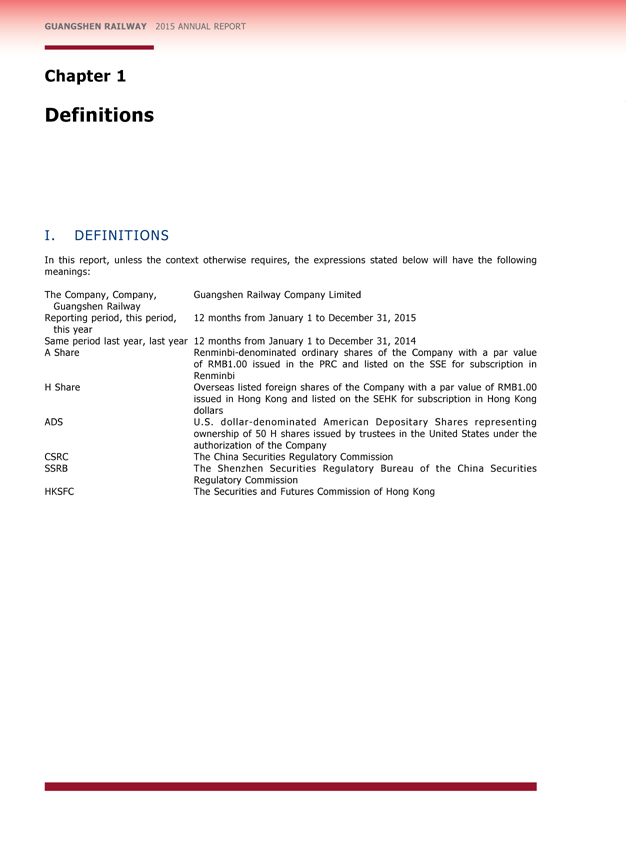
GUANGSHEN RAILWAY 2015 ANNUAL REPORT
Chapter 1
Definitions
I.
DEFINITIONS
In this report, unless the context otherwise requires, the expressions stated below will have the following
meanings:
The Company, Company,
Guangshen Railway Company Limited
Guangshen Railway
Reporting period, this period,
12 months from January 1 to December 31, 2015
this year
Same period last year, last year
12 months from January 1 to December 31, 2014
A Share
Renminbi-denominated ordinary shares of the Company with a par value
of RMB1.00 issued in the PRC and listed on the SSE for subscription in
Renminbi
H Share
Overseas listed foreign shares of the Company with a par value of RMB1.00
issued in Hong Kong and listed on the SEHK for subscription in Hong Kong
dollars
ADS
U.S. dollar -denominated American Depositary Shares representing
ownership of 50 H shares issued by trustees in the United States under the
authorization of the Company
CSRC
The China Securities Regulatory Commission
SSRB
The Shenzhen Securities Regulatory Bureau of the China Securities
Regulatory Commission
HKSFC
The Securities and Futures Commission of Hong Kong
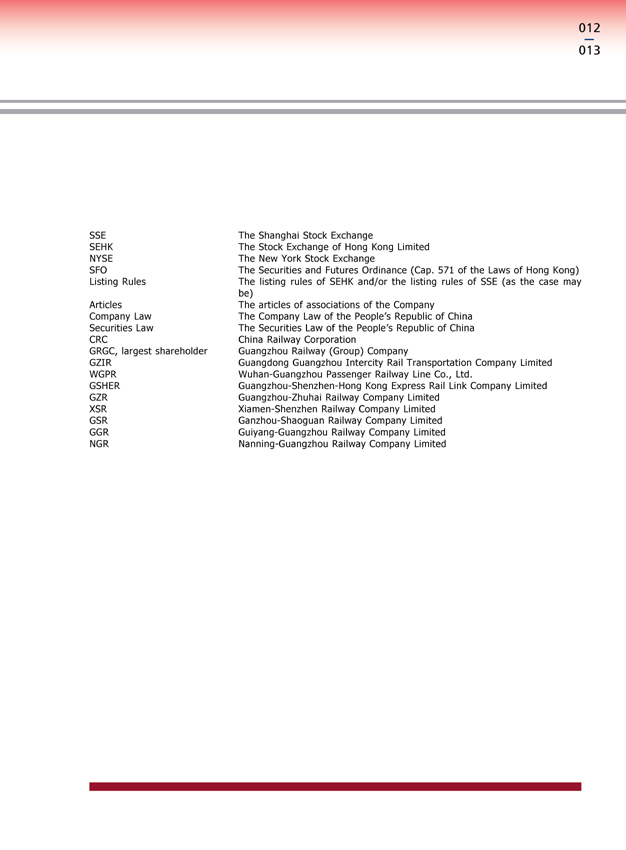
012
013
SSE The Shanghai Stock Exchange
SEHK The Stock Exchange of Hong Kong Limited
NYSE The New York Stock Exchange
SFO The Securities and Futures Ordinance (Cap. 571 of the Laws of Hong Kong)
Listing Rules The listing rules of SEHK and/or the listing rules of SSE (as the case may
be)
Articles The articles of associations of the Company
Company Law The Company Law of the People’s Republic of China
Securities Law The Securities Law of the People’s Republic of China
CRC China Railway Corporation
GRGC, largest shareholder Guangzhou Railway (Group) Company
GZIR Guangdong Guangzhou Intercity Rail Transportation Company Limited
WGPR Wuhan-Guangzhou Passenger Railway Line Co., Ltd.
GSHER Guangzhou-Shenzhen-Hong Kong Express Rail Link Company Limited
GZR Guangzhou-Zhuhai Railway Company Limited
XSR Xiamen-Shenzhen Railway Company Limited
GSR Ganzhou-Shaoguan Railway Company Limited
GGR Guiyang-Guangzhou Railway Company Limited
NGR Nanning-Guangzhou Railway Company Limited
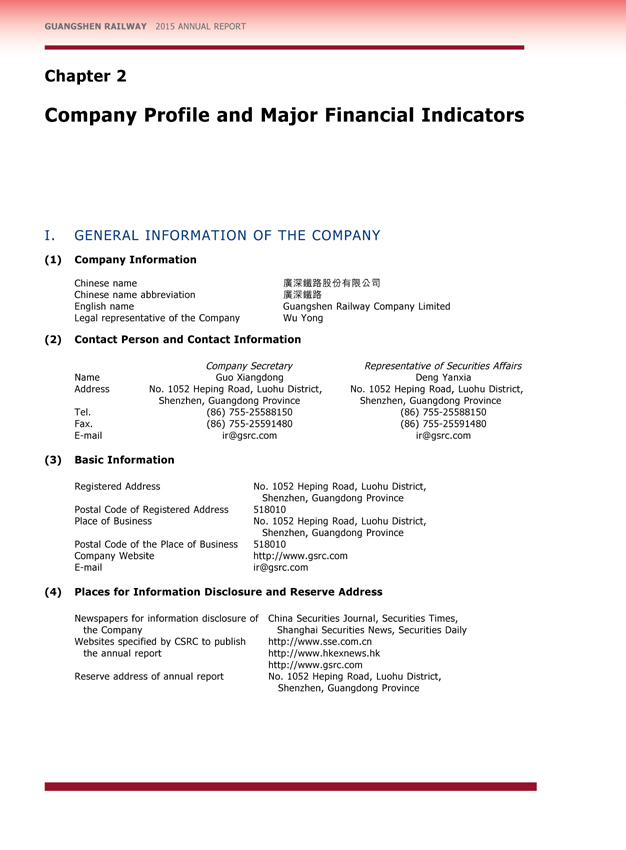
GUANGSHEN RAILWAY 2015 ANNUAL REPORT
Chapter 2
Company Profile and Major Financial Indicators
I. GENERAL INFORMATION OF THE COMPANY
(1) |
| Company Information |
Chinese name
Chinese name abbreviation
English name Guangshen Railway Company Limited
Legal representative of the Company Wu Yong
(2) |
| Contact Person and Contact Information |
Company Secretary Representative of Securities Affairs
Name Guo Xiangdong Deng Yanxia
Address No. 1052 Heping Road, Luohu District, No. 1052 Heping Road, Luohu District,
Shenzhen, Guangdong Province Shenzhen, Guangdong Province
Tel. (86) 755-25588150 (86) 755-25588150
Fax. (86) 755-25591480 (86) 755-25591480
E-mail ir@gsrc.com ir@gsrc.com
(3) |
| Basic Information |
Registered Address No. 1052 Heping Road, Luohu District,
Shenzhen, Guangdong Province
Postal Code of Registered Address 518010
Place of Business No. 1052 Heping Road, Luohu District,
Shenzhen, Guangdong Province
Postal Code of the Place of Business 518010
Company Website http://www.gsrc.com
E-mail ir@gsrc.com
(4) |
| Places for Information Disclosure and Reserve Address |
Newspapers for information disclosure of China Securities Journal, Securities Times,
the Company Shanghai Securities News, Securities Daily
Websites specified by CSRC to publish http://www.sse.com.cn
the annual report http://www.hkexnews.hk
http://www.gsrc.com
Reserve address of annual report No. 1052 Heping Road, Luohu District,
Shenzhen, Guangdong Province
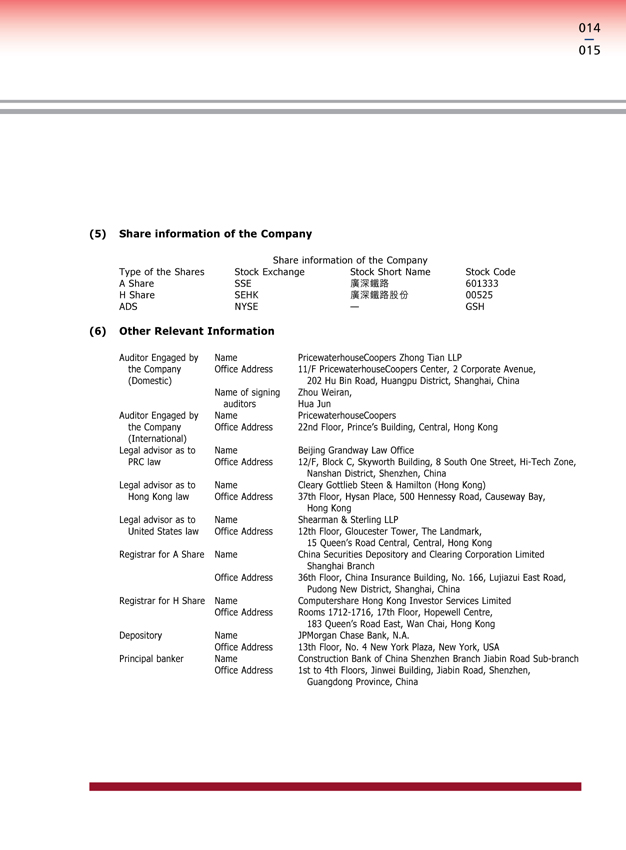
014
015
(5) |
| Share information of the Company |
Share information of the Company
Type of the Shares Stock Exchange Stock Short Name Stock Code
A Share SSE ???? 601333
H Share SEHK ?????? 00525
ADS NYSE — GSH
(6) |
| Other Relevant Information |
Auditor Engaged by Name PricewaterhouseCoopers Zhong Tian LLP
the Company Office Address 11/F PricewaterhouseCoopers Center, 2 Corporate Avenue,
(Domestic) 202 Hu Bin Road, Huangpu District, Shanghai, China
Name of signing Zhou Weiran,
auditors Hua Jun
Auditor Engaged by Name PricewaterhouseCoopers
the Company Office Address 22nd Floor, Prince’s Building, Central, Hong Kong
(International)
Legal advisor as to Name Beijing Grandway Law Office
PRC law Office Address 12/F, Block C, Skyworth Building, 8 South One Street, Hi-Tech Zone,
Nanshan District, Shenzhen, China
Legal advisor as to Name Cleary Gottlieb Steen & Hamilton (Hong Kong)
Hong Kong law Office Address 37th Floor, Hysan Place, 500 Hennessy Road, Causeway Bay,
Hong Kong
Legal advisor as to Name Shearman & Sterling LLP
United States law Office Address 12th Floor, Gloucester Tower, The Landmark,
15 Queen’s Road Central, Central, Hong Kong
Registrar for A Share Name China Securities Depository and Clearing Corporation Limited
Shanghai Branch
Office Address 36th Floor, China Insurance Building, No. 166, Lujiazui East Road,
Pudong New District, Shanghai, China
Registrar for H Share Name Computershare Hong Kong Investor Services Limited
Office Address Rooms 1712-1716, 17th Floor, Hopewell Centre,
183 Queen’s Road East, Wan Chai, Hong Kong
Depository Name JPMorgan Chase Bank, N.A.
Office Address 13th Floor, No. 4 New York Plaza, New York, USA
Principal banker Name Construction Bank of China Shenzhen Branch Jiabin Road Sub-branch
Office Address 1st to 4th Floors, Jinwei Building, Jiabin Road, Shenzhen,
Guangdong Province, China
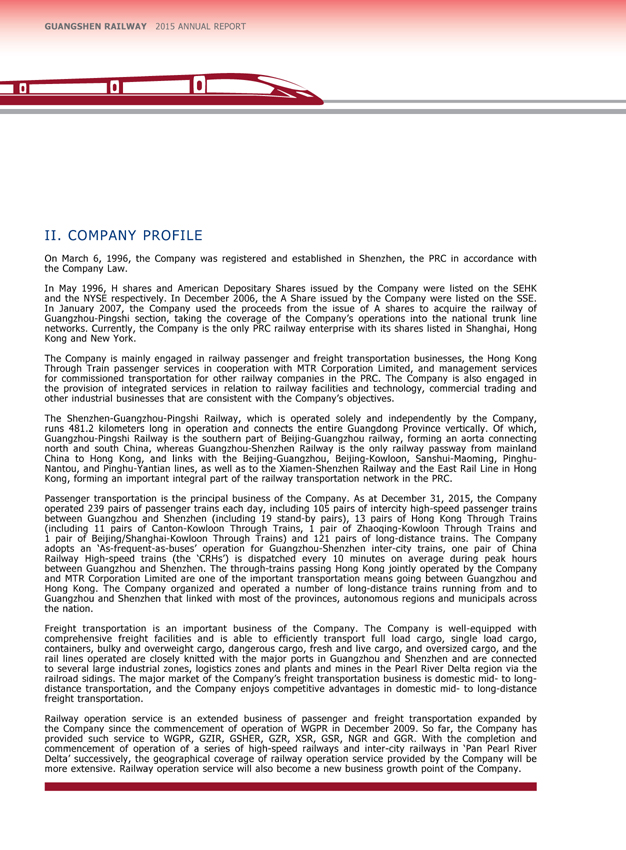
GUANGSHEN RAILWAY 2015 ANNUAL REPORT
II. COMPANY PROFILE
On March 6, 1996, the Company was registered and established in Shenzhen, the PRC in accordance with
the Company Law.
In May 1996, H shares and American Depositary Shares issued by the Company were listed on the SEHK
and the NYSE respectively. In December 2006, the A Share issued by the Company were listed on the SSE.
In January 2007, the Company used the proceeds from the issue of A shares to acquire the railway of
Guangzhou-Pingshi section, taking the coverage of the Company’s operations into the national trunk line
networks. Currently, the Company is the only PRC railway enterprise with its shares listed in Shanghai, Hong
Kong and New York.
The Company is mainly engaged in railway passenger and freight transportation businesses, the Hong Kong
Through Train passenger services in cooperation with MTR Corporation Limited, and management services
for commissioned transportation for other railway companies in the PRC. The Company is also engaged in
the provision of integrated services in relation to railway facilities and technology, commercial trading and
other industrial businesses that are consistent with the Company’s objectives.
The Shenzhen-Guangzhou-Pingshi Railway, which is operated solely and independently by the Company,
runs 481.2 kilometers long in operation and connects the entire Guangdong Province vertically. Of which,
Guangzhou-Pingshi Railway is the southern part of Beijing-Guangzhou railway, forming an aorta connecting
north and south China, whereas Guangzhou-Shenzhen Railway is the only railway passway from mainland
China to Hong Kong, and links with the Beijing-Guangzhou, Beijing-Kowloon, Sanshui-Maoming, Pinghu-
Nantou, and Pinghu-Yantian lines, as well as to the Xiamen-Shenzhen Railway and the East Rail Line in Hong
Kong, forming an important integral part of the railway transportation network in the PRC.
Passenger transportation is the principal business of the Company. As at December 31, 2015, the Company
operated 239 pairs of passenger trains each day, including 105 pairs of intercity high-speed passenger trains
between Guangzhou and Shenzhen (including 19 stand-by pairs), 13 pairs of Hong Kong Through Trains
(including 11 pairs of Canton-Kowloon Through Trains, 1 pair of Zhaoqing-Kowloon Through Trains and
1 |
| pair of Beijing/Shanghai-Kowloon Through Trains) and 121 pairs of long-distance trains. The Company |
adopts an ‘As-frequent-as-buses’ operation for Guangzhou-Shenzhen inter-city trains, one pair of China
Railway High-speed trains (the ‘CRHs’) is dispatched every 10 minutes on average during peak hours
between Guangzhou and Shenzhen. The through-trains passing Hong Kong jointly operated by the Company
and MTR Corporation Limited are one of the important transportation means going between Guangzhou and
Hong Kong. The Company organized and operated a number of long-distance trains running from and to
Guangzhou and Shenzhen that linked with most of the provinces, autonomous regions and municipals across
the nation.
Freight transportation is an important business of the Company. The Company is well-equipped with
comprehensive freight facilities and is able to efficiently transport full load cargo, single load cargo,
containers, bulky and overweight cargo, dangerous cargo, fresh and live cargo, and oversized cargo, and the
rail lines operated are closely knitted with the major ports in Guangzhou and Shenzhen and are connected
to several large industrial zones, logistics zones and plants and mines in the Pearl River Delta region via the
railroad sidings. The major market of the Company’s freight transportation business is domestic mid- to long-
distance transportation, and the Company enjoys competitive advantages in domestic mid- to long-distance
freight transportation.
Railway operation service is an extended business of passenger and freight transportation expanded by
the Company since the commencement of operation of WGPR in December 2009. So far, the Company has
provided such service to WGPR, GZIR, GSHER, GZR, XSR, GSR, NGR and GGR. With the completion and
commencement of operation of a series of high-speed railways and inter-city railways in ‘Pan Pearl River
Delta’ successively, the geographical coverage of railway operation service provided by the Company will be
more extensive. Railway operation service will also become a new business growth point of the Company.
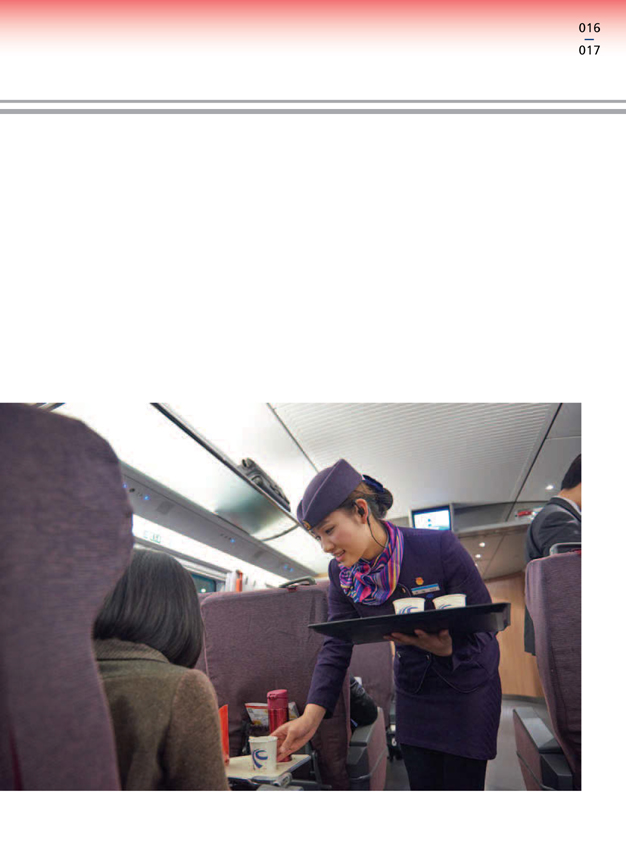
016 017
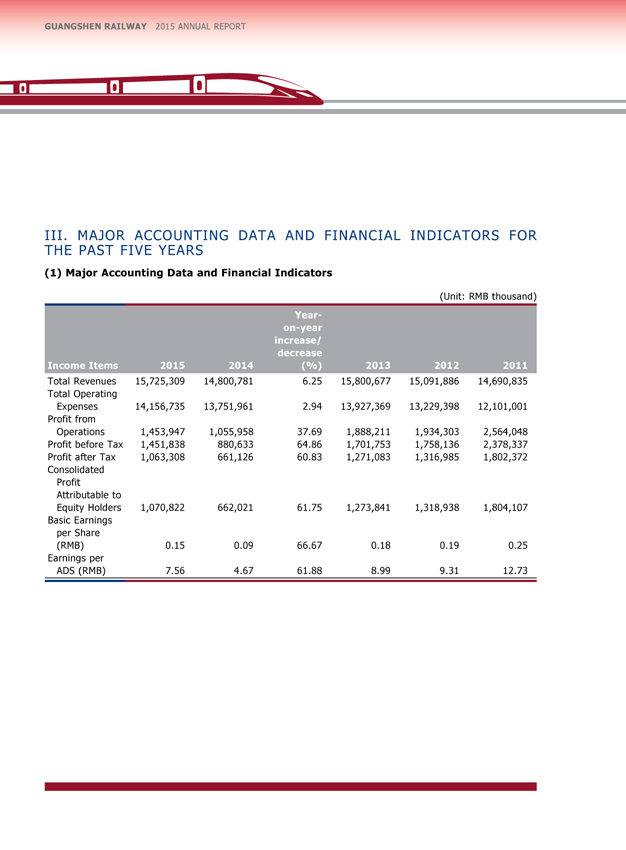
GUANGSHEN RAILWAY 2015 ANNUAL REPORT
III. MAJOR ACCOUNTING DATA AND FINANCIAL INDICATORS FOR
THE PAST FIVE YEARS
(1) |
| Major Accounting Data and Financial Indicators |
(Unit: RMB thousand)
Year-
on-year
increase/
decrease
Income Items 2015 2014 (%) 2013 2012 2011
Total Revenues 15,725,309 14,800,781 6.25 15,800,677 15,091,886 14,690,835
Total Operating
Expenses 14,156,735 13,751,961 2.94 13,927,369 13,229,398 12,101,001
Profit from
Operations 1,453,947 1,055,958 37.69 1,888,211 1,934,303 2,564,048
Profit before Tax 1,451,838 880,633 64.86 1,701,753 1,758,136 2,378,337
Profit after Tax 1,063,308 661,126 60.83 1,271,083 1,316,985 1,802,372
Consolidated
Profit
Attributable to
Equity Holders 1,070,822 662,021 61.75 1,273,841 1,318,938 1,804,107
Basic Earnings
per Share
(RMB) 0.15 0.09 66.67 0.18 0.19 0.25
Earnings per
ADS (RMB) 7.56 4.67 61.88 8.99 9.31 12.73
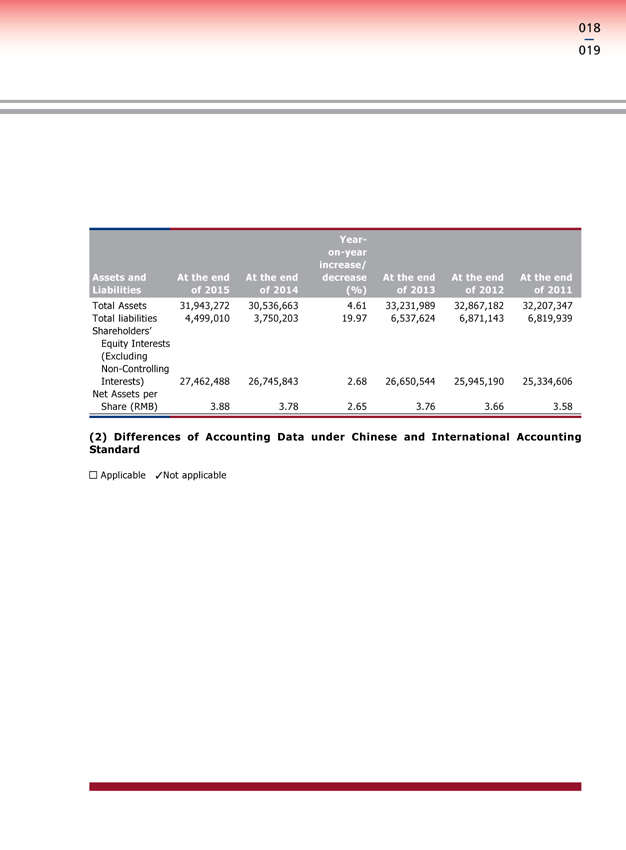
018
019
Year-
on-year
increase/
Assets and At the end At the end decrease At the end At the end At the end
Liabilities of 2015 of 2014 (%) of 2013 of 2012 of 2011
Total Assets 31,943,272 30,536,663 4.61 33,231,989 32,867,182 32,207,347
Total liabilities 4,499,010 3,750,203 19.97 6,537,624 6,871,143 6,819,939
Shareholders’
Equity Interests
(Excluding
Non-Controlling
Interests) 27,462,488 26,745,843 2.68 26,650,544 25,945,190 25,334,606
Net Assets per
Share (RMB) 3.88 3.78 2.65 3.76 3.66 3.58
(2) |
| Differences of Accounting Data under Chinese and International Accounting |
Standard
Applicable ?Not applicable
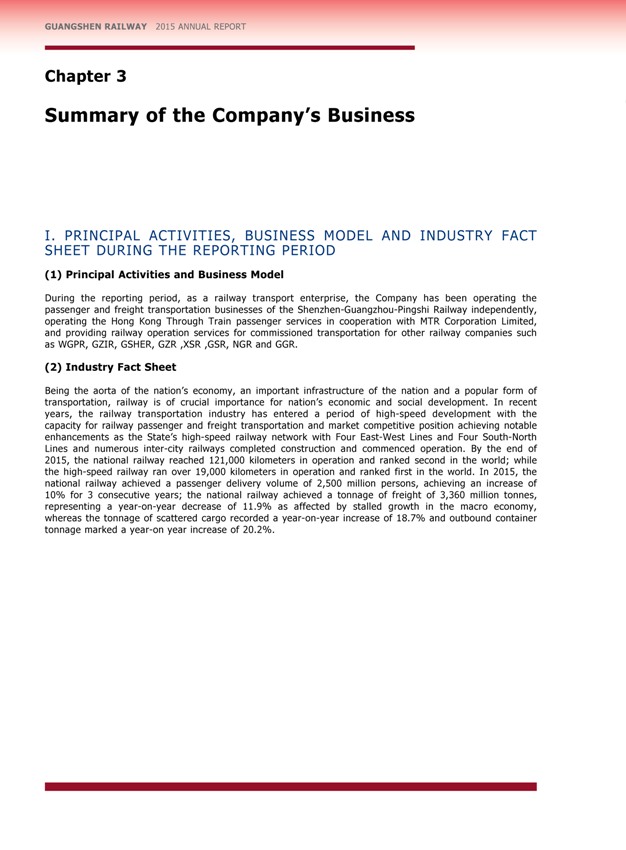
GUANGSHEN RAILWAY 2015 ANNUAL REPORT
Chapter 3
Summary of the Company’s Business
I. PRINCIPAL ACTIVITIES, BUSINESS MODEL AND INDUSTRY FACT SHEET DURING THE REPORTING PERIOD
(1) |
| Principal Activities and Business Model |
During the reporting period, as a railway transport enterprise, the Company has been operating the passenger and freight transportation businesses of the Shenzhen-Guangzhou-Pingshi Railway independently, operating the Hong Kong Through Train passenger services in cooperation with MTR Corporation Limited, and providing railway operation services for commissioned transportation for other railway companies such as WGPR, GZIR, GSHER, GZR ,XSR ,GSR, NGR and GGR.
(2) |
| Industry Fact Sheet |
Being the aorta of the nation’s economy, an important infrastructure of the nation and a popular form of transportation, railway is of crucial importance for nation’s economic and social development. In recent years, the railway transportation industry has entered a period of high-speed development with the capacity for railway passenger and freight transportation and market competitive position achieving notable enhancements as the State’s high-speed railway network with Four East-West Lines and Four South-North Lines and numerous inter-city railways completed construction and commenced operation. By the end of 2015, the national railway reached 121,000 kilometers in operation and ranked second in the world; while the high-speed railway ran over 19,000 kilometers in operation and ranked first in the world. In 2015, the national railway achieved a passenger delivery volume of 2,500 million persons, achieving an increase of 10% for 3 consecutive years; the national railway achieved a tonnage of freight of 3,360 million tonnes, representing a year-on-year decrease of 11.9% as affected by stalled growth in the macro economy, whereas the tonnage of scattered cargo recorded a year-on-year increase of 18.7% and outbound container tonnage marked a year-on year increase of 20.2%.
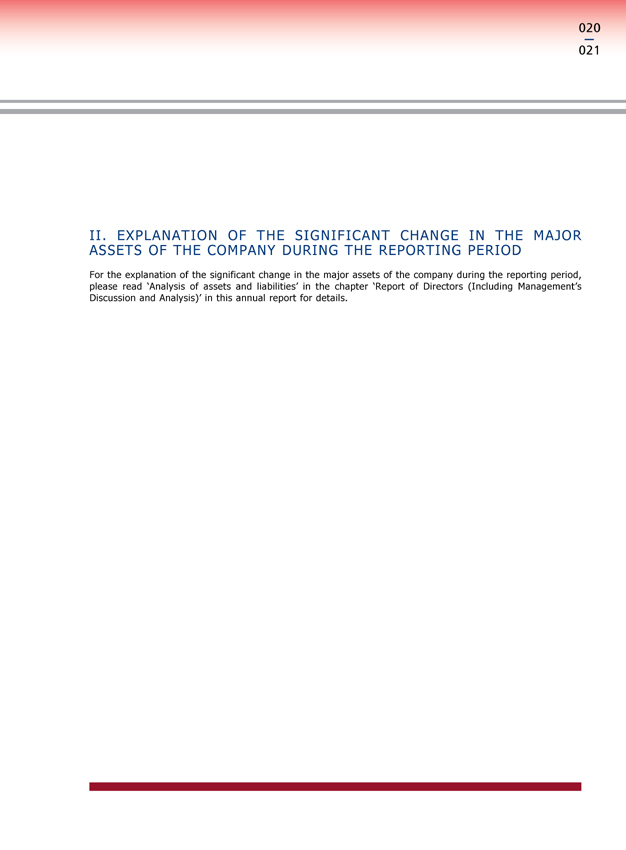
020
021
II. EXPLANATION OF THE SIGNIFICANT CHANGE IN THE MAJOR ASSETS OF THE COMPANY DURING THE REPORTING PERIOD
For the explanation of the significant change in the major assets of the company during the reporting period, please read ‘Analysis of assets and liabilities’ in the chapter ‘Report of Directors (Including Management’s Discussion and Analysis)’ in this annual report for details.
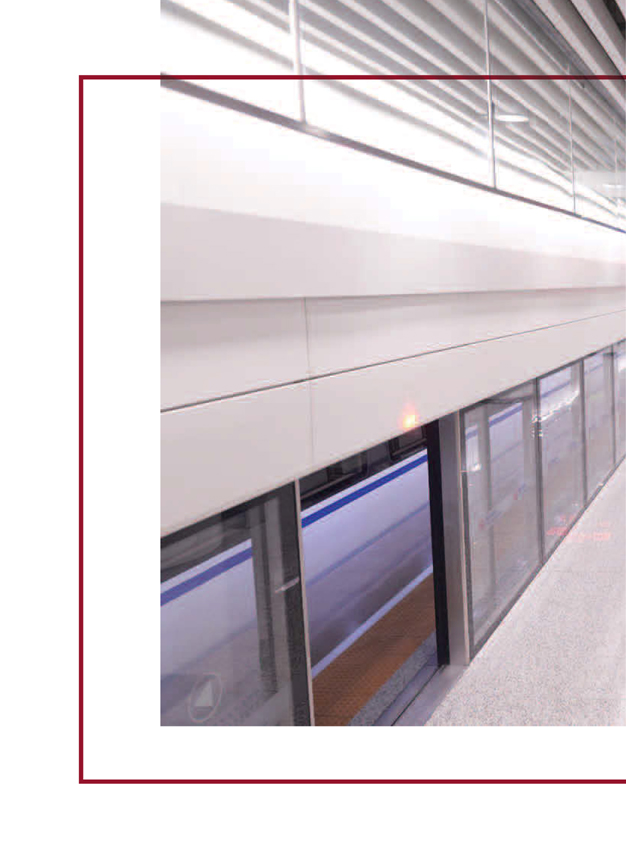
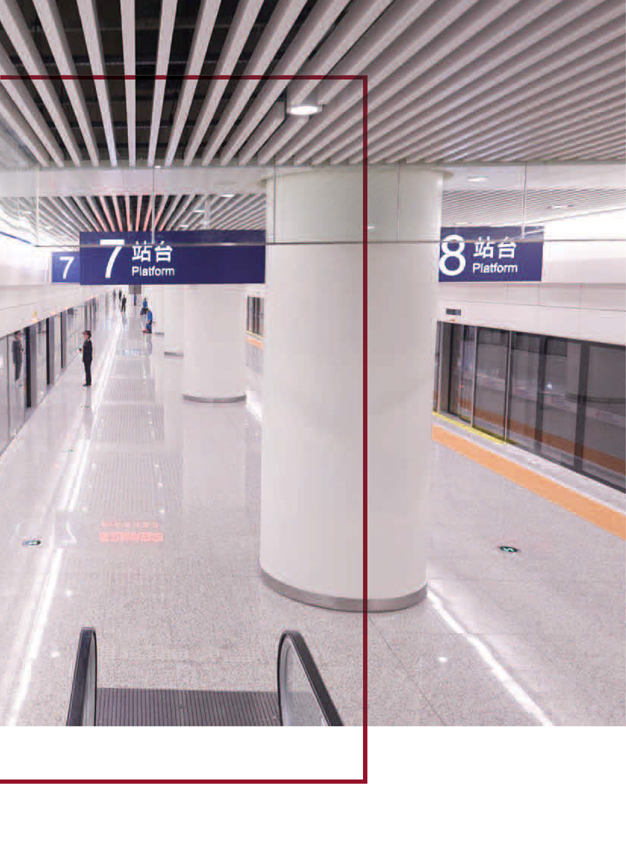
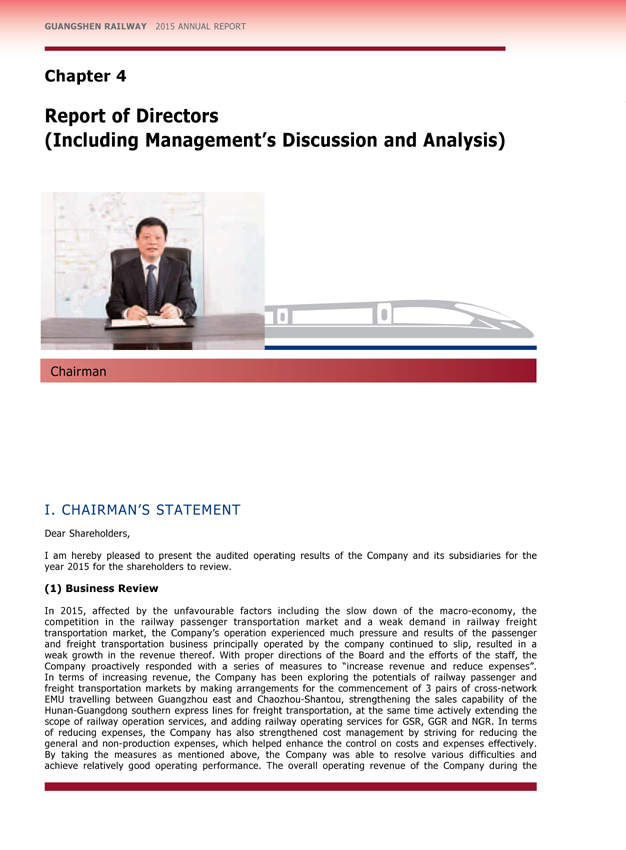
GUANGSHEN RAILWAY 2015 ANNUAL REPORT
Chapter 4
Report of Directors
(Including Management’s Discussion and Analysis)
Chairman
I. CHAIRMAN’S STATEMENT
Dear Shareholders,
I am hereby pleased to present the audited operating results of the Company and its subsidiaries for the year 2015 for the shareholders to review.
(1) |
| Business Review |
In 2015, affected by the unfavourable factors including the slow down of the macro-economy, the competition in the railway passenger transportation market and a weak demand in railway freight transportation market, the Company’s operation experienced much pressure and results of the passenger and freight transportation business principally operated by the company continued to slip, resulted in a weak growth in the revenue thereof. With proper directions of the Board and the efforts of the staff, the Company proactively responded with a series of measures to “increase revenue and reduce expenses”. In terms of increasing revenue, the Company has been exploring the potentials of railway passenger and freight transportation markets by making arrangements for the commencement of 3 pairs of cross-network EMU travelling between Guangzhou east and Chaozhou-Shantou, strengthening the sales capability of the Hunan-Guangdong southern express lines for freight transportation, at the same time actively extending the scope of railway operation services, and adding railway operating services for GSR, GGR and NGR. In terms of reducing expenses, the Company has also strengthened cost management by striving for reducing the general and non-production expenses, which helped enhance the control on costs and expenses effectively. By taking the measures as mentioned above, the Company was able to resolve various difficulties and achieve relatively good operating performance. The overall operating revenue of the Company during the
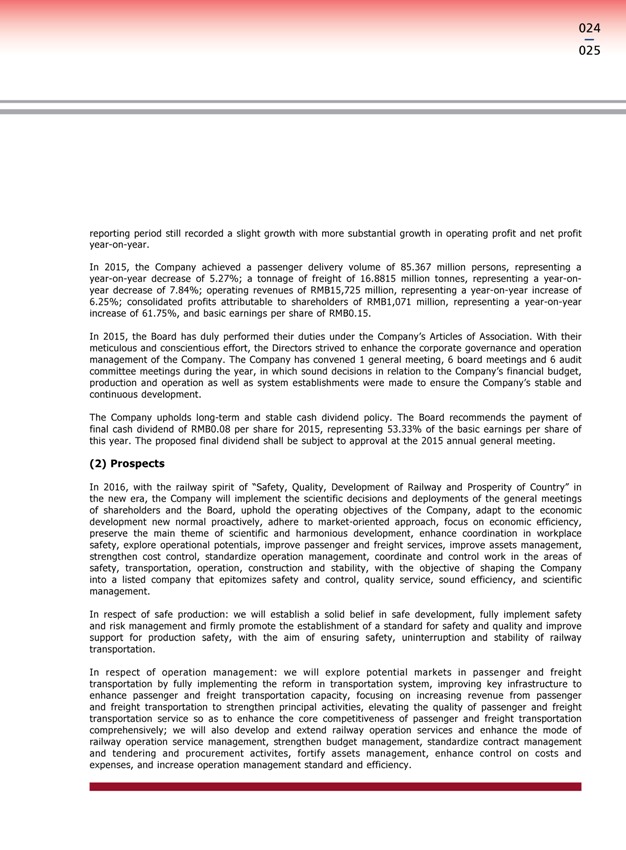
024
025
reporting period still recorded a slight growth with more substantial growth in operating profit and net profit year-on-year.
In 2015, the Company achieved a passenger delivery volume of 85.367 million persons, representing a year-on-year decrease of 5.27%; a tonnage of freight of 16.8815 million tonnes, representing a year-on-year decrease of 7.84%; operating revenues of RMB15,725 million, representing a year-on-year increase of 6.25%; consolidated profits attributable to shareholders of RMB1,071 million, representing a year-on-year increase of 61.75%, and basic earnings per share of RMB0.15.
In 2015, the Board has duly performed their duties under the Company’s Articles of Association. With their meticulous and conscientious effort, the Directors strived to enhance the corporate governance and operation management of the Company. The Company has convened 1 general meeting, 6 board meetings and 6 audit committee meetings during the year, in which sound decisions in relation to the Company’s financial budget, production and operation as well as system establishments were made to ensure the Company’s stable and continuous development.
The Company upholds long-term and stable cash dividend policy. The Board recommends the payment of final cash dividend of RMB0.08 per share for 2015, representing 53.33% of the basic earnings per share of this year. The proposed final dividend shall be subject to approval at the 2015 annual general meeting.
(2) |
| Prospects |
In 2016, with the railway spirit of “Safety, Quality, Development of Railway and Prosperity of Country” in the new era, the Company will implement the scientific decisions and deployments of the general meetings of shareholders and the Board, uphold the operating objectives of the Company, adapt to the economic development new normal proactively, adhere to market-oriented approach, focus on economic efficiency, preserve the main theme of scientific and harmonious development, enhance coordination in workplace safety, explore operational potentials, improve passenger and freight services, improve assets management, strengthen cost control, standardize operation management, coordinate and control work in the areas of safety, transportation, operation, construction and stability, with the objective of shaping the Company into a listed company that epitomizes safety and control, quality service, sound efficiency, and scientific management.
In respect of safe production: we will establish a solid belief in safe development, fully implement safety and risk management and firmly promote the establishment of a standard for safety and quality and improve support for production safety, with the aim of ensuring safety, uninterruption and stability of railway transportation.
In respect of operation management: we will explore potential markets in passenger and freight transportation by fully implementing the reform in transportation system, improving key infrastructure to enhance passenger and freight transportation capacity, focusing on increasing revenue from passenger and freight transportation to strengthen principal activities, elevating the quality of passenger and freight transportation service so as to enhance the core competitiveness of passenger and freight transportation comprehensively; we will also develop and extend railway operation services and enhance the mode of railway operation service management, strengthen budget management, standardize contract management and tendering and procurement activites, fortify assets management, enhance control on costs and expenses, and increase operation management standard and efficiency.
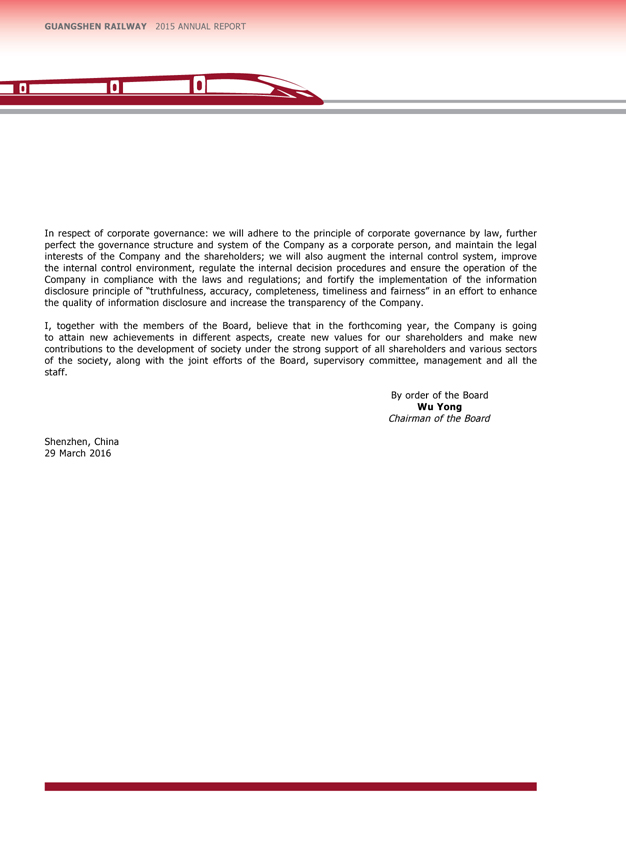
GUANGSHEN RAILWAY 2015 ANNUAL REPORT
In respect of corporate governance: we will adhere to the principle of corporate governance by law, further perfect the governance structure and system of the Company as a corporate person, and maintain the legal interests of the Company and the shareholders; we will also augment the internal control system, improve the internal control environment, regulate the internal decision procedures and ensure the operation of the Company in compliance with the laws and regulations; and fortify the implementation of the information disclosure principle of “truthfulness, accuracy, completeness, timeliness and fairness” in an effort to enhance the quality of information disclosure and increase the transparency of the Company.
I, together with the members of the Board, believe that in the forthcoming year, the Company is going to attain new achievements in different aspects, create new values for our shareholders and make new contributions to the development of society under the strong support of all shareholders and various sectors of the society, along with the joint efforts of the Board, supervisory committee, management and all the staff.
By order of the Board
Wu Yong
Chairman of the Board
Shenzhen, China
29 March 2016
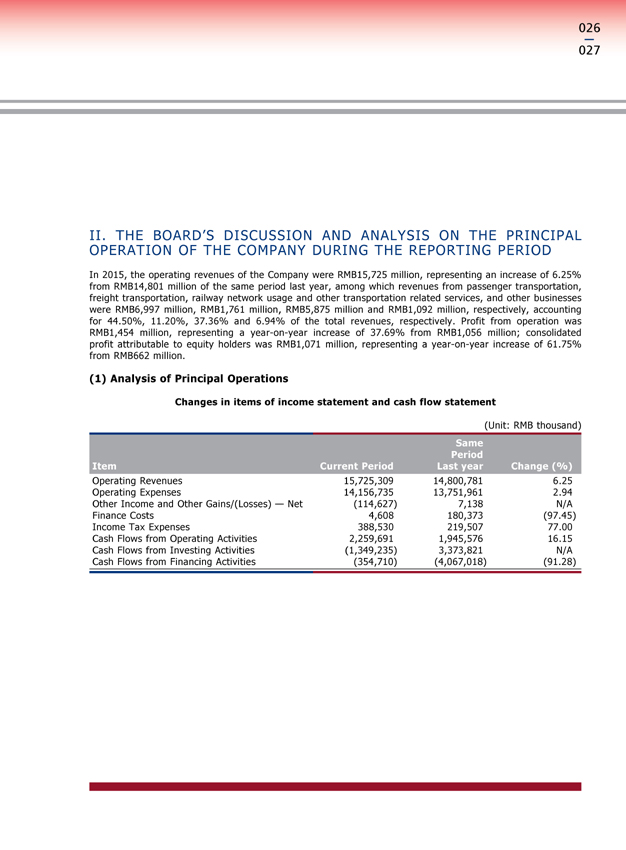
026
027
II. THE BOARD’S DISCUSSION AND ANALYSIS ON THE PRINCIPAL
OPERATION OF THE COMPANY DURING THE REPORTING PERIOD
In 2015, the operating revenues of the Company were RMB15,725 million, representing an increase of 6.25%
from RMB14,801 million of the same period last year, among which revenues from passenger transportation,
freight transportation, railway network usage and other transportation related services, and other businesses
were RMB6,997 million, RMB1,761 million, RMB5,875 million and RMB1,092 million, respectively, accounting
for 44.50%, 11.20%, 37.36% and 6.94% of the total revenues, respectively. Profit from operation was
RMB1,454 million, representing a year-on-year increase of 37.69% from RMB1,056 million; consolidated
profit attributable to equity holders was RMB1,071 million, representing a year-on-year increase of 61.75%
from RMB662 million.
(1) |
| Analysis of Principal Operations |
Changes in items of income statement and cash flow statement
(Unit: RMB thousand)
Same
Period
Item Current Period Last year Change (%)
Operating Revenues 15,725,309 14,800,781 6.25
Operating Expenses 14,156,735 13,751,961 2.94
Other Income and Other Gains/(Losses) — Net (114,627) 7,138 N/A
Finance Costs 4,608 180,373 (97.45)
Income Tax Expenses 388,530 219,507 77.00
Cash Flows from Operating Activities 2,259,691 1,945,576 16.15
Cash Flows from Investing Activities (1,349,235) 3,373,821 N/A
Cash Flows from Financing Activities (354,710) (4,067,018) (91.28)
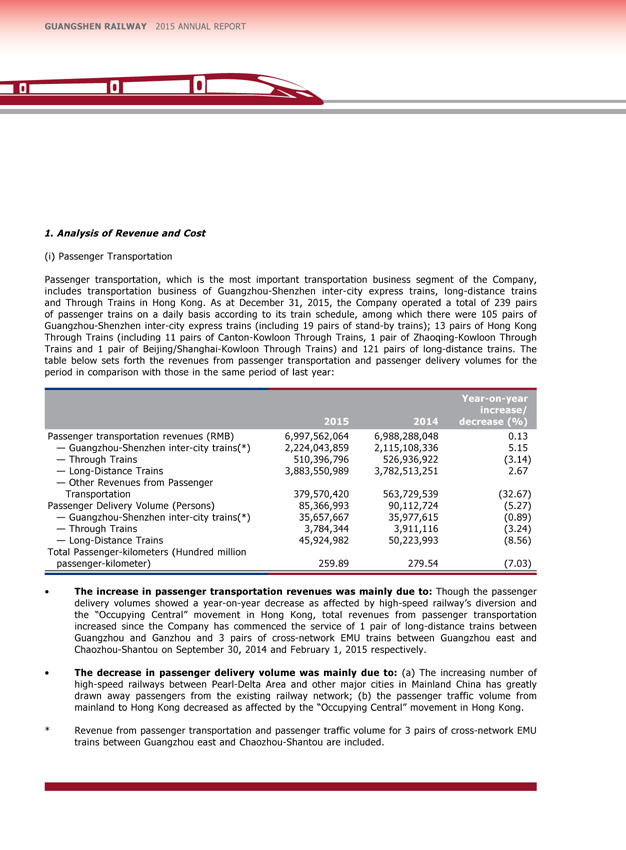
GUANGSHEN RAILWAY 2015 ANNUAL REPORT
1. Analysis of Revenue and Cost
(i) |
| Passenger Transportation |
Passenger transportation, which is the most important transportation business segment of the Company,
includes transportation business of Guangzhou-Shenzhen inter-city express trains, long-distance trains
and Through Trains in Hong Kong. As at December 31, 2015, the Company operated a total of 239 pairs
of passenger trains on a daily basis according to its train schedule, among which there were 105 pairs of
Guangzhou-Shenzhen inter-city express trains (including 19 pairs of stand-by trains); 13 pairs of Hong Kong
Through Trains (including 11 pairs of Canton-Kowloon Through Trains, 1 pair of Zhaoqing-Kowloon Through
Trains and 1 pair of Beijing/Shanghai-Kowloon Through Trains) and 121 pairs of long-distance trains. The
table below sets forth the revenues from passenger transportation and passenger delivery volumes for the
period in comparison with those in the same period of last year:
Year-on-year
increase/
2015 2014 decrease (%)
Passenger transportation revenues (RMB) 6,997,562,064 6,988,288,048 0.13
— Guangzhou-Shenzhen inter-city trains(*) 2,224,043,859 2,115,108,336 5.15
— Through Trains 510,396,796 526,936,922 (3.14)
— Long-Distance Trains 3,883,550,989 3,782,513,251 2.67
— Other Revenues from Passenger
Transportation 379,570,420 563,729,539 (32.67)
Passenger Delivery Volume (Persons) 85,366,993 90,112,724 (5.27)
— Guangzhou-Shenzhen inter-city trains(*) 35,657,667 35,977,615 (0.89)
— Through Trains 3,784,344 3,911,116 (3.24)
— Long-Distance Trains 45,924,982 50,223,993 (8.56)
Total Passenger-kilometers (Hundred million
passenger-kilometer) 259.89 279.54 (7.03)
• |
| The increase in passenger transportation revenues was mainly due to: Though the passenger |
delivery volumes showed a year-on-year decrease as affected by high-speed railway’s diversion and
the “Occupying Central” movement in Hong Kong, total revenues from passenger transportation
increased since the Company has commenced the service of 1 pair of long-distance trains between
Guangzhou and Ganzhou and 3 pairs of cross-network EMU trains between Guangzhou east and
Chaozhou-Shantou on September 30, 2014 and February 1, 2015 respectively.
• |
| The decrease in passenger delivery volume was mainly due to: (a) The increasing number of |
high-speed railways between Pearl-Delta Area and other major cities in Mainland China has greatly
drawn away passengers from the existing railway network; (b) the passenger traffic volume from
mainland to Hong Kong decreased as affected by the “Occupying Central” movement in Hong Kong.
* |
| Revenue from passenger transportation and passenger traffic volume for 3 pairs of cross-network EMU |
trains between Guangzhou east and Chaozhou-Shantou are included.
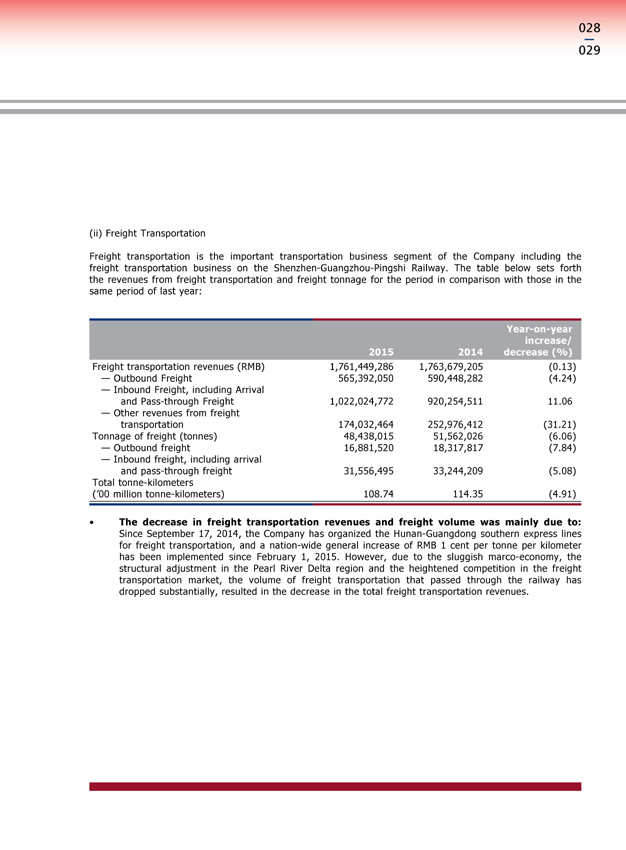
028
029
(ii) Freight Transportation
Freight transportation is the important transportation business segment of the Company including the
freight transportation business on the Shenzhen-Guangzhou-Pingshi Railway. The table below sets forth
the revenues from freight transportation and freight tonnage for the period in comparison with those in the
same period of last year:
Year-on-year
increase/
2015 2014 decrease (%)
Freight transportation revenues (RMB) 1,761,449,286 1,763,679,205 (0.13)
— Outbound Freight 565,392,050 590,448,282 (4.24)
— Inbound Freight, including Arrival
and Pass-through Freight 1,022,024,772 920,254,511 11.06
— Other revenues from freight
transportation 174,032,464 252,976,412 (31.21)
Tonnage of freight (tonnes) 48,438,015 51,562,026 (6.06)
— Outbound freight 16,881,520 18,317,817 (7.84)
— Inbound freight, including arrival
and pass-through freight 31,556,495 33,244,209 (5.08)
Total tonne-kilometers
(’00 million tonne-kilometers) 108.74 114.35 (4.91)
• |
| The decrease in freight transportation revenues and freight volume was mainly due to: |
Since September 17, 2014, the Company has organized the Hunan-Guangdong southern express lines
for freight transportation, and a nation-wide general increase of RMB 1 cent per tonne per kilometer
has been implemented since February 1, 2015. However, due to the sluggish marco-economy, the
structural adjustment in the Pearl River Delta region and the heightened competition in the freight
transportation market, the volume of freight transportation that passed through the railway has
dropped substantially, resulted in the decrease in the total freight transportation revenues.
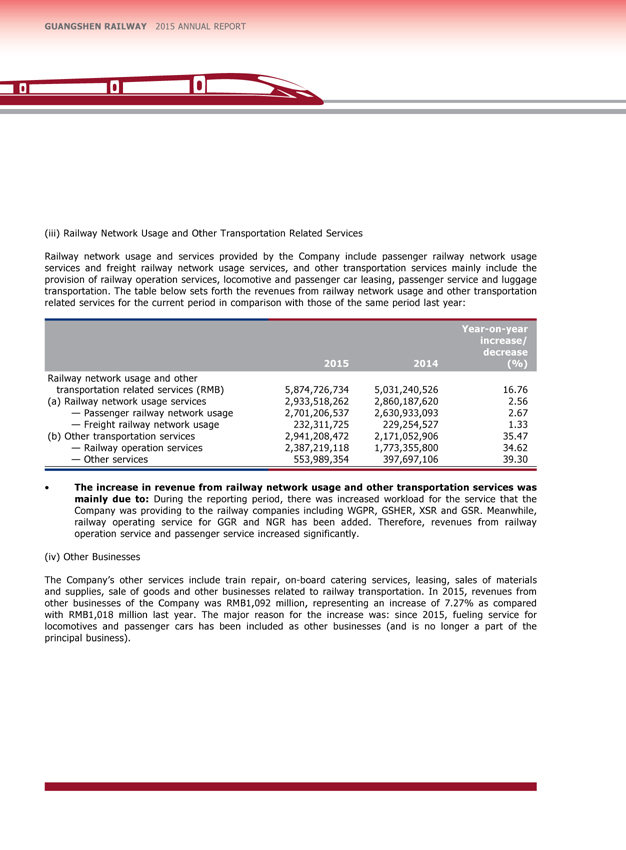
GUANGSHEN RAILWAY 2015 ANNUAL REPORT
(iii) Railway Network Usage and Other Transportation Related Services
Railway network usage and services provided by the Company include passenger railway network usage
services and freight railway network usage services, and other transportation services mainly include the
provision of railway operation services, locomotive and passenger car leasing, passenger service and luggage
transportation. The table below sets forth the revenues from railway network usage and other transportation
related services for the current period in comparison with those of the same period last year:
Year-on-year
increase/
decrease
2015 2014 (%)
Railway network usage and other
transportation related services (RMB) 5,874,726,734 5,031,240,526 16.76
(a) |
| Railway network usage services 2,933,518,262 2,860,187,620 2.56 |
— Passenger railway network usage 2,701,206,537 2,630,933,093 2.67
— Freight railway network usage 232,311,725 229,254,527 1.33
(b) |
| Other transportation services 2,941,208,472 2,171,052,906 35.47 |
— Railway operation services 2,387,219,118 1,773,355,800 34.62
— Other services 553,989,354 397,697,106 39.30
• |
| The increase in revenue from railway network usage and other transportation services was |
mainly due to: During the reporting period, there was increased workload for the service that the
Company was providing to the railway companies including WGPR, GSHER, XSR and GSR. Meanwhile,
railway operating service for GGR and NGR has been added. Therefore, revenues from railway
operation service and passenger service increased significantly.
(iv) Other Businesses
The Company’s other services include train repair, on-board catering services, leasing, sales of materials
and supplies, sale of goods and other businesses related to railway transportation. In 2015, revenues from
other businesses of the Company was RMB1,092 million, representing an increase of 7.27% as compared
with RMB1,018 million last year. The major reason for the increase was: since 2015, fueling service for
locomotives and passenger cars has been included as other businesses (and is no longer a part of the
principal business).
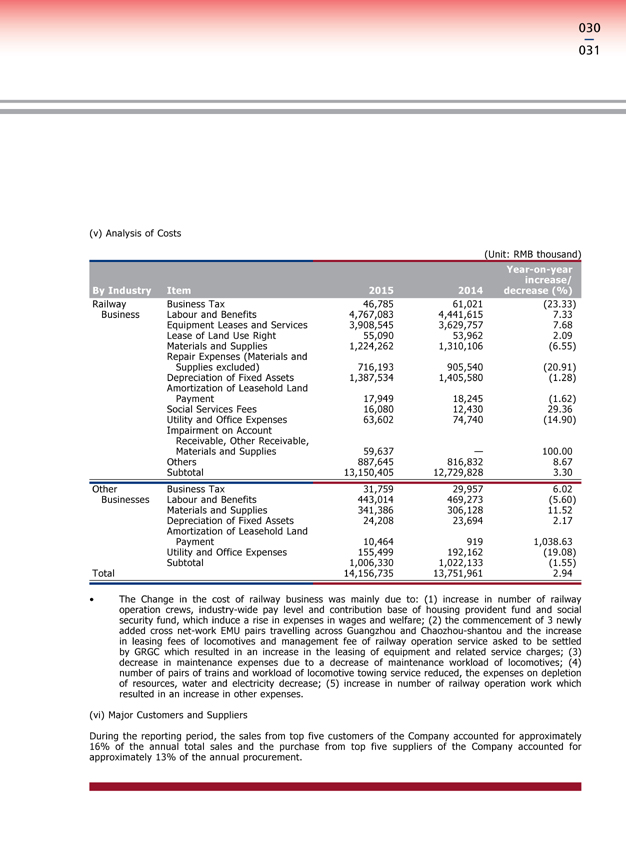
030
031
(v) |
| Analysis of Costs |
(Unit: RMB thousand)
Year-on-year
increase/
By Industry Item 2015 2014 decrease (%)
Railway Business Tax 46,785 61,021 (23.33)
Business Labour and Benefits 4,767,083 4,441,615 7.33
Equipment Leases and Services 3,908,545 3,629,757 7.68
Lease of Land Use Right 55,090 53,962 2.09
Materials and Supplies 1,224,262 1,310,106 (6.55)
Repair Expenses (Materials and
Supplies excluded) 716,193 905,540 (20.91)
Depreciation of Fixed Assets 1,387,534 1,405,580 (1.28)
Amortization of Leasehold Land
Payment 17,949 18,245 (1.62)
Social Services Fees 16,080 12,430 29.36
Utility and Office Expenses 63,602 74,740 (14.90)
Impairment on Account
Receivable, Other Receivable,
Materials and Supplies 59,637 — 100.00
Others 887,645 816,832 8.67
Subtotal 13,150,405 12,729,828 3.30
Other Business Tax 31,759 29,957 6.02
Businesses Labour and Benefits 443,014 469,273 (5.60)
Materials and Supplies 341,386 306,128 11.52
Depreciation of Fixed Assets 24,208 23,694 2.17
Amortization of Leasehold Land
Payment 10,464 919 1,038.63
Utility and Office Expenses 155,499 192,162 (19.08)
Subtotal 1,006,330 1,022,133 (1.55)
Total 14,156,735 13,751,961 2.94
• |
| The Change in the cost of railway business was mainly due to: (1) increase in number of railway operation crews, industry-wide pay level and contribution base of housing provident fund and social security fund, which induce a rise in expenses in wages and welfare; (2) the commencement of 3 newly added cross net-work EMU pairs travelling across Guangzhou and Chaozhou-shantou and the increase in leasing fees of locomotives and management fee of railway operation service asked to be settled by GRGC which resulted in an increase in the leasing of equipment and related service charges; (3) decrease in maintenance expenses due to a decrease of maintenance workload of locomotives; (4) number of pairs of trains and workload of locomotive towing service reduced, the expenses on depletion of resources, water and electricity decrease; (5) increase in number of railway operation work which resulted in an increase in other expenses. |
(vi) Major Customers and Suppliers
During the reporting period, the sales from top five customers of the Company accounted for approximately 16% of the annual total sales and the purchase from top five suppliers of the Company accounted for approximately 13% of the annual procurement.
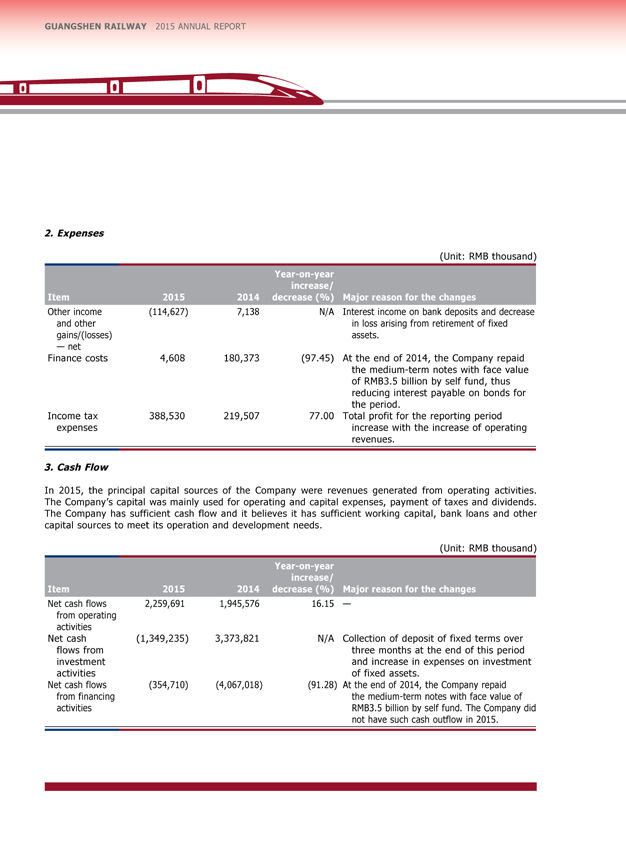
GUANGSHEN RAILWAY 2015 ANNUAL REPORT
2. Expenses
(Unit: RMB thousand)
Year-on-year
increase/
Item 2015 2014 decrease (%) Major reason for the changes
Other income (114,627) 7,138 N/A Interest income on bank deposits and decrease
and other in loss arising from retirement of fixed
gains/(losses) assets.
— net
Finance costs 4,608 180,373 (97.45) At the end of 2014, the Company repaid
the medium-term notes with face value
of RMB3.5 billion by self fund, thus
reducing interest payable on bonds for
the period.
Income tax 388,530 219,507 77.00 Total profit for the reporting period
expenses increase with the increase of operating
revenues.
3. Cash Flow
In 2015, the principal capital sources of the Company were revenues generated from operating activities.
The Company’s capital was mainly used for operating and capital expenses, payment of taxes and dividends.
The Company has sufficient cash flow and it believes it has sufficient working capital, bank loans and other
capital sources to meet its operation and development needs.
(Unit: RMB thousand)
Year-on-year
increase/
Item 2015 2014 decrease (%) Major reason for the changes
Net cash flows 2,259,691 1,945,576 16.15 —
from operating
activities
Net cash (1,349,235) 3,373,821 N/A Collection of deposit of fixed terms over
flows from three months at the end of this period
investment and increase in expenses on investment
activities of fixed assets.
Net cash flows (354,710) (4,067,018) (91.28) At the end of 2014, the Company repaid
from financing the medium-term notes with face value of
activities RMB3.5 billion by self fund. The Company did
not have such cash outflow in 2015.
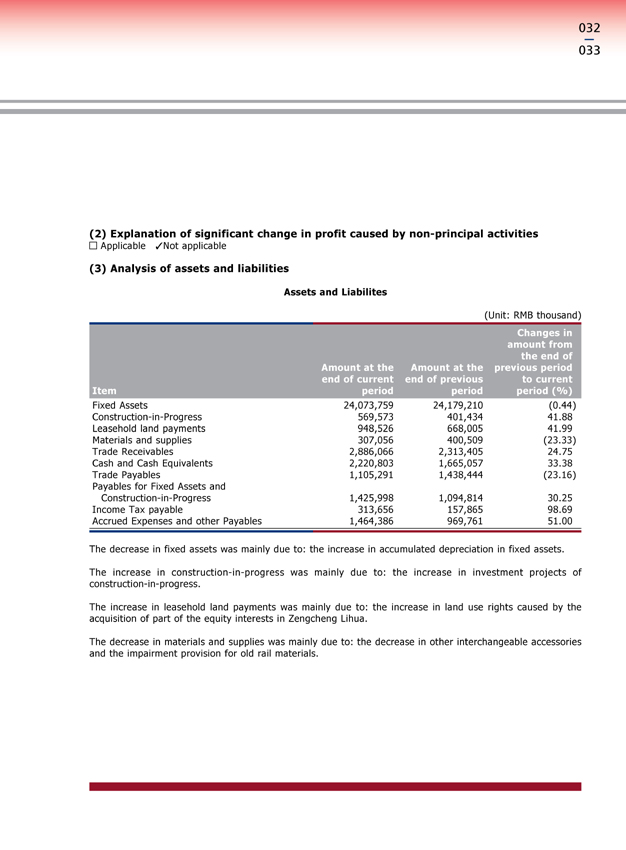
032
033
(2) |
|
Explanation of significant change in profit caused by non-principal activities
Applicable ?Not applicable
(3) |
|
Analysis of assets and liabilities
Assets and Liabilites
(Unit: RMB thousand)
Changes in
amount from
e end of
Amount at the Amount at the previous period
end of current end of previous to current
Item period period period (%)
Fixed Assets 24,073,759 24,179,210 (0.44)
Construction-in-Progress 569,573 401,434 41.88
Leasehold land payments 948,526 668,005 41.99
Materials and supplies 307,056 400,509 (23.33)
Trade Receivables 2,886,066 2,313,405 24.75
Cash and Cash Equivalents 2,220,803 1,665,057 33.38
Trade Payables 1,105,291 1,438,444 (23.16)
Payables for Fixed Assets and
Construction-in-Progress 1,425,998 1,094,814 30.25
Income Tax payable 313,656 157,865 98.69
Accrued Expenses and other Payables 1,464,386 969,761 51.00
The decrease in fixed assets was mainly due to: the increase in accumulated depreciation in fixed assets.
The increase in construction-in-progress was mainly due to: the increase in investment projects of construction-in-progress.
The increase in leasehold land payments was mainly due to: the increase in land use rights caused by the acquisition of part of the equity interests in Zengcheng Lihua.
The decrease in materials and supplies was mainly due to: the decrease in other interchangeable accessories and the impairment provision for old rail materials.
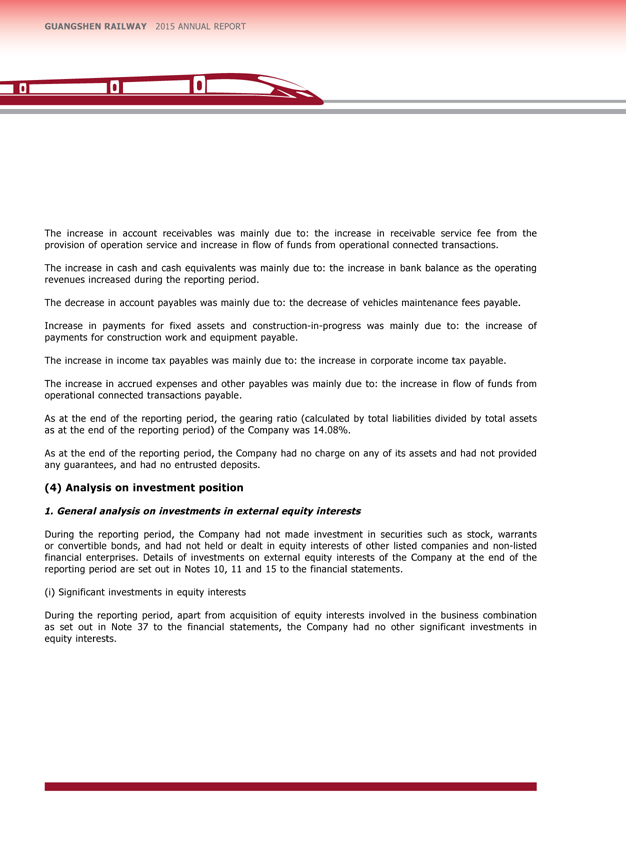
GUANGSHEN RAILWAY 2015 ANNUAL REPORT
The increase in account receivables was mainly due to: the increase in receivable service fee from the provision of operation service and increase in flow of funds from operational connected transactions.
The increase in cash and cash equivalents was mainly due to: the increase in bank balance as the operating revenues increased during the reporting period.
The decrease in account payables was mainly due to: the decrease of vehicles maintenance fees payable.
Increase in payments for fixed assets and construction-in-progress was mainly due to: the increase of payments for construction work and equipment payable.
The increase in income tax payables was mainly due to: the increase in corporate income tax payable.
The increase in accrued expenses and other payables was mainly due to: the increase in flow of funds from operational connected transactions payable.
As at the end of the reporting period, the gearing ratio (calculated by total liabilities divided by total assets as at the end of the reporting period) of the Company was 14.08%.
As at the end of the reporting period, the Company had no charge on any of its assets and had not provided any guarantees, and had no entrusted deposits.
(4) |
| Analysis on investment position |
1. General analysis on investments in external equity interests
During the reporting period, the Company had not made investment in securities such as stock, warrants or convertible bonds, and had not held or dealt in equity interests of other listed companies and non-listed financial enterprises. Details of investments on external equity interests of the Company at the end of the reporting period are set out in Notes 10, 11 and 15 to the financial statements.
(i) |
| Significant investments in equity interests |
During the reporting period, apart from acquisition of equity interests involved in the business combination as set out in Note 37 to the financial statements, the Company had no other significant investments in equity interests.
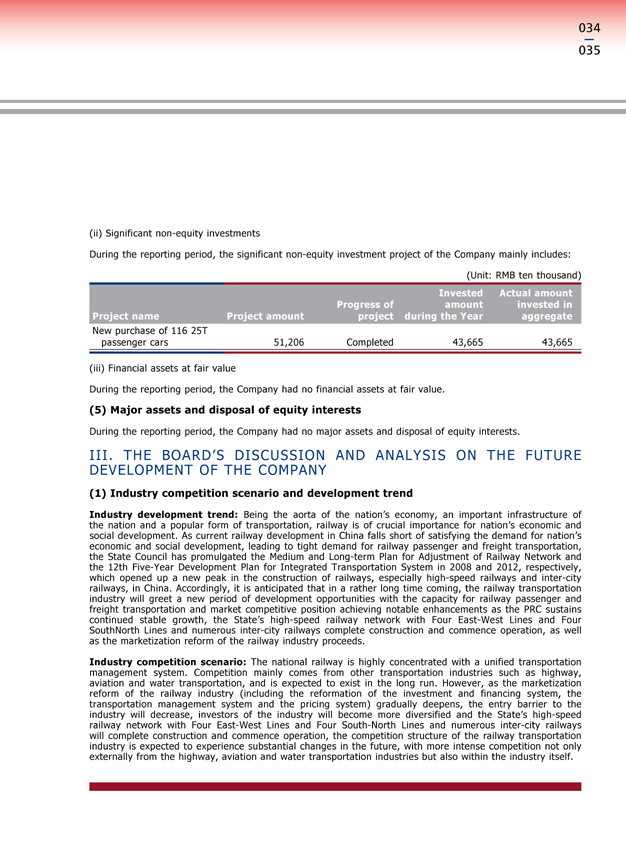
034
035
(ii) Significant non-equity investments
During the reporting period, the significant non-equity investment project of the Company mainly includes: (Unit: RMB ten thousand)
Invested Actual amount
Progress of amount invested in
Project name Project amount project during the Year aggregate
New purchase of 116 25T
passenger cars 51,206 Completed 43,665 43,665
(iii) Financial assets at fair value
During the reporting period, the Company had no financial assets at fair value.
(5) |
| Major assets and disposal of equity interests |
During the reporting period, the Company had no major assets and disposal of equity interests.
III. THE BOARD’S DISCUSSION AND ANALYSIS ON THE FUTURE DEVELOPMENT OF THE COMPANY
(1) |
| Industry competition scenario and development trend |
Industry development trend: Being the aorta of the nation’s economy, an important infrastructure of the nation and a popular form of transportation, railway is of crucial importance for nation’s economic and social development. As current railway development in China falls short of satisfying the demand for nation’s economic and social development, leading to tight demand for railway passenger and freight transportation, the State Council has promulgated the Medium and Long-term Plan for Adjustment of Railway Network and the 12th Five-Year Development Plan for Integrated Transportation System in 2008 and 2012, respectively, which opened up a new peak in the construction of railways, especially high-speed railways and inter-city railways, in China. Accordingly, it is anticipated that in a rather long time coming, the railway transportation industry will greet a new period of development opportunities with the capacity for railway passenger and freight transportation and market competitive position achieving notable enhancements as the PRC sustains continued stable growth, the State’s high-speed railway network with Four East-West Lines and Four SouthNorth Lines and numerous inter-city railways complete construction and commence operation, as well as the marketization reform of the railway industry proceeds.
Industry competition scenario: The national railway is highly concentrated with a unified transportation management system. Competition mainly comes from other transportation industries such as highway, aviation and water transportation, and is expected to exist in the long run. However, as the marketization reform of the railway industry (including the reformation of the investment and financing system, the transportation management system and the pricing system) gradually deepens, the entry barrier to the industry will decrease, investors of the industry will become more diversified and the State’s high-speed railway network with Four East-West Lines and Four South-North Lines and numerous inter-city railways will complete construction and commence operation, the competition structure of the railway transportation industry is expected to experience substantial changes in the future, with more intense competition not only externally from the highway, aviation and water transportation industries but also within the industry itself.
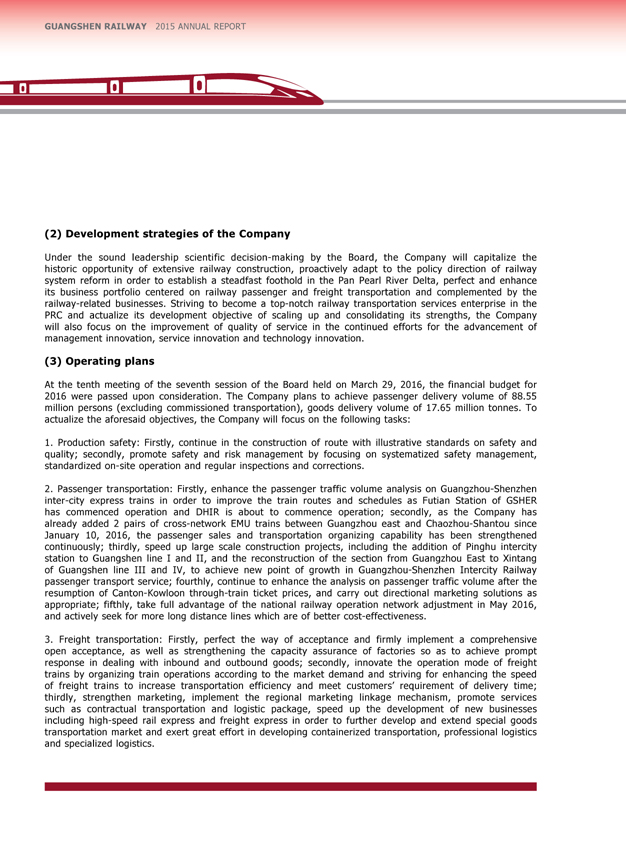
GUANGSHEN RAILWAY 2015 ANNUAL REPORT
(2) |
| Development strategies of the Company |
Under the sound leadership scientific decision-making by the Board, the Company will capitalize the historic opportunity of extensive railway construction, proactively adapt to the policy direction of railway system reform in order to establish a steadfast foothold in the Pan Pearl River Delta, perfect and enhance its business portfolio centered on railway passenger and freight transportation and complemented by the railway-related businesses. Striving to become a top-notch railway transportation services enterprise in the PRC and actualize its development objective of scaling up and consolidating its strengths, the Company will also focus on the improvement of quality of service in the continued efforts for the advancement of management innovation, service innovation and technology innovation.
(3) |
| Operating plans |
At the tenth meeting of the seventh session of the Board held on March 29, 2016, the financial budget for 2016 were passed upon consideration. The Company plans to achieve passenger delivery volume of 88.55 million persons (excluding commissioned transportation), goods delivery volume of 17.65 million tonnes. To actualize the aforesaid objectives, the Company will focus on the following tasks:
1. Production safety: Firstly, continue in the construction of route with illustrative standards on safety and quality; secondly, promote safety and risk management by focusing on systematized safety management, standardized on-site operation and regular inspections and corrections.
2. Passenger transportation: Firstly, enhance the passenger traffic volume analysis on Guangzhou-Shenzhen inter-city express trains in order to improve the train routes and schedules as Futian Station of GSHER has commenced operation and DHIR is about to commence operation; secondly, as the Company has already added 2 pairs of cross-network EMU trains between Guangzhou east and Chaozhou-Shantou since January 10, 2016, the passenger sales and transportation organizing capability has been strengthened continuously; thirdly, speed up large scale construction projects, including the addition of Pinghu intercity station to Guangshen line I and II, and the reconstruction of the section from Guangzhou East to Xintang of Guangshen line III and IV, to achieve new point of growth in Guangzhou-Shenzhen Intercity Railway passenger transport service; fourthly, continue to enhance the analysis on passenger traffic volume after the resumption of Canton-Kowloon through-train ticket prices, and carry out directional marketing solutions as appropriate; fifthly, take full advantage of the national railway operation network adjustment in May 2016, and actively seek for more long distance lines which are of better cost-effectiveness.
3. Freight transportation: Firstly, perfect the way of acceptance and firmly implement a comprehensive open acceptance, as well as strengthening the capacity assurance of factories so as to achieve prompt response in dealing with inbound and outbound goods; secondly, innovate the operation mode of freight trains by organizing train operations according to the market demand and striving for enhancing the speed of freight trains to increase transportation efficiency and meet customers’ requirement of delivery time; thirdly, strengthen marketing, implement the regional marketing linkage mechanism, promote services such as contractual transportation and logistic package, speed up the development of new businesses including high-speed rail express and freight express in order to further develop and extend special goods transportation market and exert great effort in developing containerized transportation, professional logistics and specialized logistics.
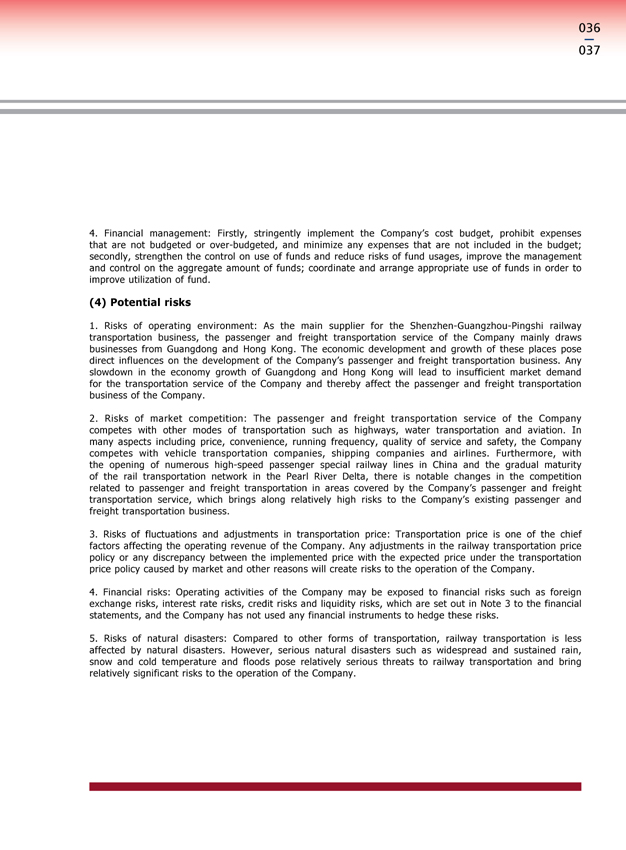
036
037
4. Financial management: Firstly, stringently implement the Company’s cost budget, prohibit expenses that are not budgeted or over-budgeted, and minimize any expenses that are not included in the budget; secondly, strengthen the control on use of funds and reduce risks of fund usages, improve the management and control on the aggregate amount of funds; coordinate and arrange appropriate use of funds in order to improve utilization of fund.
(4) |
| Potential risks |
1. Risks of operating environment: As the main supplier for the Shenzhen-Guangzhou-Pingshi railway transportation business, the passenger and freight transportation service of the Company mainly draws businesses from Guangdong and Hong Kong. The economic development and growth of these places pose direct influences on the development of the Company’s passenger and freight transportation business. Any slowdown in the economy growth of Guangdong and Hong Kong will lead to insufficient market demand for the transportation service of the Company and thereby affect the passenger and freight transportation business of the Company.
2. Risks of market competition: The passenger and freight transportation service of the Company competes with other modes of transportation such as highways, water transportation and aviation. In many aspects including price, convenience, running frequency, quality of service and safety, the Company competes with vehicle transportation companies, shipping companies and airlines. Furthermore, with the opening of numerous high-speed passenger special railway lines in China and the gradual maturity of the rail transportation network in the Pearl River Delta, there is notable changes in the competition related to passenger and freight transportation in areas covered by the Company’s passenger and freight transportation service, which brings along relatively high risks to the Company’s existing passenger and freight transportation business.
3. Risks of fluctuations and adjustments in transportation price: Transportation price is one of the chief factors affecting the operating revenue of the Company. Any adjustments in the railway transportation price policy or any discrepancy between the implemented price with the expected price under the transportation price policy caused by market and other reasons will create risks to the operation of the Company.
4. Financial risks: Operating activities of the Company may be exposed to financial risks such as foreign exchange risks, interest rate risks, credit risks and liquidity risks, which are set out in Note 3 to the financial statements, and the Company has not used any financial instruments to hedge these risks.
5. Risks of natural disasters: Compared to other forms of transportation, railway transportation is less affected by natural disasters. However, serious natural disasters such as widespread and sustained rain, snow and cold temperature and floods pose relatively serious threats to railway transportation and bring relatively significant risks to the operation of the Company.
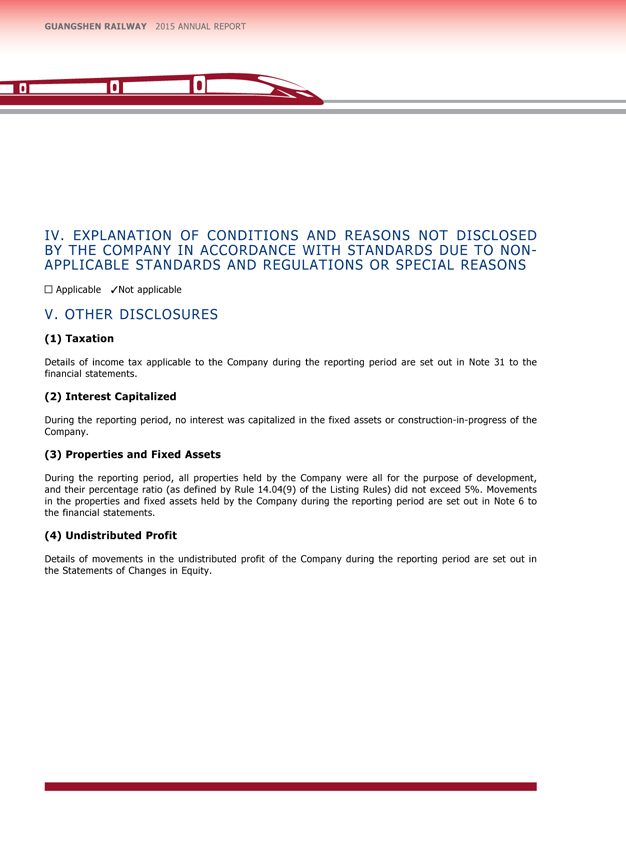
GUANGSHEN RAILWAY 2015 ANNUAL REPORT
IV. EXPLANATION OF CONDITIONS AND REASONS NOT DISCLOSED BY THE COMPANY IN ACCORDANCE WITH STANDARDS DUE TO NON-APPLICABLE STANDARDS AND REGULATIONS OR SPECIAL REASONS
Applicable ?Not applicable
V. OTHER DISCLOSURES
(1) |
| Taxation |
Details of income tax applicable to the Company during the reporting period are set out in Note 31 to the financial statements.
(2) |
| Interest Capitalized |
During the reporting period, no interest was capitalized in the fixed assets or construction-in-progress of the Company.
(3) |
| Properties and Fixed Assets |
During the reporting period, all properties held by the Company were all for the purpose of development, and their percentage ratio (as defined by Rule 14.04(9) of the Listing Rules) did not exceed 5%. Movements in the properties and fixed assets held by the Company during the reporting period are set out in Note 6 to the financial statements.
(4) |
| Undistributed Profit |
Details of movements in the undistributed profit of the Company during the reporting period are set out in the Statements of Changes in Equity.
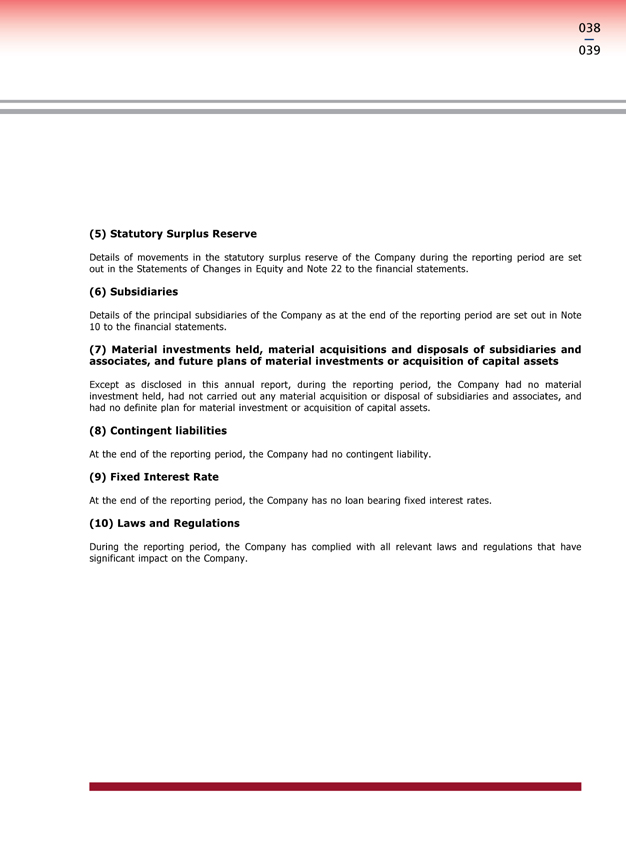
038
039
(5) |
| Statutory Surplus Reserve |
Details of movements in the statutory surplus reserve of the Company during the reporting period are set out in the Statements of Changes in Equity and Note 22 to the financial statements.
(6) |
| Subsidiaries |
Details of the principal subsidiaries of the Company as at the end of the reporting period are set out in Note 10 to the financial statements.
(7) associates, Material and investments future plans held, of material material investments acquisitions or and acquisition disposals of of capital subsidiaries assets and
Except as disclosed in this annual report, during the reporting period, the Company had no material investment held, had not carried out any material acquisition or disposal of subsidiaries and associates, and had no definite plan for material investment or acquisition of capital assets.
(8) |
| Contingent liabilities |
At the end of the reporting period, the Company had no contingent liability.
(9) |
| Fixed Interest Rate |
At the end of the reporting period, the Company has no loan bearing fixed interest rates.
(10) |
| Laws and Regulations |
During the reporting period, the Company has complied with all relevant laws and regulations that have significant impact on the Company.
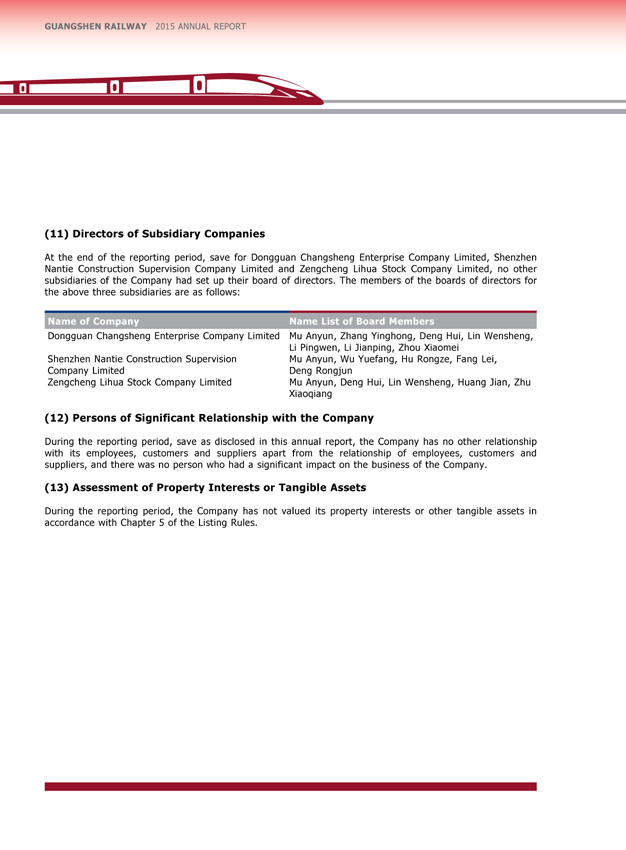
GUANGSHEN RAILWAY 2015 ANNUAL REPORT
(11) |
| Directors of Subsidiary Companies |
At the end of the reporting period, save for Dongguan Changsheng Enterprise Company Limited, Shenzhen Nantie Construction Supervision Company Limited and Zengcheng Lihua Stock Company Limited, no other subsidiaries of the Company had set up their board of directors. The members of the boards of directors for the above three subsidiaries are as follows:
Name of Company Name List of Board Members
Dongguan Changsheng Enterprise Company Limited Mu Anyun, Zhang Yinghong, Deng Hui, Lin Wensheng,
Li Pingwen, Li Jianping, Zhou Xiaomei
Shenzhen Nantie Construction Supervision Mu Anyun, Wu Yuefang, Hu Rongze, Fang Lei,
Company Limited Deng Rongjun
Zengcheng Lihua Stock Company Limited Mu Anyun, Deng Hui, Lin Wensheng, Huang Jian, Zhu
Xiaoqiang
(12) |
| Persons of Significant Relationship with the Company |
During the reporting period, save as disclosed in this annual report, the Company has no other relationship with its employees, customers and suppliers apart from the relationship of employees, customers and suppliers, and there was no person who had a significant impact on the business of the Company.
(13) |
| Assessment of Property Interests or Tangible Assets |
During the reporting period, the Company has not valued its property interests or other tangible assets in accordance with Chapter 5 of the Listing Rules.
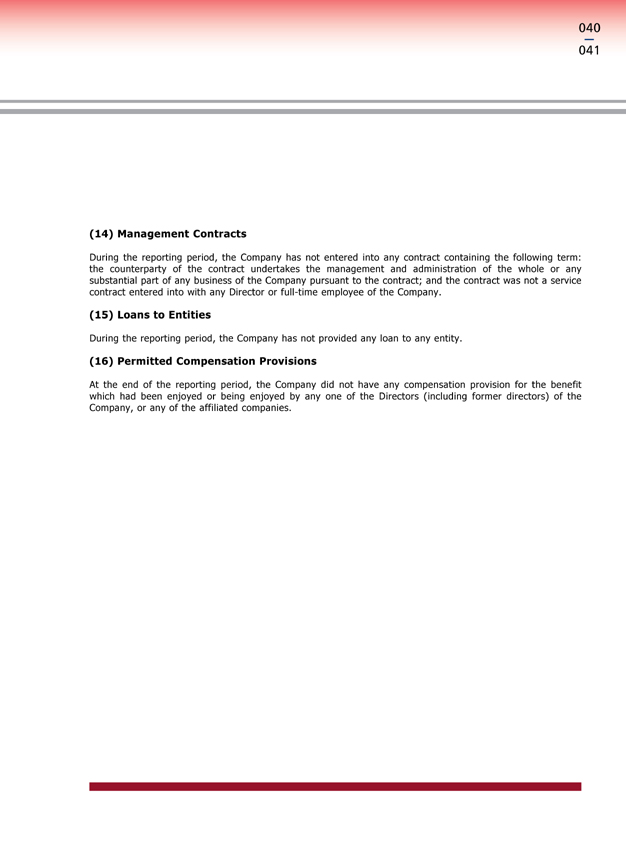
040
041
(14) |
| Management Contracts |
During the reporting period, the Company has not entered into any contract containing the following term: the counterparty of the contract undertakes the management and administration of the whole or any substantial part of any business of the Company pursuant to the contract; and the contract was not a service contract entered into with any Director or full-time employee of the Company.
(15) |
| Loans to Entities |
During the reporting period, the Company has not provided any loan to any entity.
(16) |
| Permitted Compensation Provisions |
At the end of the reporting period, the Company did not have any compensation provision for the benefit which had been enjoyed or being enjoyed by any one of the Directors (including former directors) of the Company, or any of the affiliated companies.
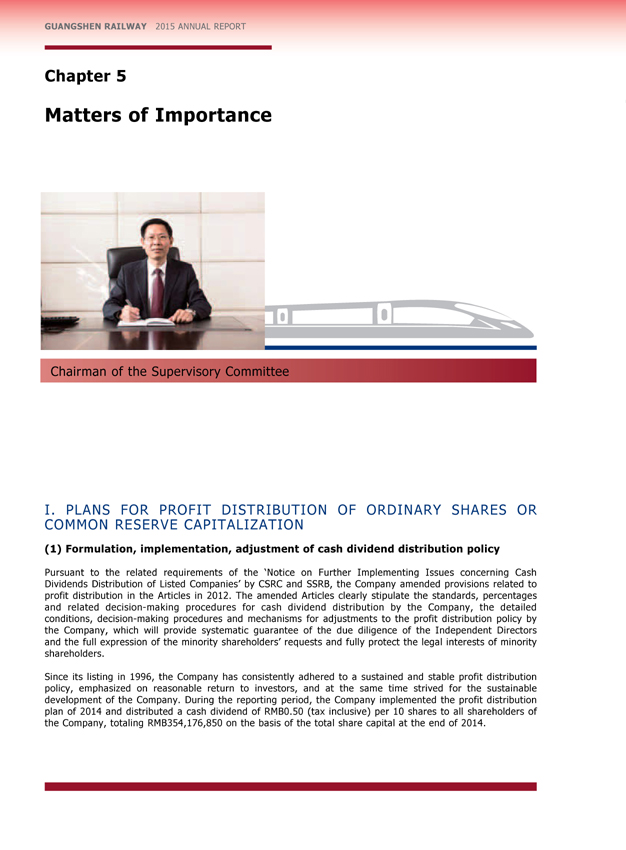
GUANGSHEN RAILWAY 2015 ANNUAL REPORT
Chapter 5
Matters of Importance
Chairman of the Supervisory Committee
I. PLANS FOR PROFIT DISTRIBUTION OF ORDINARY SHARES OR COMMON RESERVE CAPITALIZATION
(1) |
| Formulation, implementation, adjustment of cash dividend distribution policy |
Pursuant to the related requirements of the ‘Notice on Further Implementing Issues concerning Cash Dividends Distribution of Listed Companies’ by CSRC and SSRB, the Company amended provisions related to profit distribution in the Articles in 2012. The amended Articles clearly stipulate the standards, percentages and related decision-making procedures for cash dividend distribution by the Company, the detailed conditions, decision-making procedures and mechanisms for adjustments to the profit distribution policy by the Company, which will provide systematic guarantee of the due diligence of the Independent Directors and the full expression of the minority shareholders’ requests and fully protect the legal interests of minority shareholders.
Since its listing in 1996, the Company has consistently adhered to a sustained and stable profit distribution policy, emphasized on reasonable return to investors, and at the same time strived for the sustainable development of the Company. During the reporting period, the Company implemented the profit distribution plan of 2014 and distributed a cash dividend of RMB0.50 (tax inclusive) per 10 shares to all shareholders of the Company, totaling RMB354,176,850 on the basis of the total share capital at the end of 2014.
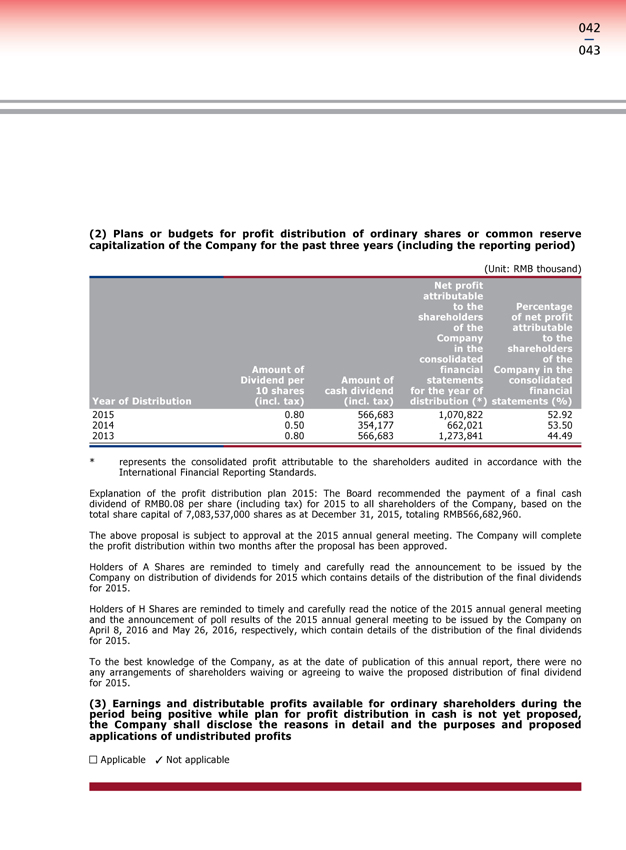
042
043
(2) |
| Plans or budgets for profit distribution of ordinary shares or common reserve |
capitalization of the Company for the past three years (including the reporting period)
(Unit: RMB thousand)
Net profit
attributable
to the Percentage
shareholders of net profit
of the attributable
Company to the
in the shareholders
consolidated of the
Amount of financial Company in the
Dividend per Amount of statements consolidated
10 shares cash dividend for the year of financial
Year of Distribution (incl. tax) (incl. tax) distribution (*) statements (%)
2015 0.80 566,683 1,070,822 52.92
2014 0.50 354,177 662,021 53.50
2013 0.80 566,683 1,273,841 44.49
* represents the consolidated profit attributable to the shareholders audited in accordance with the International Financial Reporting Standards.
Explanation of the profit distribution plan 2015: The Board recommended the payment of a final cash dividend of RMB0.08 per share (including tax) for 2015 to all shareholders of the Company, based on the total share capital of 7,083,537,000 shares as at December 31, 2015, totaling RMB566,682,960.
The above proposal is subject to approval at the 2015 annual general meeting. The Company will complete the profit distribution within two months after the proposal has been approved.
Holders of A Shares are reminded to timely and carefully read the announcement to be issued by the Company on distribution of dividends for 2015 which contains details of the distribution of the final dividends for 2015.
Holders of H Shares are reminded to timely and carefully read the notice of the 2015 annual general meeting and the announcement of poll results of the 2015 annual general meeting to be issued by the Company on April 8, 2016 and May 26, 2016, respectively, which contain details of the distribution of the final dividends for 2015.
To the best knowledge of the Company, as at the date of publication of this annual report, there were no any arrangements of shareholders waiving or agreeing to waive the proposed distribution of final dividend for 2015.
(3) Earnings and distributable profits available for ordinary shareholders during the period being positive while plan for profit distribution in cash is not yet proposed, the applications Company of shall undistributed disclose profits the reasons in detail and the purposes and proposed
Applicable ??Not applicable
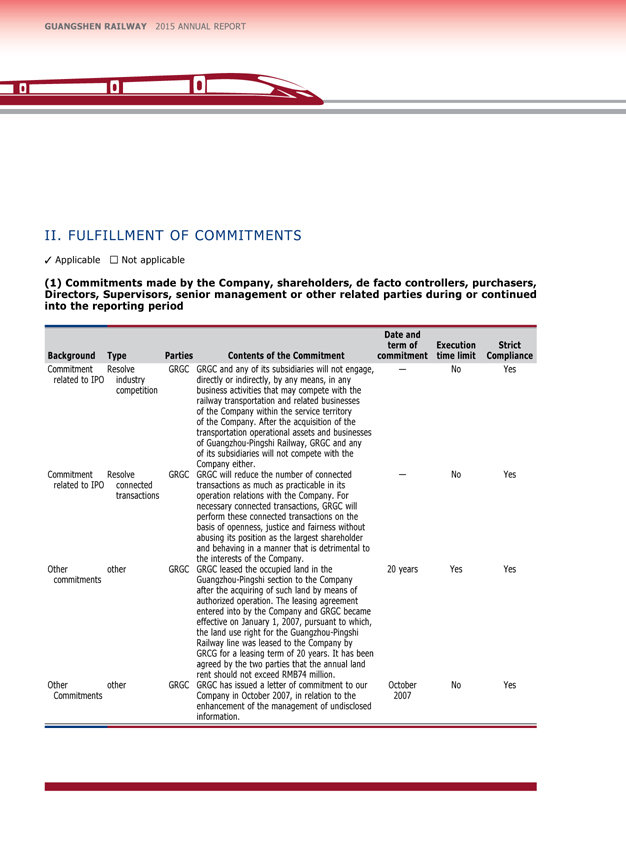
GUANGSHEN RAILWAY 2015 ANNUAL REPORT
II. FULFILLMENT OF COMMITMENTS
??Applicable Not applicable
(1) Directors, Commitments Supervisors, made senior by the management Company, shareholders, or other related de facto parties controllers, during or purchasers, continued into the reporting period
Date and
term of Execution Strict
Background Type Parties Contents of the Commitment commitment time limit Compliance
Commitment Resolve GRGC GRGC and any of its subsidiaries will not engage, — No Yes
related to IPO industry directly or indirectly, by any means, in any
competition business activities that may compete with the
railway transportation and related businesses
of the Company within the service territory
of the Company. After the acquisition of the
transportation operational assets and businesses
of Guangzhou-Pingshi Railway, GRGC and any
of its subsidiaries will not compete with the
Company either.
Commitment Resolve GRGC GRGC will reduce the number of connected — No Yes
related to IPO connected transactions as much as practicable in its
transactions operation relations with the Company. For
necessary connected transactions, GRGC will
perform these connected transactions on the
basis of openness, justice and fairness without
abusing its position as the largest shareholder
and behaving in a manner that is detrimental to
the interests of the Company.
Other other GRGC GRGC leased the occupied land in the 20 years Yes Yes
commitments Guangzhou-Pingshi section to the Company
after the acquiring of such land by means of
authorized operation. The leasing agreement
entered into by the Company and GRGC became
effective on January 1, 2007, pursuant to which,
the land use right for the Guangzhou-Pingshi
Railway line was leased to the Company by
GRCG for a leasing term of 20 years. It has been
agreed by the two parties that the annual land
rent should not exceed RMB74 million.
Other other GRGC GRGC has issued a letter of commitment to our October No Yes
Commitments Company in October 2007, in relation to the 2007
enhancement of the management of undisclosed
information.
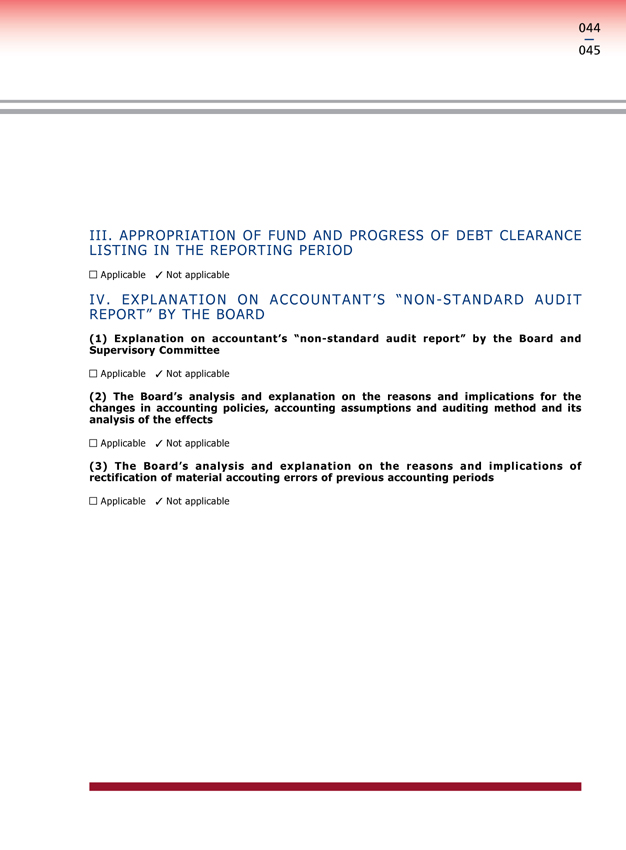
044
045
III. APPROPRIATION OF FUND AND PROGRESS OF DEBT CLEARANCE LISTING IN THE REPORTING PERIOD
Applicable ??Not applicable
IV. EXPLANATION ON ACCOUNTANT’S “NON-STANDARD AUDIT REPORT” BY THE BOARD
(1) |
| Supervisory Explanation Committee on accountant’s “non-standard audit report” by the Board and |
Applicable ??Not applicable
(2) changes The Board’s in accounting analysis policies, and explanation accounting assumptions on the reasons and and auditing implications method for and the its analysis of the effects
Applicable ??Not applicable
(3) rectification The Board’s of material analysis accouting and explanation errors of previous on the accounting reasons periods and implications of
Applicable ??Not applicable
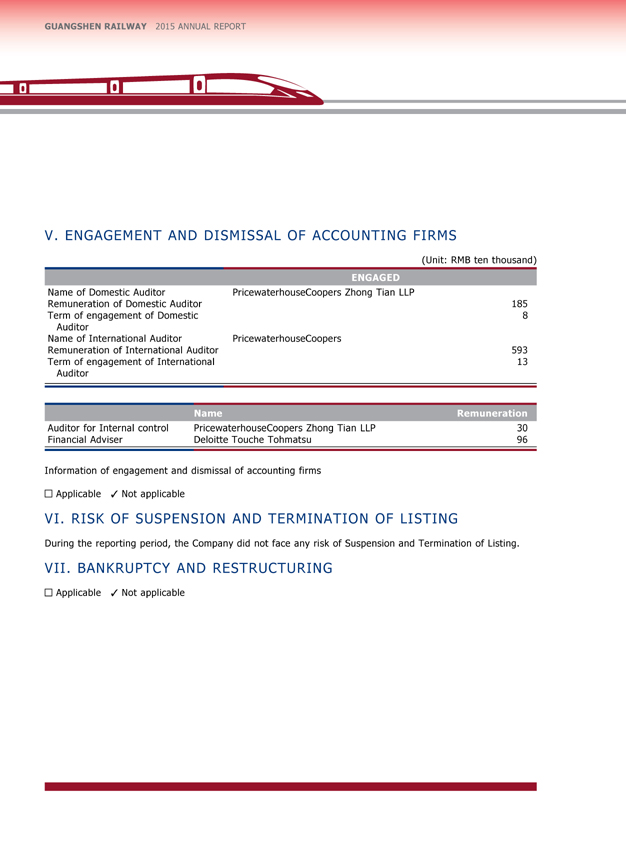
GUANGSHEN RAILWAY 2015 ANNUAL REPORT
V. ENGAGEMENT AND DISMISSAL OF ACCOUNTING FIRMS
(Unit: RMB ten thousand)
ENGAGED
Name of Domestic Auditor PricewaterhouseCoopers Zhong Tian LLP
Remuneration of Domestic Auditor 185
Term of engagement of Domestic 8
Auditor
Name of International Auditor PricewaterhouseCoopers
Remuneration of International Auditor 593
Term of engagement of International 13
Auditor
Name Remuneration
Auditor for Internal control PricewaterhouseCoopers Zhong Tian LLP 30
Financial Adviser Deloitte Touche Tohmatsu 96
Information of engagement and dismissal of accounting firms
Applicable ??Not applicable
VI. RISK OF SUSPENSION AND TERMINATION OF LISTING
During the reporting period, the Company did not face any risk of Suspension and Termination of Listing.
VII. BANKRUPTCY AND RESTRUCTURING
Applicable ??Not applicable
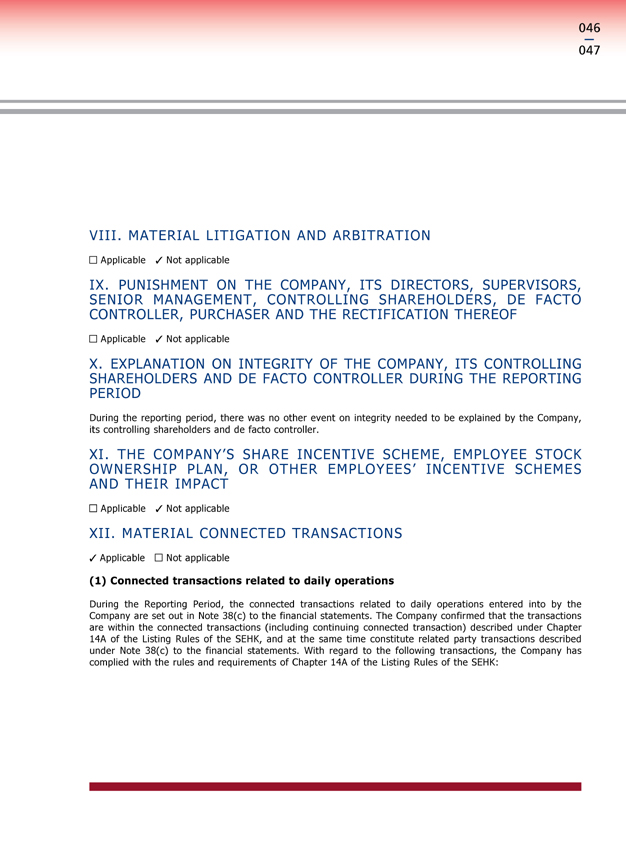
046
047
VIII. MATERIAL LITIGATION AND ARBITRATION
Applicable ??Not applicable
IX. PUNISHMENT ON THE COMPANY, ITS DIRECTORS, SUPERVISORS, SENIOR MANAGEMENT, CONTROLLING SHAREHOLDERS, DE FACTO CONTROLLER, PURCHASER AND THE RECTIFICATION THEREOF
Applicable ??Not applicable
X. EXPLANATION ON INTEGRITY OF THE COMPANY, ITS CONTROLLING SHAREHOLDERS AND DE FACTO CONTROLLER DURING THE REPORTING PERIOD
During the reporting period, there was no other event on integrity needed to be explained by the Company, its controlling shareholders and de facto controller.
XI. THE COMPANY’S SHARE INCENTIVE SCHEME, EMPLOYEE STOCK OWNERSHIP PLAN, OR OTHER EMPLOYEES’ INCENTIVE SCHEMES AND THEIR IMPACT
Applicable ??Not applicable
XII. MATERIAL CONNECTED TRANSACTIONS
??Applicable Not applicable
(1) |
| Connected transactions related to daily operations |
During the Reporting Period, the connected transactions related to daily operations entered into by the Company are set out in Note 38(c) to the financial statements. The Company confirmed that the transactions are within the connected transactions (including continuing connected transaction) described under Chapter 14A of the Listing Rules of the SEHK, and at the same time constitute related party transactions described under Note 38(c) to the financial statements. With regard to the following transactions, the Company has complied with the rules and requirements of Chapter 14A of the Listing Rules of the SEHK:
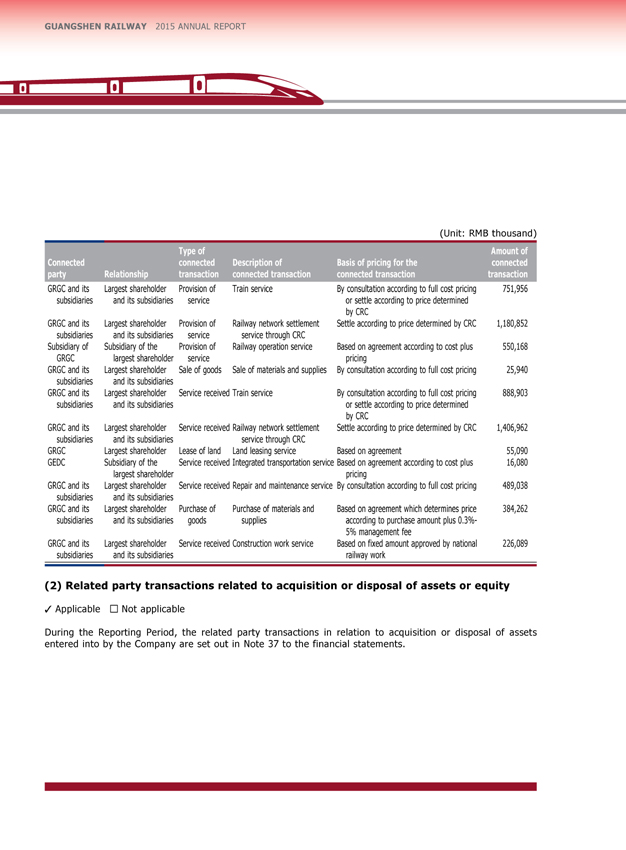
GUANGSHEN RAILWAY 2015 ANNUAL REPORT
(Unit: RMB thousand)
Type of Amount of
Connected connected Description of Basis of pricing for the connected
party Relationship transaction connected transaction connected transaction transaction
GRGC and its Largest shareholder Provision of Train service By consultation according to full cost pricing 751,956
subsidiaries and its subsidiaries service or settle according to price determined
by CRC
GRGC and its Largest shareholder Provision of Railway network settlement Settle according to price determined by CRC 1,180,852
subsidiaries and its subsidiaries service service through CRC
Subsidiary of Subsidiary of the Provision of Railway operation service Based on agreement according to cost plus 550,168
GRGC largest shareholder service pricing
GRGC and its Largest shareholder Sale of goods Sale of materials and supplies By consultation according to full cost pricing 25,940
subsidiaries and its subsidiaries
GRGC and its Largest shareholder Service received Train service By consultation according to full cost pricing 888,903
subsidiaries and its subsidiaries or settle according to price determined
by CRC
GRGC and its Largest shareholder Service received Railway network settlement Settle according to price determined by CRC 1,406,962
subsidiaries and its subsidiaries service through CRC
GRGC Largest shareholder Lease of land Land leasing service Based on agreement 55,090
GEDC Subsidiary of the Service received Integrated transportation service Based on agreement according to cost plus 16,080
largest shareholder pricing
GRGC and its Largest shareholder Service received Repair and maintenance service By consultation according to full cost pricing 489,038
subsidiaries and its subsidiaries
GRGC and its Largest shareholder Purchase of Purchase of materials and Based on agreement which determines price 384,262
subsidiaries and its subsidiaries goods supplies according to purchase amount plus 0.3%-
5% management fee
GRGC and its Largest shareholder Service received Construction work service Based on fixed amount approved by national 226,089
subsidiaries and its subsidiaries railway work
(2) |
| Related party transactions related to acquisition or disposal of assets or equity |
??Applicable Not applicable
During the Reporting Period, the related party transactions in relation to acquisition or disposal of assets entered into by the Company are set out in Note 37 to the financial statements.
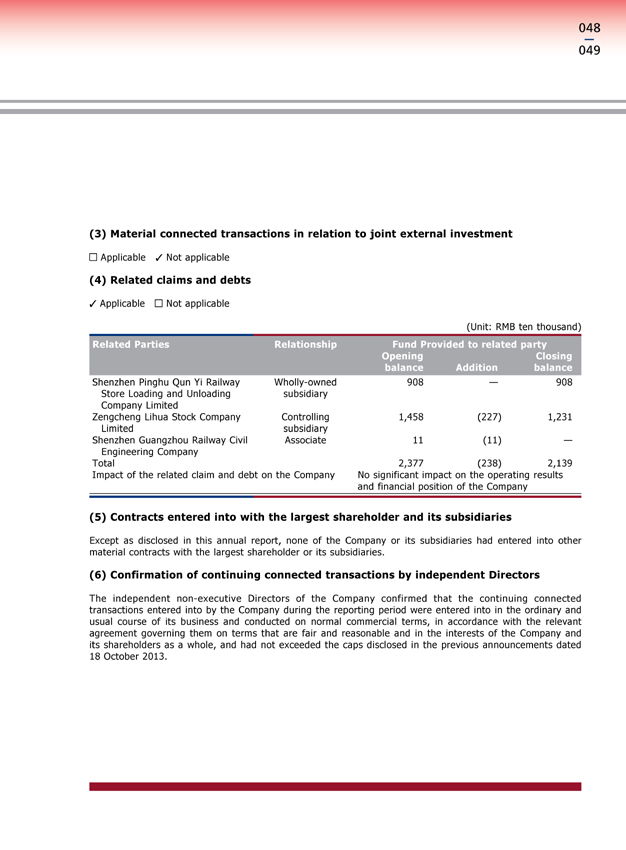
048
049
(3) |
| Material connected transactions in relation to joint external investment |
Applicable ??Not applicable
(4) |
| Related claims and debts |
??Applicable Not applicable
(Unit: RMB ten thousand)
Related Parties Relationship Fund Provided to related party
Opening Closing
balance Addition balance
Shenzhen Pinghu Qun Yi Railway Wholly-owned 908 — 908
Store Loading and Unloading subsidiary
Company Limited
Zengcheng Lihua Stock Company Controlling 1,458 (227) 1,231
Limited subsidiary
Shenzhen Guangzhou Railway Civil Associate 11 (11) —
Engineering Company
Total 2,377 (238) 2,139
Impact of the related claim and debt on the Company No significant impact on the operating results
and financial position of the Company
(5) |
| Contracts entered into with the largest shareholder and its subsidiaries |
Except as disclosed in this annual report, none of the Company or its subsidiaries had entered into other material contracts with the largest shareholder or its subsidiaries.
(6) |
| Confirmation of continuing connected transactions by independent Directors |
The independent non-executive Directors of the Company confirmed that the continuing connected transactions entered into by the Company during the reporting period were entered into in the ordinary and usual course of its business and conducted on normal commercial terms, in accordance with the relevant agreement governing them on terms that are fair and reasonable and in the interests of the Company and its shareholders as a whole, and had not exceeded the caps disclosed in the previous announcements dated
18 October 2013.
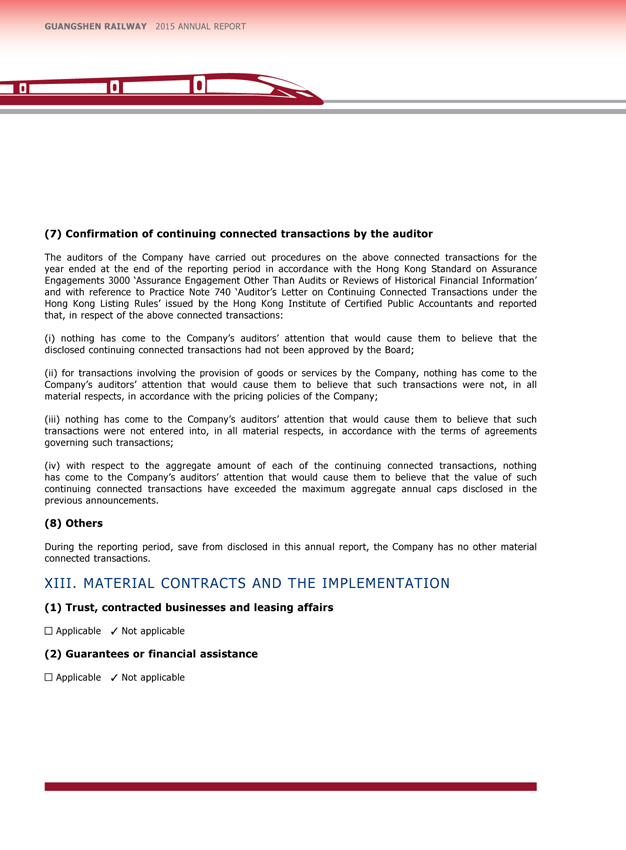
GUANGSHEN RAILWAY 2015 ANNUAL REPORT
(7) |
| Confirmation of continuing connected transactions by the auditor |
The auditors of the Company have carried out procedures on the above connected transactions for the year ended at the end of the reporting period in accordance with the Hong Kong Standard on Assurance Engagements 3000 ‘Assurance Engagement Other Than Audits or Reviews of Historical Financial Information’ and with reference to Practice Note 740 ‘Auditor’s Letter on Continuing Connected Transactions under the Hong Kong Listing Rules’ issued by the Hong Kong Institute of Certified Public Accountants and reported that, in respect of the above connected transactions:
(i) nothing has come to the Company’s auditors’ attention that would cause them to believe that the disclosed continuing connected transactions had not been approved by the Board;
(ii) for transactions involving the provision of goods or services by the Company, nothing has come to the Company’s auditors’ attention that would cause them to believe that such transactions were not, in all material respects, in accordance with the pricing policies of the Company;
(iii) nothing has come to the Company’s auditors’ attention that would cause them to believe that such transactions were not entered into, in all material respects, in accordance with the terms of agreements governing such transactions;
(iv) with respect to the aggregate amount of each of the continuing connected transactions, nothing has come to the Company’s auditors’ attention that would cause them to believe that the value of such continuing connected transactions have exceeded the maximum aggregate annual caps disclosed in the previous announcements.
(8) |
| Others |
During the reporting period, save from disclosed in this annual report, the Company has no other material connected transactions.
XIII. MATERIAL CONTRACTS AND THE IMPLEMENTATION
(1) |
| Trust, contracted businesses and leasing affairs |
Applicable ??Not applicable
(2) |
| Guarantees or financial assistance |
Applicable ??Not applicable
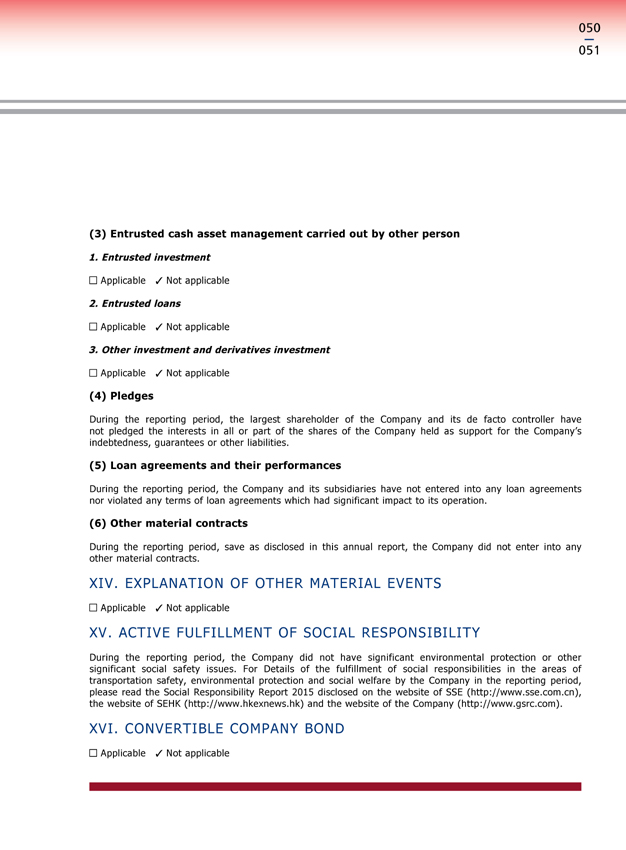
050
051
(3) |
| Entrusted cash asset management carried out by other person |
1. Entrusted investment
Applicable ??Not applicable
2. Entrusted loans
Applicable ??Not applicable
3. Other investment and derivatives investment
Applicable ??Not applicable
(4) |
| Pledges |
During the reporting period, the largest shareholder of the Company and its de facto controller have not pledged the interests in all or part of the shares of the Company held as support for the Company’s indebtedness, guarantees or other liabilities.
(5) |
| Loan agreements and their performances |
During the reporting period, the Company and its subsidiaries have not entered into any loan agreements nor violated any terms of loan agreements which had significant impact to its operation.
(6) |
| Other material contracts |
During the reporting period, save as disclosed in this annual report, the Company did not enter into any other material contracts.
XIV. EXPLANATION OF OTHER MATERIAL EVENTS
Applicable ??Not applicable
XV. ACTIVE FULFILLMENT OF SOCIAL RESPONSIBILITY
During the reporting period, the Company did not have significant environmental protection or other significant social safety issues. For Details of the fulfillment of social responsibilities in the areas of transportation safety, environmental protection and social welfare by the Company in the reporting period, please read the Social Responsibility Report 2015 disclosed on the website of SSE (http://www.sse.com.cn), the website of SEHK (http://www.hkexnews.hk) and the website of the Company (http://www.gsrc.com).
XVI. CONVERTIBLE COMPANY BOND
Applicable ??Not applicable
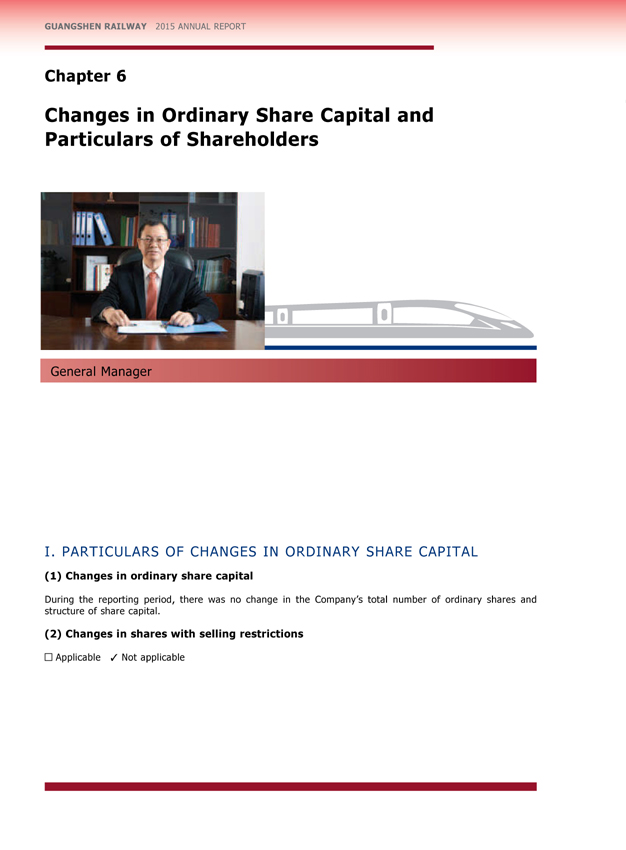
GUANGSHEN RAILWAY 2015 ANNUAL REPORT
Chapter 6
Changes in Ordinary Share Capital and Particulars of Shareholders
General Manager
I. PARTICULARS OF CHANGES IN ORDINARY SHARE CAPITAL
(1) |
| Changes in ordinary share capital |
During the reporting period, there was no change in the Company’s total number of ordinary shares and structure of share capital.
(2) |
| Changes in shares with selling restrictions |
?Applicable ? Not applicable
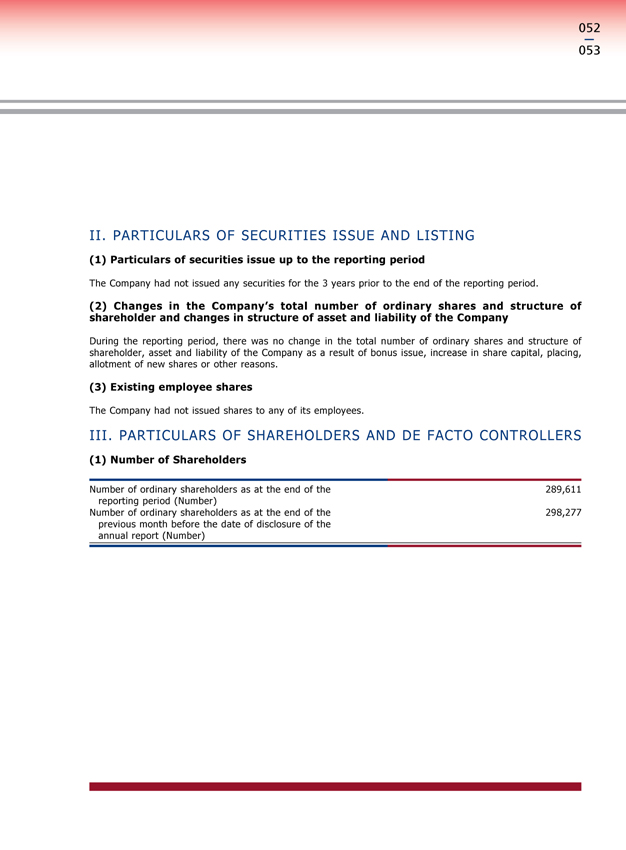
052
053
II. PARTICULARS OF SECURITIES ISSUE AND LISTING
(1) |
| Particulars of securities issue up to the reporting period |
The Company had not issued any securities for the 3 years prior to the end of the reporting period.
(2) shareholder Changes and in changes the Company’s in structure total of number asset and of liability ordinary of the shares Company and structure of
During the reporting period, there was no change in the total number of ordinary shares and structure of shareholder, asset and liability of the Company as a result of bonus issue, increase in share capital, placing, allotment of new shares or other reasons.
(3) |
| Existing employee shares |
The Company had not issued shares to any of its employees.
III. PARTICULARS OF SHAREHOLDERS AND DE FACTO CONTROLLERS
(1) |
| Number of Shareholders |
Number of ordinary shareholders as at the end of the 289,611
reporting period (Number)
Number of ordinary shareholders as at the end of the 298,277
previous month before the date of disclosure of the
annual report (Number)
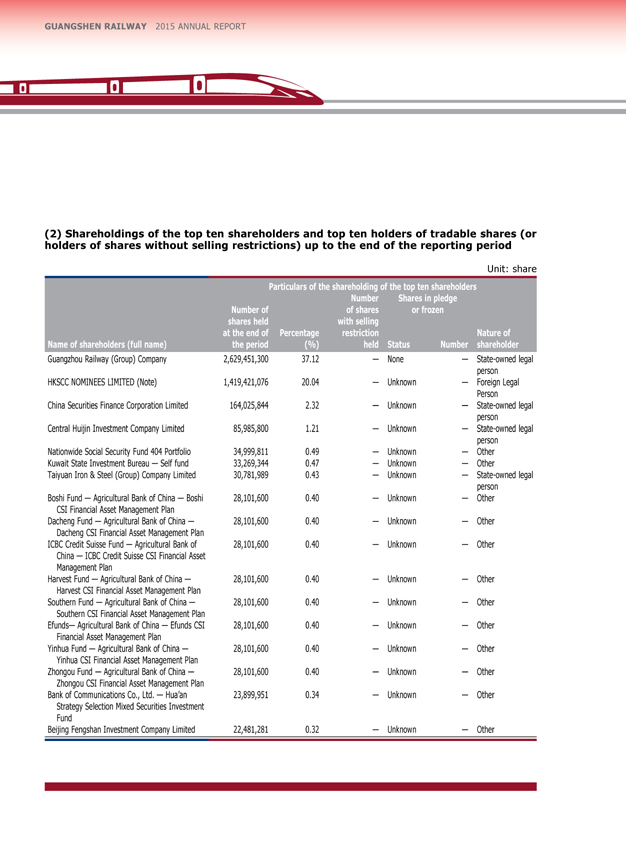
GUANGSHEN RAILWAY 2015 ANNUAL REPORT
(2) |
| Shareholdings of the top ten shareholders and top ten holders of tradable shares (or |
holders of shares without selling restrictions) up to the end of the reporting period
Unit: share
Particulars of the shareholding of the top ten shareholders
Number Shares in pledge
Number of of shares or frozen
shares held with selling
at the end of Percentage restriction Nature of
Name of shareholders (full name) the period (%) held Status Number shareholder
Guangzhou Railway (Group) Company 2,629,451,300 37.12 — None — State-owned legal
person
HKSCC NOMINEES LIMITED (Note) 1,419,421,076 20.04 — Unknown — Foreign Legal
Person
China Securities Finance Corporation Limited 164,025,844 2.32 — Unknown — State-owned legal
person
Central Huijin Investment Company Limited 85,985,800 1.21 — Unknown — State-owned legal
person
Nationwide Social Security Fund 404 Portfolio 34,999,811 0.49 — Unknown — Other
Kuwait State Investment Bureau — Self fund 33,269,344 0.47 — Unknown — Other
Taiyuan Iron & Steel (Group) Company Limited 30,781,989 0.43 — Unknown — State-owned legal
person
Boshi Fund — Agricultural Bank of China — Boshi 28,101,600 0.40 — Unknown — Other
CSI Financial Asset Management Plan
Dacheng Fund — Agricultural Bank of China — 28,101,600 0.40 — Unknown — Other
Dacheng CSI Financial Asset Management Plan
ICBC Credit Suisse Fund — Agricultural Bank of 28,101,600 0.40 — Unknown — Other
China — ICBC Credit Suisse CSI Financial Asset
Management Plan
Harvest Fund — Agricultural Bank of China — 28,101,600 0.40 — Unknown — Other
Harvest CSI Financial Asset Management Plan
Southern Fund — Agricultural Bank of China — 28,101,600 0.40 — Unknown — Other
Southern CSI Financial Asset Management Plan
Efunds— Agricultural Bank of China — Efunds CSI 28,101,600 0.40 — Unknown — Other
Financial Asset Management Plan
Yinhua Fund — Agricultural Bank of China — 28,101,600 0.40 — Unknown — Other
Yinhua CSI Financial Asset Management Plan
Zhongou Fund — Agricultural Bank of China — 28,101,600 0.40 — Unknown — Other
Zhongou CSI Financial Asset Management Plan
Bank of Communications Co., Ltd. — Hua’an 23,899,951 0.34 — Unknown — Other
Strategy Selection Mixed Securities Investment
Fund
Beijing Fengshan Investment Company Limited 22,481,281 0.32 — Unknown — Other
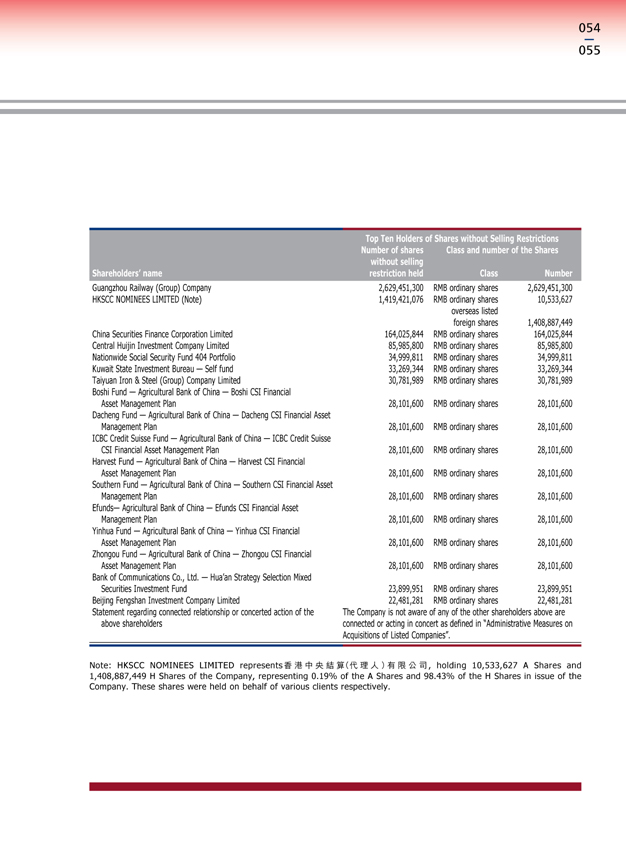
054
055
Top Ten Holders of Shares without Selling Restrictions
Number of shares Class and number of the Shares
without selling
Shareholders’ name restriction held Class Number
Guangzhou Railway (Group) Company 2,629,451,300 RMB ordinary shares 2,629,451,300
HKSCC NOMINEES LIMITED (Note) 1,419,421,076 RMB ordinary shares 10,533,627
overseas listed
foreign shares 1,408,887,449
China Securities Finance Corporation Limited 164,025,844 RMB ordinary shares 164,025,844
Central Huijin Investment Company Limited 85,985,800 RMB ordinary shares 85,985,800
Nationwide Social Security Fund 404 Portfolio 34,999,811 RMB ordinary shares 34,999,811
Kuwait State Investment Bureau — Self fund 33,269,344 RMB ordinary shares 33,269,344
Taiyuan Iron & Steel (Group) Company Limited 30,781,989 RMB ordinary shares 30,781,989
Boshi Fund — Agricultural Bank of China — Boshi CSI Financial
Asset Management Plan 28,101,600 RMB ordinary shares 28,101,600
Dacheng Fund — Agricultural Bank of China — Dacheng CSI Financial Asset
Management Plan 28,101,600 RMB ordinary shares 28,101,600
ICBC Credit Suisse Fund — Agricultural Bank of China — ICBC Credit Suisse
CSI Financial Asset Management Plan 28,101,600 RMB ordinary shares 28,101,600
Harvest Fund — Agricultural Bank of China — Harvest CSI Financial
Asset Management Plan 28,101,600 RMB ordinary shares 28,101,600
Southern Fund — Agricultural Bank of China — Southern CSI Financial Asset
Management Plan 28,101,600 RMB ordinary shares 28,101,600
Efunds— Agricultural Bank of China — Efunds CSI Financial Asset
Management Plan 28,101,600 RMB ordinary shares 28,101,600
Yinhua Fund — Agricultural Bank of China — Yinhua CSI Financial
Asset Management Plan 28,101,600 RMB ordinary shares 28,101,600
Zhongou Fund — Agricultural Bank of China — Zhongou CSI Financial
Asset Management Plan 28,101,600 RMB ordinary shares 28,101,600
Bank of Communications Co., Ltd. — Hua’an Strategy Selection Mixed
Securities Investment Fund 23,899,951 RMB ordinary shares 23,899,951
Beijing Fengshan Investment Company Limited 22,481,281 RMB ordinary shares 22,481,281
Statement regarding connected relationship or concerted action of the The Company is not aware of any of the other shareholders above are
above shareholders connected or acting in concert as defined in “Administrative Measures on
Acquisitions of Listed Companies”.
Note: HKSCC NOMINEES LIMITED represents ??????€???????, holding 10,533,627 A Shares and 1,408,887,449 H Shares of the Company, representing 0.19% of the A Shares and 98.43% of the H Shares in issue of the Company. These shares were held on behalf of various clients respectively.
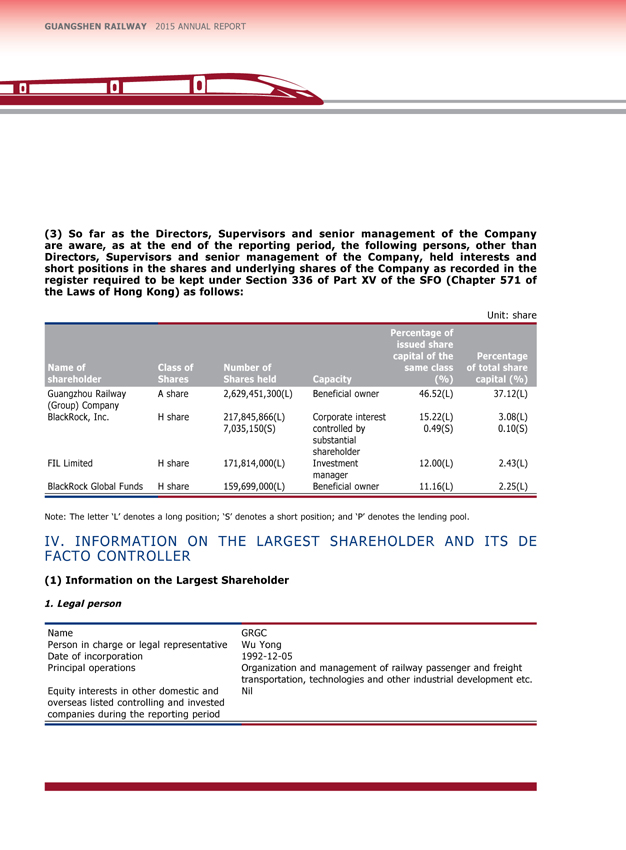
GUANGSHEN RAILWAY 2015 ANNUAL REPORT
(3) |
| So far as the Directors, Supervisors and senior management of the Company |
are aware, as at the end of the reporting period, the following persons, other than
Directors, Supervisors and senior management of the Company, held interests and
short positions in the shares and underlying shares of the Company as recorded in the
register required to be kept under Section 336 of Part XV of the SFO (Chapter 571 of
the Laws of Hong Kong) as follows:
Unit: share
Percentage of
issued share
capital of the Percentage
Name of Class of Number of same class of total share
shareholder Shares Shares held Capacity(%) capital (%)
Guangzhou Railway A share 2,629,451,300(L) Beneficial owner 46.52(L) 37.12(L)
(Group) Company
BlackRock, Inc. H share 217,845,866(L) Corporate interest 15.22(L) 3.08(L)
7,035,150(S) controlled by 0.49(S) 0.10(S)
substantial
shareholder
FIL Limited H share 171,814,000(L) Investment 12.00(L) 2.43(L)
manager
BlackRock Global Funds H share 159,699,000(L) Beneficial owner 11.16(L) 2.25(L)
Note: The letter ‘L’ denotes a long position; ‘S’ denotes a short position; and ‘P’ denotes the lending pool.
IV. INFORMATION ON THE LARGEST SHAREHOLDER AND ITS DE FACTO CONTROLLER
(1) |
| Information on the Largest Shareholder |
1. Legal person
Name GRGC
Person in charge or legal representative Wu Yong
Date of incorporation 1992-12-05
Principal operations Organization and management of railway passenger and freight
transportation, technologies and other industrial development etc.
Equity interests in other domestic and Nil
overseas listed controlling and invested
companies during the reporting period
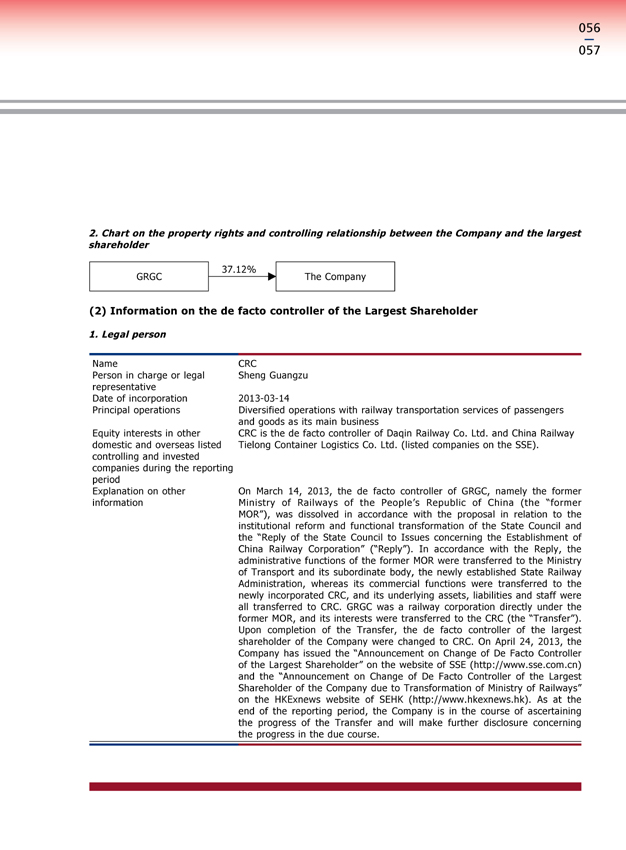
056
057
2. Chart on the property rights and controlling relationship between the Company and the largest shareholder
37.12%
GRGC The Company
(2) |
| Information on the de facto controller of the Largest Shareholder |
1. Legal person
Name
CRC
Person in charge or legal
Sheng Guangzu
representative
Date of incorporation
2013-03-14
Principal operations
Diversified operations with railway transportation services of passengers
and goods as its main business
Equity interests in other
CRC is the de facto controller of Daqin Railway Co. Ltd. and China Railway
domestic and overseas listed
Tielong Container Logistics Co. Ltd. (listed companies on the SSE).
controlling and invested
companies during the reporting
period
Explanation on other
On March 14, 2013, the de facto controller of GRGC, namely the former
information
Ministry of Railways of the People’s Republic of China (the “former
MOR”), was dissolved in accordance with the proposal in relation to the
institutional reform and functional transformation of the State Council and
the “Reply of the State Council to Issues concerning the Establishment of
China Railway Corporation” (“Reply”). In accordance with the Reply, the
administrative functions of the former MOR were transferred to the Ministry
of Transport and its subordinate body, the newly established State Railway
Administration, whereas its commercial functions were transferred to the
newly incorporated CRC, and its underlying assets, liabilities and staff were
all transferred to CRC. GRGC was a railway corporation directly under the
former MOR, and its interests were transferred to the CRC (the “Transfer”).
Upon completion of the Transfer, the de facto controller of the largest
shareholder of the Company were changed to CRC. On April 24, 2013, the
Company has issued the “Announcement on Change of De Facto Controller
of the Largest Shareholder” on the website of SSE (http://www.sse.com.cn)
and the “Announcement on Change of De Facto Controller of the Largest
Shareholder of the Company due to Transformation of Ministry of Railways”
on the HKExnews website of SEHK (http://www.hkexnews.hk). As at the
end of the reporting period, the Company is in the course of ascertaining
the progress of the Transfer and will make further disclosure concerning
the progress in the due course.
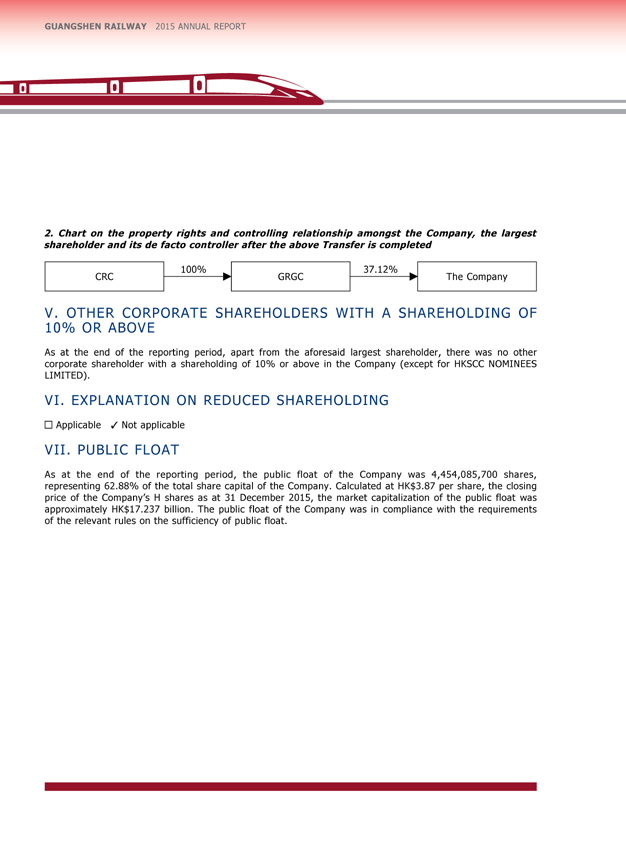
GUANGSHEN RAILWAY 2015 ANNUAL REPORT
2. Chart on the property rights and controlling relationship amongst the Company, the largest shareholder and its de facto controller after the above Transfer is completed
100% 37.12%
CRC GRGC The Company
V. OTHER CORPORATE SHAREHOLDERS WITH A SHAREHOLDING OF 10% OR ABOVE
As at the end of the reporting period, apart from the aforesaid largest shareholder, there was no other corporate shareholder with a shareholding of 10% or above in the Company (except for HKSCC NOMINEES LIMITED).
VI. EXPLANATION ON REDUCED SHAREHOLDING
Applicable ??Not applicable
VII. PUBLIC FLOAT
As at the end of the reporting period, the public float of the Company was 4,454,085,700 shares, representing 62.88% of the total share capital of the Company. Calculated at HK$3.87 per share, the closing price of the Company’s H shares as at 31 December 2015, the market capitalization of the public float was approximately HK$17.237 billion. The public float of the Company was in compliance with the requirements of the relevant rules on the sufficiency of public float.
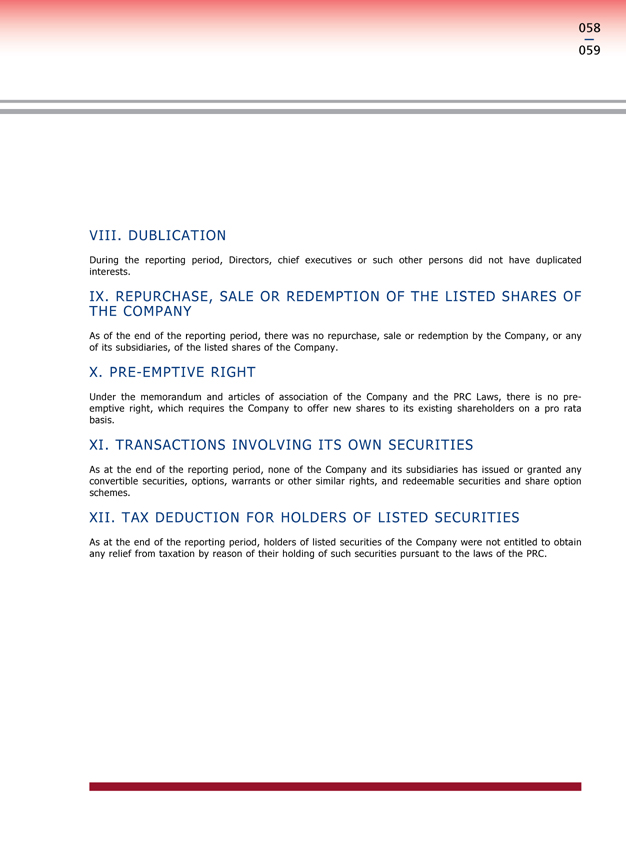
058
059
VIII. DUBLICATION
During the reporting period, Directors, chief executives or such other persons did not have duplicated interests.
IX. REPURCHASE, SALE OR REDEMPTION OF THE LISTED SHARES OF THE COMPANY
As of the end of the reporting period, there was no repurchase, sale or redemption by the Company, or any of its subsidiaries, of the listed shares of the Company.
X. PRE-EMPTIVE RIGHT
Under the memorandum and articles of association of the Company and the PRC Laws, there is no preemptive right, which requires the Company to offer new shares to its existing shareholders on a pro rata basis.
XI. TRANSACTIONS INVOLVING ITS OWN SECURITIES
As at the end of the reporting period, none of the Company and its subsidiaries has issued or granted any convertible securities, options, warrants or other similar rights, and redeemable securities and share option schemes.
XII. TAX DEDUCTION FOR HOLDERS OF LISTED SECURITIES
As at the end of the reporting period, holders of listed securities of the Company were not entitled to obtain any relief from taxation by reason of their holding of such securities pursuant to the laws of the PRC.
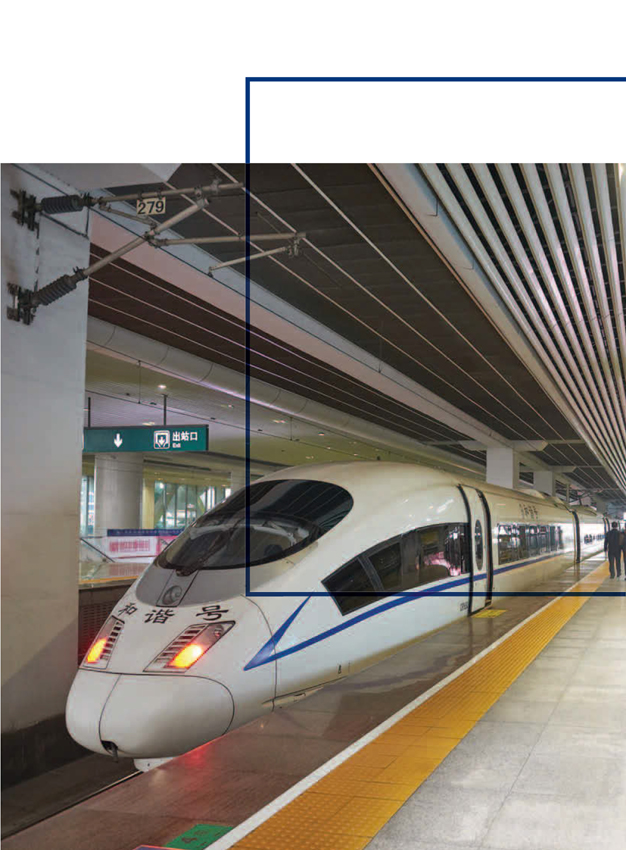
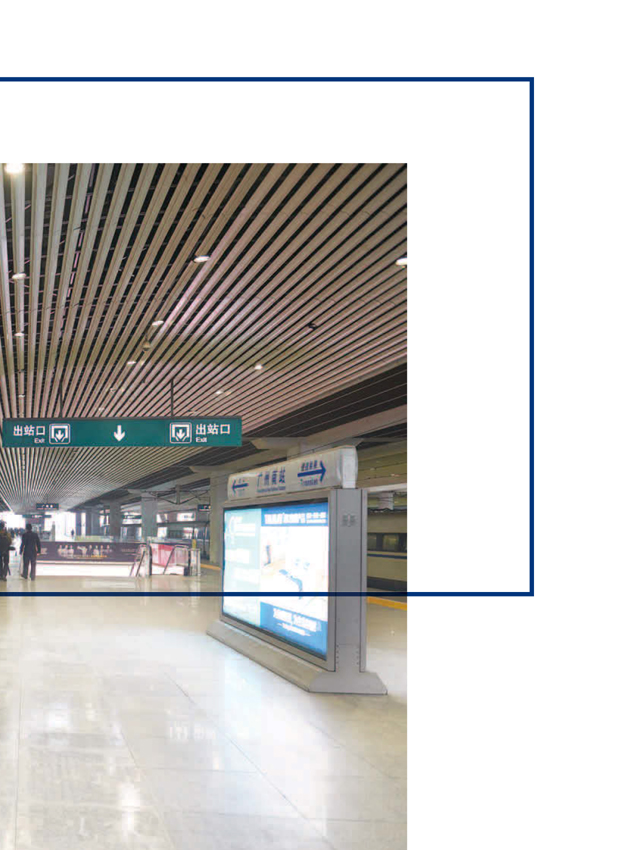
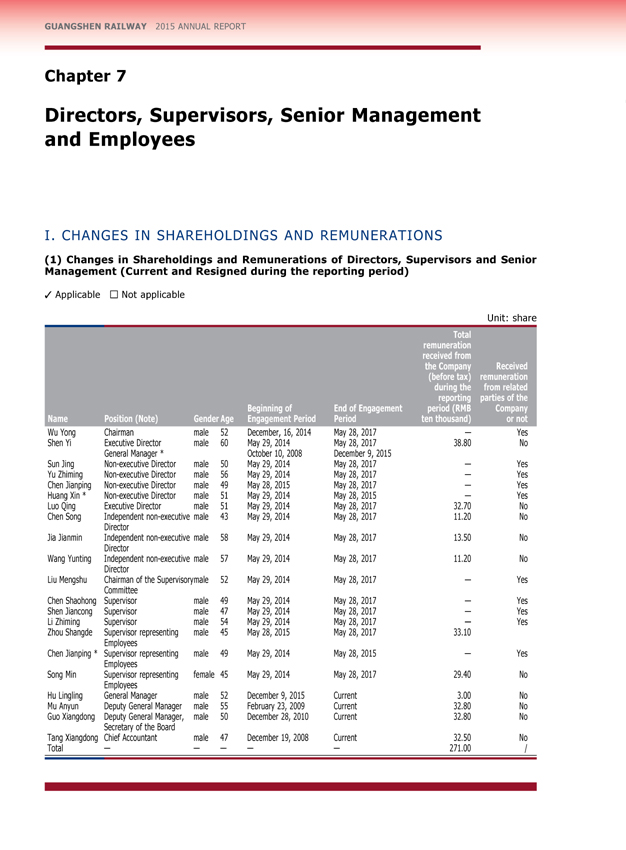
GUANGSHEN RAILWAY 2015 ANNUAL REPORT
Chapter 7
Directors, Supervisors, Senior Management and Employees
I. CHANGES IN SHAREHOLDINGS AND REMUNERATIONS
(1) Management Changes in (Current Shareholdings and Resigned and Remunerations during the reporting of Directors, period) Supervisors and Senior
??Applicable Not applicable
Unit: share
Total
remuneration
received from
the Company Received
(before tax) remuneration
during the from related
reporting parties of the
Beginning of End of Engagement period (RMB Company
Name Position (Note) Gender Age Engagement Period Period ten thousand) or not
Wu Yong Chairman male 52 December, 16, 2014 May 28, 2017 — Yes
Shen Yi Executive Director male 60 May 29, 2014 May 28, 2017 38.80 No
General Manager * October 10, 2008 December 9, 2015
Sun Jing Non-executive Director male 50 May 29, 2014 May 28, 2017 — Yes
Yu Zhiming Non-executive Director male 56 May 29, 2014 May 28, 2017 — Yes
Chen Jianping Non-executive Director male 49 May 28, 2015 May 28, 2017 — Yes
Huang Xin * Non-executive Director male 51 May 29, 2014 May 28, 2015 — Yes
Luo Qing Executive Director male 51 May 29, 2014 May 28, 2017 32.70 No
Chen Song Independent non-executive male 43 May 29, 2014 May 28, 2017 11.20 No
Director
Jia Jianmin Independent non-executive male 58 May 29, 2014 May 28, 2017 13.50 No
Director
Wang Yunting Independent non-executive male 57 May 29, 2014 May 28, 2017 11.20 No
Director
Liu Mengshu Chairman of the Supervisorymale 52 May 29, 2014 May 28, 2017 — Yes
Committee
Chen Shaohong Supervisor male 49 May 29, 2014 May 28, 2017 — Yes
Shen Jiancong Supervisor male 47 May 29, 2014 May 28, 2017 — Yes
Li Zhiming Supervisor male 54 May 29, 2014 May 28, 2017 — Yes
Zhou Shangde Supervisor representing male 45 May 28, 2015 May 28, 2017 33.10
Employees
Chen Jianping * Supervisor representing male 49 May 29, 2014 May 28, 2015 — Yes
Employees
Song Min Supervisor representing female 45 May 29, 2014 May 28, 2017 29.40 No
Employees
Hu Lingling General Manager male 52 December 9, 2015 Current 3.00 No
Mu Anyun Deputy General Manager male 55 February 23, 2009 Current 32.80 No
Guo Xiangdong Deputy General Manager, male 50 December 28, 2010 Current 32.80 No
Secretary of the Board
Tang Xiangdong Chief Accountant male 47 December 19, 2008 Current 32.50 No
Total — — — — — 271.00 /
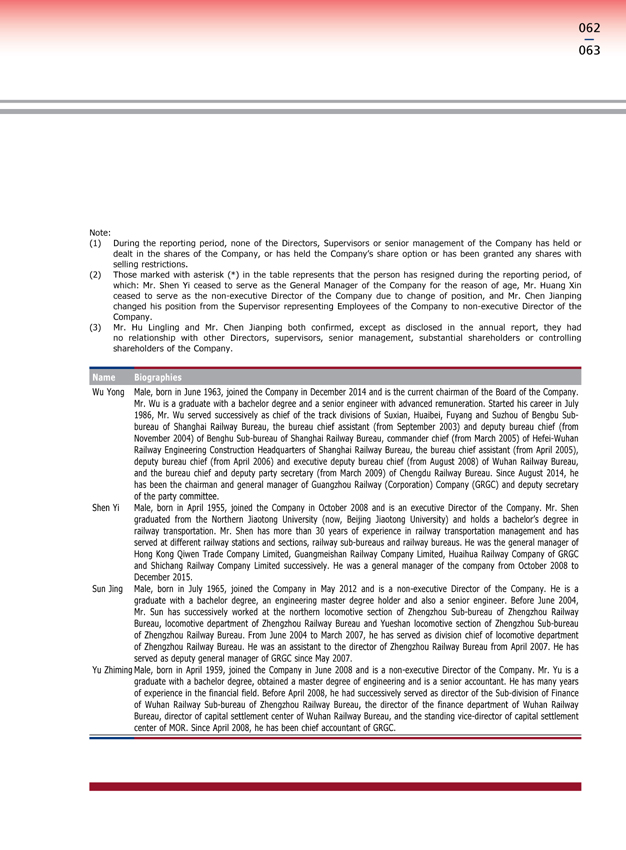
062
063
Note:
(1) |
| During the reporting period, none of the Directors, Supervisors or senior management of the Company has held or |
dealt in the shares of the Company, or has held the Company’s share option or has been granted any shares with
selling restrictions.
(2) Those marked with asterisk (*) in the table represents that the person has resigned during the reporting period, of
which: Mr. Shen Yi ceased to serve as the General Manager of the Company for the reason of age, Mr. Huang Xin
ceased to serve as the non-executive Director of the Company due to change of position, and Mr. Chen Jianping
changed his position from the Supervisor representing Employees of the Company to non-executive Director of the
Company.
(3) |
| Mr. Hu Lingling and Mr. Chen Jianping both confirmed, except as disclosed in the annual report, they had |
no relationship with other Directors, supervisors, senior management, substantial shareholders or controlling
shareholders of the Company.
Name Biographies
Wu Yong Male, born in June 1963, joined the Company in December 2014 and is the current chairman of the Board of the Company.
Mr. Wu is a graduate with a bachelor degree and a senior engineer with advanced remuneration. Started his career in July
1986, Mr. Wu served successively as chief of the track divisions of Suxian, Huaibei, Fuyang and Suzhou of Bengbu Sub-
bureau of Shanghai Railway Bureau, the bureau chief assistant (from September 2003) and deputy bureau chief (from
November 2004) of Benghu Sub-bureau of Shanghai Railway Bureau, commander chief (from March 2005) of Hefei-Wuhan
Railway Engineering Construction Headquarters of Shanghai Railway Bureau, the bureau chief assistant (from April 2005),
deputy bureau chief (from April 2006) and executive deputy bureau chief (from August 2008) of Wuhan Railway Bureau,
and the bureau chief and deputy party secretary (from March 2009) of Chengdu Railway Bureau. Since August 2014, he
has been the chairman and general manager of Guangzhou Railway (Corporation) Company (GRGC) and deputy secretary
of the party committee.
Shen Yi Male, born in April 1955, joined the Company in October 2008 and is an executive Director of the Company. Mr. Shen
graduated from the Northern Jiaotong University (now, Beijing Jiaotong University) and holds a bachelor’s degree in
railway transportation. Mr. Shen has more than 30 years of experience in railway transportation management and has
served at different railway stations and sections, railway sub-bureaus and railway bureaus. He was the general manager of
Hong Kong Qiwen Trade Company Limited, Guangmeishan Railway Company Limited, Huaihua Railway Company of GRGC
and Shichang Railway Company Limited successively. He was a general manager of the company from October 2008 to
December 2015.
Sun Jing Male, born in July 1965, joined the Company in May 2012 and is a non-executive Director of the Company. He is a
graduate with a bachelor degree, an engineering master degree holder and also a senior engineer. Before June 2004,
Mr. Sun has successively worked at the northern locomotive section of Zhengzhou Sub-bureau of Zhengzhou Railway
Bureau, locomotive department of Zhengzhou Railway Bureau and Yueshan locomotive section of Zhengzhou Sub-bureau
of Zhengzhou Railway Bureau. From June 2004 to March 2007, he has served as division chief of locomotive department
of Zhengzhou Railway Bureau. He was an assistant to the director of Zhengzhou Railway Bureau from April 2007. He has
served as deputy general manager of GRGC since May 2007.
Yu Zhiming Male, born in April 1959, joined the Company in June 2008 and is a non-executive Director of the Company. Mr. Yu is a
graduate with a bachelor degree, obtained a master degree of engineering and is a senior accountant. He has many years
of experience in the financial field. Before April 2008, he had successively served as director of the Sub-division of Finance
of Wuhan Railway Sub-bureau of Zhengzhou Railway Bureau, the director of the finance department of Wuhan Railway
Bureau, director of capital settlement center of Wuhan Railway Bureau, and the standing vice-director of capital settlement
center of MOR. Since April 2008, he has been chief accountant of GRGC.
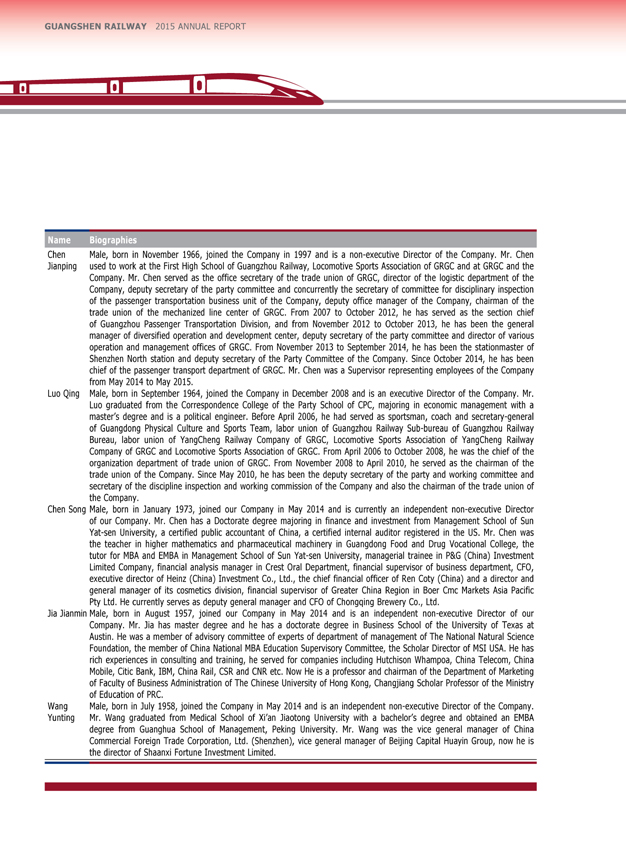
GUANGSHEN RAILWAY 2015 ANNUAL REPORT
Name Biographies
Chen Male, born in November 1966, joined the Company in 1997 and is a non-executive Director of the Company. Mr. Chen
Jianping used to work at the First High School of Guangzhou Railway, Locomotive Sports Association of GRGC and at GRGC and the
Company. Mr. Chen served as the office secretary of the trade union of GRGC, director of the logistic department of the
Company, deputy secretary of the party committee and concurrently the secretary of committee for disciplinary inspection
of the passenger transportation business unit of the Company, deputy office manager of the Company, chairman of the
trade union of the mechanized line center of GRGC. From 2007 to October 2012, he has served as the section chief
of Guangzhou Passenger Transportation Division, and from November 2012 to October 2013, he has been the general
manager of diversified operation and development center, deputy secretary of the party committee and director of various
operation and management offices of GRGC. From November 2013 to September 2014, he has been the stationmaster of
Shenzhen North station and deputy secretary of the Party Committee of the Company. Since October 2014, he has been
chief of the passenger transport department of GRGC. Mr. Chen was a Supervisor representing employees of the Company
from May 2014 to May 2015.
Luo Qing Male, born in September 1964, joined the Company in December 2008 and is an executive Director of the Company. Mr.
Luo graduated from the Correspondence College of the Party School of CPC, majoring in economic management with a
master’s degree and is a political engineer. Before April 2006, he had served as sportsman, coach and secretary-general
of Guangdong Physical Culture and Sports Team, labor union of Guangzhou Railway Sub-bureau of Guangzhou Railway
Bureau, labor union of YangCheng Railway Company of GRGC, Locomotive Sports Association of YangCheng Railway
Company of GRGC and Locomotive Sports Association of GRGC. From April 2006 to October 2008, he was the chief of the
organization department of trade union of GRGC. From November 2008 to April 2010, he served as the chairman of the
trade union of the Company. Since May 2010, he has been the deputy secretary of the party and working committee and
secretary of the discipline inspection and working commission of the Company and also the chairman of the trade union of
the Company.
Chen Song Male, born in January 1973, joined our Company in May 2014 and is currently an independent non-executive Director
of our Company. Mr. Chen has a Doctorate degree majoring in finance and investment from Management School of Sun
Yat-sen University, a certified public accountant of China, a certified internal auditor registered in the US. Mr. Chen was
the teacher in higher mathematics and pharmaceutical machinery in Guangdong Food and Drug Vocational College, the
tutor for MBA and EMBA in Management School of Sun Yat-sen University, managerial trainee in P&G (China) Investment
Limited Company, financial analysis manager in Crest Oral Department, financial supervisor of business department, CFO,
executive director of Heinz (China) Investment Co., Ltd., the chief financial officer of Ren Coty (China) and a director and
general manager of its cosmetics division, financial supervisor of Greater China Region in Boer Cmc Markets Asia Pacific
Pty Ltd. He currently serves as deputy general manager and CFO of Chongqing Brewery Co., Ltd.
Jia Jianmin Male, born in August 1957, joined our Company in May 2014 and is an independent non-executive Director of our
Company. Mr. Jia has master degree and he has a doctorate degree in Business School of the University of Texas at
Austin. He was a member of advisory committee of experts of department of management of The National Natural Science
Foundation, the member of China National MBA Education Supervisory Committee, the Scholar Director of MSI USA. He has
rich experiences in consulting and training, he served for companies including Hutchison Whampoa, China Telecom, China
Mobile, Citic Bank, IBM, China Rail, CSR and CNR etc. Now He is a professor and chairman of the Department of Marketing
of Faculty of Business Administration of The Chinese University of Hong Kong, Changjiang Scholar Professor of the Ministry
of Education of PRC.
Wang Male, born in July 1958, joined the Company in May 2014 and is an independent non-executive Director of the Company.
Yunting Mr. Wang graduated from Medical School of Xi’an Jiaotong University with a bachelor’s degree and obtained an EMBA
degree from Guanghua School of Management, Peking University. Mr. Wang was the vice general manager of China
Commercial Foreign Trade Corporation, Ltd. (Shenzhen), vice general manager of Beijing Capital Huayin Group, now he is
the director of Shaanxi Fortune Investment Limited.
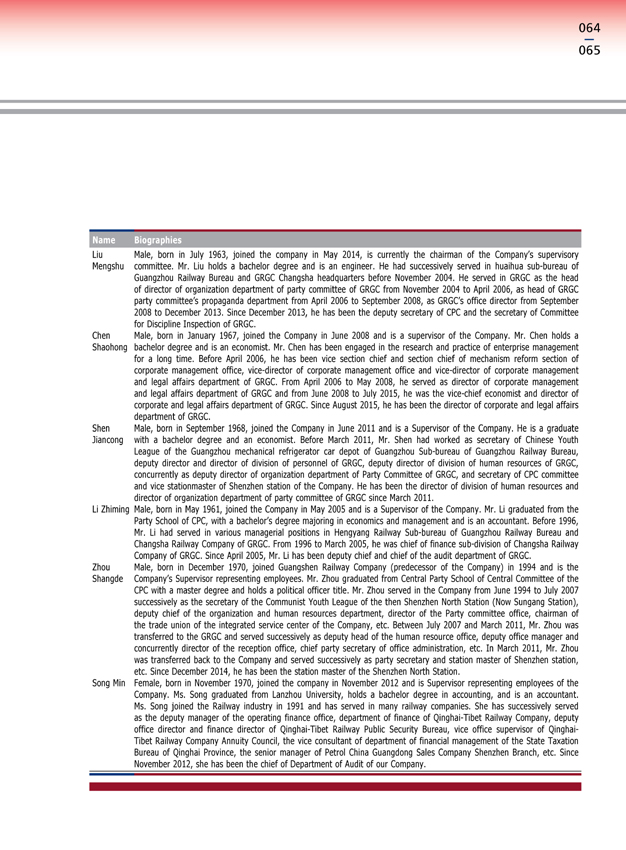
064
065
Name Biographies
Liu Male, born in July 1963, joined the company in May 2014, is currently the chairman of the Company’s supervisory
Mengshu committee. Mr. Liu holds a bachelor degree and is an engineer. He had successively served in huaihua sub-bureau of
Guangzhou Railway Bureau and GRGC Changsha headquarters before November 2004. He served in GRGC as the head
of director of organization department of party committee of GRGC from November 2004 to April 2006, as head of GRGC
party committee’s propaganda department from April 2006 to September 2008, as GRGC’s office director from September
2008 to December 2013. Since December 2013, he has been the deputy secretary of CPC and the secretary of Committee
for Discipline Inspection of GRGC.
Chen Male, born in January 1967, joined the Company in June 2008 and is a supervisor of the Company. Mr. Chen holds a
Shaohong bachelor degree and is an economist. Mr. Chen has been engaged in the research and practice of enterprise management
for a long time. Before April 2006, he has been vice section chief and section chief of mechanism reform section of
corporate management office, vice-director of corporate management office and vice-director of corporate management
and legal affairs department of GRGC. From April 2006 to May 2008, he served as director of corporate management
and legal affairs department of GRGC and from June 2008 to July 2015, he was the vice-chief economist and director of
corporate and legal affairs department of GRGC. Since August 2015, he has been the director of corporate and legal affairs
department of GRGC.
Shen Male, born in September 1968, joined the Company in June 2011 and is a Supervisor of the Company. He is a graduate
Jiancong with a bachelor degree and an economist. Before March 2011, Mr. Shen had worked as secretary of Chinese Youth
League of the Guangzhou mechanical refrigerator car depot of Guangzhou Sub-bureau of Guangzhou Railway Bureau,
deputy director and director of division of personnel of GRGC, deputy director of division of human resources of GRGC,
concurrently as deputy director of organization department of Party Committee of GRGC, and secretary of CPC committee
and vice stationmaster of Shenzhen station of the Company. He has been the director of division of human resources and
director of organization department of party committee of GRGC since March 2011.
Li Zhiming Male, born in May 1961, joined the Company in May 2005 and is a Supervisor of the Company. Mr. Li graduated from the
Party School of CPC, with a bachelor’s degree majoring in economics and management and is an accountant. Before 1996,
Mr. Li had served in various managerial positions in Hengyang Railway Sub-bureau of Guangzhou Railway Bureau and
Changsha Railway Company of GRGC. From 1996 to March 2005, he was chief of finance sub-division of Changsha Railway
Company of GRGC. Since April 2005, Mr. Li has been deputy chief and chief of the audit department of GRGC.
Zhou Male, born in December 1970, joined Guangshen Railway Company (predecessor of the Company) in 1994 and is the
Shangde Company’s Supervisor representing employees. Mr. Zhou graduated from Central Party School of Central Committee of the
CPC with a master degree and holds a political officer title. Mr. Zhou served in the Company from June 1994 to July 2007
successively as the secretary of the Communist Youth League of the then Shenzhen North Station (Now Sungang Station),
deputy chief of the organization and human resources department, director of the Party committee office, chairman of
the trade union of the integrated service center of the Company, etc. Between July 2007 and March 2011, Mr. Zhou was
transferred to the GRGC and served successively as deputy head of the human resource office, deputy office manager and
concurrently director of the reception office, chief party secretary of office administration, etc. In March 2011, Mr. Zhou
was transferred back to the Company and served successively as party secretary and station master of Shenzhen station,
etc. Since December 2014, he has been the station master of the Shenzhen North Station.
Song Min Female, born in November 1970, joined the company in November 2012 and is Supervisor representing employees of the
Company. Ms. Song graduated from Lanzhou University, holds a bachelor degree in accounting, and is an accountant.
Ms. Song joined the Railway industry in 1991 and has served in many railway companies. She has successively served
as the deputy manager of the operating finance office, department of finance of Qinghai-Tibet Railway Company, deputy
office director and finance director of Qinghai-Tibet Railway Public Security Bureau, vice office supervisor of Qinghai-
Tibet Railway Company Annuity Council, the vice consultant of department of financial management of the State Taxation
Bureau of Qinghai Province, the senior manager of Petrol China Guangdong Sales Company Shenzhen Branch, etc. Since
November 2012, she has been the chief of Department of Audit of our Company.
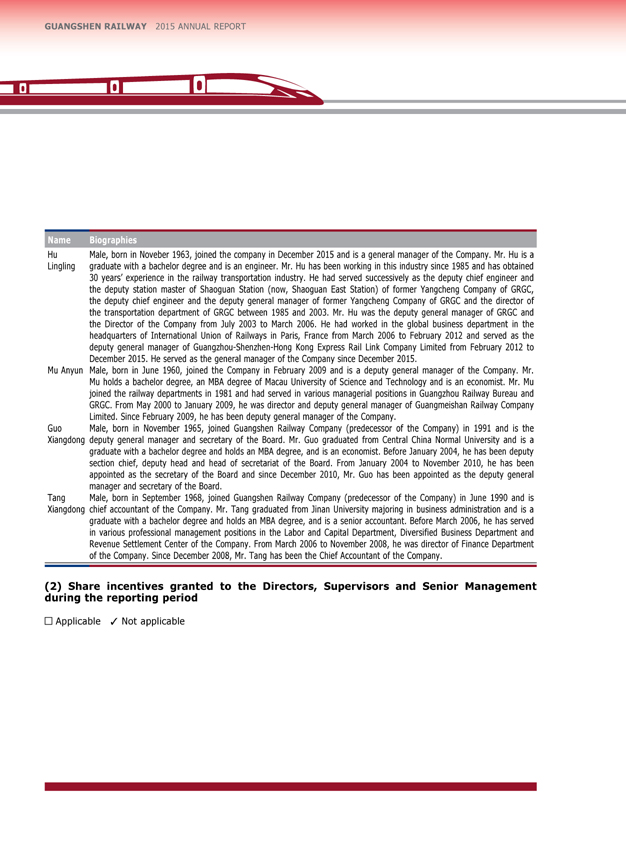
GUANGSHEN RAILWAY 2015 ANNUAL REPORT
Name Biographies
Hu Male, born in Noveber 1963, joined the company in December 2015 and is a general manager of the Company. Mr. Hu is a
Lingling graduate with a bachelor degree and is an engineer. Mr. Hu has been working in this industry since 1985 and has obtained
30 years’ experience in the railway transportation industry. He had served successively as the deputy chief engineer and
the deputy station master of Shaoguan Station (now, Shaoguan East Station) of former Yangcheng Company of GRGC,
the deputy chief engineer and the deputy general manager of former Yangcheng Company of GRGC and the director of
the transportation department of GRGC between 1985 and 2003. Mr. Hu was the deputy general manager of GRGC and
the Director of the Company from July 2003 to March 2006. He had worked in the global business department in the
headquarters of International Union of Railways in Paris, France from March 2006 to February 2012 and served as the
deputy general manager of Guangzhou-Shenzhen-Hong Kong Express Rail Link Company Limited from February 2012 to
December 2015. He served as the general manager of the Company since December 2015.
Mu Anyun Male, born in June 1960, joined the Company in February 2009 and is a deputy general manager of the Company. Mr.
Mu holds a bachelor degree, an MBA degree of Macau University of Science and Technology and is an economist. Mr. Mu
joined the railway departments in 1981 and had served in various managerial positions in Guangzhou Railway Bureau and
GRGC. From May 2000 to January 2009, he was director and deputy general manager of Guangmeishan Railway Company
Limited. Since February 2009, he has been deputy general manager of the Company.
Guo Male, born in November 1965, joined Guangshen Railway Company (predecessor of the Company) in 1991 and is the
Xiangdong deputy general manager and secretary of the Board. Mr. Guo graduated from Central China Normal University and is a
graduate with a bachelor degree and holds an MBA degree, and is an economist. Before January 2004, he has been deputy
section chief, deputy head and head of secretariat of the Board. From January 2004 to November 2010, he has been
appointed as the secretary of the Board and since December 2010, Mr. Guo has been appointed as the deputy general
manager and secretary of the Board.
Tang Male, born in September 1968, joined Guangshen Railway Company (predecessor of the Company) in June 1990 and is
Xiangdong chief accountant of the Company. Mr. Tang graduated from Jinan University majoring in business administration and is a
graduate with a bachelor degree and holds an MBA degree, and is a senior accountant. Before March 2006, he has served
in various professional management positions in the Labor and Capital Department, Diversified Business Department and
Revenue Settlement Center of the Company. From March 2006 to November 2008, he was director of Finance Department
of the Company. Since December 2008, Mr. Tang has been the Chief Accountant of the Company.
(2) |
| Share incentives granted to the Directors, Supervisors and Senior Management |
during the reporting period
?Applicable ? Not applicable
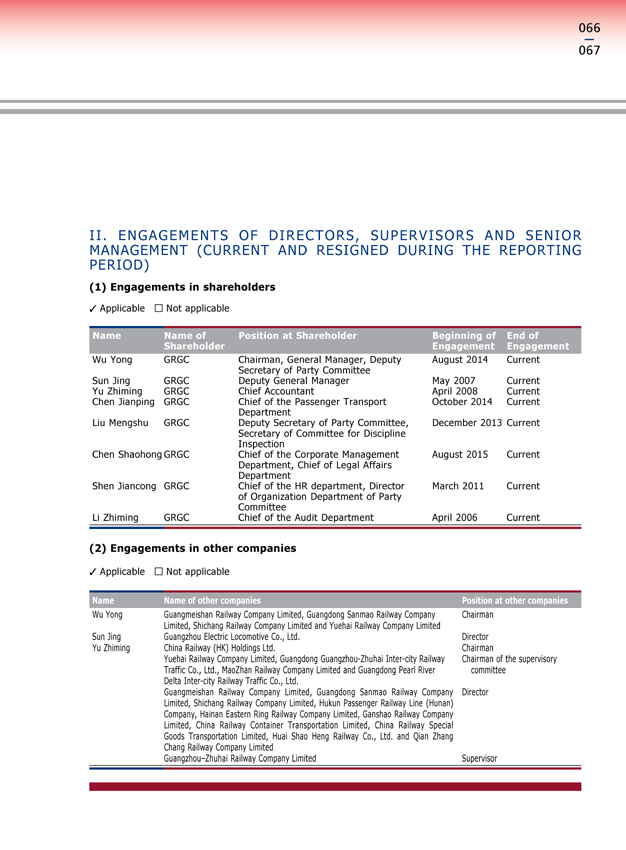
066
067
II. ENGAGEMENTS OF DIRECTORS, SUPERVISORS AND SENIOR MANAGEMENT (CURRENT AND RESIGNED DURING THE REPORTING PERIOD)
(1) |
| Engagements in shareholders |
Applicable Not applicable
Name Name of Position at Shareholder Beginning of End of
Shareholder Engagement Engagement
Wu Yong GRGC Chairman, General Manager, Deputy August 2014 Current
Secretary of Party Committee
Sun Jing GRGC Deputy General Manager May 2007 Current
Yu Zhiming GRGC Chief Accountant April 2008 Current
Chen Jianping GRGC Chief of the Passenger Transport October 2014 Current
Department
Liu Mengshu GRGC Deputy Secretary of Party Committee, December 2013 Current
Secretary of Committee for Discipline
Inspection
Chen Shaohong GRGC Chief of the Corporate Management August 2015 Current
Department, Chief of Legal Affairs
Department
Shen Jiancong GRGC Chief of the HR department, Director March 2011 Current
of Organization Department of Party
Committee
Li Zhiming GRGC Chief of the Audit Department April 2006 Current
(2) |
| Engagements in other companies |
??Applicable Not applicable
Name Name of other companies Position at other companies
Wu Yong Guangmeishan Railway Company Limited, Guangdong Sanmao Railway Company Chairman
Limited, Shichang Railway Company Limited and Yuehai Railway Company Limited
Sun Jing Guangzhou Electric Locomotive Co., Ltd. Director
Yu Zhiming China Railway (HK) Holdings Ltd. Chairman
Yuehai Railway Company Limited, Guangdong Guangzhou-Zhuhai Inter-city Railway Chairman of the supervisory
Traffic Co., Ltd., MaoZhan Railway Company Limited and Guangdong Pearl River committee
Delta Inter-city Railway Traffic Co., Ltd.
Guangmeishan Railway Company Limited, Guangdong Sanmao Railway Company Director
Limited, Shichang Railway Company Limited, Hukun Passenger Railway Line (Hunan)
Company, Hainan Eastern Ring Railway Company Limited, Ganshao Railway Company
Limited, China Railway Container Transportation Limited, China Railway Special
Goods Transportation Limited, Huai Shao Heng Railway Co., Ltd. and Qian Zhang
Chang Railway Company Limited
Guangzhou–Zhuhai Railway Company Limited Supervisor
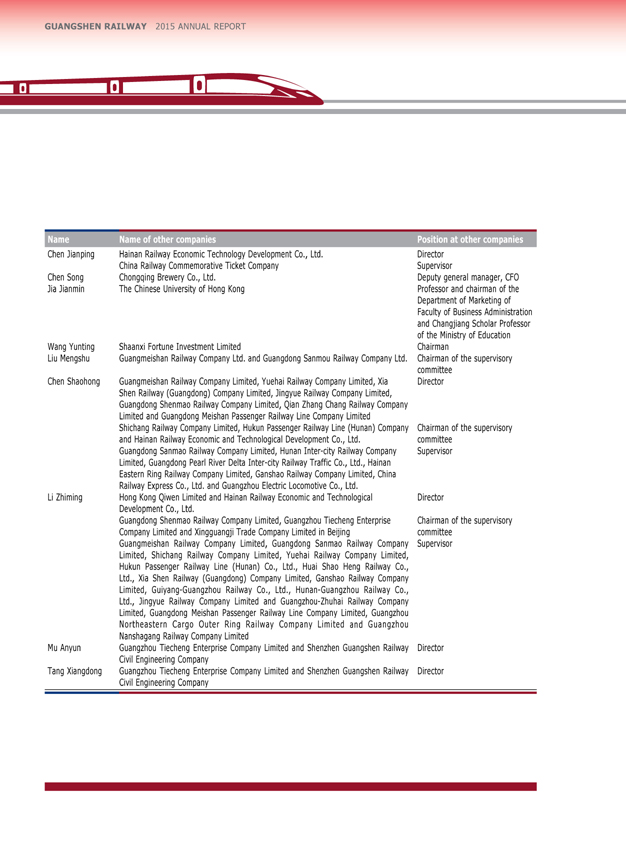
GUANGSHEN RAILWAY 2015 ANNUAL REPORT
Name Name of other companies Position at other companies
Chen Jianping Hainan Railway Economic Technology Development Co., Ltd. Director
China Railway Commemorative Ticket Company Supervisor
Chen Song Chongqing Brewery Co., Ltd. Deputy general manager, CFO
Jia Jianmin The Chinese University of Hong Kong Professor and chairman of the
Department of Marketing of
Faculty of Business Administration
and Changjiang Scholar Professor
of the Ministry of Education
Wang Yunting Shaanxi Fortune Investment Limited Chairman
Liu Mengshu Guangmeishan Railway Company Ltd. and Guangdong Sanmou Railway Company Ltd. Chairman of the supervisory
committee
Chen Shaohong Guangmeishan Railway Company Limited, Yuehai Railway Company Limited, Xia Director
Shen Railway (Guangdong) Company Limited, Jingyue Railway Company Limited,
Guangdong Shenmao Railway Company Limited, Qian Zhang Chang Railway Company
Limited and Guangdong Meishan Passenger Railway Line Company Limited
Shichang Railway Company Limited, Hukun Passenger Railway Line (Hunan) Company Chairman of the supervisory
and Hainan Railway Economic and Technological Development Co., Ltd. committee
Guangdong Sanmao Railway Company Limited, Hunan Inter-city Railway Company Supervisor
Limited, Guangdong Pearl River Delta Inter-city Railway Traffic Co., Ltd., Hainan
Eastern Ring Railway Company Limited, Ganshao Railway Company Limited, China
Railway Express Co., Ltd. and Guangzhou Electric Locomotive Co., Ltd.
Li Zhiming Hong Kong Qiwen Limited and Hainan Railway Economic and Technological Director
Development Co., Ltd.
Guangdong Shenmao Railway Company Limited, Guangzhou Tiecheng Enterprise Chairman of the supervisory
Company Limited and Xingguangji Trade Company Limited in Beijing committee
Guangmeishan Railway Company Limited, Guangdong Sanmao Railway Company Supervisor
Limited, Shichang Railway Company Limited, Yuehai Railway Company Limited,
Hukun Passenger Railway Line (Hunan) Co., Ltd., Huai Shao Heng Railway Co.,
Ltd., Xia Shen Railway (Guangdong) Company Limited, Ganshao Railway Company
Limited, Guiyang-Guangzhou Railway Co., Ltd., Hunan-Guangzhou Railway Co.,
Ltd., Jingyue Railway Company Limited and Guangzhou-Zhuhai Railway Company
Limited, Guangdong Meishan Passenger Railway Line Company Limited, Guangzhou
Northeastern Cargo Outer Ring Railway Company Limited and Guangzhou
Nanshagang Railway Company Limited
Mu Anyun Guangzhou Tiecheng Enterprise Company Limited and Shenzhen Guangshen Railway Director
Civil Engineering Company
Tang Xiangdong Guangzhou Tiecheng Enterprise Company Limited and Shenzhen Guangshen Railway Director
Civil Engineering Company
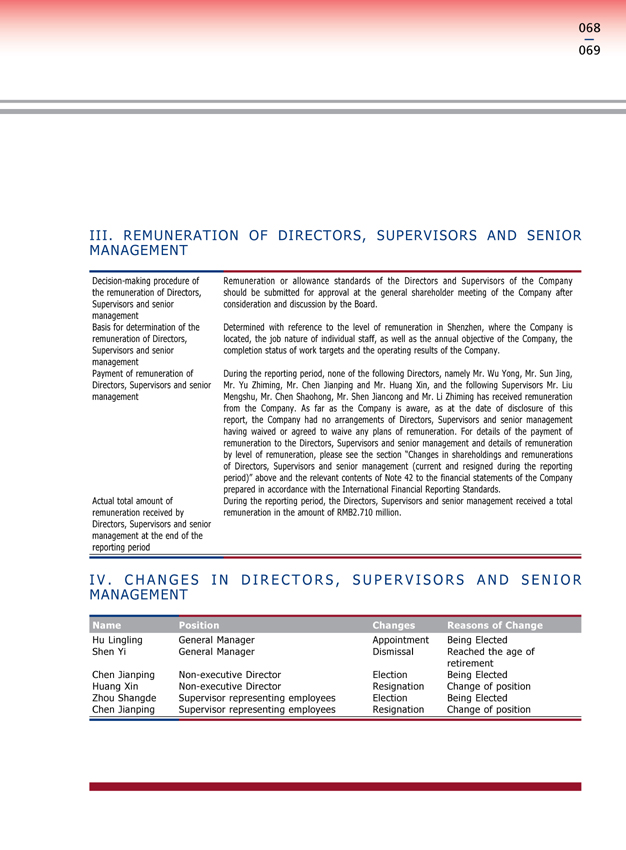
068
069
III. REMUNERATION OF DIRECTORS, SUPERVISORS AND SENIOR MANAGEMENT
Decision-making procedure of Remuneration or allowance standards of the Directors and Supervisors of the Company
the remuneration of Directors, should be submitted for approval at the general shareholder meeting of the Company after
Supervisors and senior consideration and discussion by the Board.
management
Basis for determination of the Determined with reference to the level of remuneration in Shenzhen, where the Company is
remuneration of Directors, located, the job nature of individual staff, as well as the annual objective of the Company, the
Supervisors and senior completion status of work targets and the operating results of the Company.
management
Payment of remuneration of During the reporting period, none of the following Directors, namely Mr. Wu Yong, Mr. Sun Jing,
Directors, Supervisors and senior Mr. Yu Zhiming, Mr. Chen Jianping and Mr. Huang Xin, and the following Supervisors Mr. Liu
management Mengshu, Mr. Chen Shaohong, Mr. Shen Jiancong and Mr. Li Zhiming has received remuneration
from the Company. As far as the Company is aware, as at the date of disclosure of this
report, the Company had no arrangements of Directors, Supervisors and senior management
having waived or agreed to waive any plans of remuneration. For details of the payment of
remuneration to the Directors, Supervisors and senior management and details of remuneration
by level of remuneration, please see the section “Changes in shareholdings and remunerations
of Directors, Supervisors and senior management (current and resigned during the reporting
period)” above and the relevant contents of Note 42 to the financial statements of the Company
prepared in accordance with the International Financial Reporting Standards.
Actual total amount of During the reporting period, the Directors, Supervisors and senior management received a total
remuneration received by remuneration in the amount of RMB2.710 million.
Directors, Supervisors and senior
management at the end of the
reporting period
IV. C H A N G E S I N D I R E C T O R S , S U P E R V I S O R S A N D S E N I O R
MANAGEMENT
Name Position Changes Reasons of Change
Hu Lingling General Manager Appointment Being Elected
Shen Yi General Manager Dismissal Reached the age of
retirement
Chen Jianping Non-executive Director Election Being Elected
Huang Xin Non-executive Director Resignation Change of position
Zhou Shangde Supervisor representing employees Election Being Elected
Chen Jianping Supervisor representing employees Resignation Change of position
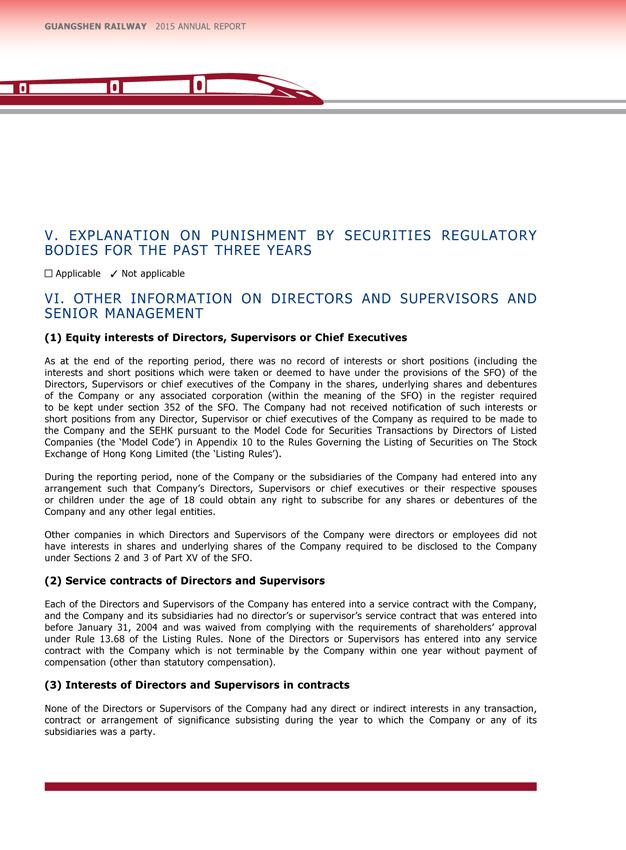
GUANGSHEN RAILWAY 2015 ANNUAL REPORT
V. EXPLANATION ON PUNISHMENT BY SECURITIES REGULATORY BODIES FOR THE PAST THREE YEARS
?Applicable ? Not applicable
VI. OTHER INFORMATION ON DIRECTORS AND SUPERVISORS AND SENIOR MANAGEMENT
(1) |
| Equity interests of Directors, Supervisors or Chief Executives |
As at the end of the reporting period, there was no record of interests or short positions (including the interests and short positions which were taken or deemed to have under the provisions of the SFO) of the Directors, Supervisors or chief executives of the Company in the shares, underlying shares and debentures of the Company or any associated corporation (within the meaning of the SFO) in the register required to be kept under section 352 of the SFO. The Company had not received notification of such interests or short positions from any Director, Supervisor or chief executives of the Company as required to be made to the Company and the SEHK pursuant to the Model Code for Securities Transactions by Directors of Listed Companies (the ‘Model Code’) in Appendix 10 to the Rules Governing the Listing of Securities on The Stock Exchange of Hong Kong Limited (the ‘Listing Rules’).
During the reporting period, none of the Company or the subsidiaries of the Company had entered into any arrangement such that Company’s Directors, Supervisors or chief executives or their respective spouses or children under the age of 18 could obtain any right to subscribe for any shares or debentures of the Company and any other legal entities.
Other companies in which Directors and Supervisors of the Company were directors or employees did not have interests in shares and underlying shares of the Company required to be disclosed to the Company under Sections 2 and 3 of Part XV of the SFO.
(2) |
| Service contracts of Directors and Supervisors |
Each of the Directors and Supervisors of the Company has entered into a service contract with the Company, and the Company and its subsidiaries had no director’s or supervisor’s service contract that was entered into before January 31, 2004 and was waived from complying with the requirements of shareholders’ approval under Rule 13.68 of the Listing Rules. None of the Directors or Supervisors has entered into any service contract with the Company which is not terminable by the Company within one year without payment of compensation (other than statutory compensation).
(3) |
| Interests of Directors and Supervisors in contracts |
None of the Directors or Supervisors of the Company had any direct or indirect interests in any transaction, contract or arrangement of significance subsisting during the year to which the Company or any of its subsidiaries was a party.
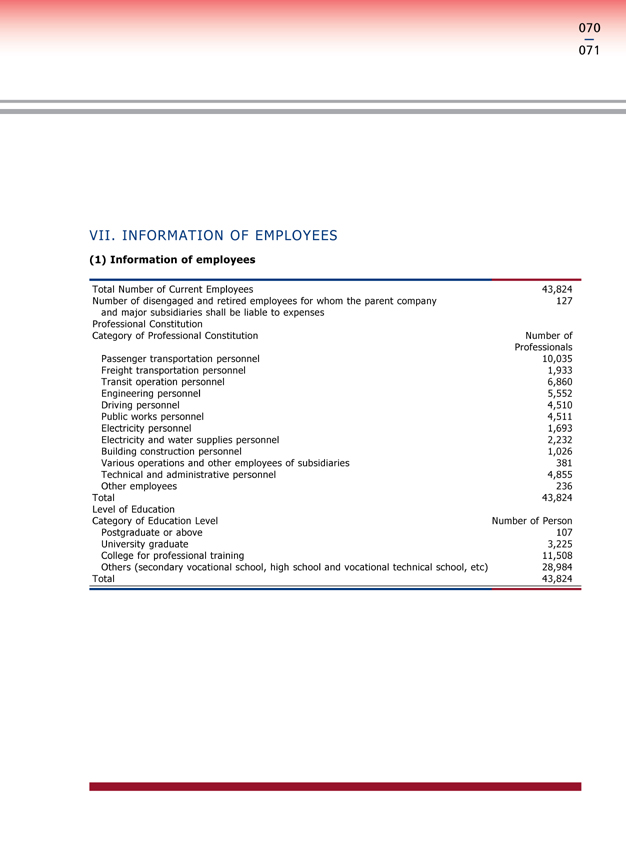
070
071
VII. INFORMATION OF EMPLOYEES
(1) |
| Information of employees |
Total Number of Current Employees 43,824
Number of disengaged and retired employees for whom the parent company 127
and major subsidiaries shall be liable to expenses
Professional Constitution
Category of Professional Constitution Number of
Professionals
Passenger transportation personnel 10,035
Freight transportation personnel 1,933
Transit operation personnel 6,860
Engineering personnel 5,552
Driving personnel 4,510
Public works personnel 4,511
Electricity personnel 1,693
Electricity and water supplies personnel 2,232
Building construction personnel 1,026
Various operations and other employees of subsidiaries 381
Technical and administrative personnel 4,855
Other employees 236
Total 43,824
Level of Education
Category of Education Level Number of Person
Postgraduate or above 107
University graduate 3,225
College for professional training 11,508
Others (secondary vocational school, high school and vocational technical school, etc) 28,984
Total 43,824
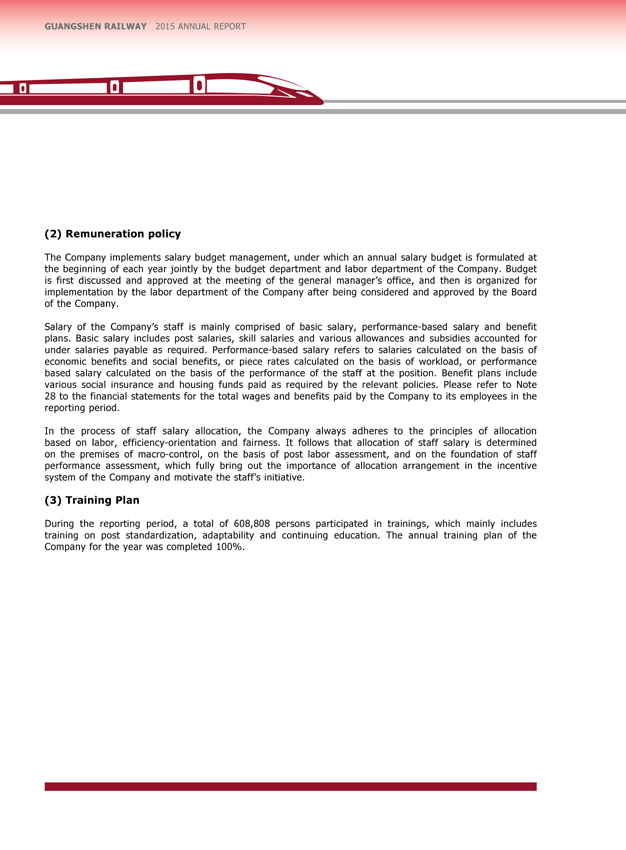
GUANGSHEN RAILWAY 2015 ANNUAL REPORT
(2) |
| Remuneration policy |
The Company implements salary budget management, under which an annual salary budget is formulated at the beginning of each year jointly by the budget department and labor department of the Company. Budget is first discussed and approved at the meeting of the general manager’s office, and then is organized for implementation by the labor department of the Company after being considered and approved by the Board of the Company.
Salary of the Company’s staff is mainly comprised of basic salary, performance-based salary and benefit plans. Basic salary includes post salaries, skill salaries and various allowances and subsidies accounted for under salaries payable as required. Performance-based salary refers to salaries calculated on the basis of economic benefits and social benefits, or piece rates calculated on the basis of workload, or performance based salary calculated on the basis of the performance of the staff at the position. Benefit plans include various social insurance and housing funds paid as required by the relevant policies. Please refer to Note 28 to the financial statements for the total wages and benefits paid by the Company to its employees in the reporting period.
In the process of staff salary allocation, the Company always adheres to the principles of allocation based on labor, efficiency-orientation and fairness. It follows that allocation of staff salary is determined on the premises of macro-control, on the basis of post labor assessment, and on the foundation of staff performance assessment, which fully bring out the importance of allocation arrangement in the incentive system of the Company and motivate the staff’s initiative.
(3) |
| Training Plan |
During the reporting period, a total of 608,808 persons participated in trainings, which mainly includes training on post standardization, adaptability and continuing education. The annual training plan of the Company for the year was completed 100%.
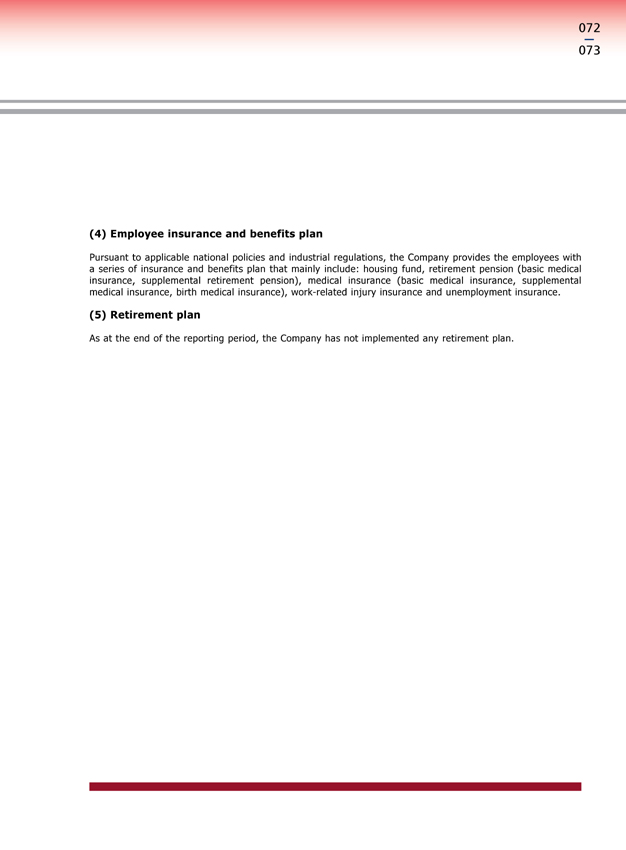
072
073
(4) |
| Employee insurance and benefits plan |
Pursuant to applicable national policies and industrial regulations, the Company provides the employees with a series of insurance and benefits plan that mainly include: housing fund, retirement pension (basic medical insurance, supplemental retirement pension), medical insurance (basic medical insurance, supplemental medical insurance, birth medical insurance), work-related injury insurance and unemployment insurance.
(5) |
| Retirement plan |
As at the end of the reporting period, the Company has not implemented any retirement plan.


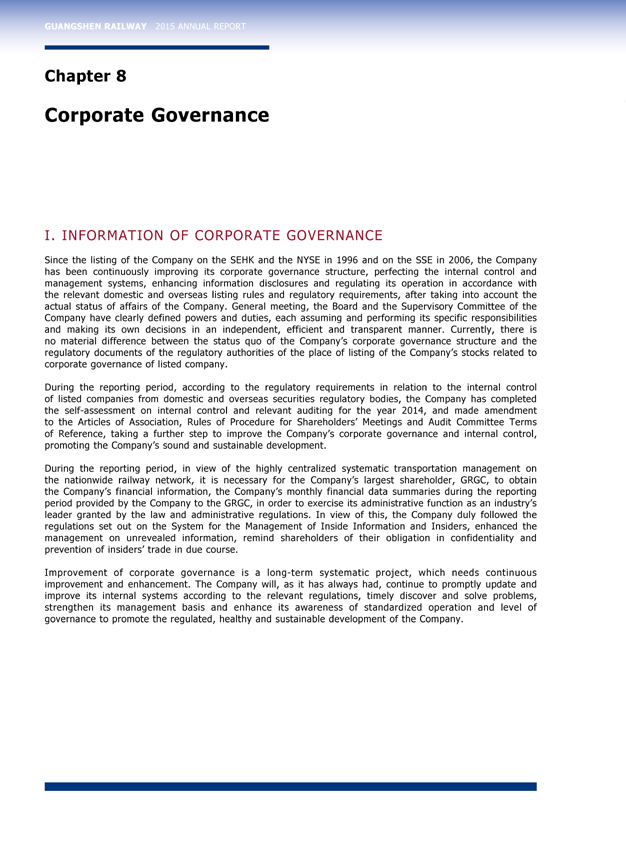
GUANGSHEN RAILWAY 2015 ANNUAL REPORT
Chapter 8
Corporate Governance
I. INFORMATION OF CORPORATE GOVERNANCE
Since the listing of the Company on the SEHK and the NYSE in 1996 and on the SSE in 2006, the Company has been continuously improving its corporate governance structure, perfecting the internal control and management systems, enhancing information disclosures and regulating its operation in accordance with the relevant domestic and overseas listing rules and regulatory requirements, after taking into account the actual status of affairs of the Company. General meeting, the Board and the Supervisory Committee of the Company have clearly defined powers and duties, each assuming and performing its specific responsibilities and making its own decisions in an independent, efficient and transparent manner. Currently, there is no material difference between the status quo of the Company’s corporate governance structure and the regulatory documents of the regulatory authorities of the place of listing of the Company’s stocks related to corporate governance of listed company.
During the reporting period, according to the regulatory requirements in relation to the internal control of listed companies from domestic and overseas securities regulatory bodies, the Company has completed the self-assessment on internal control and relevant auditing for the year 2014, and made amendment to the Articles of Association, Rules of Procedure for Shareholders’ Meetings and Audit Committee Terms of Reference, taking a further step to improve the Company’s corporate governance and internal control, promoting the Company’s sound and sustainable development.
During the reporting period, in view of the highly centralized systematic transportation management on the nationwide railway network, it is necessary for the Company’s largest shareholder, GRGC, to obtain the Company’s financial information, the Company’s monthly financial data summaries during the reporting period provided by the Company to the GRGC, in order to exercise its administrative function as an industry’s leader granted by the law and administrative regulations. In view of this, the Company duly followed the regulations set out on the System for the Management of Inside Information and Insiders, enhanced the management on unrevealed information, remind shareholders of their obligation in confidentiality and prevention of insiders’ trade in due course.
Improvement of corporate governance is a long-term systematic project, which needs continuous improvement and enhancement. The Company will, as it has always had, continue to promptly update and improve its internal systems according to the relevant regulations, timely discover and solve problems, strengthen its management basis and enhance its awareness of standardized operation and level of governance to promote the regulated, healthy and sustainable development of the Company.
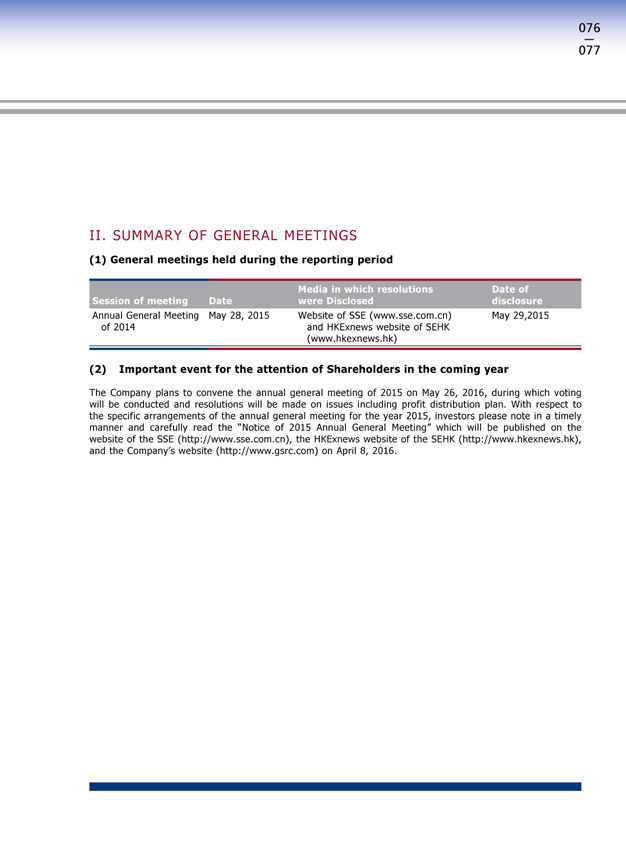
076
077
II. SUMMARY OF GENERAL MEETINGS
(1) |
| General meetings held during the reporting period |
Media in which resolutions Date of
Session of meeting Date were Disclosed disclosure
Annual General Meeting May 28, 2015 Website of SSE (www.sse.com.cn) May 29,2015
of 2014 and HKExnews website of SEHK
(www.hkexnews.hk)
(2) |
| Important event for the attention of Shareholders in the coming year |
The Company plans to convene the annual general meeting of 2015 on May 26, 2016, during which voting will be conducted and resolutions will be made on issues including profit distribution plan. With respect to the specific arrangements of the annual general meeting for the year 2015, investors please note in a timely manner and carefully read the “Notice of 2015 Annual General Meeting” which will be published on the website of the SSE (http://www.sse.com.cn), the HKExnews website of the SEHK (http://www.hkexnews.hk), and the Company’s website (http://www.gsrc.com) on April 8, 2016.
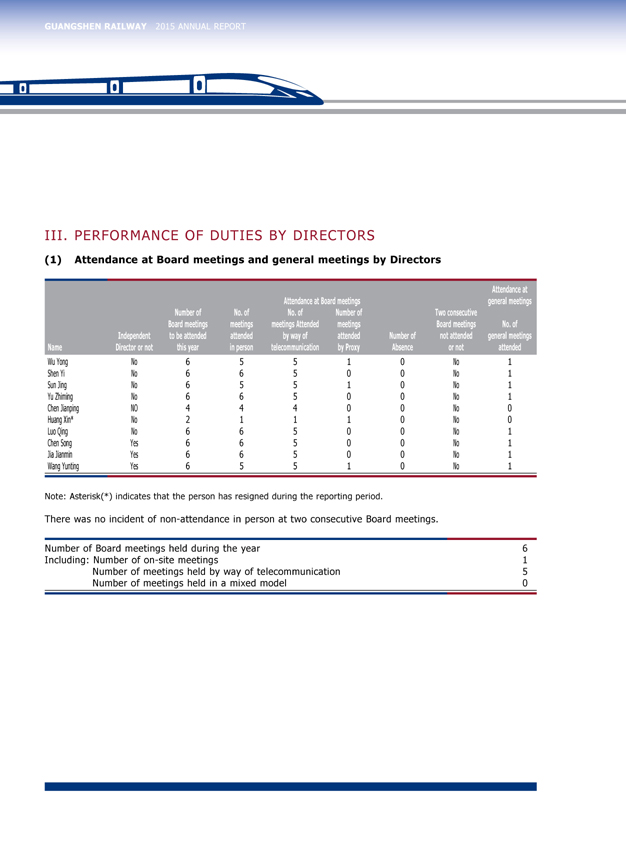
GUANGSHEN RAILWAY 2015 ANNUAL REPORT
III. PERFORMANCE OF DUTIES BY DIRECTORS
(1) |
| Attendance at Board meetings and general meetings by Directors |
Attendance at
Attendance at Board meetings general meetings
Number of No. of No. of Number of Two consecutive
Board meetings meetings meetings Attended meetings Board meetings No. of
Independent to be attended attended by way of attended Number of not attended general meetings
Name Director or not this year in person telecommunication by Proxy Absence or not attended
Wu Yong No 6 5 5 1 0 No 1
Shen Yi No 6 6 5 0 0 No 1
Sun Jing No 6 5 5 1 0 No 1
Yu Zhiming No 6 6 5 0 0 No 1
Chen Jianping NO 4 4 4 0 0 No 0
Huang Xin* No 2 1 1 1 0 No 0
Luo Qing No 6 6 5 0 0 No 1
Chen Song Yes 6 6 5 0 0 No 1
Jia Jianmin Yes 6 6 5 0 0 No 1
Wang Yunting Yes 6 5 5 1 0 No 1
Note: Asterisk(*) indicates that the person has resigned during the reporting period.
There was no incident of non-attendance in person at two consecutive Board meetings.
Number of Board meetings held during the year 6
Including: Number of on-site meetings 1
Number of meetings held by way of telecommunication 5
Number of meetings held in a mixed model 0
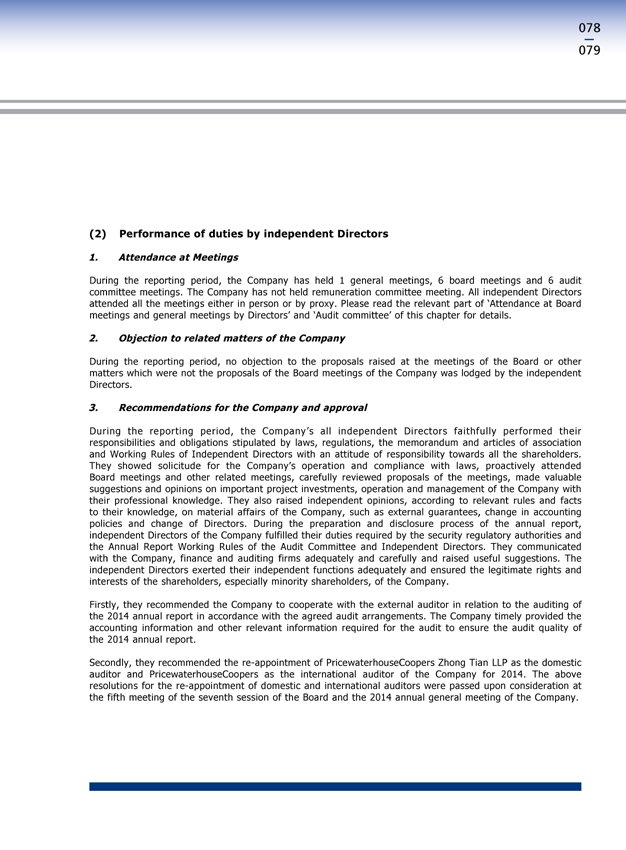
078
079
(2) |
| Performance of duties by independent Directors |
1. Attendance at Meetings
During the reporting period, the Company has held 1 general meetings, 6 board meetings and 6 audit committee meetings. The Company has not held remuneration committee meeting. All independent Directors attended all the meetings either in person or by proxy. Please read the relevant part of ‘Attendance at Board meetings and general meetings by Directors’ and ‘Audit committee’ of this chapter for details.
2. Objection to related matters of the Company
During the reporting period, no objection to the proposals raised at the meetings of the Board or other matters which were not the proposals of the Board meetings of the Company was lodged by the independent Directors.
3. Recommendations for the Company and approval
During the reporting period, the Company’s all independent Directors faithfully performed their responsibilities and obligations stipulated by laws, regulations, the memorandum and articles of association and Working Rules of Independent Directors with an attitude of responsibility towards all the shareholders. They showed solicitude for the Company’s operation and compliance with laws, proactively attended Board meetings and other related meetings, carefully reviewed proposals of the meetings, made valuable suggestions and opinions on important project investments, operation and management of the Company with their professional knowledge. They also raised independent opinions, according to relevant rules and facts to their knowledge, on material affairs of the Company, such as external guarantees, change in accounting policies and change of Directors. During the preparation and disclosure process of the annual report, independent Directors of the Company fulfilled their duties required by the security regulatory authorities and the Annual Report Working Rules of the Audit Committee and Independent Directors. They communicated with the Company, finance and auditing firms adequately and carefully and raised useful suggestions. The independent Directors exerted their independent functions adequately and ensured the legitimate rights and interests of the shareholders, especially minority shareholders, of the Company.
Firstly, they recommended the Company to cooperate with the external auditor in relation to the auditing of the 2014 annual report in accordance with the agreed audit arrangements. The Company timely provided the accounting information and other relevant information required for the audit to ensure the audit quality of the 2014 annual report.
Secondly, they recommended the re-appointment of PricewaterhouseCoopers Zhong Tian LLP as the domestic auditor and PricewaterhouseCoopers as the international auditor of the Company for 2014. The above resolutions for the re-appointment of domestic and international auditors were passed upon consideration at the fifth meeting of the seventh session of the Board and the 2014 annual general meeting of the Company.
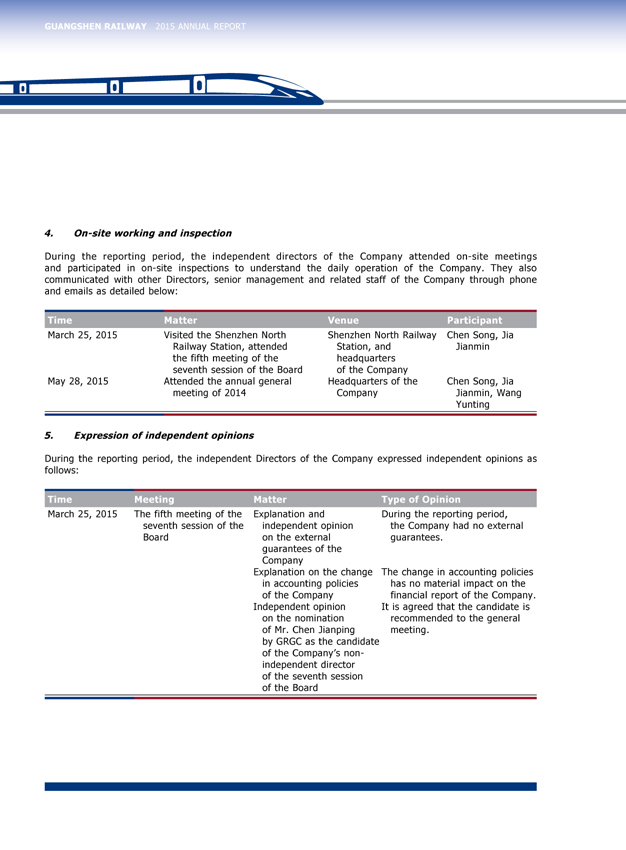
GUANGSHEN RAILWAY 2015 ANNUAL REPORT
4. On-site working and inspection
During the reporting period, the independent directors of the Company attended on-site meetings and participated in on-site inspections to understand the daily operation of the Company. They also communicated with other Directors, senior management and related staff of the Company through phone and emails as detailed below:
Time Matter Venue Participant
March 25, 2015 Visited the Shenzhen North Shenzhen North Railway Chen Song, Jia
Railway Station, attended Station, and Jianmin
the fifth meeting of the headquarters
seventh session of the Board of the Company
May 28, 2015 Attended the annual general Headquarters of the Chen Song, Jia
meeting of 2014 Company Jianmin, Wang
Yunting
5. Expression of independent opinions
During the reporting period, the independent Directors of the Company expressed independent opinions as follows:
Time Meeting Matter Type of Opinion
March 25, 2015 The fifth meeting of the Explanation and During the reporting period,
seventh session of the independent opinion the Company had no external
Board on the external guarantees.
guarantees of the
Company
Explanation on the change The change in accounting policies
in accounting policies has no material impact on the
of the Company financial report of the Company.
Independent opinion It is agreed that the candidate is
on the nomination recommended to the general
of Mr. Chen Jianping meeting.
by GRGC as the candidate
of the Company’s non-
independent director
of the seventh session
of the Board
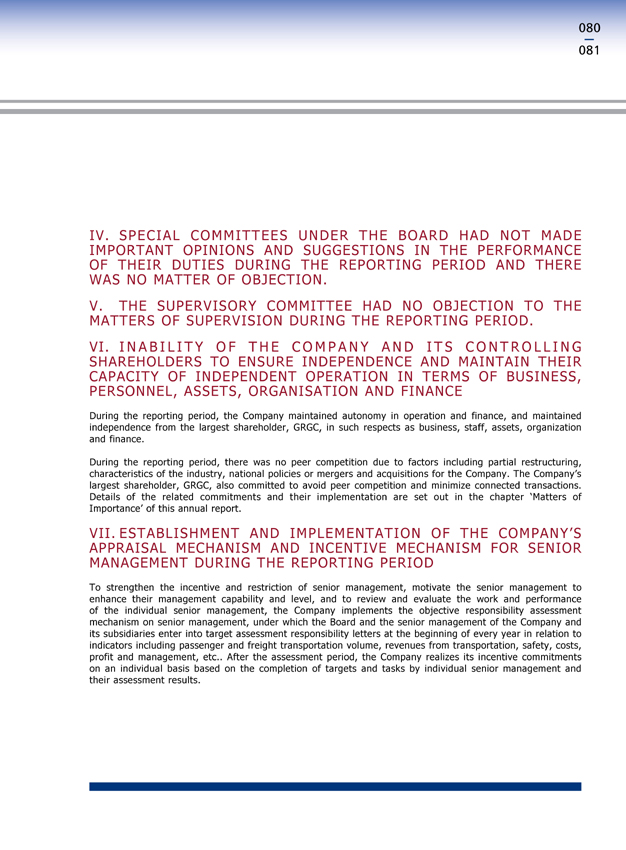
080
081
IV. SPECIAL COMMITTEES UNDER THE BOARD HAD NOT MADE IMPORTANT OPINIONS AND SUGGESTIONS IN THE PERFORMANCE OF THEIR DUTIES DURING THE REPORTING PERIOD AND THERE WAS NO MATTER OF OBJECTION.
V. THE SUPERVISORY COMMITTEE HAD NO OBJECTION TO THE MATTERS OF SUPERVISION DURING THE REPORTING PERIOD.
VI. I N A B I L I T Y O F T H E C O M P A N Y A N D I T S C O N T R O L L I N G SHAREHOLDERS TO ENSURE INDEPENDENCE AND MAINTAIN THEIR CAPACITY OF INDEPENDENT OPERATION IN TERMS OF BUSINESS, PERSONNEL, ASSETS, ORGANISATION AND FINANCE
During the reporting period, the Company maintained autonomy in operation and finance, and maintained independence from the largest shareholder, GRGC, in such respects as business, staff, assets, organization and finance.
During the reporting period, there was no peer competition due to factors including partial restructuring, characteristics of the industry, national policies or mergers and acquisitions for the Company. The Company’s largest shareholder, GRGC, also committed to avoid peer competition and minimize connected transactions. Details of the related commitments and their implementation are set out in the chapter ‘Matters of Importance’ of this annual report.
VII. ESTABLISHMENT AND IMPLEMENTATION OF THE COMPANY’S APPRAISAL MECHANISM AND INCENTIVE MECHANISM FOR SENIOR MANAGEMENT DURING THE REPORTING PERIOD
To strengthen the incentive and restriction of senior management, motivate the senior management to enhance their management capability and level, and to review and evaluate the work and performance of the individual senior management, the Company implements the objective responsibility assessment mechanism on senior management, under which the Board and the senior management of the Company and its subsidiaries enter into target assessment responsibility letters at the beginning of every year in relation to indicators including passenger and freight transportation volume, revenues from transportation, safety, costs, profit and management, etc After the assessment period, the Company realizes its incentive commitments on an individual basis based on the completion of targets and tasks by individual senior management and their assessment results.
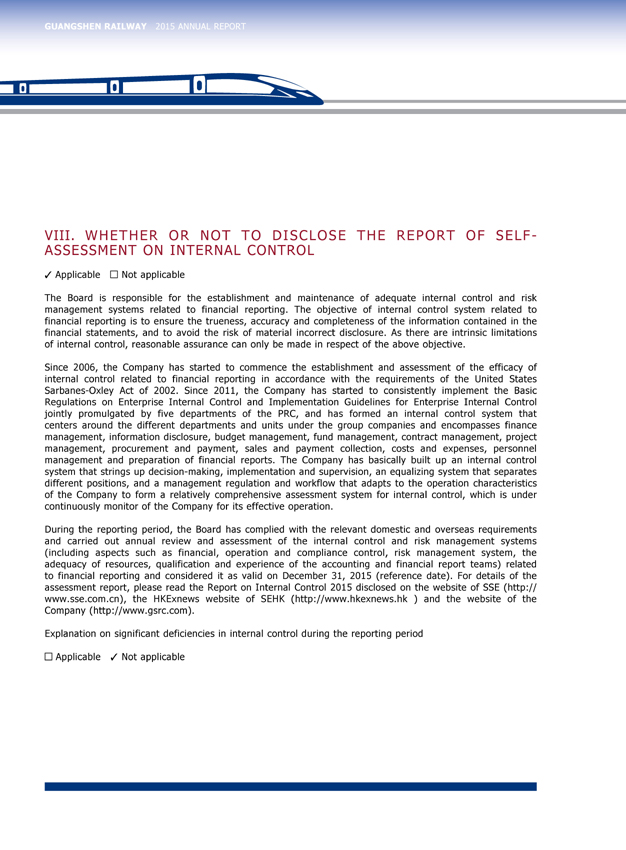
GUANGSHEN RAILWAY 2015 ANNUAL REPORT
VIII. WHETHER OR NOT TO DISCLOSE THE REPORT OF SELF-ASSESSMENT ON INTERNAL CONTROL
??Applicable Not applicable
The Board is responsible for the establishment and maintenance of adequate internal control and risk management systems related to financial reporting. The objective of internal control system related to financial reporting is to ensure the trueness, accuracy and completeness of the information contained in the financial statements, and to avoid the risk of material incorrect disclosure. As there are intrinsic limitations of internal control, reasonable assurance can only be made in respect of the above objective.
Since 2006, the Company has started to commence the establishment and assessment of the efficacy of internal control related to financial reporting in accordance with the requirements of the United States Sarbanes-Oxley Act of 2002. Since 2011, the Company has started to consistently implement the Basic Regulations on Enterprise Internal Control and Implementation Guidelines for Enterprise Internal Control jointly promulgated by five departments of the PRC, and has formed an internal control system that centers around the different departments and units under the group companies and encompasses finance management, information disclosure, budget management, fund management, contract management, project management, procurement and payment, sales and payment collection, costs and expenses, personnel management and preparation of financial reports. The Company has basically built up an internal control system that strings up decision-making, implementation and supervision, an equalizing system that separates different positions, and a management regulation and workflow that adapts to the operation characteristics of the Company to form a relatively comprehensive assessment system for internal control, which is under continuously monitor of the Company for its effective operation.
During the reporting period, the Board has complied with the relevant domestic and overseas requirements and carried out annual review and assessment of the internal control and risk management systems (including aspects such as financial, operation and compliance control, risk management system, the adequacy of resources, qualification and experience of the accounting and financial report teams) related to financial reporting and considered it as valid on December 31, 2015 (reference date). For details of the assessment report, please read the Report on Internal Control 2015 disclosed on the website of SSE (http:// www.sse.com.cn), the HKExnews website of SEHK (http://www.hkexnews.hk ) and the website of the Company (http://www.gsrc.com).
Explanation on significant deficiencies in internal control during the reporting period
?Applicable ? Not applicable
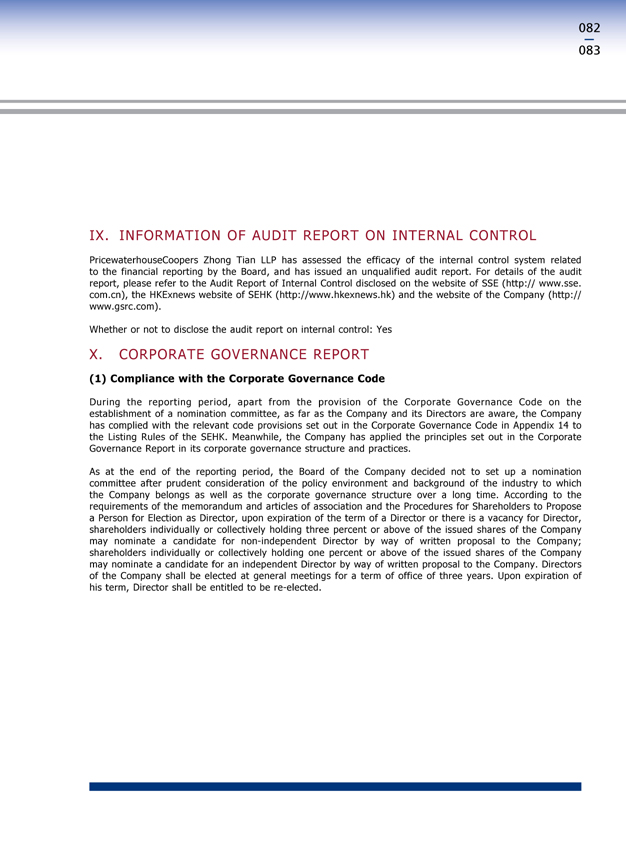
082
083
IX. INFORMATION OF AUDIT REPORT ON INTERNAL CONTROL
PricewaterhouseCoopers Zhong Tian LLP has assessed the efficacy of the internal control system related to the financial reporting by the Board, and has issued an unqualified audit report. For details of the audit report, please refer to the Audit Report of Internal Control disclosed on the website of SSE (http:// www.sse. com.cn), the HKExnews website of SEHK (http://www.hkexnews.hk) and the website of the Company (http:// www.gsrc.com).
Whether or not to disclose the audit report on internal control: Yes
X. CORPORATE GOVERNANCE REPORT
(1) |
| Compliance with the Corporate Governance Code |
During the reporting period, apart from the provision of the Corporate Governance Code on the establishment of a nomination committee, as far as the Company and its Directors are aware, the Company has complied with the relevant code provisions set out in the Corporate Governance Code in Appendix 14 to the Listing Rules of the SEHK. Meanwhile, the Company has applied the principles set out in the Corporate Governance Report in its corporate governance structure and practices.
As at the end of the reporting period, the Board of the Company decided not to set up a nomination committee after prudent consideration of the policy environment and background of the industry to which the Company belongs as well as the corporate governance structure over a long time. According to the requirements of the memorandum and articles of association and the Procedures for Shareholders to Propose a Person for Election as Director, upon expiration of the term of a Director or there is a vacancy for Director, shareholders individually or collectively holding three percent or above of the issued shares of the Company may nominate a candidate for non-independent Director by way of written proposal to the Company; shareholders individually or collectively holding one percent or above of the issued shares of the Company may nominate a candidate for an independent Director by way of written proposal to the Company. Directors of the Company shall be elected at general meetings for a term of office of three years. Upon expiration of his term, Director shall be entitled to be re-elected.
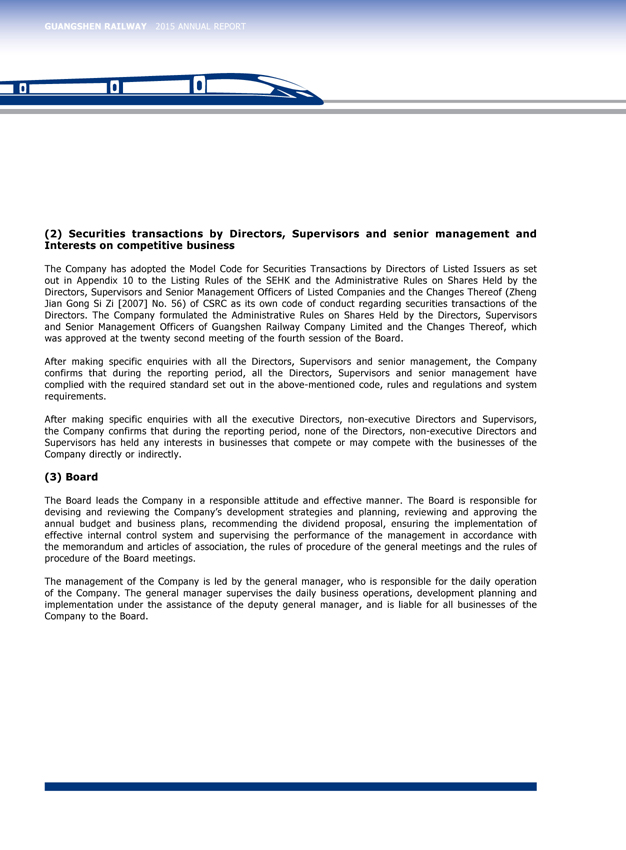
GUANGSHEN RAILWAY 2015 ANNUAL REPORT
(2) |
| Securities transactions by Directors, Supervisors and senior management and |
Interests on competitive business
The Company has adopted the Model Code for Securities Transactions by Directors of Listed Issuers as set out in Appendix 10 to the Listing Rules of the SEHK and the Administrative Rules on Shares Held by the Directors, Supervisors and Senior Management Officers of Listed Companies and the Changes Thereof (Zheng Jian Gong Si Zi [2007] No. 56) of CSRC as its own code of conduct regarding securities transactions of the Directors. The Company formulated the Administrative Rules on Shares Held by the Directors, Supervisors and Senior Management Officers of Guangshen Railway Company Limited and the Changes Thereof, which was approved at the twenty second meeting of the fourth session of the Board.
After making specific enquiries with all the Directors, Supervisors and senior management, the Company confirms that during the reporting period, all the Directors, Supervisors and senior management have complied with the required standard set out in the above-mentioned code, rules and regulations and system requirements.
After making specific enquiries with all the executive Directors, non-executive Directors and Supervisors, the Company confirms that during the reporting period, none of the Directors, non-executive Directors and Supervisors has held any interests in businesses that compete or may compete with the businesses of the Company directly or indirectly.
(3) |
| Board |
The Board leads the Company in a responsible attitude and effective manner. The Board is responsible for devising and reviewing the Company’s development strategies and planning, reviewing and approving the annual budget and business plans, recommending the dividend proposal, ensuring the implementation of effective internal control system and supervising the performance of the management in accordance with the memorandum and articles of association, the rules of procedure of the general meetings and the rules of procedure of the Board meetings.
The management of the Company is led by the general manager, who is responsible for the daily operation of the Company. The general manager supervises the daily business operations, development planning and implementation under the assistance of the deputy general manager, and is liable for all businesses of the Company to the Board.
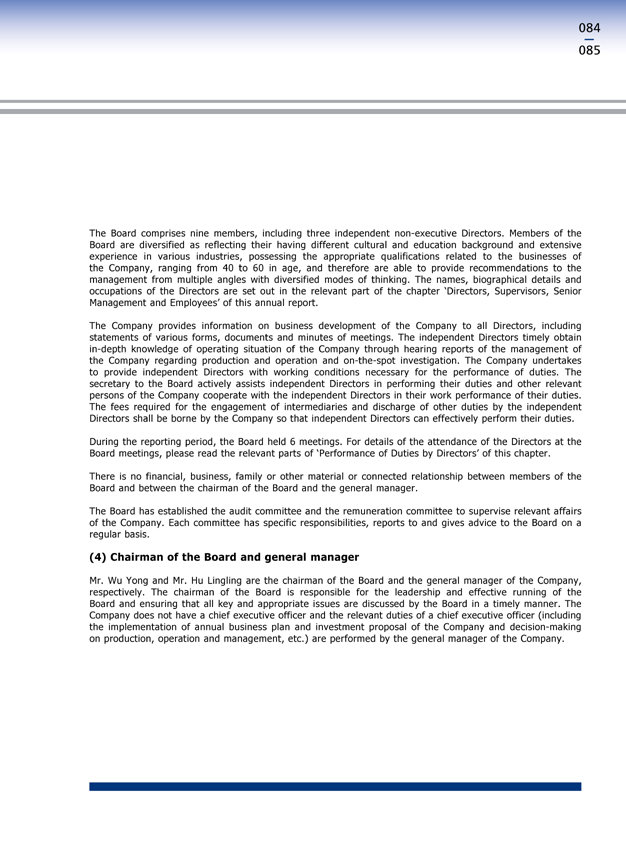
084
085
The Board comprises nine members, including three independent non-executive Directors. Members of the Board are diversified as reflecting their having different cultural and education background and extensive experience in various industries, possessing the appropriate qualifications related to the businesses of the Company, ranging from 40 to 60 in age, and therefore are able to provide recommendations to the management from multiple angles with diversified modes of thinking. The names, biographical details and occupations of the Directors are set out in the relevant part of the chapter ‘Directors, Supervisors, Senior Management and Employees’ of this annual report.
The Company provides information on business development of the Company to all Directors, including statements of various forms, documents and minutes of meetings. The independent Directors timely obtain in-depth knowledge of operating situation of the Company through hearing reports of the management of the Company regarding production and operation and on-the-spot investigation. The Company undertakes to provide independent Directors with working conditions necessary for the performance of duties. The secretary to the Board actively assists independent Directors in performing their duties and other relevant persons of the Company cooperate with the independent Directors in their work performance of their duties. The fees required for the engagement of intermediaries and discharge of other duties by the independent Directors shall be borne by the Company so that independent Directors can effectively perform their duties.
During the reporting period, the Board held 6 meetings. For details of the attendance of the Directors at the Board meetings, please read the relevant parts of ‘Performance of Duties by Directors’ of this chapter.
There is no financial, business, family or other material or connected relationship between members of the Board and between the chairman of the Board and the general manager.
The Board has established the audit committee and the remuneration committee to supervise relevant affairs of the Company. Each committee has specific responsibilities, reports to and gives advice to the Board on a regular basis.
(4) |
| Chairman of the Board and general manager |
Mr. Wu Yong and Mr. Hu Lingling are the chairman of the Board and the general manager of the Company, respectively. The chairman of the Board is responsible for the leadership and effective running of the Board and ensuring that all key and appropriate issues are discussed by the Board in a timely manner. The Company does not have a chief executive officer and the relevant duties of a chief executive officer (including the implementation of annual business plan and investment proposal of the Company and decision-making on production, operation and management, etc.) are performed by the general manager of the Company.
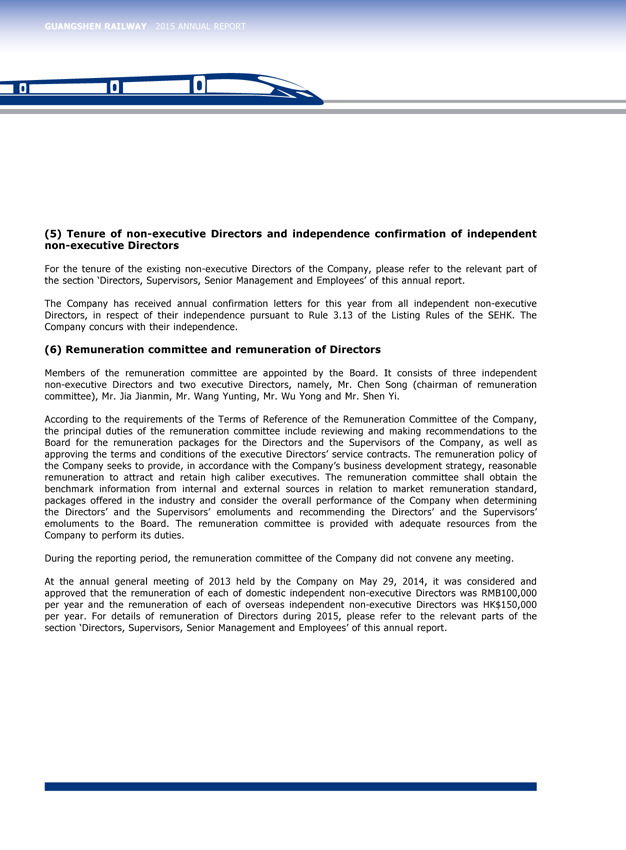
GUANGSHEN RAILWAY 2015 ANNUAL REPORT
(5) |
| Tenure of non-executive Directors and independence confirmation of independent |
non-executive Directors
For the tenure of the existing non-executive Directors of the Company, please refer to the relevant part of the section ‘Directors, Supervisors, Senior Management and Employees’ of this annual report.
The Company has received annual confirmation letters for this year from all independent non-executive Directors, in respect of their independence pursuant to Rule 3.13 of the Listing Rules of the SEHK. The Company concurs with their independence.
(6) |
| Remuneration committee and remuneration of Directors |
Members of the remuneration committee are appointed by the Board. It consists of three independent non-executive Directors and two executive Directors, namely, Mr. Chen Song (chairman of remuneration committee), Mr. Jia Jianmin, Mr. Wang Yunting, Mr. Wu Yong and Mr. Shen Yi.
According to the requirements of the Terms of Reference of the Remuneration Committee of the Company, the principal duties of the remuneration committee include reviewing and making recommendations to the Board for the remuneration packages for the Directors and the Supervisors of the Company, as well as approving the terms and conditions of the executive Directors’ service contracts. The remuneration policy of the Company seeks to provide, in accordance with the Company’s business development strategy, reasonable remuneration to attract and retain high caliber executives. The remuneration committee shall obtain the benchmark information from internal and external sources in relation to market remuneration standard, packages offered in the industry and consider the overall performance of the Company when determining the Directors’ and the Supervisors’ emoluments and recommending the Directors’ and the Supervisors’ emoluments to the Board. The remuneration committee is provided with adequate resources from the Company to perform its duties.
During the reporting period, the remuneration committee of the Company did not convene any meeting.
At the annual general meeting of 2013 held by the Company on May 29, 2014, it was considered and approved that the remuneration of each of domestic independent non-executive Directors was RMB100,000 per year and the remuneration of each of overseas independent non-executive Directors was HK$150,000 per year. For details of remuneration of Directors during 2015, please refer to the relevant parts of the section ‘Directors, Supervisors, Senior Management and Employees’ of this annual report.
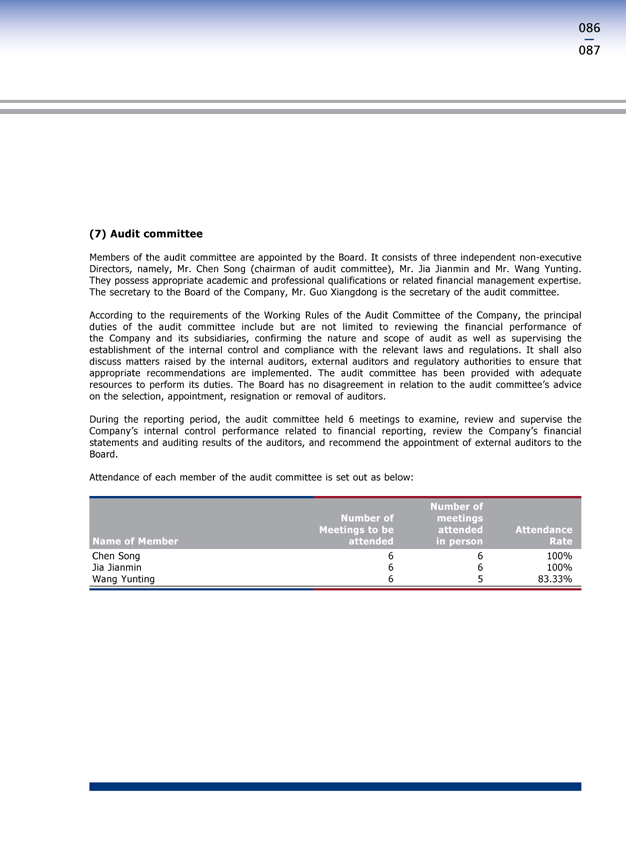
086
087
(7) |
| Audit committee |
Members of the audit committee are appointed by the Board. It consists of three independent non-executive Directors, namely, Mr. Chen Song (chairman of audit committee), Mr. Jia Jianmin and Mr. Wang Yunting. They possess appropriate academic and professional qualifications or related financial management expertise. The secretary to the Board of the Company, Mr. Guo Xiangdong is the secretary of the audit committee.
According to the requirements of the Working Rules of the Audit Committee of the Company, the principal duties of the audit committee include but are not limited to reviewing the financial performance of the Company and its subsidiaries, confirming the nature and scope of audit as well as supervising the establishment of the internal control and compliance with the relevant laws and regulations. It shall also discuss matters raised by the internal auditors, external auditors and regulatory authorities to ensure that appropriate recommendations are implemented. The audit committee has been provided with adequate resources to perform its duties. The Board has no disagreement in relation to the audit committee’s advice on the selection, appointment, resignation or removal of auditors.
During the reporting period, the audit committee held 6 meetings to examine, review and supervise the Company’s internal control performance related to financial reporting, review the Company’s financial statements and auditing results of the auditors, and recommend the appointment of external auditors to the Board.
Attendance of each member of the audit committee is set out as below:
Number of
Number of meetings
Meetings to be attended Attendance
Name of Member attended in person Rate
Chen Song 6 6 100%
Jia Jianmin 6 6 100%
Wang Yunting 6 5 83.33%
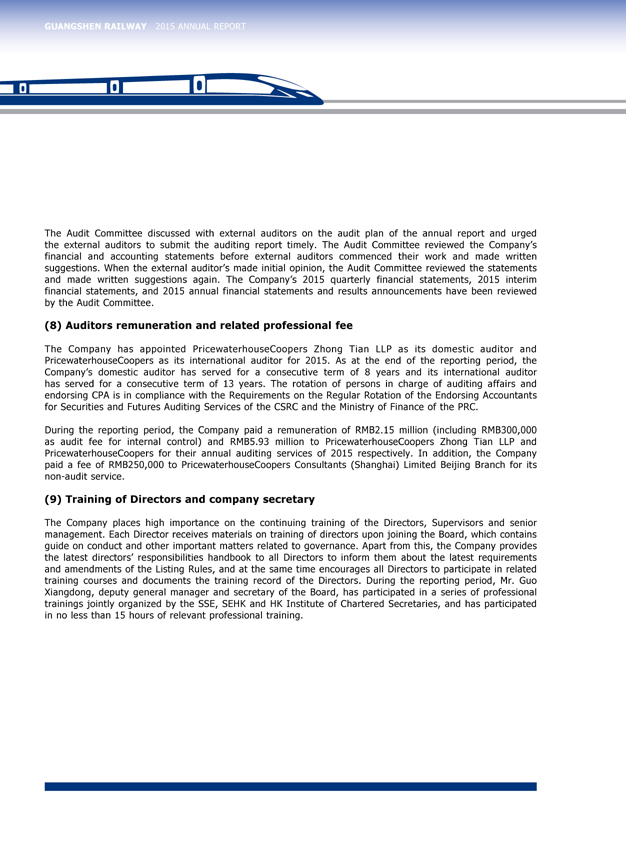
GUANGSHEN RAILWAY 2015 ANNUAL REPORT
The Audit Committee discussed with external auditors on the audit plan of the annual report and urged the external auditors to submit the auditing report timely. The Audit Committee reviewed the Company’s financial and accounting statements before external auditors commenced their work and made written suggestions. When the external auditor’s made initial opinion, the Audit Committee reviewed the statements and made written suggestions again. The Company’s 2015 quarterly financial statements, 2015 interim financial statements, and 2015 annual financial statements and results announcements have been reviewed by the Audit Committee.
(8) |
| Auditors remuneration and related professional fee |
The Company has appointed PricewaterhouseCoopers Zhong Tian LLP as its domestic auditor and PricewaterhouseCoopers as its international auditor for 2015. As at the end of the reporting period, the Company’s domestic auditor has served for a consecutive term of 8 years and its international auditor has served for a consecutive term of 13 years. The rotation of persons in charge of auditing affairs and endorsing CPA is in compliance with the Requirements on the Regular Rotation of the Endorsing Accountants for Securities and Futures Auditing Services of the CSRC and the Ministry of Finance of the PRC.
During the reporting period, the Company paid a remuneration of RMB2.15 million (including RMB300,000 as audit fee for internal control) and RMB5.93 million to PricewaterhouseCoopers Zhong Tian LLP and PricewaterhouseCoopers for their annual auditing services of 2015 respectively. In addition, the Company paid a fee of RMB250,000 to PricewaterhouseCoopers Consultants (Shanghai) Limited Beijing Branch for its non-audit service.
(9) |
| Training of Directors and company secretary |
The Company places high importance on the continuing training of the Directors, Supervisors and senior management. Each Director receives materials on training of directors upon joining the Board, which contains guide on conduct and other important matters related to governance. Apart from this, the Company provides the latest directors’ responsibilities handbook to all Directors to inform them about the latest requirements and amendments of the Listing Rules, and at the same time encourages all Directors to participate in related training courses and documents the training record of the Directors. During the reporting period, Mr. Guo Xiangdong, deputy general manager and secretary of the Board, has participated in a series of professional trainings jointly organized by the SSE, SEHK and HK Institute of Chartered Secretaries, and has participated in no less than 15 hours of relevant professional training.
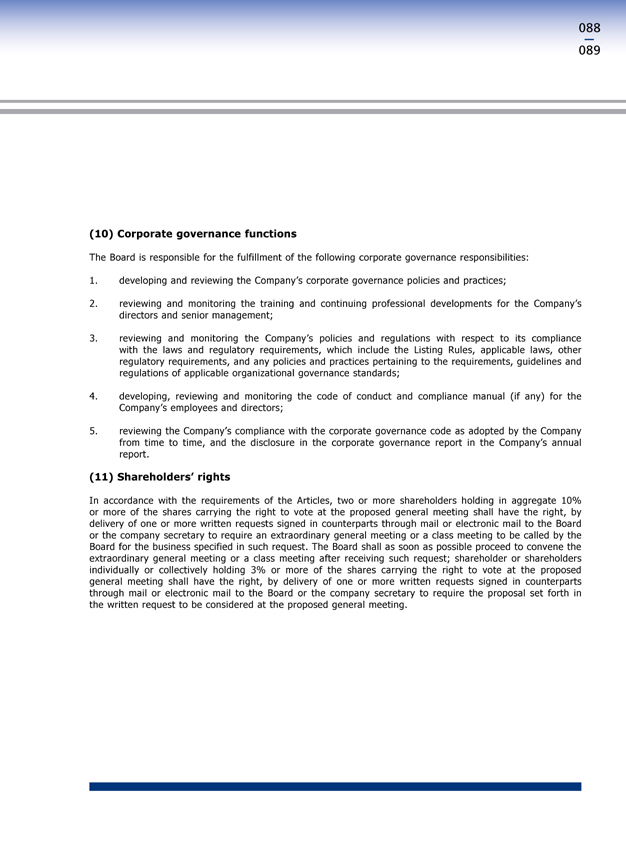
088
089
(10) |
| Corporate governance functions |
The Board is responsible for the fulfillment of the following corporate governance responsibilities:
1. developing and reviewing the Company’s corporate governance policies and practices;
2. reviewing and monitoring the training and continuing professional developments for the Company’s directors and senior management;
3. reviewing and monitoring the Company’s policies and regulations with respect to its compliance with the laws and regulatory requirements, which include the Listing Rules, applicable laws, other regulatory requirements, and any policies and practices pertaining to the requirements, guidelines and regulations of applicable organizational governance standards;
4. developing, reviewing and monitoring the code of conduct and compliance manual (if any) for the Company’s employees and directors;
5. reviewing the Company’s compliance with the corporate governance code as adopted by the Company from time to time, and the disclosure in the corporate governance report in the Company’s annual report.
(11) |
| Shareholders’ rights |
In accordance with the requirements of the Articles, two or more shareholders holding in aggregate 10% or more of the shares carrying the right to vote at the proposed general meeting shall have the right, by delivery of one or more written requests signed in counterparts through mail or electronic mail to the Board or the company secretary to require an extraordinary general meeting or a class meeting to be called by the Board for the business specified in such request. The Board shall as soon as possible proceed to convene the extraordinary general meeting or a class meeting after receiving such request; shareholder or shareholders individually or collectively holding 3% or more of the shares carrying the right to vote at the proposed general meeting shall have the right, by delivery of one or more written requests signed in counterparts through mail or electronic mail to the Board or the company secretary to require the proposal set forth in the written request to be considered at the proposed general meeting.
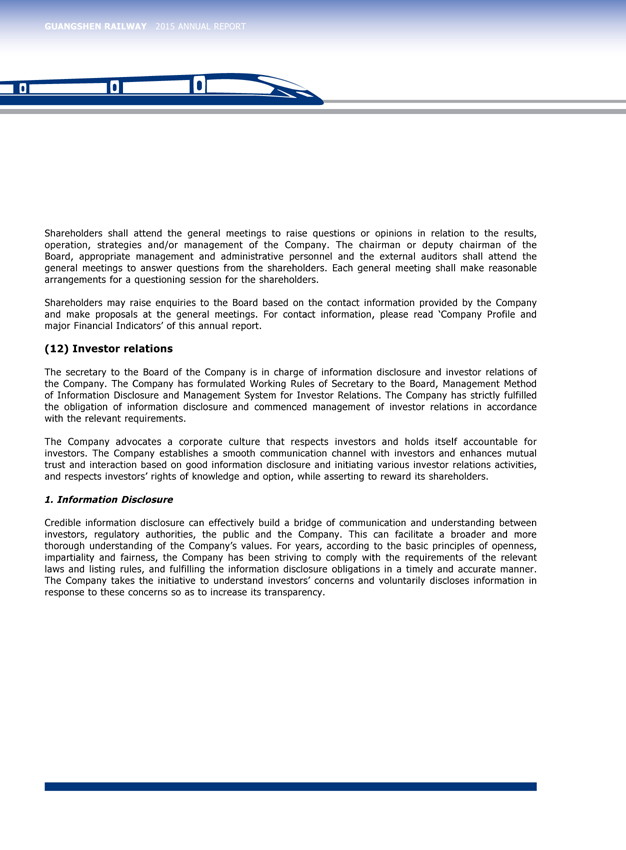
GUANGSHEN RAILWAY 2015 ANNUAL REPORT
Shareholders shall attend the general meetings to raise questions or opinions in relation to the results, operation, strategies and/or management of the Company. The chairman or deputy chairman of the Board, appropriate management and administrative personnel and the external auditors shall attend the general meetings to answer questions from the shareholders. Each general meeting shall make reasonable arrangements for a questioning session for the shareholders.
Shareholders may raise enquiries to the Board based on the contact information provided by the Company and make proposals at the general meetings. For contact information, please read ‘Company Profile and major Financial Indicators’ of this annual report.
(12) |
| Investor relations |
The secretary to the Board of the Company is in charge of information disclosure and investor relations of the Company. The Company has formulated Working Rules of Secretary to the Board, Management Method of Information Disclosure and Management System for Investor Relations. The Company has strictly fulfilled the obligation of information disclosure and commenced management of investor relations in accordance with the relevant requirements.
The Company advocates a corporate culture that respects investors and holds itself accountable for investors. The Company establishes a smooth communication channel with investors and enhances mutual trust and interaction based on good information disclosure and initiating various investor relations activities, and respects investors’ rights of knowledge and option, while asserting to reward its shareholders.
1. Information Disclosure
Credible information disclosure can effectively build a bridge of communication and understanding between investors, regulatory authorities, the public and the Company. This can facilitate a broader and more thorough understanding of the Company’s values. For years, according to the basic principles of openness, impartiality and fairness, the Company has been striving to comply with the requirements of the relevant laws and listing rules, and fulfilling the information disclosure obligations in a timely and accurate manner. The Company takes the initiative to understand investors’ concerns and voluntarily discloses information in response to these concerns so as to increase its transparency.
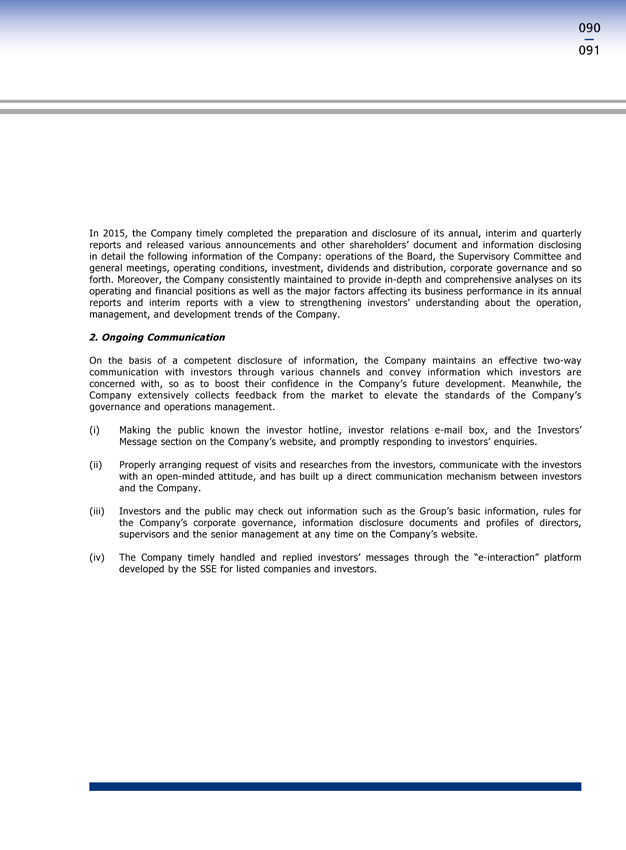
090
091
In 2015, the Company timely completed the preparation and disclosure of its annual, interim and quarterly reports and released various announcements and other shareholders’ document and information disclosing in detail the following information of the Company: operations of the Board, the Supervisory Committee and general meetings, operating conditions, investment, dividends and distribution, corporate governance and so forth. Moreover, the Company consistently maintained to provide in-depth and comprehensive analyses on its operating and financial positions as well as the major factors affecting its business performance in its annual reports and interim reports with a view to strengthening investors’ understanding about the operation, management, and development trends of the Company.
2. Ongoing Communication
On the basis of a competent disclosure of information, the Company maintains an effective two-way communication with investors through various channels and convey information which investors are concerned with, so as to boost their confidence in the Company’s future development. Meanwhile, the Company extensively collects feedback from the market to elevate the standards of the Company’s governance and operations management.
(i) Making the public known the investor hotline, investor relations e-mail box, and the Investors’ Message section on the Company’s website, and promptly responding to investors’ enquiries.
(ii) Properly arranging request of visits and researches from the investors, communicate with the investors with an open-minded attitude, and has built up a direct communication mechanism between investors and the Company.
(iii) Investors and the public may check out information such as the Group’s basic information, rules for the Company’s corporate governance, information disclosure documents and profiles of directors, supervisors and the senior management at any time on the Company’s website.
(iv) The Company timely handled and replied investors’ messages through the “e-interaction” platform developed by the SSE for listed companies and investors.
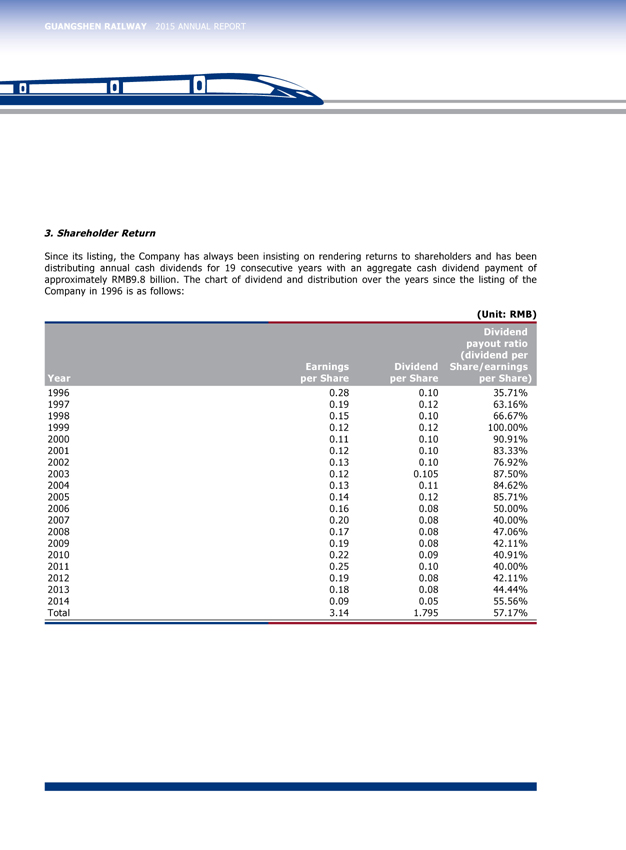
GUANGSHEN RAILWAY 2015 ANNUAL REPORT
3. Shareholder Return
Since its listing, the Company has always been insisting on rendering returns to shareholders and has been distributing annual cash dividends for 19 consecutive years with an aggregate cash dividend payment of approximately RMB9.8 billion. The chart of dividend and distribution over the years since the listing of the Company in 1996 is as follows:
(Unit: RMB)
Dividend
payout ratio
(dividend per
Earnings Dividend Share/earnings
Year per Share per Share per Share)
1996 0.28 0.10 35.71%
1997 0.19 0.12 63.16%
1998 0.15 0.10 66.67%
1999 0.12 0.12 100.00%
2000 0.11 0.10 90.91%
2001 0.12 0.10 83.33%
2002 0.13 0.10 76.92%
2003 0.12 0.105 87.50%
2004 0.13 0.11 84.62%
2005 0.14 0.12 85.71%
2006 0.16 0.08 50.00%
2007 0.20 0.08 40.00%
2008 0.17 0.08 47.06%
2009 0.19 0.08 42.11%
2010 0.22 0.09 40.91%
2011 0.25 0.10 40.00%
2012 0.19 0.08 42.11%
2013 0.18 0.08 44.44%
2014 0.09 0.05 55.56%
Total 3.14 1.795 57.17%

092
093
The Board of the Company has recommended the payment of cash dividend of RMB0.08 (including tax) for 2015, the aforesaid recommendation shall be subject to approval at the 2015 annual general meeting. For details of the dividends, the cash dividend policy of the Company and its implementation, please read the relevant part in the section “Matters of Importance” of this annual report.
(13) |
| Accountability and auditing |
The Directors of the Company acknowledge their responsibility for preparing the accounts and supervising the preparation of the accounts for each financial period, so that the accounts can truly and fairly reflect the business position, results and cash flow of the Company during the period. During the preparation of the accounts for the year ended December 31, 2015, the Directors adopted and consistently applied appropriate accounting policies, made scrupulous judgments and estimates, and prepared the accounts on a going concern basis.
The Company announced its annual and interim reports in a timely manner within the limits of 4 months and 2 months, respectively after the end of the relevant period in accordance with the Listing Rules of the SEHK. The Company also announced its annual, interim and quarter reports timely in accordance with the Rules Governing the Listing of Stocks of SSE.
The responsibility statements of the Directors and the auditors as to the preparation of the financial statements of the Company are set out in the “Audit Report” in Chapter 9 — Financial Statements of this annual report.
(14) |
| Material change in the Articles of Association |
On May 28, 2015, the Company convened its 2014 annual general meeting, in which the proposal for amendments to the Articles of Association were approved. For details of the amendments, please read “2014 Annual General Meeting Information” dislosed on the website of the SSE (http://www.sse.com.cn), the HKExnews website of the SEHK (http://www.hkexnews.hk), and the Company’s website (http://www.gsrc. com) on April 10, 2015.
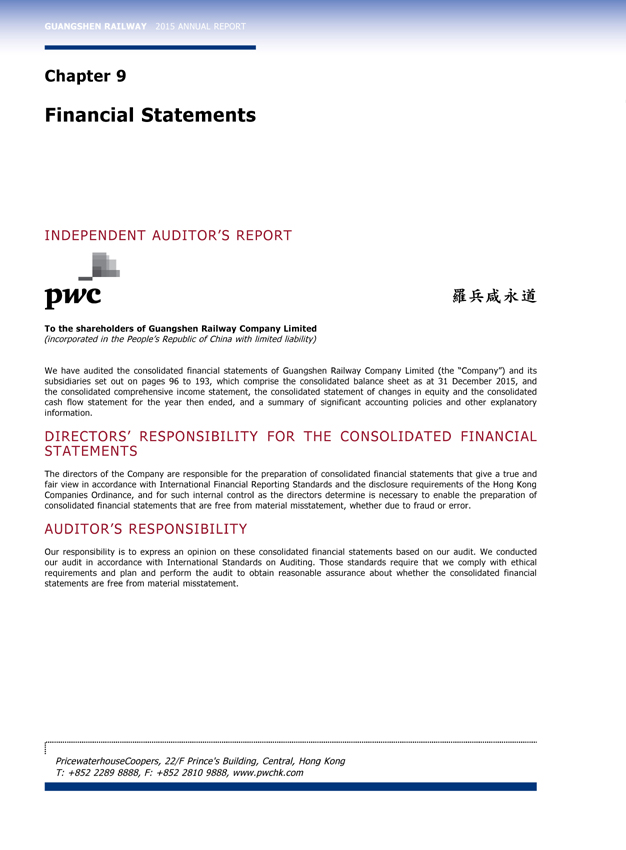
GUANGSHEN RAILWAY 2015 ANNUAL REPORT
Chapter 9
Financial Statements
INDEPENDENT AUDITOR’S REPORT
To the shareholders of Guangshen Railway Company Limited
(incorporated in the People’s Republic of China with limited liability)
We have audited the consolidated financial statements of Guangshen Railway Company Limited (the “Company”) and its subsidiaries set out on pages 96 to 193, which comprise the consolidated balance sheet as at 31 December 2015, and the consolidated comprehensive income statement, the consolidated statement of changes in equity and the consolidated cash flow statement for the year then ended, and a summary of significant accounting policies and other explanatory information.
DIRECTORS’ RESPONSIBILITY FOR THE CONSOLIDATED FINANCIAL STATEMENTS
The directors of the Company are responsible for the preparation of consolidated financial statements that give a true and fair view in accordance with International Financial Reporting Standards and the disclosure requirements of the Hong Kong Companies Ordinance, and for such internal control as the directors determine is necessary to enable the preparation of consolidated financial statements that are free from material misstatement, whether due to fraud or error.
AUDITOR’S RESPONSIBILITY
Our responsibility is to express an opinion on these consolidated financial statements based on our audit. We conducted our audit in accordance with International Standards on Auditing. Those standards require that we comply with ethical requirements and plan and perform the audit to obtain reasonable assurance about whether the consolidated financial statements are free from material misstatement.
PricewaterhouseCoopers, 22/F Prince’s Building, Central, Hong Kong T: +852 2289 8888, F: +852 2810 9888, www.pwchk.com
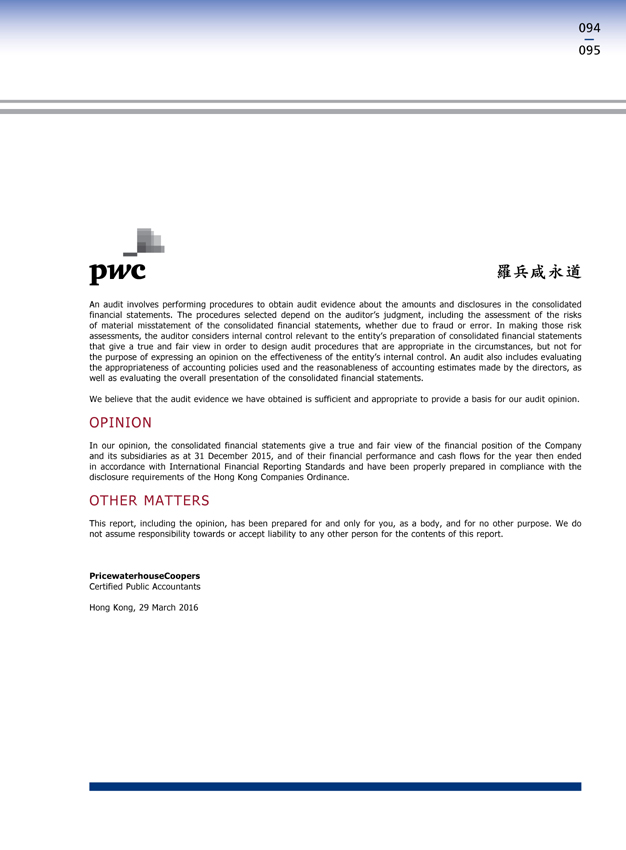
094
095
An audit involves performing procedures to obtain audit evidence about the amounts and disclosures in the consolidated financial statements. The procedures selected depend on the auditor’s judgment, including the assessment of the risks of material misstatement of the consolidated financial statements, whether due to fraud or error. In making those risk assessments, the auditor considers internal control relevant to the entity’s preparation of consolidated financial statements that give a true and fair view in order to design audit procedures that are appropriate in the circumstances, but not for the purpose of expressing an opinion on the effectiveness of the entity’s internal control. An audit also includes evaluating the appropriateness of accounting policies used and the reasonableness of accounting estimates made by the directors, as well as evaluating the overall presentation of the consolidated financial statements.
We believe that the audit evidence we have obtained is sufficient and appropriate to provide a basis for our audit opinion.
OPINION
In our opinion, the consolidated financial statements give a true and fair view of the financial position of the Company and its subsidiaries as at 31 December 2015, and of their financial performance and cash flows for the year then ended in accordance with International Financial Reporting Standards and have been properly prepared in compliance with the disclosure requirements of the Hong Kong Companies Ordinance.
OTHER MATTERS
This report, including the opinion, has been prepared for and only for you, as a body, and for no other purpose. We do not assume responsibility towards or accept liability to any other person for the contents of this report.
PricewaterhouseCoopers
Certified Public Accountants
Hong Kong, 29 March 2016
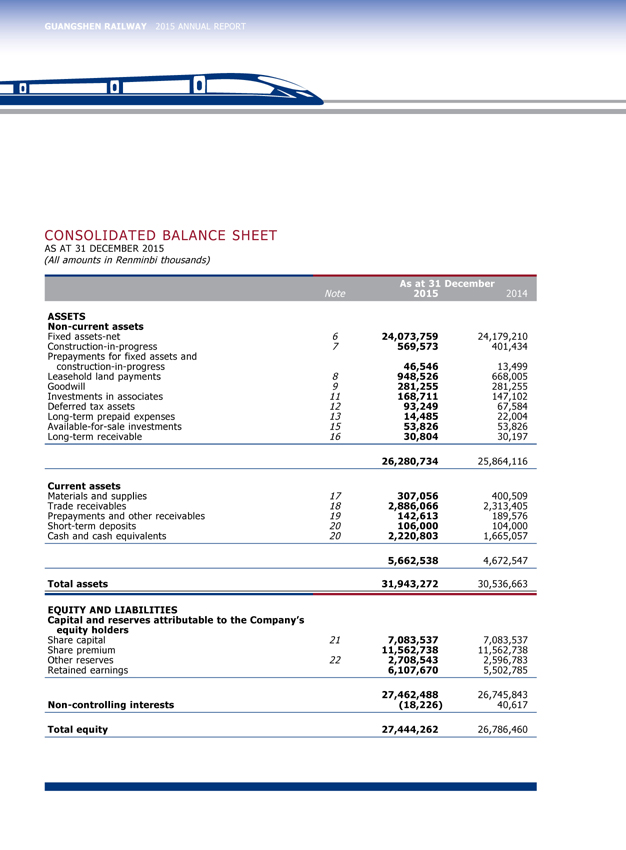
GUANGSHEN RAILWAY 2015 ANNUAL REPORT
CONSOLIDATED BALANCE SHEET
AS AT 31 DECEMBER 2015
(All amounts in Renminbi thousands)
As at 31 December
Note 2015 2014
ASSETS
Non-current assets
Fixed assets-net 6 24,073,759 24,179,210
Construction-in-progress 7 569,573 401,434
Prepayments for fixed assets and
construction-in-progress 46,546 13,499
Leasehold land payments 8 948,526 668,005
Goodwill 9 281,255 281,255
Investments in associates 11 168,711 147,102
Deferred tax assets 12 93,249 67,584
Long-term prepaid expenses 13 14,485 22,004
Available-for-sale investments 15 53,826 53,826
Long-term receivable 16 30,804 30,197
26,280,734 25,864,116
Current assets
Materials and supplies 17 307,056 400,509
Trade receivables 18 2,886,066 2,313,405
Prepayments and other receivables 19 142,613 189,576
Short-term deposits 20 106,000 104,000
Cash and cash equivalents 20 2,220,803 1,665,057
5,662,538 4,672,547
Total assets 31,943,272 30,536,663
EQUITY AND LIABILITIES
Capital and reserves attributable to the Company’s
equity holders
Share capital 21 7,083,537 7,083,537
Share premium 11,562,738 11,562,738
Other reserves 22 2,708,543 2,596,783
Retained earnings 6,107,670 5,502,785
27,462,488 26,745,843
Non-controlling interests (18,226) 40,617
Total equity 27,444,262 26,786,460
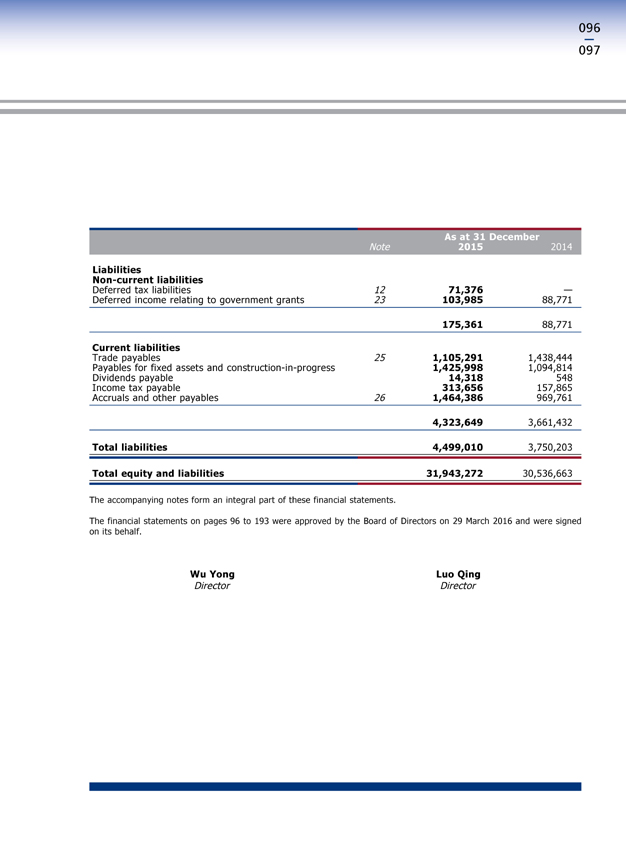
096
097
As at 31 December
Note 2015 2014
Liabilities
Non-current liabilities
Deferred tax liabilities 12 71,376 —
Deferred income relating to government grants 23 103,985 88,771
175,361 88,771
Current liabilities
Trade payables 25 1,105,291 1,438,444
Payables for fixed assets and construction-in-progress 1,425,998 1,094,814
Dividends payable 14,318 548
Income tax payable 313,656 157,865
Accruals and other payables 26 1,464,386 969,761
4,323,649 3,661,432
Total liabilities 4,499,010 3,750,203
Total equity and liabilities 31,943,272 30,536,663
The accompanying notes form an integral part of these financial statements.
The financial statements on pages 96 to 193 were approved by the Board of Directors on 29 March 2016 and were signed on its behalf.
Wu Yong Luo Qing
Director Director
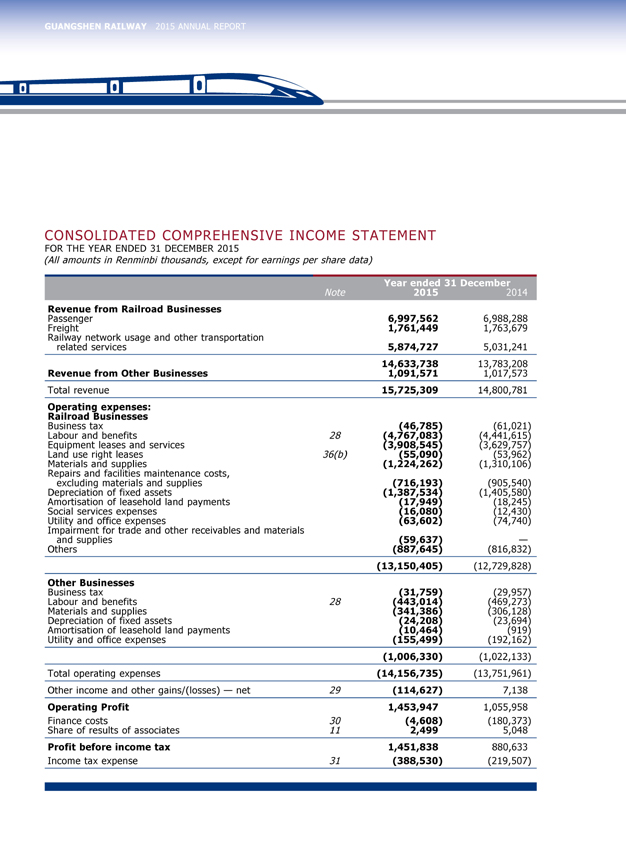
GUANGSHEN RAILWAY 2015 ANNUAL REPORT
CONSOLIDATED COMPREHENSIVE INCOME STATEMENT
FOR THE YEAR ENDED 31 DECEMBER 2015
(All amounts in Renminbi thousands, except for earnings per share data)
Year ended 31 December
Note 2015 2014
Revenue from Railroad Businesses
Passenger 6,997,562 6,988,288
Freight 1,761,449 1,763,679
Railway network usage and other transportation
related services 5,874,727 5,031,241
14,633,738 13,783,208
Revenue from Other Businesses 1,091,571 1,017,573
Total revenue 15,725,309 14,800,781
Operating expenses:
Railroad Businesses
Business tax (46,785) (61,021)
Labour and benefits 28 (4,767,083) (4,441,615)
Equipment leases and services (3,908,545) (3,629,757)
Land use right leases 36(b) (55,090) (53,962)
Materials and supplies (1,224,262) (1,310,106)
Repairs and facilities maintenance costs,
excluding materials and supplies (716,193) (905,540)
Depreciation of fixed assets (1,387,534) (1,405,580)
Amortisation of leasehold land payments (17,949) (18,245)
Social services expenses (16,080) (12,430)
Utility and office expenses (63,602) (74,740)
Impairment for trade and other receivables and materials
and supplies (59,637) —
Others (887,645) (816,832)
(13,150,405) (12,729,828)
Other Businesses
Business tax (31,759) (29,957)
Labour and benefits 28 (443,014) (469,273)
Materials and supplies (341,386) (306,128)
Depreciation of fixed assets (24,208) (23,694)
Amortisation of leasehold land payments (10,464) (919)
Utility and office expenses (155,499) (192,162)
(1,006,330) (1,022,133)
Total operating expenses (14,156,735) (13,751,961)
Other income and other gains/(losses) — net 29 (114,627) 7,138
Operating Profit 1,453,947 1,055,958
Finance costs 30 (4,608) (180,373)
Share of results of associates 11 2,499 5,048
Profit before income tax 1,451,838 880,633
Income tax expense 31 (388,530) (219,507)
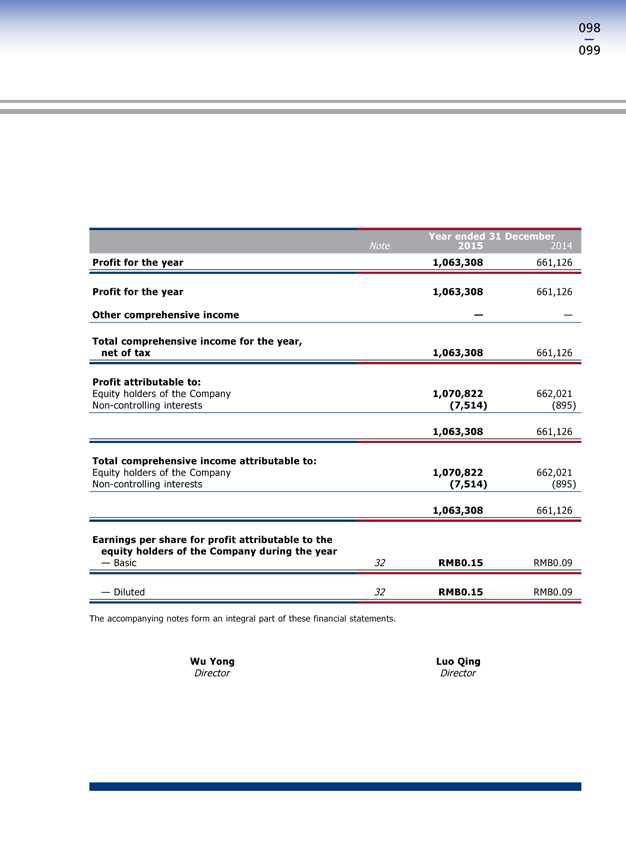
098
099
Year ended 31 December
Note 2015 2014
Profit for the year 1,063,308 661,126
Profit for the year 1,063,308 661,126
Other comprehensive income — —
Total comprehensive income for the year,
net of tax 1,063,308 661,126
Profit attributable to:
Equity holders of the Company 1,070,822 662,021
Non-controlling interests (7,514) (895)
1,063,308 661,126
Total comprehensive income attributable to:
Equity holders of the Company 1,070,822 662,021
Non-controlling interests (7,514) (895)
1,063,308 661,126
Earnings per share for profit attributable to the
equity holders of the Company during the year
— Basic 32 RMB0.15 RMB0.09
— Diluted 32 RMB0.15 RMB0.09
The accompanying notes form an integral part of these financial statements.
Wu Yong Luo Qing
Director Director
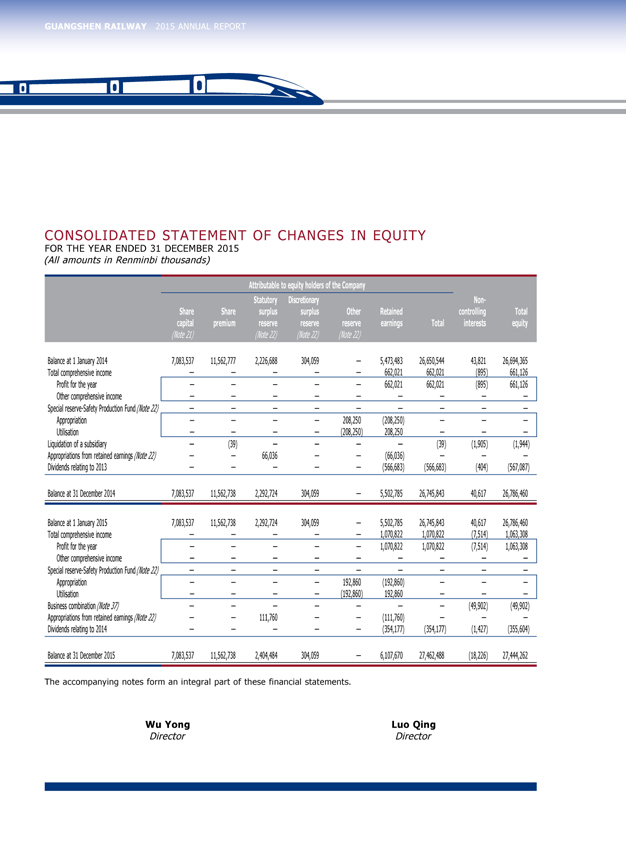
GUANGSHEN RAILWAY 2015 ANNUAL REPORT
CONSOLIDATED STATEMENT OF CHANGES IN EQUITY
FOR THE YEAR ENDED 31 DECEMBER 2015
(All amounts in Renminbi thousands)
Attributable to equity holders of the Company
Statutory Discretionary Non-
Share Share surplus surplus Other Retained controlling Total
capital premium reserve reserve reserve earnings Total interests equity
(Note 21) (Note 22) (Note 22) (Note 22)
Balance at 1 January 2014 7,083,537 11,562,777 2,226,688 304,059 — 5,473,483 26,650,544 43,821 26,694,365
Total comprehensive income — — — — — 662,021 662,021 (895) 661,126
Profit for the year — — — — — 662,021 662,021 (895) 661,126
Other comprehensive income — — — — — — — — —
Special reserve-Safety Production Fund (Note 22) — — — — — — — — —
Appropriation — — — — 208,250 (208,250) — — —
Utilisation — — — — (208,250) 208,250 — — —
Liquidation of a subsidiary — (39) — — — — (39) (1,905) (1,944)
Appropriations from retained earnings (Note 22) — — 66,036 — — (66,036) — — —
Dividends relating to 2013 — — — — — (566,683) (566,683) (404) (567,087)
Balance at 31 December 2014 7,083,537 11,562,738 2,292,724 304,059 — 5,502,785 26,745,843 40,617 26,786,460
Balance at 1 January 2015 7,083,537 11,562,738 2,292,724 304,059 — 5,502,785 26,745,843 40,617 26,786,460
Total comprehensive income — — — — — 1,070,822 1,070,822 (7,514) 1,063,308
Profit for the year — — — — — 1,070,822 1,070,822 (7,514) 1,063,308
Other comprehensive income — — — — — — — — —
Special reserve-Safety Production Fund (Note 22) — — — — — — — — —
Appropriation — — — — 192,860 (192,860) — — —
Utilisation — — — — (192,860) 192,860 — — —
Business combination (Note 37) — — — — — — — (49,902) (49,902)
Appropriations from retained earnings (Note 22) — — 111,760 — — (111,760) — — —
Dividends relating to 2014 — — — — — (354,177) (354,177) (1,427) (355,604)
Balance at 31 December 2015 7,083,537 11,562,738 2,404,484 304,059 — 6,107,670 27,462,488 (18,226) 27,444,262
The accompanying notes form an integral part of these financial statements.
Wu Yong Luo Qing
Director Director
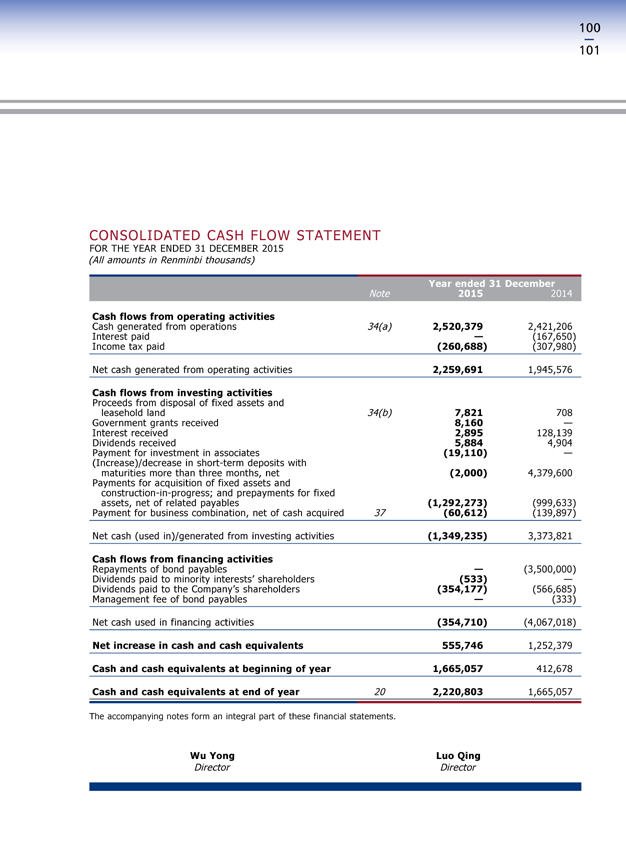
100
101
CONSOLIDATED CASH FLOW STATEMENT
FOR THE YEAR ENDED 31 DECEMBER 2015
(All amounts in Renminbi thousands)
Year ended 31 December
Note 2015 2014
Cash flows from operating activities
Cash generated from operations 34(a) 2,520,379 2,421,206
Interest paid — (167,650)
Income tax paid (260,688) (307,980)
Net cash generated from operating activities 2,259,691 1,945,576
Cash flows from investing activities
Proceeds from disposal of fixed assets and
leasehold land 34(b) 7,821 708
Government grants received 8,160 —
Interest received 2,895 128,139
Dividends received 5,884 4,904
Payment for investment in associates (19,110) —
(Increase)/decrease in short-term deposits with
maturities more than three months, net (2,000) 4,379,600
Payments for acquisition of fixed assets and
construction-in-progress; and prepayments for fixed
assets, net of related payables (1,292,273) (999,633)
Payment for business combination, net of cash acquired 37 (60,612) (139,897)
Net cash (used in)/generated from investing activities (1,349,235) 3,373,821
Cash flows from financing activities
Repayments of bond payables — (3,500,000)
Dividends paid to minority interests’ shareholders (533) —
Dividends paid to the Company’s shareholders (354,177) (566,685)
Management fee of bond payables — (333)
Net cash used in financing activities (354,710) (4,067,018)
Net increase in cash and cash equivalents 555,746 1,252,379
Cash and cash equivalents at beginning of year 1,665,057 412,678
Cash and cash equivalents at end of year 20 2,220,803 1,665,057
The accompanying notes form an integral part of these financial statements.
Wu Yong Luo Qing
Director Director
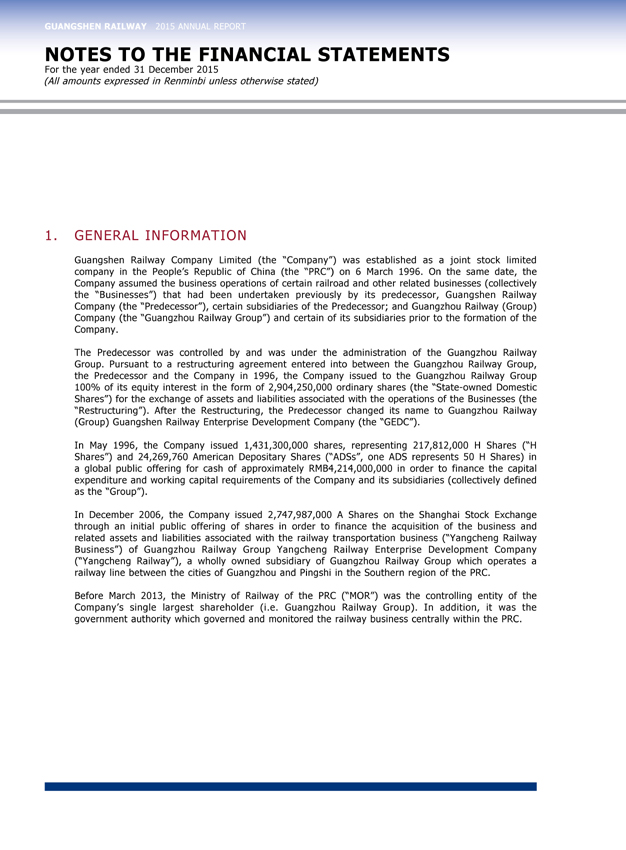
GUANGSHEN RAILWAY 2015 ANNUAL REPORT
NOTES TO THE FINANCIAL STATEMENTS
For the year ended 31 December 2015
(All amounts expressed in Renminbi unless otherwise stated)
1. GENERAL INFORMATION
Guangshen Railway Company Limited (the “Company”) was established as a joint stock limited company in the People’s Republic of China (the “PRC”) on 6 March 1996. On the same date, the Company assumed the business operations of certain railroad and other related businesses (collectively the “Businesses”) that had been undertaken previously by its predecessor, Guangshen Railway Company (the “Predecessor”), certain subsidiaries of the Predecessor; and Guangzhou Railway (Group) Company (the “Guangzhou Railway Group”) and certain of its subsidiaries prior to the formation of the Company.
The Predecessor was controlled by and was under the administration of the Guangzhou Railway Group. Pursuant to a restructuring agreement entered into between the Guangzhou Railway Group, the Predecessor and the Company in 1996, the Company issued to the Guangzhou Railway Group 100% of its equity interest in the form of 2,904,250,000 ordinary shares (the “State-owned Domestic Shares”) for the exchange of assets and liabilities associated with the operations of the Businesses (the “Restructuring”). After the Restructuring, the Predecessor changed its name to Guangzhou Railway (Group) Guangshen Railway Enterprise Development Company (the “GEDC”).
In May 1996, the Company issued 1,431,300,000 shares, representing 217,812,000 H Shares (“H Shares”) and 24,269,760 American Depositary Shares (“ADSs”, one ADS represents 50 H Shares) in a global public offering for cash of approximately RMB4,214,000,000 in order to finance the capital expenditure and working capital requirements of the Company and its subsidiaries (collectively defined as the “Group”).
In December 2006, the Company issued 2,747,987,000 A Shares on the Shanghai Stock Exchange through an initial public offering of shares in order to finance the acquisition of the business and related assets and liabilities associated with the railway transportation business (“Yangcheng Railway Business”) of Guangzhou Railway Group Yangcheng Railway Enterprise Development Company (“Yangcheng Railway”), a wholly owned subsidiary of Guangzhou Railway Group which operates a railway line between the cities of Guangzhou and Pingshi in the Southern region of the PRC.
Before March 2013, the Ministry of Railway of the PRC (“MOR”) was the controlling entity of the Company’s single largest shareholder (i.e. Guangzhou Railway Group). In addition, it was the government authority which governed and monitored the railway business centrally within the PRC.
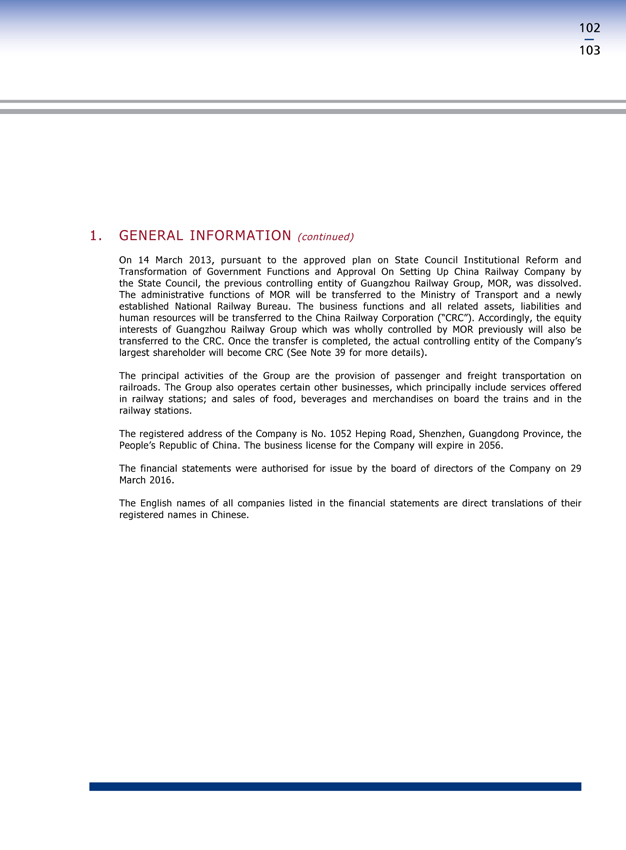
102
103
1. GENERAL INFORMATION (continued)
On 14 March 2013, pursuant to the approved plan on State Council Institutional Reform and Transformation of Government Functions and Approval On Setting Up China Railway Company by the State Council, the previous controlling entity of Guangzhou Railway Group, MOR, was dissolved. The administrative functions of MOR will be transferred to the Ministry of Transport and a newly established National Railway Bureau. The business functions and all related assets, liabilities and human resources will be transferred to the China Railway Corporation (“CRC”). Accordingly, the equity interests of Guangzhou Railway Group which was wholly controlled by MOR previously will also be transferred to the CRC. Once the transfer is completed, the actual controlling entity of the Company’s largest shareholder will become CRC (See Note 39 for more details).
The principal activities of the Group are the provision of passenger and freight transportation on railroads. The Group also operates certain other businesses, which principally include services offered in railway stations; and sales of food, beverages and merchandises on board the trains and in the railway stations.
The registered address of the Company is No. 1052 Heping Road, Shenzhen, Guangdong Province, the People’s Republic of China. The business license for the Company will expire in 2056.
The financial statements were authorised for issue by the board of directors of the Company on 29 March 2016.
The English names of all companies listed in the financial statements are direct translations of their registered names in Chinese.
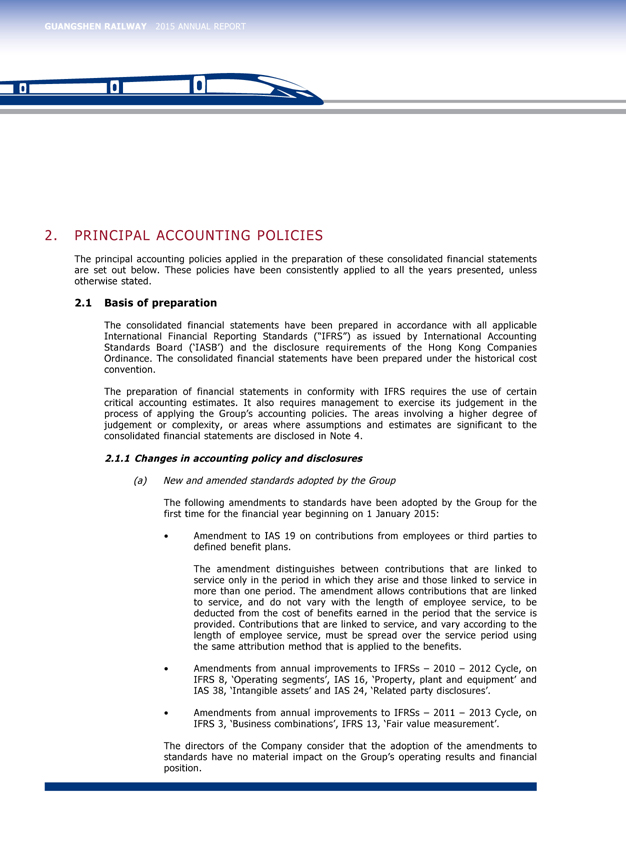
GUANGSHEN RAILWAY 2015 ANNUAL REPORT
2. PRINCIPAL ACCOUNTING POLICIES
The principal accounting policies applied in the preparation of these consolidated financial statements
are set out below. These policies have been consistently applied to all the years presented, unless
otherwise stated.
2.1 Basis of preparation
The consolidated financial statements have been prepared in accordance with all applicable
International Financial Reporting Standards (“IFRS”) as issued by International Accounting
Standards Board (‘IASB’) and the disclosure requirements of the Hong Kong Companies
Ordinance. The consolidated financial statements have been prepared under the historical cost
convention.
The preparation of financial statements in conformity with IFRS requires the use of certain
critical accounting estimates. It also requires management to exercise its judgement in the
process of applying the Group’s accounting policies. The areas involving a higher degree of
judgement or complexity, or areas where assumptions and estimates are significant to the
consolidated financial statements are disclosed in Note 4.
2.1.1 Changes in accounting policy and disclosures
(a) |
| New and amended standards adopted by the Group |
The following amendments to standards have been adopted by the Group for the
first time for the financial year beginning on 1 January 2015:
• AmendmenttoIAS19oncontributionsfromemployeesorthirdpartiesto
defined benefit plans.
The amendment distinguishes between contributions that are linked to
service only in the period in which they arise and those linked to service in
more than one period. The amendment allows contributions that are linked
to service, and do not vary with the length of employee service, to be
deducted from the cost of benefits earned in the period that the service is
provided. Contributions that are linked to service, and vary according to the
length of employee service, must be spread over the service period using
the same attribution method that is applied to the benefits.
• AmendmentsfromannualimprovementstoIFRSs –2010 –2012Cycle,on
IFRS 8, ‘Operating segments’, IAS 16, ‘Property, plant and equipment’ and
IAS 38, ‘Intangible assets’ and IAS 24, ‘Related party disclosures’.
• AmendmentsfromannualimprovementstoIFRSs –2011 –2013Cycle,on
IFRS 3, ‘Business combinations’, IFRS 13, ‘Fair value measurement’.
The directors of the Company consider that the adoption of the amendments to
standards have no material impact on the Group’s operating results and financial
position.

104
105
2. PRINCIPAL ACCOUNTING POLICIES (continued)
2.1 Basis of preparation (continued)
2.1.1 Changes in accounting policy and disclosures (continued)
(b) |
| New Hong Kong Companies Ordinance (Cap. 622) |
In addition, the requirements of Part 9 “Accounts and Audit” of the new Hong
Kong Companies Ordinance (Cap. 622) come into operation during the financial
year, as a result, there are changes to presentation and disclosures of certain
information in the consolidated financial statements.
(c) |
| The following new standards, amendments and interpretations have been issued |
as at 31 December 2015 but are not effective for IFRS financial statements for the
year ended 31 December 2015:
• Amendment to IFRS 11 “Accounting for acquisitions of interests in joint
operations”. The amendment requires an investor to apply the principles
of business combination accounting when it acquires an interest in a joint
operation that constitutes a business (as defined in IFRS 3, Business
combinations). Specifically, an investor will need to: measure identifiable
assets and liabilities at fair value; expense acquisition-related costs;
recognise deferred tax; and recognise the residual as goodwill. All other
principles of business combination accounting apply unless they conflict with
IFRS 11. The amendment is applicable to both the acquisition of the initial
interest and a further interest in a joint operation. The previously held
interest is not remeasured when the acquisition of an additional interest in
the same joint operation with joint control maintained. This amendment will
be effective for annual periods beginning on or after 1 January 2016.
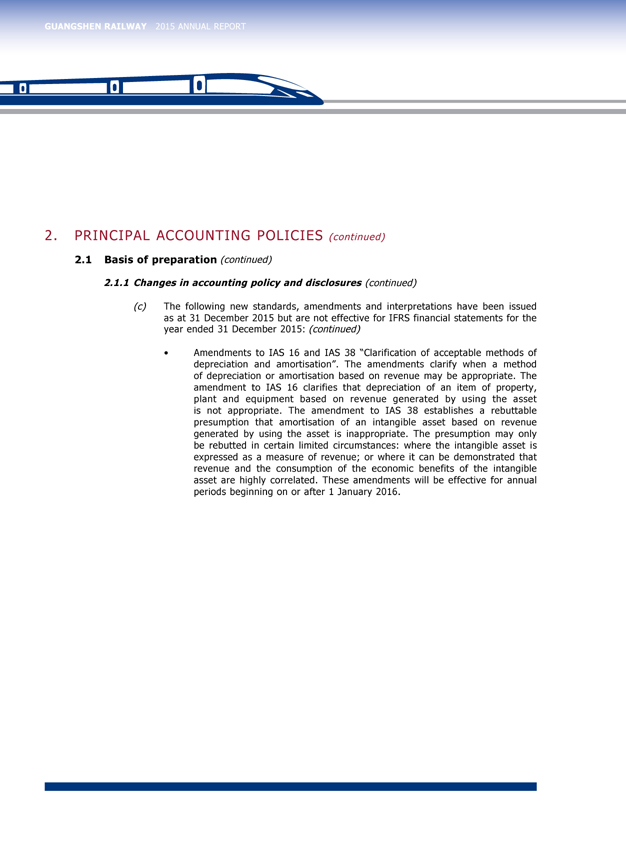
GUANGSHEN RAILWAY 2015 ANNUAL REPORT
2. PRINCIPAL ACCOUNTING POLICIES (continued)
2.1 Basis of preparation (continued)
2.1.1 Changes in accounting policy and disclosures (continued)
(c) The following new standards, amendments and interpretations have been issued as at 31 December 2015 but are not effective for IFRS financial statements for the year ended 31 December 2015: (continued)
• |
| AmendmentstoIAS16andIAS38“Clarificationofacceptablemethodsof depreciation and amortisation”. The amendments clarify when a method of depreciation or amortisation based on revenue may be appropriate. The amendment to IAS 16 clarifies that depreciation of an item of property, plant and equipment based on revenue generated by using the asset is not appropriate. The amendment to IAS 38 establishes a rebuttable presumption that amortisation of an intangible asset based on revenue generated by using the asset is inappropriate. The presumption may only be rebutted in certain limited circumstances: where the intangible asset is expressed as a measure of revenue; or where it can be demonstrated that revenue and the consumption of the economic benefits of the intangible asset are highly correlated. These amendments will be effective for annual periods beginning on or after 1 January 2016. |
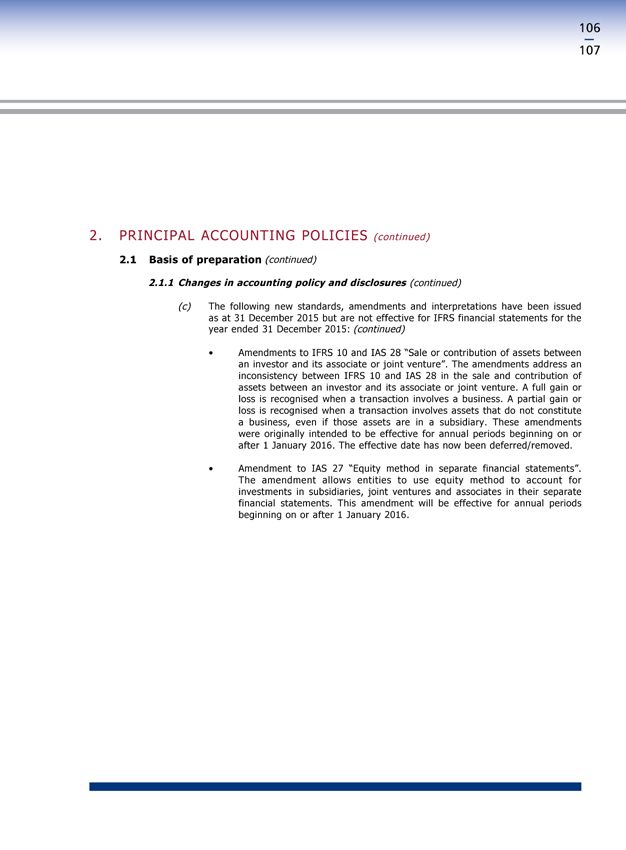
106
107
2. PRINCIPAL ACCOUNTING POLICIES (continued)
2.1 Basis of preparation (continued)
2.1.1 Changes in accounting policy and disclosures (continued)
(c) |
| The following new standards, amendments and interpretations have been issued |
as at 31 December 2015 but are not effective for IFRS financial statements for the
year ended 31 December 2015: (continued)
• AmendmentstoIFRS10andIAS28“Saleorcontributionofassetsbetween
an investor and its associate or joint venture”. The amendments address an
inconsistency between IFRS 10 and IAS 28 in the sale and contribution of
assets between an investor and its associate or joint venture. A full gain or
loss is recognised when a transaction involves a business. A partial gain or
loss is recognised when a transaction involves assets that do not constitute
a business, even if those assets are in a subsidiary. These amendments
were originally intended to be effective for annual periods beginning on or
after 1 January 2016. The effective date has now been deferred/removed.
• Amendment to IAS 27 “Equity method in separate financial statements”.
The amendment allows entities to use equity method to account for
investments in subsidiaries, joint ventures and associates in their separate
financial statements. This amendment will be effective for annual periods
beginning on or after 1 January 2016.

GUANGSHEN RAILWAY 2015 ANNUAL REPORT
2. PRINCIPAL ACCOUNTING POLICIES (continued)
2.1 Basis of preparation (continued)
2.1.1 Changes in accounting policy and disclosures (continued)
(c) |
| The following new standards, amendments and interpretations have been issued |
as at 31 December 2015 but are not effective for IFRS financial statements for the
year ended 31 December 2015: (continued)
• AmendmentstoIFRS10,IFRS12andIAS28“Investmententities:applying
the consolidation exception”. The amendments clarify the application of
the consolidation exception for investment entities and their subsidiaries.
The amendments to IFRS 10 clarify that the exception from preparing
consolidated financial statements is available to intermediate parent
entities which are subsidiaries of investment entities. The exception is
available when the investment entity parent measures its subsidiaries at
fair value. The intermediate parent would also need to meet the other
criteria for exception listed in IFRS 10. The amendments also clarify that
an investment entity should consolidate a subsidiary which is not an
investment entity and which provides services in support of the investment
entity’s investment activities, such that it acts as an extension of the
investment entity. However, the amendments also confirm that if the
subsidiary is itself an investment entity, the investment entity parent
should measure its investment in the subsidiary at fair value through profit
or loss. This approach is required regardless of whether the subsidiary
provides investment-related services to the parent or to third parties.
The amendments to IAS 28 allow an entity which is not an investment
entity, but has an interest in an associate or a joint venture which is an
investment entity, a relief to retain the fair value measurement applied
by the investment entity associate or joint venture, or to unwind the fair
value measurement and instead perform a consolidation at the level of
the investment entity associate or joint venture for their subsidiaries when
applying the equity method. These amendments will be effective for annual
periods beginning on or after 1 January 2016.
• Annual improvements 2014. The amendments include changes from
the 2012-2014 cycle of the annual improvements project that affect 4
standards: IFRS 5, “Non-current assets held for sale and discontinued
operations”, IFRS 7, “Financial instruments: Disclosures”, IAS 19, “Employee
benefits”, and IAS 34, “Interim financial reporting”. These amendments will
be effective for annual periods beginning on or after 1 January 2016.
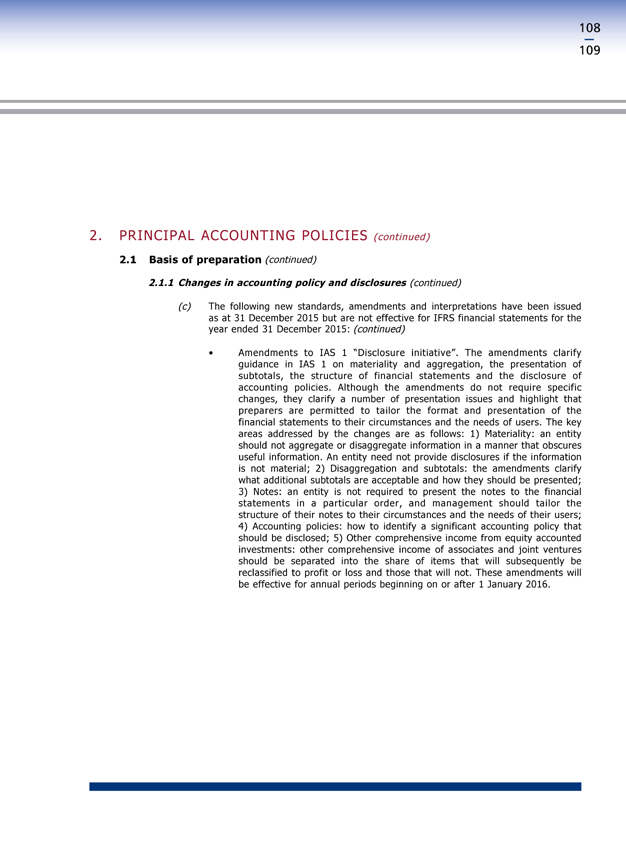
108
109
2. PRINCIPAL ACCOUNTING POLICIES (continued)
2.1 Basis of preparation (continued)
2.1.1 Changes in accounting policy and disclosures (continued)
(c) |
| The following new standards, amendments and interpretations have been issued |
as at 31 December 2015 but are not effective for IFRS financial statements for the
year ended 31 December 2015: (continued)
• Amendments to IAS 1 “Disclosure initiative”. The amendments clarify
guidance in IAS 1 on materiality and aggregation, the presentation of
subtotals, the structure of financial statements and the disclosure of
accounting policies. Although the amendments do not require specific
changes, they clarify a number of presentation issues and highlight that
preparers are permitted to tailor the format and presentation of the
financial statements to their circumstances and the needs of users. The key
areas addressed by the changes are as follows: 1) Materiality: an entity
should not aggregate or disaggregate information in a manner that obscures
useful information. An entity need not provide disclosures if the information
is not material; 2) Disaggregation and subtotals: the amendments clarify
what additional subtotals are acceptable and how they should be presented;
3) Notes: an entity is not required to present the notes to the financial
statements in a particular order, and management should tailor the
structure of their notes to their circumstances and the needs of their users;
4) Accounting policies: how to identify a significant accounting policy that
should be disclosed; 5) Other comprehensive income from equity accounted
investments: other comprehensive income of associates and joint ventures
should be separated into the share of items that will subsequently be
reclassified to profit or loss and those that will not. These amendments will
be effective for annual periods beginning on or after 1 January 2016.
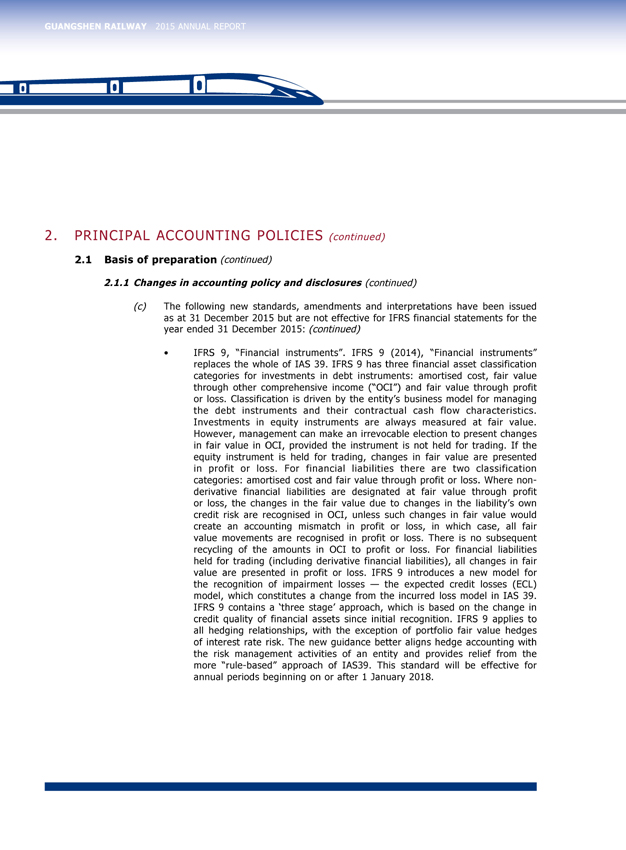
GUANGSHEN RAILWAY 2015 ANNUAL REPORT
2. PRINCIPAL ACCOUNTING POLICIES (continued)
2.1 Basis of preparation (continued)
2.1.1 Changes in accounting policy and disclosures (continued)
(c) |
| The following new standards, amendments and interpretations have been issued |
as at 31 December 2015 but are not effective for IFRS financial statements for the
year ended 31 December 2015: (continued)
• IFRS 9, “Financial instruments”. IFRS 9 (2014), “Financial instruments”
replaces the whole of IAS 39. IFRS 9 has three financial asset classification
categories for investments in debt instruments: amortised cost, fair value
through other comprehensive income (“OCI”) and fair value through profit
or loss. Classification is driven by the entity’s business model for managing
the debt instruments and their contractual cash flow characteristics.
Investments in equity instruments are always measured at fair value.
However, management can make an irrevocable election to present changes
in fair value in OCI, provided the instrument is not held for trading. If the
equity instrument is held for trading, changes in fair value are presented
in profit or loss. For financial liabilities there are two classification
categories: amortised cost and fair value through profit or loss. Where non-
derivative financial liabilities are designated at fair value through profit
or loss, the changes in the fair value due to changes in the liability’s own
credit risk are recognised in OCI, unless such changes in fair value would
create an accounting mismatch in profit or loss, in which case, all fair
value movements are recognised in profit or loss. There is no subsequent
recycling of the amounts in OCI to profit or loss. For financial liabilities
held for trading (including derivative financial liabilities), all changes in fair
value are presented in profit or loss. IFRS 9 introduces a new model for
the recognition of impairment losses — the expected credit losses (ECL)
model, which constitutes a change from the incurred loss model in IAS 39.
IFRS 9 contains a ‘three stage’ approach, which is based on the change in
credit quality of financial assets since initial recognition. IFRS 9 applies to
all hedging relationships, with the exception of portfolio fair value hedges
of interest rate risk. The new guidance better aligns hedge accounting with
the risk management activities of an entity and provides relief from the
more “rule-based” approach of IAS39. This standard will be effective for
annual periods beginning on or after 1 January 2018.
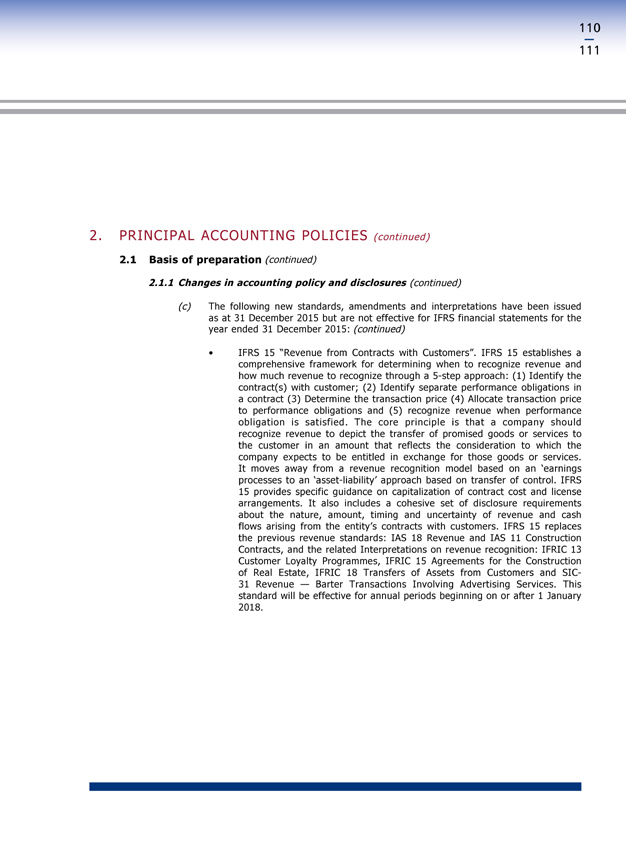
110
111
2. PRINCIPAL ACCOUNTING POLICIES (continued)
2.1 Basis of preparation (continued)
2.1.1 Changes in accounting policy and disclosures (continued)
(c) The following new standards, amendments and interpretations have been issued as at 31 December 2015 but are not effective for IFRS financial statements for the year ended 31 December 2015: (continued)
• |
| IFRS15“RevenuefromContractswithCustomers”.IFRS15establishesa comprehensive framework for determining when to recognize revenue and how much revenue to recognize through a 5-step approach: (1) Identify the contract(s) with customer; (2) Identify separate performance obligations in a contract (3) Determine the transaction price (4) Allocate transaction price to performance obligations and (5) recognize revenue when performance obligation is satisfied. The core principle is that a company should recognize revenue to depict the transfer of promised goods or services to the customer in an amount that reflects the consideration to which the company expects to be entitled in exchange for those goods or services. It moves away from a revenue recognition model based on an ‘earnings processes to an ‘asset-liability’ approach based on transfer of control. IFRS 15 provides specific guidance on capitalization of contract cost and license arrangements. It also includes a cohesive set of disclosure requirements about the nature, amount, timing and uncertainty of revenue and cash flows arising from the entity’s contracts with customers. IFRS 15 replaces the previous revenue standards: IAS 18 Revenue and IAS 11 Construction Contracts, and the related Interpretations on revenue recognition: IFRIC 13 Customer Loyalty Programmes, IFRIC 15 Agreements for the Construction of Real Estate, IFRIC 18 Transfers of Assets from Customers and SIC- |
31 Revenue — Barter Transactions Involving Advertising Services. This standard will be effective for annual periods beginning on or after 1 January 2018.
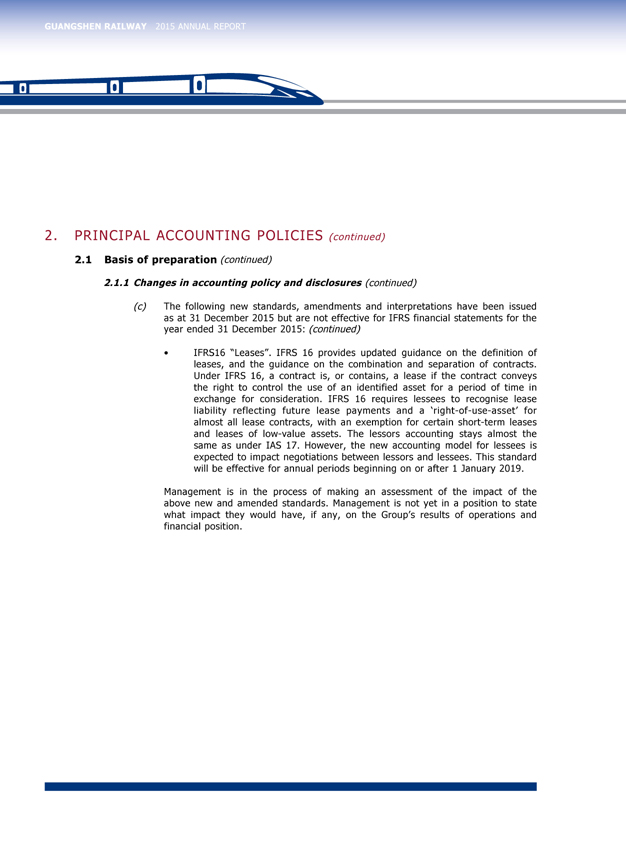
GUANGSHEN RAILWAY 2015 ANNUAL REPORT
2. PRINCIPAL ACCOUNTING POLICIES (continued)
2.1 Basis of preparation (continued)
2.1.1 Changes in accounting policy and disclosures (continued)
(c) The following new standards, amendments and interpretations have been issued as at 31 December 2015 but are not effective for IFRS financial statements for the year ended 31 December 2015: (continued)
• |
| IFRS16“Leases”.IFRS16providesupdatedguidanceonthedefinitionof leases, and the guidance on the combination and separation of contracts. Under IFRS 16, a contract is, or contains, a lease if the contract conveys the right to control the use of an identified asset for a period of time in exchange for consideration. IFRS 16 requires lessees to recognise lease liability reflecting future lease payments and a ‘right-of-use-asset’ for almost all lease contracts, with an exemption for certain short-term leases and leases of low-value assets. The lessors accounting stays almost the same as under IAS 17. However, the new accounting model for lessees is expected to impact negotiations between lessors and lessees. This standard will be effective for annual periods beginning on or after 1 January 2019. |
Management is in the process of making an assessment of the impact of the above new and amended standards. Management is not yet in a position to state what impact they would have, if any, on the Group’s results of operations and financial position.
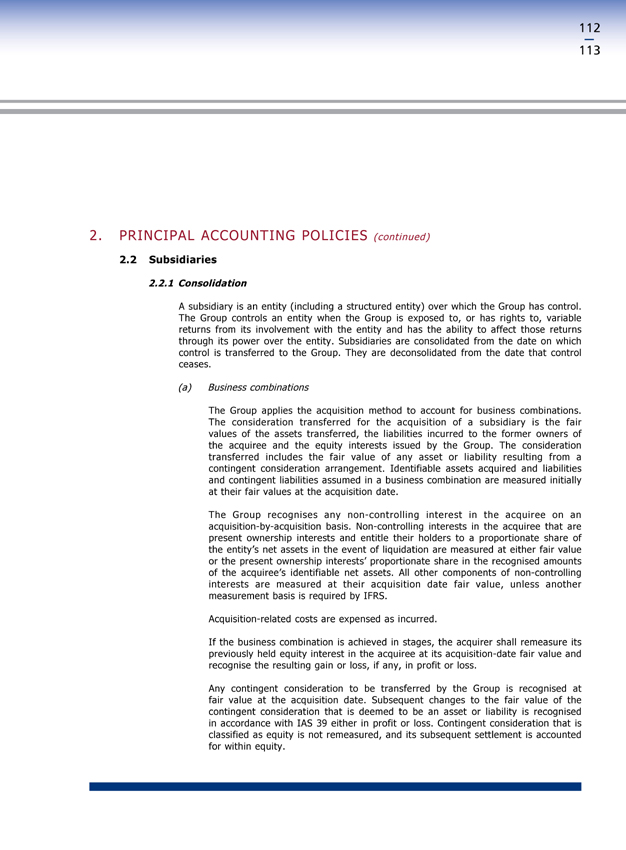
112
113
PRINCIPAL ACCOUNTING POLICIES (continued)
2.2 Subsidiaries
2.2.1
Consolidation
A subsidiary is an entity (including a structured entity) over which the Group has control.
The Group controls an entity when the Group is exposed to, or has rights to, variable returns from its involvement with the entity and has the ability to affect those returns through its power over the entity. Subsidiaries are consolidated from the date on which control is transferred to the Group. They are deconsolidated from the date that control ceases.
(a) |
| Business combinations |
The Group applies the acquisition method to account for business combinations. The consideration transferred for the acquisition of a subsidiary is the fair values of the assets transferred, the liabilities incurred to the former owners of the acquiree and the equity interests issued by the Group. The consideration transferred includes the fair value of any asset or liability resulting from a contingent consideration arrangement. Identifiable assets acquired and liabilities and contingent liabilities assumed in a business combination are measured initially at their fair values at the acquisition date.
The Group recognises any non -controlling interest in the acquiree on an acquisition-by-acquisition basis. Non-controlling interests in the acquiree that are present ownership interests and entitle their holders to a proportionate share of the entity’s net assets in the event of liquidation are measured at either fair value or the present ownership interests’ proportionate share in the recognised amounts of the acquiree’s identifiable net assets. All other components of non-controlling interests are measured at their acquisition date fair value, unless another measurement basis is required by IFRS.
Acquisition-related costs are expensed as incurred.
If the business combination is achieved in stages, the acquirer shall remeasure its previously held equity interest in the acquiree at its acquisition-date fair value and recognise the resulting gain or loss, if any, in profit or loss.
Any contingent consideration to be transferred by the Group is recognised at fair value at the acquisition date. Subsequent changes to the fair value of the contingent consideration that is deemed to be an asset or liability is recognised in accordance with IAS 39 either in profit or loss. Contingent consideration that is classified as equity is not remeasured, and its subsequent settlement is accounted for within equity.
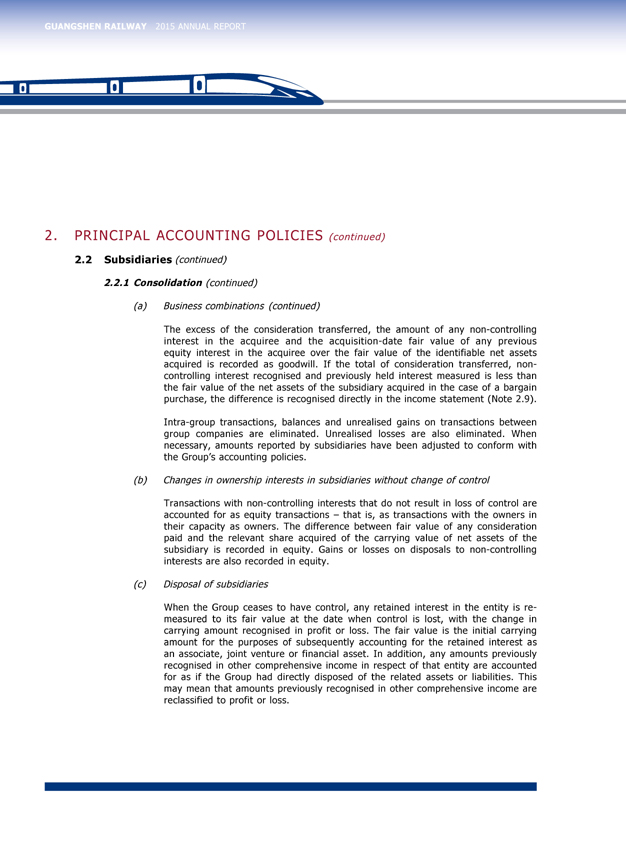
GUANGSHEN RAILWAY 2015 ANNUAL REPORT
PRINCIPAL ACCOUNTING POLICIES (continued)
2.2
Subsidiaries (continued)
2.2.1
Consolidation (continued)
(a) |
| Business combinations (continued) |
The excess of the consideration transferred, the amount of any non-controlling interest in the acquiree and the acquisition-date fair value of any previous equity interest in the acquiree over the fair value of the identifiable net assets acquired is recorded as goodwill. If the total of consideration transferred, non- controlling interest recognised and previously held interest measured is less than the fair value of the net assets of the subsidiary acquired in the case of a bargain purchase, the difference is recognised directly in the income statement (Note 2.9).
Intra-group transactions, balances and unrealised gains on transactions between group companies are eliminated. Unrealised losses are also eliminated. When necessary, amounts reported by subsidiaries have been adjusted to conform with the Group’s accounting policies.
(b) |
| Changes in ownership interests in subsidiaries without change of control |
Transactions with non-controlling interests that do not result in loss of control are accounted for as equity transactions – that is, as transactions with the owners in their capacity as owners. The difference between fair value of any consideration paid and the relevant share acquired of the carrying value of net assets of the subsidiary is recorded in equity. Gains or losses on disposals to non-controlling interests are also recorded in equity.
(c) |
| Disposal of subsidiaries |
When the Group ceases to have control, any retained interest in the entity is re- measured to its fair value at the date when control is lost, with the change in carrying amount recognised in profit or loss. The fair value is the initial carrying amount for the purposes of subsequently accounting for the retained interest as an associate, joint venture or financial asset. In addition, any amounts previously recognised in other comprehensive income in respect of that entity are accounted for as if the Group had directly disposed of the related assets or liabilities. This may mean that amounts previously recognised in other comprehensive income are reclassified to profit or loss.
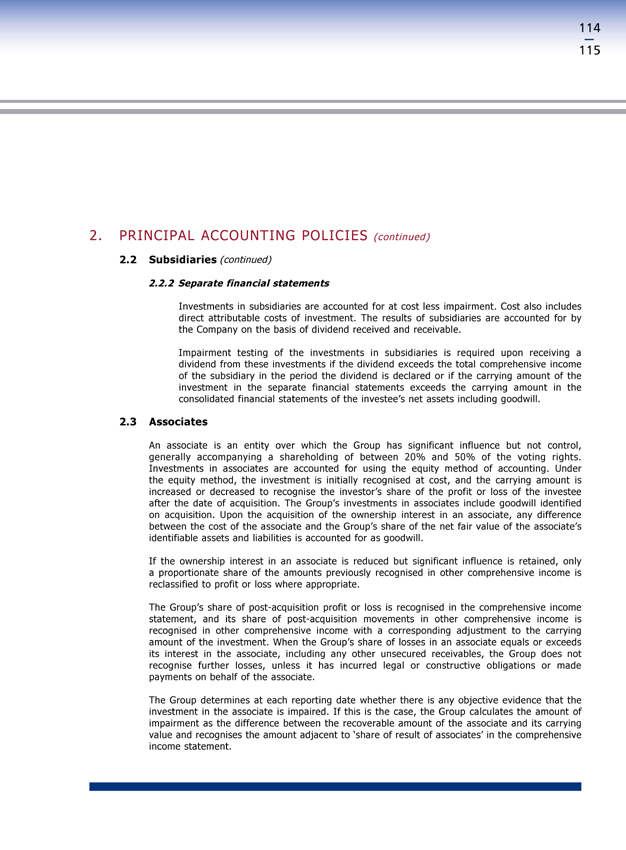
114
115
2. PRINCIPAL ACCOUNTING POLICIES (continued)
2.2 Subsidiaries (continued)
2.2.2 Separate financial statements
Investments in subsidiaries are accounted for at cost less impairment. Cost also includes direct attributable costs of investment. The results of subsidiaries are accounted for by the Company on the basis of dividend received and receivable.
Impairment testing of the investments in subsidiaries is required upon receiving a dividend from these investments if the dividend exceeds the total comprehensive income of the subsidiary in the period the dividend is declared or if the carrying amount of the investment in the separate financial statements exceeds the carrying amount in the consolidated financial statements of the investee’s net assets including goodwill.
2.3 Associates
An associate is an entity over which the Group has significant influence but not control, generally accompanying a shareholding of between 20% and 50% of the voting rights. Investments in associates are accounted for using the equity method of accounting. Under the equity method, the investment is initially recognised at cost, and the carrying amount is increased or decreased to recognise the investor’s share of the profit or loss of the investee after the date of acquisition. The Group’s investments in associates include goodwill identified on acquisition. Upon the acquisition of the ownership interest in an associate, any difference between the cost of the associate and the Group’s share of the net fair value of the associate’s identifiable assets and liabilities is accounted for as goodwill.
If the ownership interest in an associate is reduced but significant influence is retained, only a proportionate share of the amounts previously recognised in other comprehensive income is reclassified to profit or loss where appropriate.
The Group’s share of post-acquisition profit or loss is recognised in the comprehensive income statement, and its share of post-acquisition movements in other comprehensive income is recognised in other comprehensive income with a corresponding adjustment to the carrying amount of the investment. When the Group’s share of losses in an associate equals or exceeds its interest in the associate, including any other unsecured receivables, the Group does not recognise further losses, unless it has incurred legal or constructive obligations or made payments on behalf of the associate.
The Group determines at each reporting date whether there is any objective evidence that the investment in the associate is impaired. If this is the case, the Group calculates the amount of impairment as the difference between the recoverable amount of the associate and its carrying value and recognises the amount adjacent to ‘share of result of associates’ in the comprehensive income statement.
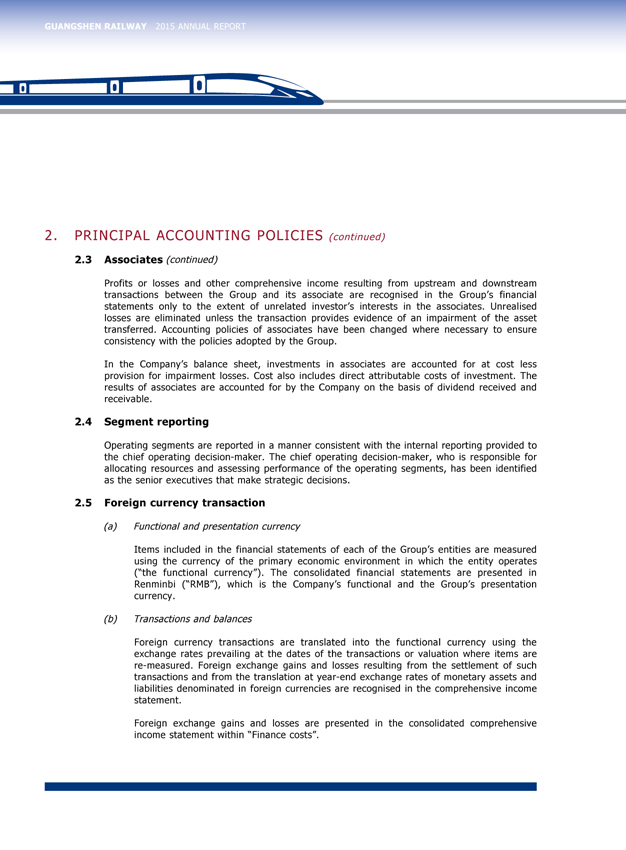
GUANGSHEN RAILWAY 2015 ANNUAL REPORT
PRINCIPAL ACCOUNTING POLICIES (continued)
2.3 Associates (continued)
Profits or losses and other comprehensive income resulting from upstream and downstream transactions between the Group and its associate are recognised in the Group’s financial statements only to the extent of unrelated investor’s interests in the associates. Unrealised losses are eliminated unless the transaction provides evidence of an impairment of the asset transferred. Accounting policies of associates have been changed where necessary to ensure consistency with the policies adopted by the Group.
In the Company’s balance sheet, investments in associates are accounted for at cost less provision for impairment losses. Cost also includes direct attributable costs of investment. The results of associates are accounted for by the Company on the basis of dividend received and receivable.
2.4 Segment reporting
Operating segments are reported in a manner consistent with the internal reporting provided to the chief operating decision-maker. The chief operating decision-maker, who is responsible for allocating resources and assessing performance of the operating segments, has been identified as the senior executives that make strategic decisions.
2.5 Foreign currency transaction
(a) |
| Functional and presentation currency |
Items included in the financial statements of each of the Group’s entities are measured using the currency of the primary economic environment in which the entity operates (“the functional currency”). The consolidated financial statements are presented in Renminbi (“RMB”), which is the Company’s functional and the Group’s presentation currency.
(b) |
| Transactions and balances |
Foreign currency transactions are translated into the functional currency using the exchange rates prevailing at the dates of the transactions or valuation where items are re-measured. Foreign exchange gains and losses resulting from the settlement of such transactions and from the translation at year-end exchange rates of monetary assets and liabilities denominated in foreign currencies are recognised in the comprehensive income statement.
Foreign exchange gains and losses are presented in the consolidated comprehensive income statement within “Finance costs”.
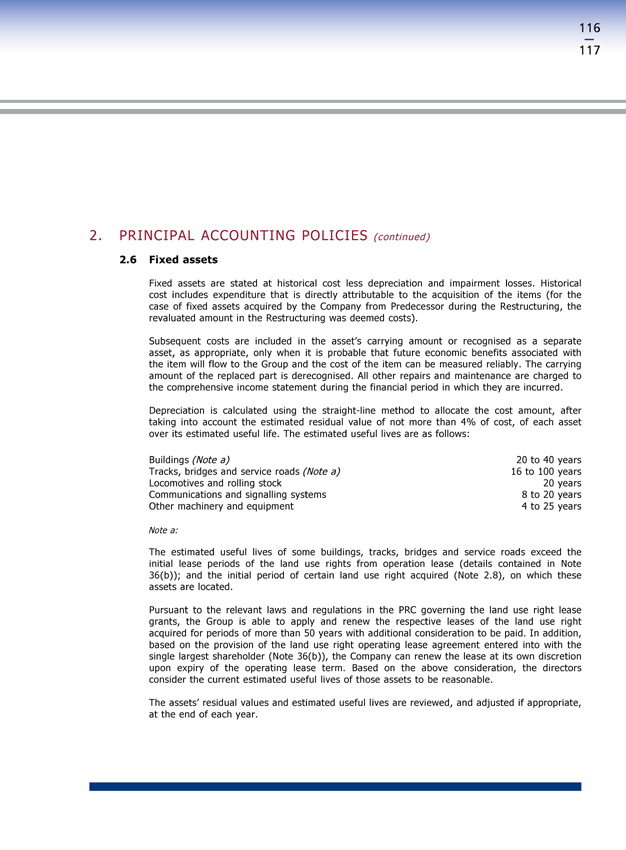
116
117
2. PRINCIPAL ACCOUNTING POLICIES (continued)
2.6 Fixed assets
Fixed assets are stated at historical cost less depreciation and impairment losses. Historical cost includes expenditure that is directly attributable to the acquisition of the items (for the case of fixed assets acquired by the Company from Predecessor during the Restructuring, the revaluated amount in the Restructuring was deemed costs).
Subsequent costs are included in the asset’s carrying amount or recognised as a separate asset, as appropriate, only when it is probable that future economic benefits associated with the item will flow to the Group and the cost of the item can be measured reliably. The carrying amount of the replaced part is derecognised. All other repairs and maintenance are charged to the comprehensive income statement during the financial period in which they are incurred.
Depreciation is calculated using the straight-line method to allocate the cost amount, after taking into account the estimated residual value of not more than 4% of cost, of each asset over its estimated useful life. The estimated useful lives are as follows:
Buildings (Note a) 20 to 40 years
Tracks, bridges and service roads (Note a) 16 to 100 years
Locomotives and rolling stock 20 years
Communications and signalling systems 8 to 20 years
Other machinery and equipment 4 to 25 years
Note a:
The estimated useful lives of some buildings, tracks, bridges and service roads exceed the initial lease periods of the land use rights from operation lease (details contained in Note 36(b)); and the initial period of certain land use right acquired (Note 2.8), on which these assets are located.
Pursuant to the relevant laws and regulations in the PRC governing the land use right lease grants, the Group is able to apply and renew the respective leases of the land use right acquired for periods of more than 50 years with additional consideration to be paid. In addition, based on the provision of the land use right operating lease agreement entered into with the single largest shareholder (Note 36(b)), the Company can renew the lease at its own discretion upon expiry of the operating lease term. Based on the above consideration, the directors consider the current estimated useful lives of those assets to be reasonable.
The assets’ residual values and estimated useful lives are reviewed, and adjusted if appropriate, at the end of each year.
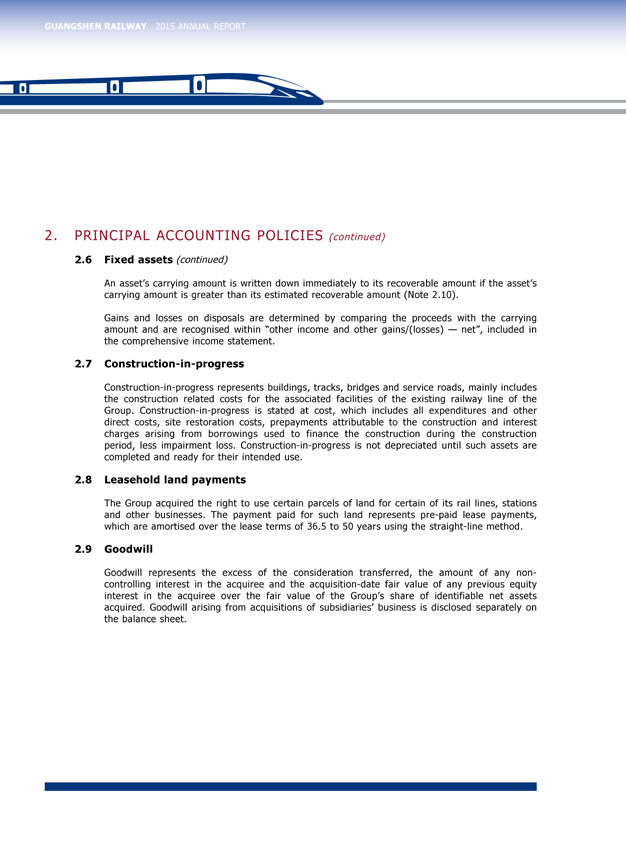
GUANGSHEN RAILWAY 2015 ANNUAL REPORT
PRINCIPAL ACCOUNTING POLICIES (continued)
2.6 Fixed assets (continued)
An asset’s carrying amount is written down immediately to its recoverable amount if the asset’s carrying amount is greater than its estimated recoverable amount (Note 2.10).
Gains and losses on disposals are determined by comparing the proceeds with the carrying amount and are recognised within “other income and other gains/(losses) — net”, included in the comprehensive income statement.
2.7 Construction-in-progress
Construction-in-progress represents buildings, tracks, bridges and service roads, mainly includes the construction related costs for the associated facilities of the existing railway line of the Group. Construction-in-progress is stated at cost, which includes all expenditures and other direct costs, site restoration costs, prepayments attributable to the construction and interest charges arising from borrowings used to finance the construction during the construction period, less impairment loss. Construction-in-progress is not depreciated until such assets are completed and ready for their intended use.
2.8 Leasehold land payments
The Group acquired the right to use certain parcels of land for certain of its rail lines, stations and other businesses. The payment paid for such land represents pre-paid lease payments, which are amortised over the lease terms of 36.5 to 50 years using the straight-line method.
2.9 Goodwill
Goodwill represents the excess of the consideration transferred, the amount of any non- controlling interest in the acquiree and the acquisition-date fair value of any previous equity interest in the acquiree over the fair value of the Group’s share of identifiable net assets acquired. Goodwill arising from acquisitions of subsidiaries’ business is disclosed separately on the balance sheet.
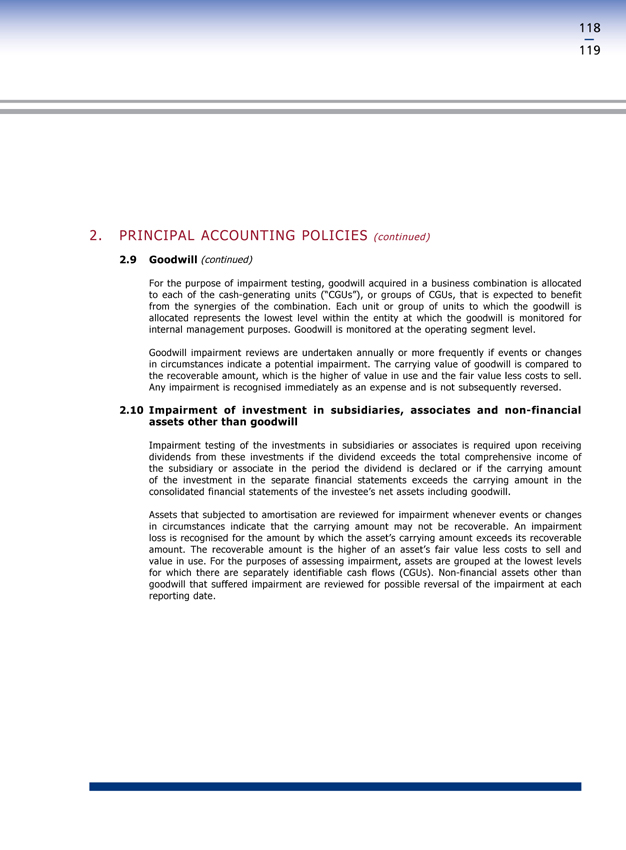
118
119
2. PRINCIPAL ACCOUNTING POLICIES (continued)
2.9 Goodwill (continued)
For the purpose of impairment testing, goodwill acquired in a business combination is allocated to each of the cash-generating units (“CGUs”), or groups of CGUs, that is expected to benefit from the synergies of the combination. Each unit or group of units to which the goodwill is allocated represents the lowest level within the entity at which the goodwill is monitored for internal management purposes. Goodwill is monitored at the operating segment level.
Goodwill impairment reviews are undertaken annually or more frequently if events or changes in circumstances indicate a potential impairment. The carrying value of goodwill is compared to the recoverable amount, which is the higher of value in use and the fair value less costs to sell.
Any impairment is recognised immediately as an expense and is not subsequently reversed.
2.10 Impairment of investment in subsidiaries, associates and non-financial assets other than goodwill
Impairment testing of the investments in subsidiaries or associates is required upon receiving dividends from these investments if the dividend exceeds the total comprehensive income of the subsidiary or associate in the period the dividend is declared or if the carrying amount of the investment in the separate financial statements exceeds the carrying amount in the consolidated financial statements of the investee’s net assets including goodwill.
Assets that subjected to amortisation are reviewed for impairment whenever events or changes in circumstances indicate that the carrying amount may not be recoverable. An impairment loss is recognised for the amount by which the asset’s carrying amount exceeds its recoverable amount. The recoverable amount is the higher of an asset’s fair value less costs to sell and value in use. For the purposes of assessing impairment, assets are grouped at the lowest levels for which there are separately identifiable cash flows (CGUs). Non-financial assets other than goodwill that suffered impairment are reviewed for possible reversal of the impairment at each reporting date.
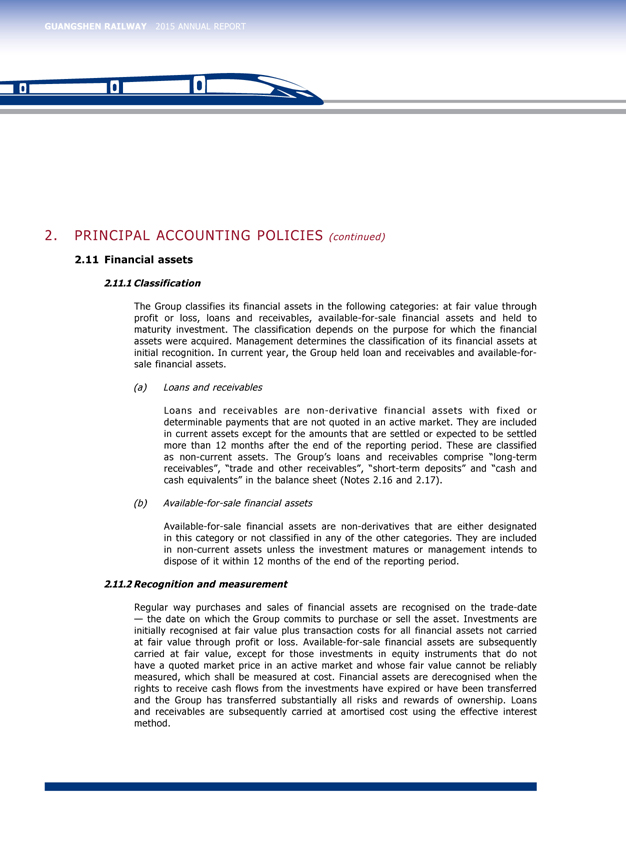
GUANGSHEN RAILWAY 2015 ANNUAL REPORT
2. PRINCIPAL ACCOUNTING POLICIES (continued)
2.11 Financial assets
2.11.1 Classification
The Group classifies its financial assets in the following categories: at fair value through profit or loss, loans and receivables, available-for-sale financial assets and held to maturity investment. The classification depends on the purpose for which the financial assets were acquired. Management determines the classification of its financial assets at initial recognition. In current year, the Group held loan and receivables and available-for-sale financial assets.
(a) |
| Loans and receivables |
Loans and receivables are non-derivative financial assets with fixed or determinable payments that are not quoted in an active market. They are included in current assets except for the amounts that are settled or expected to be settled more than 12 months after the end of the reporting period. These are classified as non-current assets. The Group’s loans and receivables comprise “long-term receivables”, “trade and other receivables”, “short-term deposits” and “cash and cash equivalents” in the balance sheet (Notes 2.16 and 2.17).
(b) |
| Available-for-sale financial assets |
Available-for-sale financial assets are non-derivatives that are either designated in this category or not classified in any of the other categories. They are included in non-current assets unless the investment matures or management intends to dispose of it within 12 months of the end of the reporting period.
2.11.2 Recognition and measurement
Regular way purchases and sales of financial assets are recognised on the trade-date — the date on which the Group commits to purchase or sell the asset. Investments are initially recognised at fair value plus transaction costs for all financial assets not carried at fair value through profit or loss. Available-for-sale financial assets are subsequently carried at fair value, except for those investments in equity instruments that do not have a quoted market price in an active market and whose fair value cannot be reliably measured, which shall be measured at cost. Financial assets are derecognised when the rights to receive cash flows from the investments have expired or have been transferred and the Group has transferred substantially all risks and rewards of ownership. Loans and receivables are subsequently carried at amortised cost using the effective interest method.
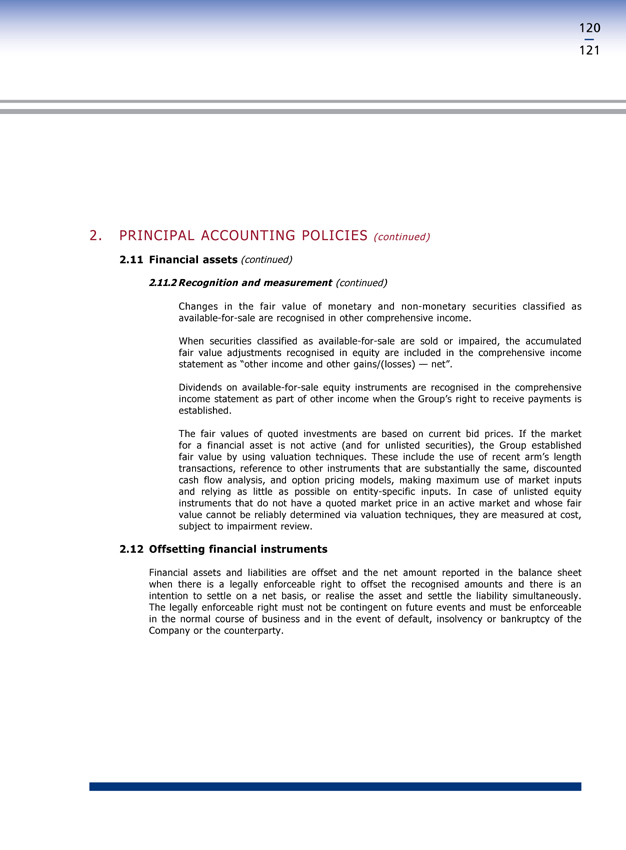
120
121
2. PRINCIPAL ACCOUNTING POLICIES (continued)
2.11 Financial assets (continued)
2.11.2 Recognition and measurement (continued)
Changes in the fair value of monetary and non-monetary securities classified as available-for-sale are recognised in other comprehensive income.
When securities classified as available-for-sale are sold or impaired, the accumulated fair value adjustments recognised in equity are included in the comprehensive income statement as “other income and other gains/(losses) — net”.
Dividends on available-for-sale equity instruments are recognised in the comprehensive income statement as part of other income when the Group’s right to receive payments is established.
The fair values of quoted investments are based on current bid prices. If the market for a financial asset is not active (and for unlisted securities), the Group established fair value by using valuation techniques. These include the use of recent arm’s length transactions, reference to other instruments that are substantially the same, discounted cash flow analysis, and option pricing models, making maximum use of market inputs and relying as little as possible on entity-specific inputs. In case of unlisted equity instruments that do not have a quoted market price in an active market and whose fair value cannot be reliably determined via valuation techniques, they are measured at cost, subject to impairment review.
2.12 Offsetting financial instruments
Financial assets and liabilities are offset and the net amount reported in the balance sheet when there is a legally enforceable right to offset the recognised amounts and there is an intention to settle on a net basis, or realise the asset and settle the liability simultaneously. The legally enforceable right must not be contingent on future events and must be enforceable in the normal course of business and in the event of default, insolvency or bankruptcy of the Company or the counterparty.
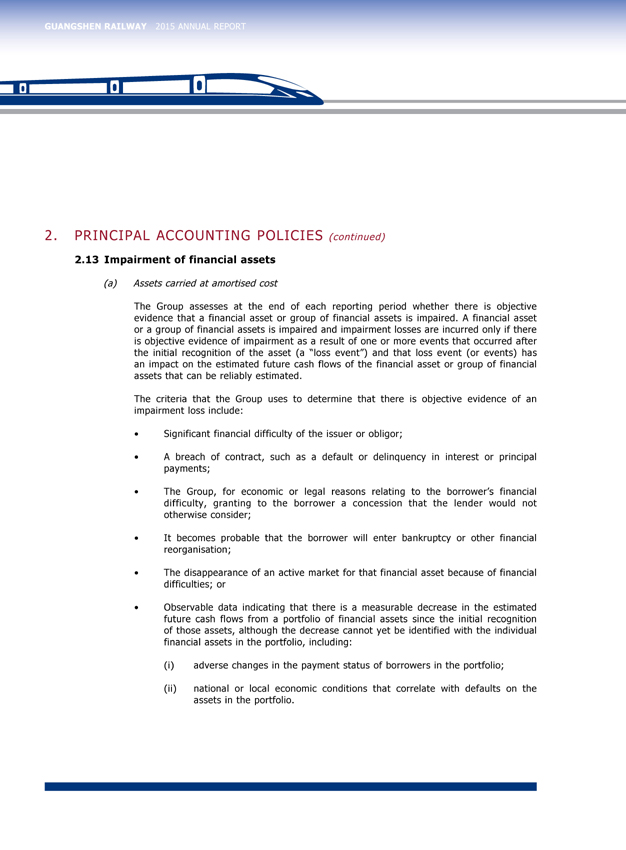
GUANGSHEN RAILWAY 2015 ANNUAL REPORT
2. PRINCIPAL ACCOUNTING POLICIES (continued)
2.13 Impairment of financial assets
(a) |
| Assets carried at amortised cost |
The Group assesses at the end of each reporting period whether there is objective
evidence that a financial asset or group of financial assets is impaired. A financial asset
or a group of financial assets is impaired and impairment losses are incurred only if there
is objective evidence of impairment as a result of one or more events that occurred after
the initial recognition of the asset (a “loss event”) and that loss event (or events) has
an impact on the estimated future cash flows of the financial asset or group of financial
assets that can be reliably estimated.
The criteria that the Group uses to determine that there is objective evidence of an
impairment loss include:
• Significantfinancialdifficultyoftheissuerorobligor;
• A breach of contract, such as a default or delinquency in interest or principal
payments;
• The Group, for economic or legal reasons relating to the borrower’s financial
difficulty, granting to the borrower a concession that the lender would not
otherwise consider;
• It becomes probable that the borrower will enter bankruptcy or other financial
reorganisation;
• Thedisappearanceofanactivemarketforthatfinancialassetbecauseoffinancial
difficulties; or
• Observabledataindicatingthatthereisameasurabledecreaseintheestimated
future cash flows from a portfolio of financial assets since the initial recognition
of those assets, although the decrease cannot yet be identified with the individual
financial assets in the portfolio, including:
(i) |
| adverse changes in the payment status of borrowers in the portfolio; |
(ii) national or local economic conditions that correlate with defaults on the
assets in the portfolio.
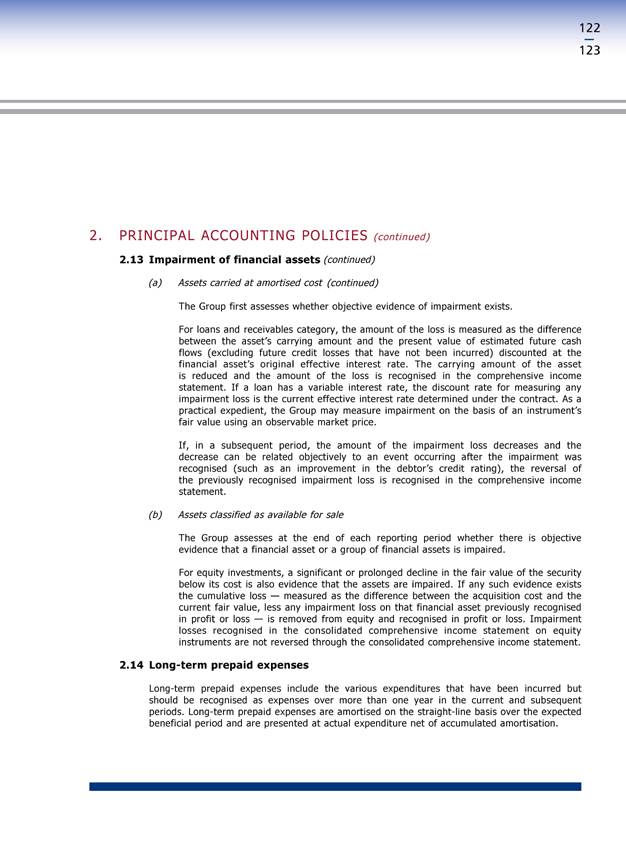
122
123
2. PRINCIPAL ACCOUNTING POLICIES (continued)
2.13 Impairment of financial assets (continued) (a) Assets carried at amortised cost (continued)
The Group first assesses whether objective evidence of impairment exists.
For loans and receivables category, the amount of the loss is measured as the difference between the asset’s carrying amount and the present value of estimated future cash flows (excluding future credit losses that have not been incurred) discounted at the financial asset’s original effective interest rate. The carrying amount of the asset is reduced and the amount of the loss is recognised in the comprehensive income statement. If a loan has a variable interest rate, the discount rate for measuring any impairment loss is the current effective interest rate determined under the contract. As a practical expedient, the Group may measure impairment on the basis of an instrument’s fair value using an observable market price.
If, in a subsequent period, the amount of the impairment loss decreases and the decrease can be related objectively to an event occurring after the impairment was recognised (such as an improvement in the debtor’s credit rating), the reversal of the previously recognised impairment loss is recognised in the comprehensive income statement.
(b) |
| Assets classified as available for sale |
The Group assesses at the end of each reporting period whether there is objective evidence that a financial asset or a group of financial assets is impaired.
For equity investments, a significant or prolonged decline in the fair value of the security below its cost is also evidence that the assets are impaired. If any such evidence exists the cumulative loss — measured as the difference between the acquisition cost and the current fair value, less any impairment loss on that financial asset previously recognised in profit or loss — is removed from equity and recognised in profit or loss. Impairment losses recognised in the consolidated comprehensive income statement on equity instruments are not reversed through the consolidated comprehensive income statement.
2.14 Long-term prepaid expenses
Long-term prepaid expenses include the various expenditures that have been incurred but should be recognised as expenses over more than one year in the current and subsequent periods. Long-term prepaid expenses are amortised on the straight-line basis over the expected beneficial period and are presented at actual expenditure net of accumulated amortisation.
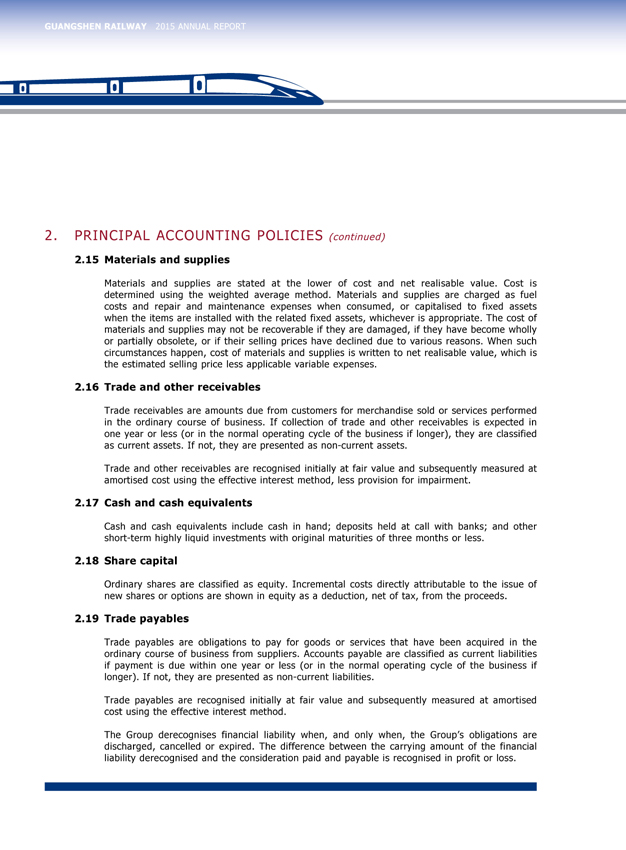
GUANGSHEN RAILWAY 2015 ANNUAL REPORT
2. PRINCIPAL ACCOUNTING POLICIES (continued)
2.15 Materials and supplies
Materials and supplies are stated at the lower of cost and net realisable value. Cost is determined using the weighted average method. Materials and supplies are charged as fuel costs and repair and maintenance expenses when consumed, or capitalised to fixed assets when the items are installed with the related fixed assets, whichever is appropriate. The cost of materials and supplies may not be recoverable if they are damaged, if they have become wholly or partially obsolete, or if their selling prices have declined due to various reasons. When such circumstances happen, cost of materials and supplies is written to net realisable value, which is the estimated selling price less applicable variable expenses.
2.16 Trade and other receivables
Trade receivables are amounts due from customers for merchandise sold or services performed in the ordinary course of business. If collection of trade and other receivables is expected in one year or less (or in the normal operating cycle of the business if longer), they are classified as current assets. If not, they are presented as non-current assets.
Trade and other receivables are recognised initially at fair value and subsequently measured at amortised cost using the effective interest method, less provision for impairment.
2.17 Cash and cash equivalents
Cash and cash equivalents include cash in hand; deposits held at call with banks; and other short-term highly liquid investments with original maturities of three months or less.
2.18 Share capital
Ordinary shares are classified as equity. Incremental costs directly attributable to the issue of new shares or options are shown in equity as a deduction, net of tax, from the proceeds.
2.19 Trade payables
Trade payables are obligations to pay for goods or services that have been acquired in the ordinary course of business from suppliers. Accounts payable are classified as current liabilities if payment is due within one year or less (or in the normal operating cycle of the business if longer). If not, they are presented as non-current liabilities.
Trade payables are recognised initially at fair value and subsequently measured at amortised cost using the effective interest method.
The Group derecognises financial liability when, and only when, the Group’s obligations are discharged, cancelled or expired. The difference between the carrying amount of the financial liability derecognised and the consideration paid and payable is recognised in profit or loss.
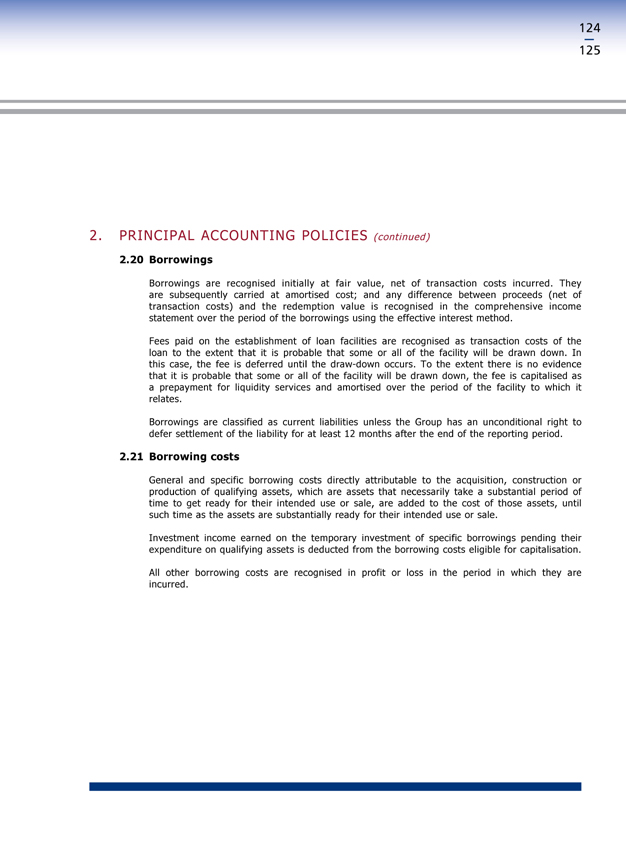
124
125
2. PRINCIPAL ACCOUNTING POLICIES (continued)
2.20 Borrowings
Borrowings are recognised initially at fair value, net of transaction costs incurred. They are subsequently carried at amortised cost; and any difference between proceeds (net of transaction costs) and the redemption value is recognised in the comprehensive income statement over the period of the borrowings using the effective interest method.
Fees paid on the establishment of loan facilities are recognised as transaction costs of the loan to the extent that it is probable that some or all of the facility will be drawn down. In this case, the fee is deferred until the draw-down occurs. To the extent there is no evidence that it is probable that some or all of the facility will be drawn down, the fee is capitalised as a prepayment for liquidity services and amortised over the period of the facility to which it relates.
Borrowings are classified as current liabilities unless the Group has an unconditional right to defer settlement of the liability for at least 12 months after the end of the reporting period.
2.21 Borrowing costs
General and specific borrowing costs directly attributable to the acquisition, construction or production of qualifying assets, which are assets that necessarily take a substantial period of time to get ready for their intended use or sale, are added to the cost of those assets, until such time as the assets are substantially ready for their intended use or sale.
Investment income earned on the temporary investment of specific borrowings pending their expenditure on qualifying assets is deducted from the borrowing costs eligible for capitalisation.
All other borrowing costs are recognised in profit or loss in the period in which they are incurred.
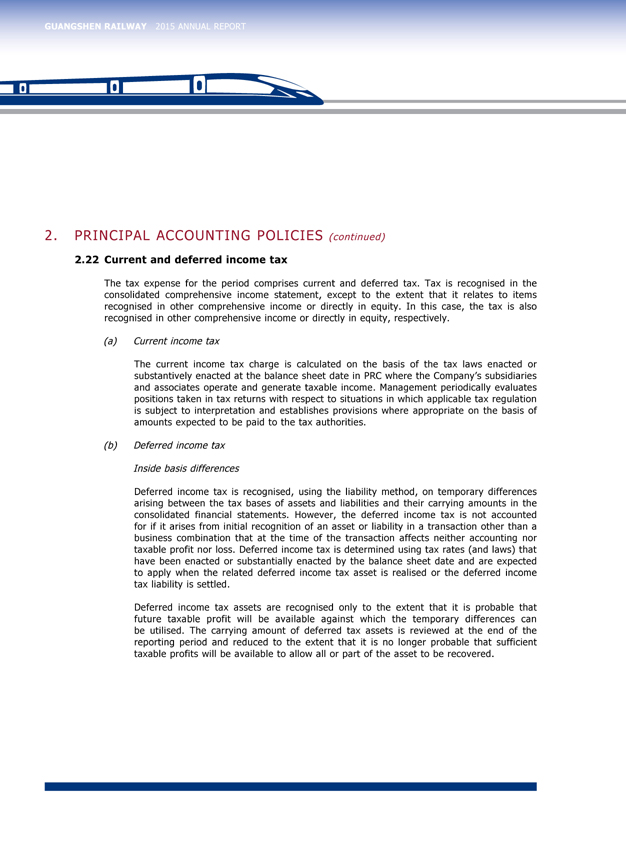
GUANGSHEN RAILWAY 2015 ANNUAL REPORT
2. PRINCIPAL ACCOUNTING POLICIES (continued)
2.22 Current and deferred income tax
The tax expense for the period comprises current and deferred tax. Tax is recognised in the consolidated comprehensive income statement, except to the extent that it relates to items recognised in other comprehensive income or directly in equity. In this case, the tax is also recognised in other comprehensive income or directly in equity, respectively.
(a) |
| Current income tax |
The current income tax charge is calculated on the basis of the tax laws enacted or substantively enacted at the balance sheet date in PRC where the Company’s subsidiaries and associates operate and generate taxable income. Management periodically evaluates positions taken in tax returns with respect to situations in which applicable tax regulation is subject to interpretation and establishes provisions where appropriate on the basis of amounts expected to be paid to the tax authorities.
(b) |
| Deferred income tax |
Inside basis differences
Deferred income tax is recognised, using the liability method, on temporary differences arising between the tax bases of assets and liabilities and their carrying amounts in the consolidated financial statements. However, the deferred income tax is not accounted for if it arises from initial recognition of an asset or liability in a transaction other than a business combination that at the time of the transaction affects neither accounting nor taxable profit nor loss. Deferred income tax is determined using tax rates (and laws) that have been enacted or substantially enacted by the balance sheet date and are expected to apply when the related deferred income tax asset is realised or the deferred income tax liability is settled.
Deferred income tax assets are recognised only to the extent that it is probable that future taxable profit will be available against which the temporary differences can be utilised. The carrying amount of deferred tax assets is reviewed at the end of the reporting period and reduced to the extent that it is no longer probable that sufficient taxable profits will be available to allow all or part of the asset to be recovered.
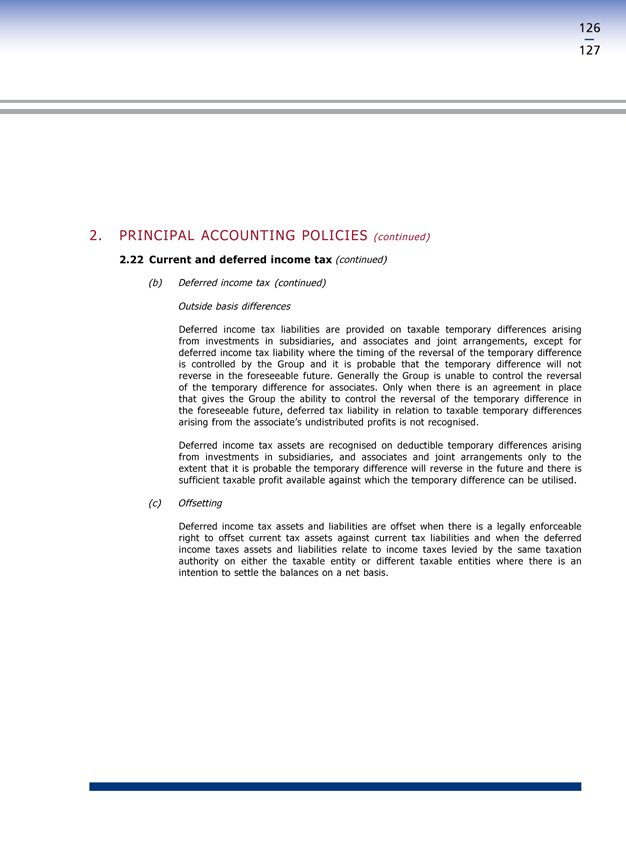
126
127
2. PRINCIPAL ACCOUNTING POLICIES (continued)
2.22 Current and deferred income tax (continued) (b) Deferred income tax (continued) Outside basis differences
Deferred income tax liabilities are provided on taxable temporary differences arising from investments in subsidiaries, and associates and joint arrangements, except for deferred income tax liability where the timing of the reversal of the temporary difference is controlled by the Group and it is probable that the temporary difference will not reverse in the foreseeable future. Generally the Group is unable to control the reversal of the temporary difference for associates. Only when there is an agreement in place that gives the Group the ability to control the reversal of the temporary difference in the foreseeable future, deferred tax liability in relation to taxable temporary differences arising from the associate’s undistributed profits is not recognised.
Deferred income tax assets are recognised on deductible temporary differences arising from investments in subsidiaries, and associates and joint arrangements only to the extent that it is probable the temporary difference will reverse in the future and there is sufficient taxable profit available against which the temporary difference can be utilised.
(c) |
| Offsetting |
Deferred income tax assets and liabilities are offset when there is a legally enforceable right to offset current tax assets against current tax liabilities and when the deferred income taxes assets and liabilities relate to income taxes levied by the same taxation authority on either the taxable entity or different taxable entities where there is an intention to settle the balances on a net basis.

GUANGSHEN RAILWAY 2015 ANNUAL REPORT
2. PRINCIPAL ACCOUNTING POLICIES (continued)
2.23 Employee benefits
(a) |
| Defined contribution plan |
The Group pays contributions to defined contribution schemes operated by the local government for employee benefits in respect of pension and unemployment. The Group also pays contribution to defined contribution schemes operated by Guangzhou Railway Group for employee supplementary pension benefit. The Group has no further payment obligations once the contributions have been paid. The contributions to the defined contribution schemes are recognised as staff costs when they are due.
(b) |
| Termination benefits |
Termination benefits are payable when employment is terminated by the Group before the normal retirement date, or whenever an employee accepts voluntary redundancy in exchange for these benefits. The Group recognises termination benefits at the earlier of the following dates: (a) when the Group can no longer withdraw the offer of those benefits; and (b) when the entity recognises costs for a restructuring that is within the scope of IAS 37 and involves the payment of termination benefits. In the case of an offer made to encourage voluntary redundancy, the termination benefits are measured based on the number of employees expected to accept the offer. Benefits falling due more than 12 months after the end of the reporting period are discounted to their present value.
2.24 Provisions
Provisions for environmental restoration, restructuring costs and legal claims are recognised when: the Group has a present legal or constructive obligation as a result of past events; it is probable that an outflow of resources will be required to settle the obligation; and the amount has been reliably estimated. Restructuring provisions comprise lease termination penalties and employee termination payments. Provisions are not recognised for future operating losses.
Where there are a number of similar obligations, the likelihood that an outflow will be required in settlement is determined by considering the class of obligations as a whole. A provision is recognised even if the likelihood of an outflow with respect to any one item included in the same class of obligations may be small.
Provisions are measured at the present value of the expenditures expected to be required to settle the obligation using a pre-tax discount rate that reflects current market assessments of the time value of money and the risks specific to the obligation. The increase in the provision due to passage of time is recognised as interest expense.
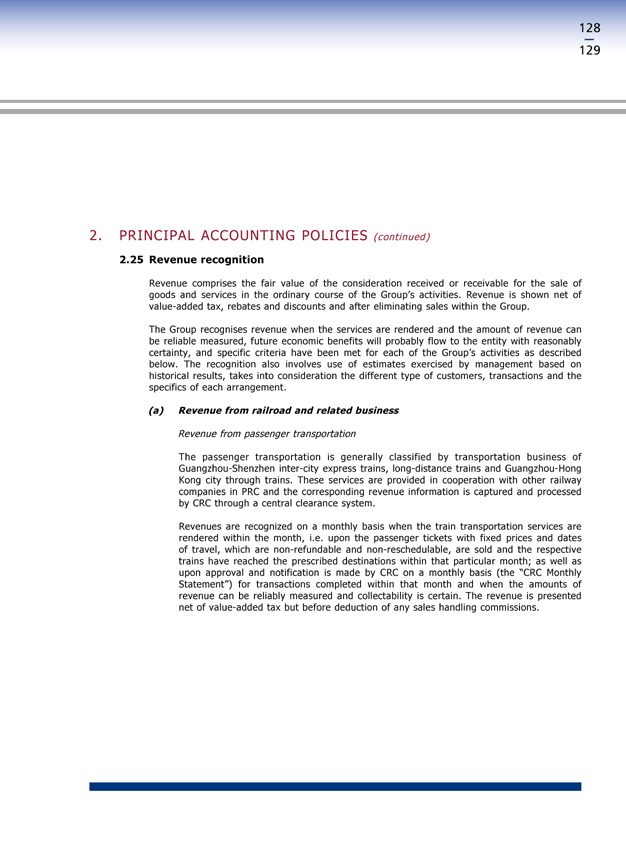
128
129
2. PRINCIPAL ACCOUNTING POLICIES (continued)
2.25 Revenue recognition
Revenue comprises the fair value of the consideration received or receivable for the sale of goods and services in the ordinary course of the Group’s activities. Revenue is shown net of value-added tax, rebates and discounts and after eliminating sales within the Group.
The Group recognises revenue when the services are rendered and the amount of revenue can be reliable measured, future economic benefits will probably flow to the entity with reasonably certainty, and specific criteria have been met for each of the Group’s activities as described below. The recognition also involves use of estimates exercised by management based on historical results, takes into consideration the different type of customers, transactions and the specifics of each arrangement.
(a) |
| Revenue from railroad and related business |
Revenue from passenger transportation
The passenger transportation is generally classified by transportation business of Guangzhou-Shenzhen inter-city express trains, long-distance trains and Guangzhou-Hong Kong city through trains. These services are provided in cooperation with other railway companies in PRC and the corresponding revenue information is captured and processed by CRC through a central clearance system.
Revenues are recognized on a monthly basis when the train transportation services are rendered within the month, i.e. upon the passenger tickets with fixed prices and dates of travel, which are non-refundable and non-reschedulable, are sold and the respective trains have reached the prescribed destinations within that particular month; as well as upon approval and notification is made by CRC on a monthly basis (the “CRC Monthly Statement”) for transactions completed within that month and when the amounts of revenue can be reliably measured and collectability is certain. The revenue is presented net of value-added tax but before deduction of any sales handling commissions.
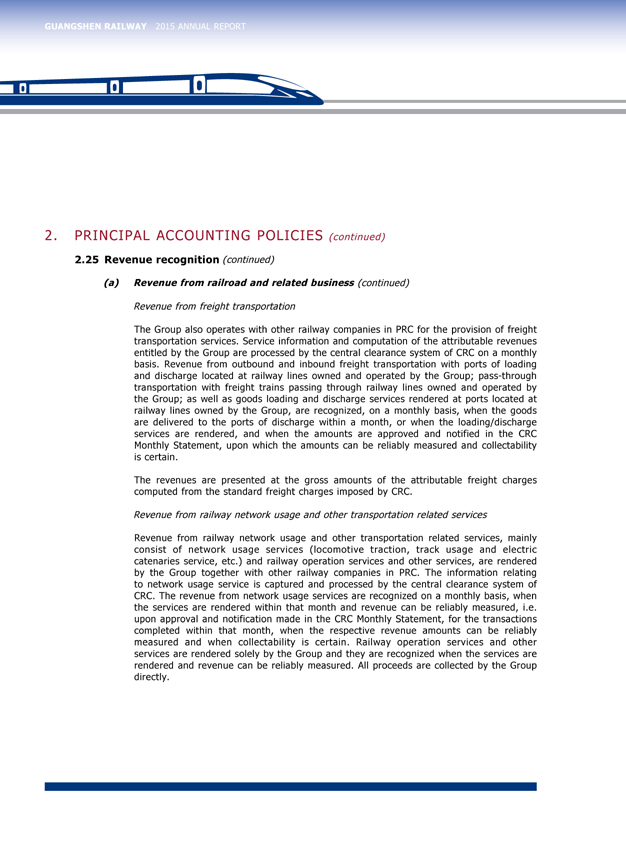
GUANGSHEN RAILWAY 2015 ANNUAL REPORT
2. PRINCIPAL ACCOUNTING POLICIES (continued)
2.25 Revenue recognition (continued)
(a) |
| Revenue from railroad and related business (continued) Revenue from freight transportation |
The Group also operates with other railway companies in PRC for the provision of freight transportation services. Service information and computation of the attributable revenues entitled by the Group are processed by the central clearance system of CRC on a monthly basis. Revenue from outbound and inbound freight transportation with ports of loading and discharge located at railway lines owned and operated by the Group; pass-through transportation with freight trains passing through railway lines owned and operated by the Group; as well as goods loading and discharge services rendered at ports located at railway lines owned by the Group, are recognized, on a monthly basis, when the goods are delivered to the ports of discharge within a month, or when the loading/discharge services are rendered, and when the amounts are approved and notified in the CRC Monthly Statement, upon which the amounts can be reliably measured and collectability is certain.
The revenues are presented at the gross amounts of the attributable freight charges computed from the standard freight charges imposed by CRC.
Revenue from railway network usage and other transportation related services
Revenue from railway network usage and other transportation related services, mainly consist of network usage services (locomotive traction, track usage and electric catenaries service, etc.) and railway operation services and other services, are rendered by the Group together with other railway companies in PRC. The information relating to network usage service is captured and processed by the central clearance system of CRC. The revenue from network usage services are recognized on a monthly basis, when the services are rendered within that month and revenue can be reliably measured, i.e. upon approval and notification made in the CRC Monthly Statement, for the transactions completed within that month, when the respective revenue amounts can be reliably measured and when collectability is certain. Railway operation services and other services are rendered solely by the Group and they are recognized when the services are rendered and revenue can be reliably measured. All proceeds are collected by the Group directly.

130
131
2. PRINCIPAL ACCOUNTING POLICIES (continued)
2.25 Revenue recognition (continued)
(a) |
| Revenue from railroad and related business (continued) |
Revenue from railway network usage and other transportation related services (continued)
The operations of the railway business of the Group form part of the nationwide railway system in PRC and they are supervised and governed by CRC. The Group render the passenger transportation and freight transportation services in cooperation with other railway companies and the related service fees and charges are collected either by the Group itself or by other railway companies. In addition, the Group also receives service fees and charges for on behalf of other railway companies. The respective fares and charges of the services, fee sharing basis, and processing of the respective revenue sharing among different railway companies are done centrally by a central clearance system operated by CRC. The Group records revenues based on the amounts of attributable revenue approved and notified in the CRC Monthly Statement for services undertaken by the Group completed within the specific month, upon then the revenues can be reliably measured and collectability is certain. The respective share of revenues, in excess of amount collected by the Group itself, are credited by CRC to bank accounts maintained by the Group. In the case that the attributable amount is less than the amount collected by the Group, the Group remits the surplus to CRC.
(b) |
| Revenue from other businesses |
Revenue from other business mainly consist of on-board catering services, leasing, sales of materials, sale of goods and other businesses related to railway transportation. Revenues from on-board catering services are recognized when the related services are rendered. Revenues from sales of materials and supplies and sale of goods are recognized when the respective materials and goods are delivered to customers. Revenue from operating lease arrangements on certain properties and locomotives is recognized on a straight-line basis over the period of the respective leases.
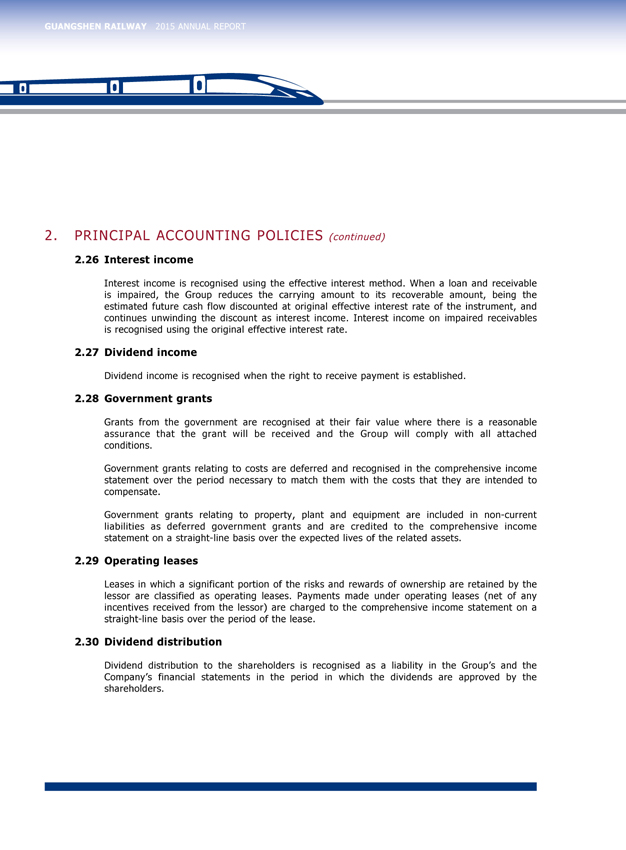
GUANGSHEN RAILWAY 2015 ANNUAL REPORT
2. PRINCIPAL ACCOUNTING POLICIES (continued)
2.26 Interest income
Interest income is recognised using the effective interest method. When a loan and receivable is impaired, the Group reduces the carrying amount to its recoverable amount, being the estimated future cash flow discounted at original effective interest rate of the instrument, and continues unwinding the discount as interest income. Interest income on impaired receivables is recognised using the original effective interest rate.
2.27 Dividend income
Dividend income is recognised when the right to receive payment is established.
2.28 Government grants
Grants from the government are recognised at their fair value where there is a reasonable assurance that the grant will be received and the Group will comply with all attached conditions.
Government grants relating to costs are deferred and recognised in the comprehensive income statement over the period necessary to match them with the costs that they are intended to compensate.
Government grants relating to property, plant and equipment are included in non-current liabilities as deferred government grants and are credited to the comprehensive income statement on a straight-line basis over the expected lives of the related assets.
2.29 Operating leases
Leases in which a significant portion of the risks and rewards of ownership are retained by the lessor are classified as operating leases. Payments made under operating leases (net of any incentives received from the lessor) are charged to the comprehensive income statement on a straight-line basis over the period of the lease.
2.30 Dividend distribution
Dividend distribution to the shareholders is recognised as a liability in the Group’s and the Company’s financial statements in the period in which the dividends are approved by the shareholders.
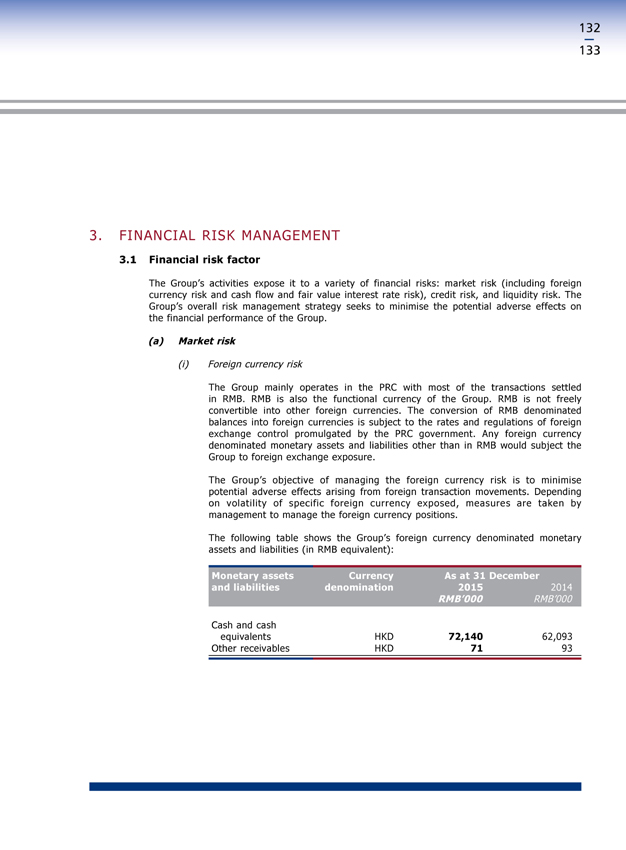
132
133
3. FINANCIAL RISK MANAGEMENT
3.1 Financial risk factor
The Group’s activities expose it to a variety of financial risks: market risk (including foreign currency risk and cash flow and fair value interest rate risk), credit risk, and liquidity risk. The Group’s overall risk management strategy seeks to minimise the potential adverse effects on the financial performance of the Group.
(a) |
| Market risk |
(i) |
| Foreign currency risk |
The Group mainly operates in the PRC with most of the transactions settled in RMB. RMB is also the functional currency of the Group. RMB is not freely convertible into other foreign currencies. The conversion of RMB denominated balances into foreign currencies is subject to the rates and regulations of foreign exchange control promulgated by the PRC government. Any foreign currency denominated monetary assets and liabilities other than in RMB would subject the Group to foreign exchange exposure.
The Group’s objective of managing the foreign currency risk is to minimise potential adverse effects arising from foreign transaction movements. Depending on volatility of specific foreign currency exposed, measures are taken by management to manage the foreign currency positions.
The following table shows the Group’s foreign currency denominated monetary assets and liabilities (in RMB equivalent):
Monetary assets Currency As at 31 December
and liabilities denomination 2015 2014
RMB’000 RMB’000
Cash and cash
equivalents HKD 72,140 62,093
Other receivables HKD 71 93
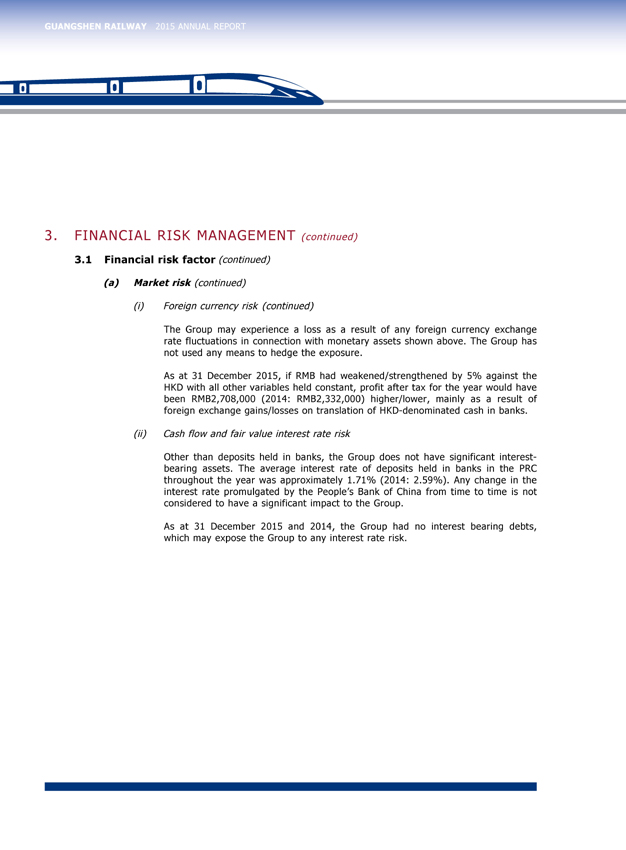
GUANGSHEN RAILWAY 2015 ANNUAL REPORT
3. FINANCIAL RISK MANAGEMENT (continued)
3.1 Financial risk factor (continued)
(a) |
| Market risk (continued) |
(i) |
| Foreign currency risk (continued) |
The Group may experience a loss as a result of any foreign currency exchange rate fluctuations in connection with monetary assets shown above. The Group has not used any means to hedge the exposure.
As at 31 December 2015, if RMB had weakened/strengthened by 5% against the HKD with all other variables held constant, profit after tax for the year would have been RMB2,708,000 (2014: RMB2,332,000) higher/lower, mainly as a result of foreign exchange gains/losses on translation of HKD-denominated cash in banks.
(ii) Cash flow and fair value interest rate risk
Other than deposits held in banks, the Group does not have significant interest-bearing assets. The average interest rate of deposits held in banks in the PRC throughout the year was approximately 1.71% (2014: 2.59%). Any change in the interest rate promulgated by the People’s Bank of China from time to time is not considered to have a significant impact to the Group.
As at 31 December 2015 and 2014, the Group had no interest bearing debts, which may expose the Group to any interest rate risk.
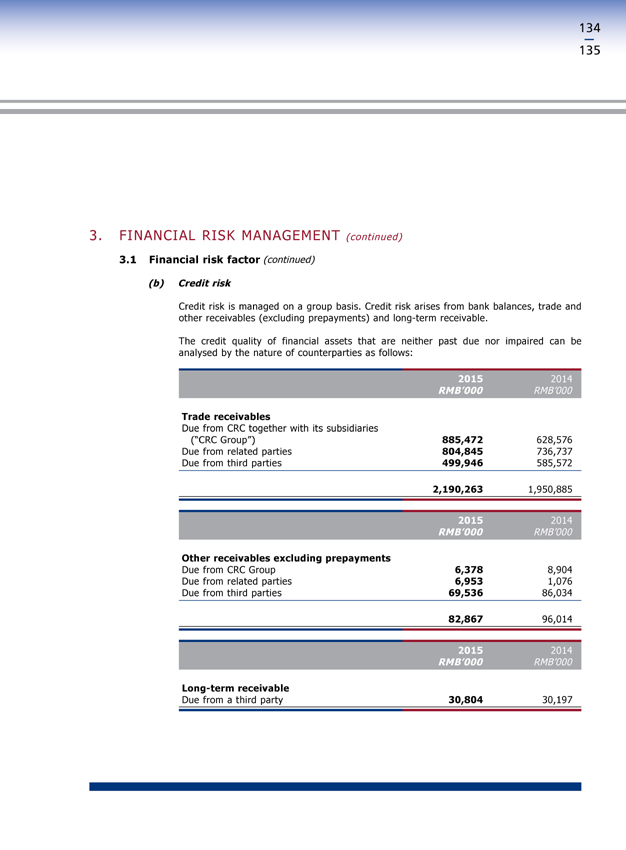
134
135
3. FINANCIAL RISK MANAGEMENT (continued)
3.1 Financial risk factor (continued)
(b) |
| Credit risk |
Credit risk is managed on a group basis. Credit risk arises from bank balances, trade and other receivables (excluding prepayments) and long-term receivable.
The credit quality of financial assets that are neither past due nor impaired can be analysed by the nature of counterparties as follows:
2015 2014
RMB’000 RMB’000
Trade receivables
Due from CRC together with its subsidiaries
(“CRC Group”) 885,472 628,576
Due from related parties 804,845 736,737
Due from third parties 499,946 585,572
2,190,263 1,950,885
2015 2014
RMB’000 RMB’000
Other receivables excluding prepayments
Due from CRC Group 6,378 8,904
Due from related parties 6,953 1,076
Due from third parties 69,536 86,034
82,867 96,014
2015 2014
RMB’000 RMB’000
Long-term receivable
Due from a third party 30,804 30,197
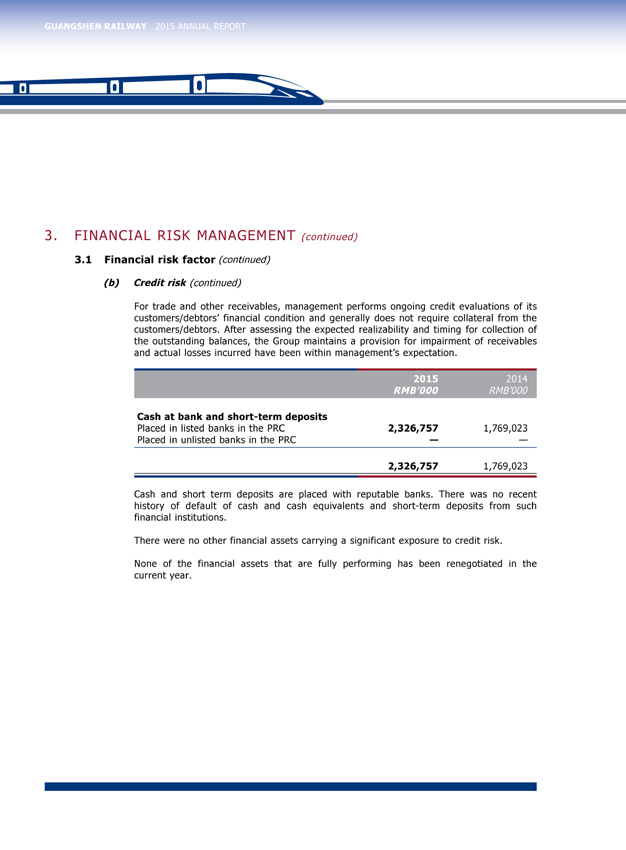
GUANGSHEN RAILWAY 2015 ANNUAL REPORT
3. FINANCIAL RISK MANAGEMENT (continued)
3.1 Financial risk factor (continued)
(b) |
| Credit risk (continued) |
For trade and other receivables, management performs ongoing credit evaluations of its customers/debtors’ financial condition and generally does not require collateral from the customers/debtors. After assessing the expected realizability and timing for collection of the outstanding balances, the Group maintains a provision for impairment of receivables and actual losses incurred have been within management’s expectation.
2015 2014
RMB’000 RMB’000
Cash at bank and short-term deposits
Placed in listed banks in the PRC 2,326,757 1,769,023
Placed in unlisted banks in the PRC — —
2,326,757 1,769,023
Cash and short term deposits are placed with reputable banks. There was no recent history of default of cash and cash equivalents and short-term deposits from such financial institutions.
There were no other financial assets carrying a significant exposure to credit risk.
None of the financial assets that are fully performing has been renegotiated in the current year.
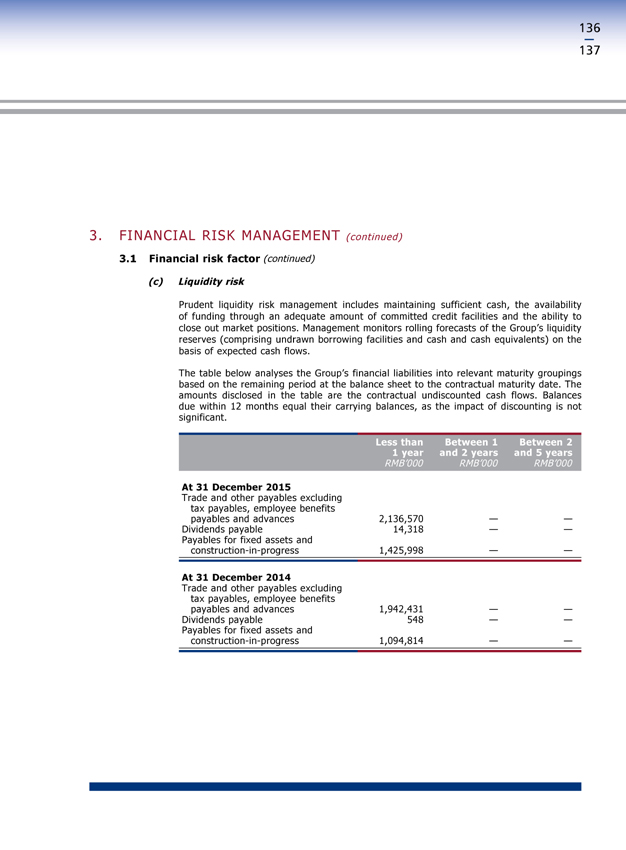
136
137
3. FINANCIAL RISK MANAGEMENT (continued)
3.1 Financial risk factor (continued)
(c) |
| Liquidity risk |
Prudent liquidity risk management includes maintaining sufficient cash, the availability of funding through an adequate amount of committed credit facilities and the ability to close out market positions. Management monitors rolling forecasts of the Group’s liquidity reserves (comprising undrawn borrowing facilities and cash and cash equivalents) on the basis of expected cash flows.
The table below analyses the Group’s financial liabilities into relevant maturity groupings based on the remaining period at the balance sheet to the contractual maturity date. The amounts disclosed in the table are the contractual undiscounted cash flows. Balances due within 12 months equal their carrying balances, as the impact of discounting is not significant.
Less than Between 1 Between 2
1 |
| year and 2 years and 5 years |
RMB’000 RMB’000 RMB’000
At 31 December 2015
Trade and other payables excluding
tax payables, employee benefits
payables and advances 2,136,570 — —
Dividends payable 14,318 — —
Payables for fixed assets and
construction-in-progress 1,425,998 — —
At 31 December 2014
Trade and other payables excluding
tax payables, employee benefits
payables and advances 1,942,431 — —
Dividends payable 548 — —
Payables for fixed assets and
construction-in-progress 1,094,814 — —
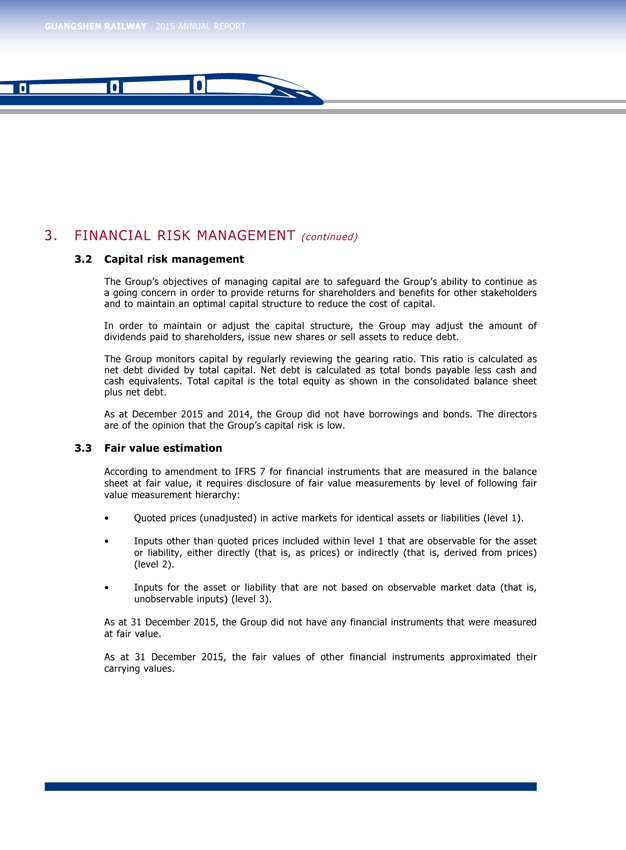
GUANGSHEN RAILWAY 2015 ANNUAL REPORT
3. FINANCIAL RISK MANAGEMENT (continued)
3.2 Capital risk management
The Group’s objectives of managing capital are to safeguard the Group’s ability to continue as a going concern in order to provide returns for shareholders and benefits for other stakeholders and to maintain an optimal capital structure to reduce the cost of capital.
In order to maintain or adjust the capital structure, the Group may adjust the amount of dividends paid to shareholders, issue new shares or sell assets to reduce debt.
The Group monitors capital by regularly reviewing the gearing ratio. This ratio is calculated as net debt divided by total capital. Net debt is calculated as total bonds payable less cash and cash equivalents. Total capital is the total equity as shown in the consolidated balance sheet plus net debt.
As at December 2015 and 2014, the Group did not have borrowings and bonds. The directors are of the opinion that the Group’s capital risk is low.
3.3 Fair value estimation
According to amendment to IFRS 7 for financial instruments that are measured in the balance sheet at fair value, it requires disclosure of fair value measurements by level of following fair value measurement hierarchy:
• |
| Quotedprices(unadjusted)inactivemarketsforidenticalassetsorliabilities(level1). |
• |
| Inputsotherthanquotedpricesincludedwithinlevel1thatareobservablefortheasset or liability, either directly (that is, as prices) or indirectly (that is, derived from prices) (level 2). |
• |
| Inputsfortheassetorliabilitythatarenotbasedonobservablemarketdata(thatis, unobservable inputs) (level 3). |
As at 31 December 2015, the Group did not have any financial instruments that were measured at fair value.
As at 31 December 2015, the fair values of other financial instruments approximated their carrying values.
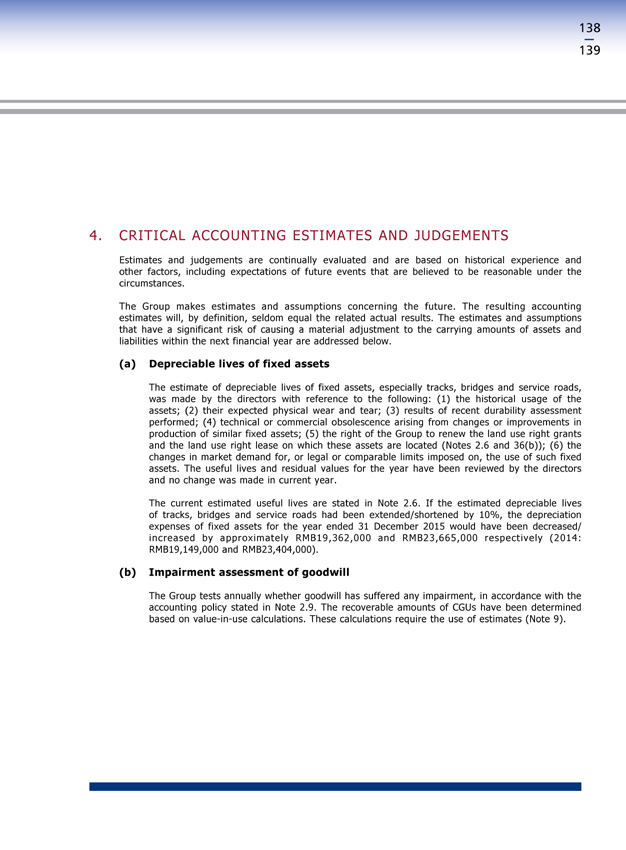
4. CRITICAL ACCOUNTING ESTIMATES AND JUDGEMENTS
Estimates and judgements are continually evaluated and are based on historical experience and other factors, including expectations of future events that are believed to be reasonable under the circumstances.
The Group makes estimates and assumptions concerning the future. The resulting accounting estimates will, by definition, seldom equal the related actual results. The estimates and assumptions that have a significant risk of causing a material adjustment to the carrying amounts of assets and liabilities within the next financial year are addressed below.
(a) |
| Depreciable lives of fixed assets |
The estimate of depreciable lives of fixed assets, especially tracks, bridges and service roads, was made by the directors with reference to the following: (1) the historical usage of the assets; (2) their expected physical wear and tear; (3) results of recent durability assessment performed; (4) technical or commercial obsolescence arising from changes or improvements in production of similar fixed assets; (5) the right of the Group to renew the land use right grants and the land use right lease on which these assets are located (Notes 2.6 and 36(b)); (6) the changes in market demand for, or legal or comparable limits imposed on, the use of such fixed assets. The useful lives and residual values for the year have been reviewed by the directors and no change was made in current year.
The current estimated useful lives are stated in Note 2.6. If the estimated depreciable lives of tracks, bridges and service roads had been extended/shortened by 10%, the depreciation expenses of fixed assets for the year ended 31 December 2015 would have been decreased/ increased by approximately RMB19,362,000 and RMB23,665,000 respectively (2014: RMB19,149,000 and RMB23,404,000).
(b) |
| Impairment assessment of goodwill |
The Group tests annually whether goodwill has suffered any impairment, in accordance with the accounting policy stated in Note 2.9. The recoverable amounts of CGUs have been determined based on value-in-use calculations. These calculations require the use of estimates (Note 9).
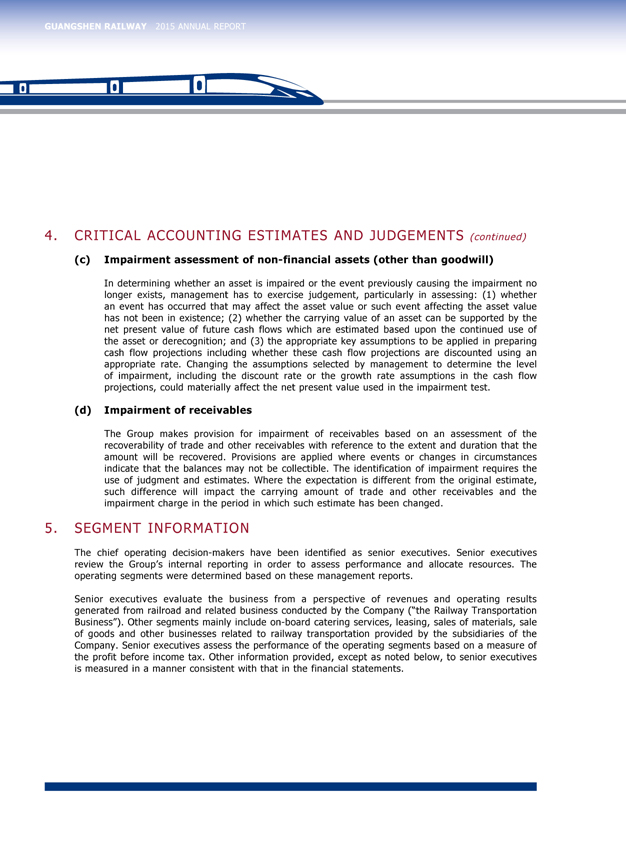
GUANGSHEN RAILWAY 2015 ANNUAL REPORT
4. CRITICAL ACCOUNTING ESTIMATES AND JUDGEMENTS (continued)
(c) |
| Impairment assessment of non-financial assets (other than goodwill) |
In determining whether an asset is impaired or the event previously causing the impairment no longer exists, management has to exercise judgement, particularly in assessing: (1) whether an event has occurred that may affect the asset value or such event affecting the asset value has not been in existence; (2) whether the carrying value of an asset can be supported by the net present value of future cash flows which are estimated based upon the continued use of the asset or derecognition; and (3) the appropriate key assumptions to be applied in preparing cash flow projections including whether these cash flow projections are discounted using an appropriate rate. Changing the assumptions selected by management to determine the level of impairment, including the discount rate or the growth rate assumptions in the cash flow projections, could materially affect the net present value used in the impairment test.
(d) |
| Impairment of receivables |
The Group makes provision for impairment of receivables based on an assessment of the recoverability of trade and other receivables with reference to the extent and duration that the amount will be recovered. Provisions are applied where events or changes in circumstances indicate that the balances may not be collectible. The identification of impairment requires the use of judgment and estimates. Where the expectation is different from the original estimate, such difference will impact the carrying amount of trade and other receivables and the impairment charge in the period in which such estimate has been changed.
5. SEGMENT INFORMATION
The chief operating decision-makers have been identified as senior executives. Senior executives review the Group’s internal reporting in order to assess performance and allocate resources. The operating segments were determined based on these management reports.
Senior executives evaluate the business from a perspective of revenues and operating results generated from railroad and related business conducted by the Company (“the Railway Transportation Business”). Other segments mainly include on-board catering services, leasing, sales of materials, sale of goods and other businesses related to railway transportation provided by the subsidiaries of the Company. Senior executives assess the performance of the operating segments based on a measure of the profit before income tax. Other information provided, except as noted below, to senior executives is measured in a manner consistent with that in the financial statements.
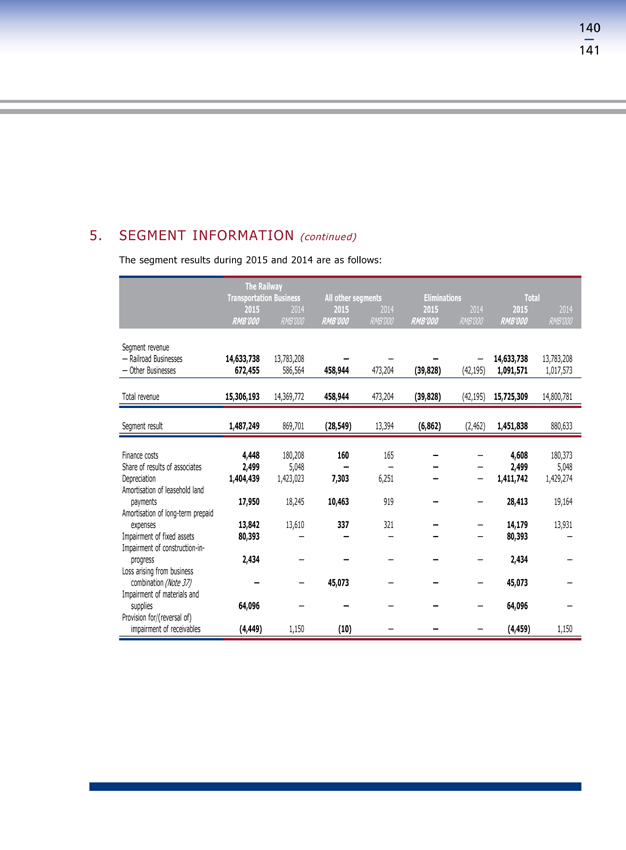
140
141
5. SEGMENT INFORMATION (continued)
The segment results during 2015 and 2014 are as follows:
The Railway
Transportation Business All other segments Eliminations Total
2015 2014 2015 2014 2015 2014 2015 2014
RMB’000 RMB’000 RMB’000 RMB’000 RMB’000 RMB’000 RMB’000 RMB’000
Segment revenue
— Railroad Businesses 14,633,738 13,783,208 — — — — 14,633,738 13,783,208
— Other Businesses 672,455 586,564 458,944 473,204 (39,828) (42,195) 1,091,571 1,017,573
Total revenue 15,306,193 14,369,772 458,944 473,204 (39,828) (42,195) 15,725,309 14,800,781
Segment result 1,487,249 869,701 (28,549) 13,394 (6,862) (2,462) 1,451,838 880,633
Finance costs 4,448 180,208 160 165 — — 4,608 180,373
Share of results of associates 2,499 5,048 — — — — 2,499 5,048
Depreciation 1,404,439 1,423,023 7,303 6,251 — — 1,411,742 1,429,274
Amortisation of leasehold land
payments 17,950 18,245 10,463 919 — — 28,413 19,164
Amortisation of long-term prepaid
expenses 13,842 13,610 337 321 — — 14,179 13,931
Impairment of fixed assets 80,393 — — — — — 80,393 —
Impairment of construction-in-
progress 2,434 — — — — — 2,434 —
Loss arising from business
combination (Note 37) — — 45,073 — — — 45,073 —
Impairment of materials and
supplies 64,096 — — — — — 64,096 —
Provision for/(reversal of)
impairment of receivables (4,449) 1,150 (10) — — — (4,459) 1,150
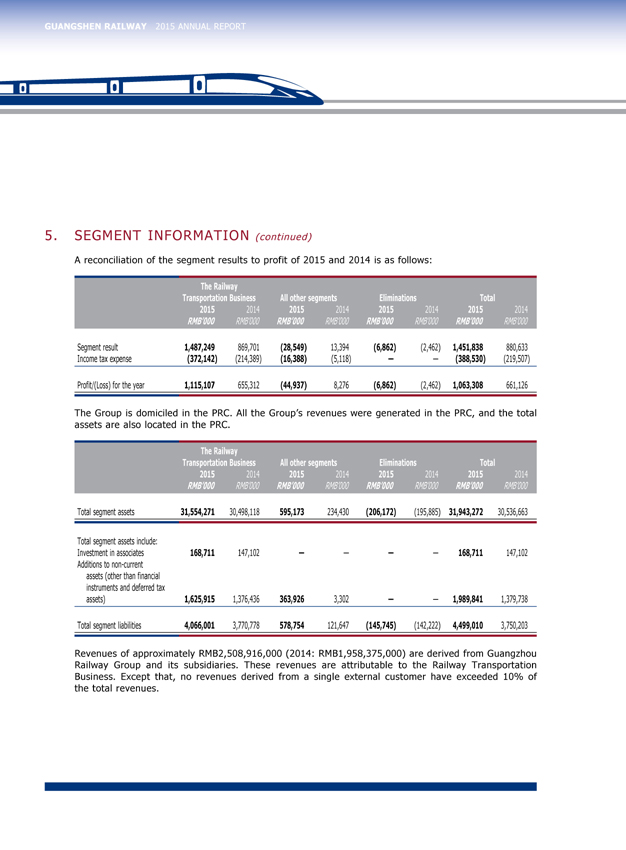
GUANGSHEN RAILWAY 2015 ANNUAL REPORT
5. SEGMENT INFORMATION (continued)
A reconciliation of the segment results to profit of 2015 and 2014 is as follows:
The Railway
Transportation Business All other segments Eliminations Total
2015 2014 2015 2014 2015 2014 2015 2014
RMB’000 RMB’000 RMB’000 RMB’000 RMB’000 RMB’000 RMB’000 RMB’000
Segment result 1,487,249 869,701 (28,549) 13,394 (6,862) (2,462) 1,451,838 880,633
Income tax expense (372,142) (214,389) (16,388) (5,118) — — (388,530) (219,507)
Profit/(Loss) for the year 1,115,107 655,312 (44,937) 8,276 (6,862) (2,462) 1,063,308 661,126
The Group is domiciled in the PRC. All the Group’s revenues were generated in the PRC, and the total
assets are also located in the PRC.
The Railway
Transportation Business All other segments Eliminations Total
2015 2014 2015 2014 2015 2014 2015 2014
RMB’000 RMB’000 RMB’000 RMB’000 RMB’000 RMB’000 RMB’000 RMB’000
Total segment assets 31,554,271 30,498,118 595,173 234,430 (206,172) (195,885) 31,943,272 30,536,663
Total segment assets include:
Investment in associates 168,711 147,102 — — — — 168,711 147,102
Additions to non-current
assets (other than financial
instruments and deferred tax
assets) 1,625,915 1,376,436 363,926 3,302 — — 1,989,841 1,379,738
Total segment liabilities 4,066,001 3,770,778 578,754 121,647 (145,745) (142,222) 4,499,010 3,750,203
Revenues of approximately RMB2,508,916,000 (2014: RMB1,958,375,000) are derived from Guangzhou Railway Group and its subsidiaries. These revenues are attributable to the Railway Transportation Business. Except that, no revenues derived from a single external customer have exceeded 10% of the total revenues.
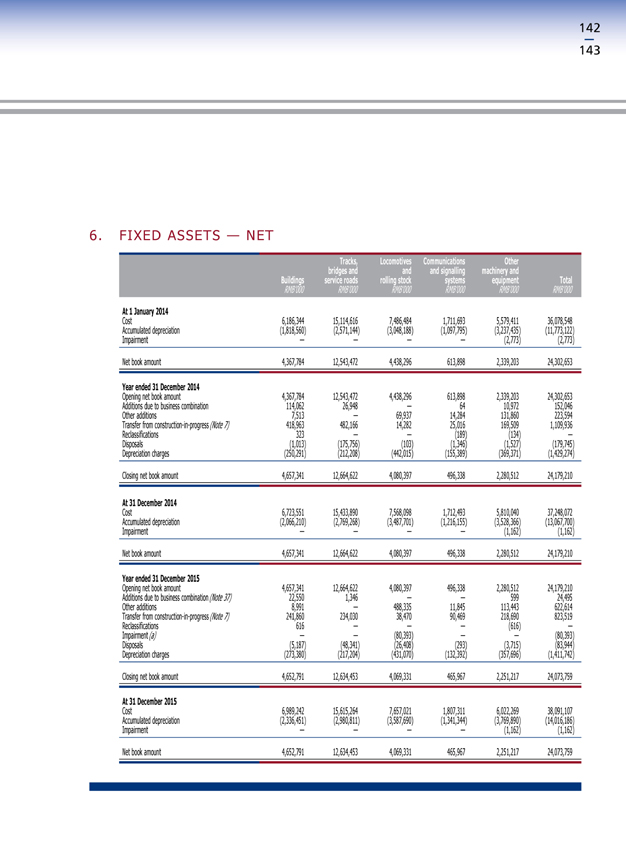
142
143
6. FIXED ASSETS — NET
Tracks, Locomotives Communications Other
bridges and and and signalling machinery and
Buildings service roads rolling stock systems equipment Total
RMB’000 RMB’000 RMB’000 RMB’000 RMB’000 RMB’000
At 1 January 2014
Cost 6,186,344 15,114,616 7,486,484 1,711,693 5,579,411 36,078,548
Accumulated depreciation (1,818,560) (2,571,144) (3,048,188) (1,097,795) (3,237,435) (11,773,122)
Impairment — — — — (2,773) (2,773)
Net book amount 4,367,784 12,543,472 4,438,296 613,898 2,339,203 24,302,653
Year ended 31 December 2014
Opening net book amount 4,367,784 12,543,472 4,438,296 613,898 2,339,203 24,302,653
Additions due to business combination 114,062 26,948 — 64 10,972 152,046
Other additions 7,513 — 69,937 14,284 131,860 223,594
Transfer from construction-in-progress (Note 7) 418,963 482,166 14,282 25,016 169,509 1,109,936
Reclassifications 323 — — (189) (134) —
Disposals (1,013) (175,756) (103) (1,346) (1,527) (179,745)
Depreciation charges (250,291) (212,208) (442,015) (155,389) (369,371) (1,429,274)
Closing net book amount 4,657,341 12,664,622 4,080,397 496,338 2,280,512 24,179,210
At 31 December 2014
Cost 6,723,551 15,433,890 7,568,098 1,712,493 5,810,040 37,248,072
Accumulated depreciation (2,066,210) (2,769,268) (3,487,701) (1,216,155) (3,528,366) (13,067,700)
Impairment — — — — (1,162) (1,162)
Net book amount 4,657,341 12,664,622 4,080,397 496,338 2,280,512 24,179,210
Year ended 31 December 2015
Opening net book amount 4,657,341 12,664,622 4,080,397 496,338 2,280,512 24,179,210
Additions due to business combination (Note 37) 22,550 1,346 — — 599 24,495
Other additions 8,991 — 488,335 11,845 113,443 622,614
Transfer from construction-in-progress (Note 7) 241,860 234,030 38,470 90,469 218,690 823,519
Reclassifications 616 — — — (616) —
Impairment (a) — — (80,393) — — (80,393)
Disposals (5,187) (48,341) (26,408) (293) (3,715) (83,944)
Depreciation charges (273,380) (217,204) (431,070) (132,392) (357,696) (1,411,742)
Closing net book amount 4,652,791 12,634,453 4,069,331 465,967 2,251,217 24,073,759
At 31 December 2015
Cost 6,989,242 15,615,264 7,657,021 1,807,311 6,022,269 38,091,107
Accumulated depreciation (2,336,451) (2,980,811) (3,587,690) (1,341,344) (3,769,890) (14,016,186)
Impairment — — — — (1,162) (1,162)
Net book amount 4,652,791 12,634,453 4,069,331 465,967 2,251,217 24,073,759
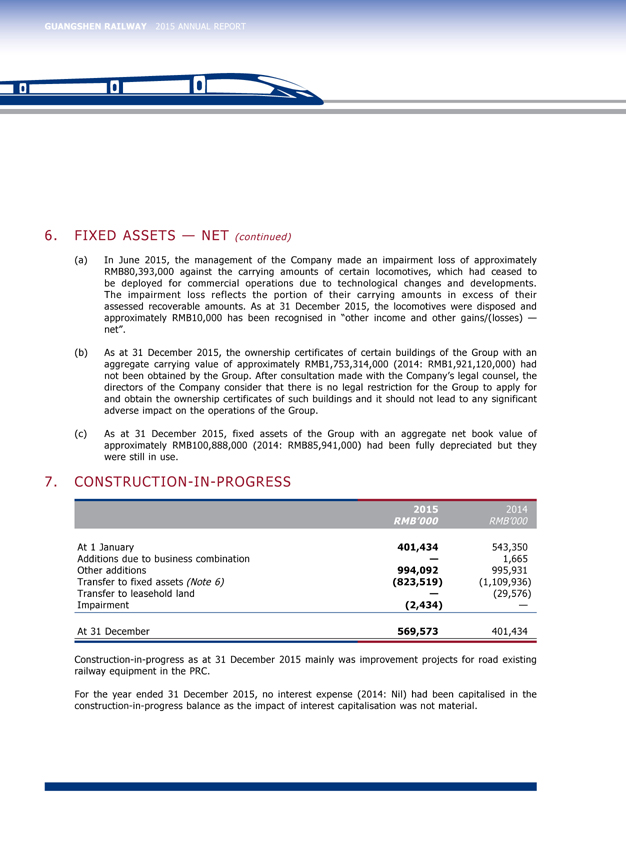
GUANGSHEN RAILWAY 2015 ANNUAL REPORT
6. FIXED ASSETS — NET (continued)
(a)In June 2015, the management of the Company made an impairment loss of approximately RMB80,393,000 against the carrying amounts of certain locomotives, which had ceased to be deployed for commercial operations due to technological changes and developments.
The impairment loss reflects the portion of their carrying amounts in excess of their assessed recoverable amounts. As at 31 December 2015, the locomotives were disposed and approximately RMB10,000 has been recognised in “other income and other gains/(losses) — net”.
(b)As at 31 December 2015, the ownership certificates of certain buildings of the Group with an aggregate carrying value of approximately RMB1,753,314,000 (2014: RMB1,921,120,000) had not been obtained by the Group. After consultation made with the Company’s legal counsel, the directors of the Company consider that there is no legal restriction for the Group to apply for and obtain the ownership certificates of such buildings and it should not lead to any significant adverse impact on the operations of the Group.
(c)As at 31 December 2015, fixed assets of the Group with an aggregate net book value of approximately RMB100,888,000 (2014: RMB85,941,000) had been fully depreciated but they were still in use.
7. CONSTRUCTION -IN—PROGRESS
2015 2014
RMB’000 RMB’000
At 1 January 401,434 543,350
Additions due to business combination — 1,665
Other additions 994,092 995,931
Transfer to fixed assets (Note 6) (823,519) (1,109,936)
Transfer to leasehold land — (29,576)
Impairment (2,434) —
At 31 December 569,573 401,434
Construction-in-progress as at 31 December 2015 mainly was improvement projects for road existing railway equipment in the PRC.
For the year ended 31 December 2015, no interest expense (2014: Nil) had been capitalised in the construction-in-progress balance as the impact of interest capitalisation was not material.
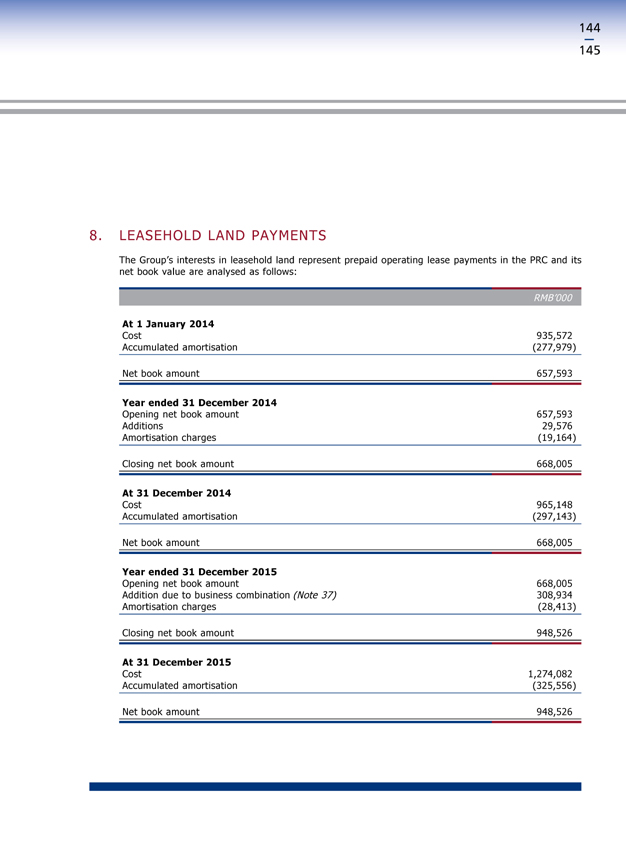
144
145
8. LEASEHOLD LAND PAYMENTS
The Group’s interests in leasehold land represent prepaid operating lease payments in the PRC and its net book value are analysed as follows:
RMB’000
At 1 January 2014
Cost 935,572
Accumulated amortisation (277,979)
Net book amount 657,593
Year ended 31 December 2014
Opening net book amount 657,593
Additions 29,576
Amortisation charges (19,164)
Closing net book amount 668,005
At 31 December 2014
Cost 965,148
Accumulated amortisation (297,143)
Net book amount 668,005
Year ended 31 December 2015
Opening net book amount 668,005
Addition due to business combination (Note 37) 308,934
Amortisation charges (28,413)
Closing net book amount 948,526
At 31 December 2015
Cost 1,274,082
Accumulated amortisation (325,556)
Net book amount 948,526
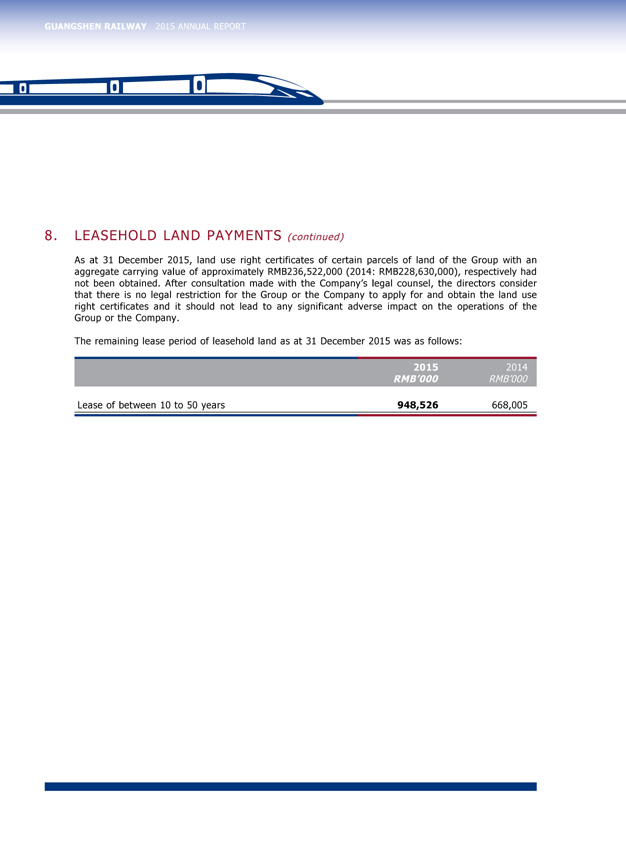
GUANGSHEN RAILWAY 2015 ANNUAL REPORT
8. LEASEHOLD LAND PAYMENTS (continued)
As at 31 December 2015, land use right certificates of certain parcels of land of the Group with an aggregate carrying value of approximately RMB236,522,000 (2014: RMB228,630,000), respectively had not been obtained. After consultation made with the Company’s legal counsel, the directors consider that there is no legal restriction for the Group or the Company to apply for and obtain the land use right certificates and it should not lead to any significant adverse impact on the operations of the Group or the Company.
The remaining lease period of leasehold land as at 31 December 2015 was as follows:
2015 2014
RMB’000 RMB’000
Lease of between 10 to 50 years 948,526 668,005
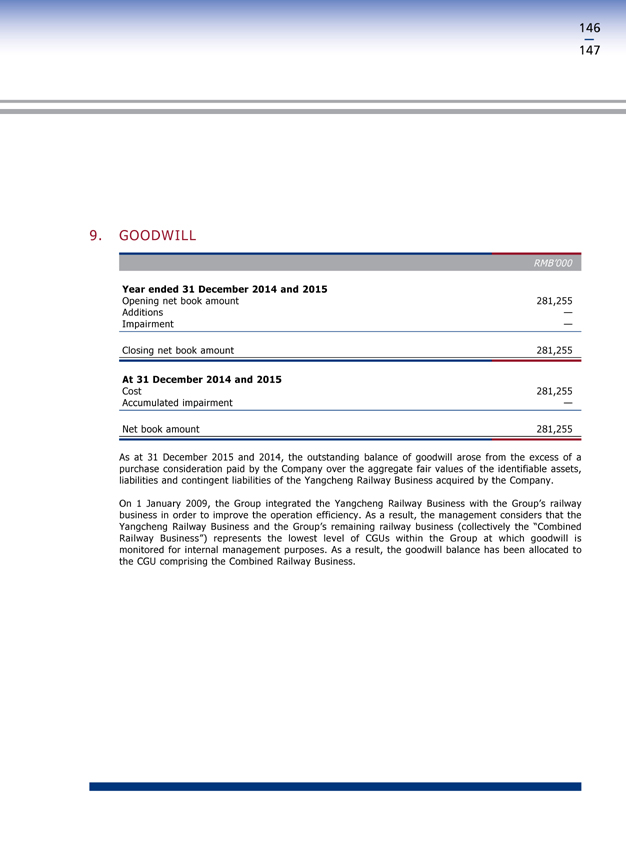
146
147
9. GOODWILL
RMB’000
Year ended 31 December 2014 and 2015
Opening net book amount 281,255
Additions —
Impairment —
Closing net book amount 281,255
At 31 December 2014 and 2015
Cost 281,255
Accumulated impairment —
Net book amount 281,255
As at 31 December 2015 and 2014, the outstanding balance of goodwill arose from the excess of a purchase consideration paid by the Company over the aggregate fair values of the identifiable assets, liabilities and contingent liabilities of the Yangcheng Railway Business acquired by the Company.
On 1 January 2009, the Group integrated the Yangcheng Railway Business with the Group’s railway business in order to improve the operation efficiency. As a result, the management considers that the Yangcheng Railway Business and the Group’s remaining railway business (collectively the “Combined Railway Business”) represents the lowest level of CGUs within the Group at which goodwill is monitored for internal management purposes. As a result, the goodwill balance has been allocated to the CGU comprising the Combined Railway Business.
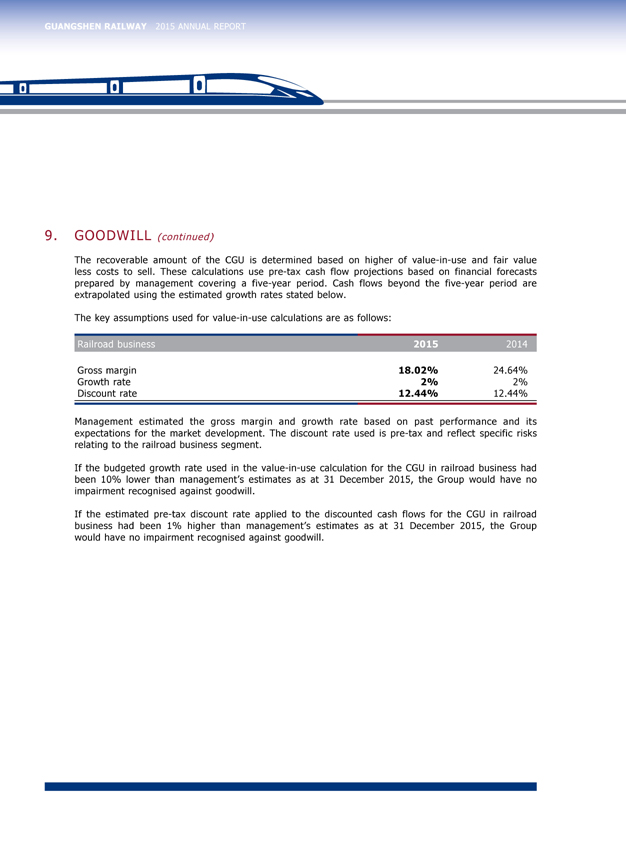
GUANGSHEN RAILWAY 2015 ANNUAL REPORT
9. GOODWILL (continued)
The recoverable amount of the CGU is determined based on higher of value-in-use and fair value less costs to sell. These calculations use pre-tax cash flow projections based on financial forecasts prepared by management covering a five-year period. Cash flows beyond the five-year period are extrapolated using the estimated growth rates stated below.
The key assumptions used for value-in-use calculations are as follows:
Railroad business 2015 2014
Gross margin 18.02% 24.64%
Growth rate 2% 2%
Discount rate 12.44% 12.44%
Management estimated the gross margin and growth rate based on past performance and its expectations for the market development. The discount rate used is pre-tax and reflect specific risks relating to the railroad business segment.
If the budgeted growth rate used in the value-in-use calculation for the CGU in railroad business had been 10% lower than management’s estimates as at 31 December 2015, the Group would have no impairment recognised against goodwill.
If the estimated pre-tax discount rate applied to the discounted cash flows for the CGU in railroad business had been 1% higher than management’s estimates as at 31 December 2015, the Group would have no impairment recognised against goodwill.
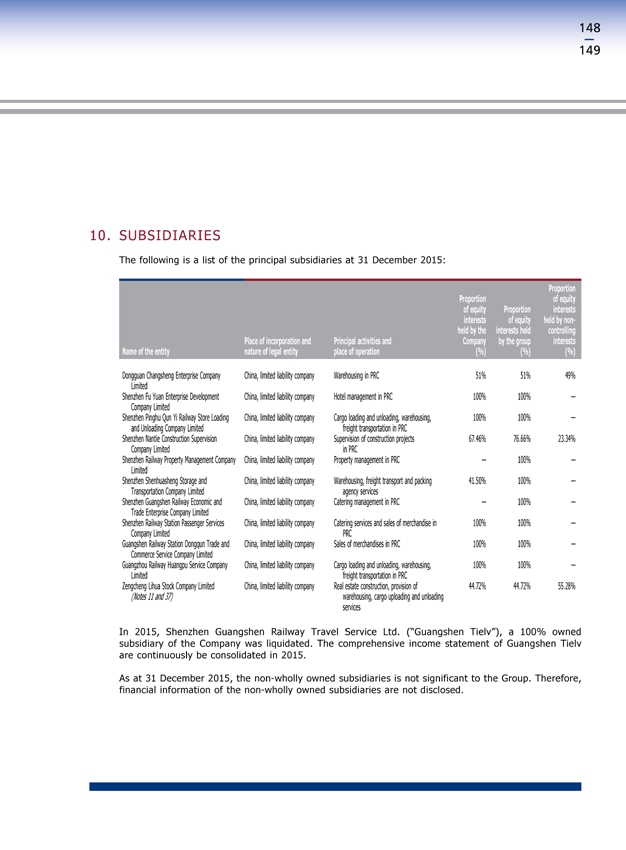
148
149
10. |
| SUBSIDIARIES |
The following is a list of the principal subsidiaries at 31 December 2015:
Proportion
Proportion of equity
of equity Proportion interests
interests of equity held by non-
held by the interests held controlling
Place of incorporation and Principal activities and Company by the group interests
Name of the entity nature of legal entity place of operation (%) (%) (%)
Dongguan Changsheng Enterprise Company China, limited liability company Warehousing in PRC 51% 51% 49%
Limited
Shenzhen Fu Yuan Enterprise Development China, limited liability company Hotel management in PRC 100% 100% —
Company Limited
Shenzhen Pinghu Qun Yi Railway Store Loading China, limited liability company Cargo loading and unloading, warehousing, 100% 100% —
and Unloading Company Limited freight transportation in PRC
Shenzhen Nantie Construction Supervision China, limited liability company Supervision of construction projects 67.46% 76.66% 23.34%
Company Limited in PRC
Shenzhen Railway Property Management Company China, limited liability company Property management in PRC — 100% —
Limited
Shenzhen Shenhuasheng Storage and China, limited liability company Warehousing, freight transport and packing 41.50% 100% —
Transportation Company Limited agency services
Shenzhen Guangshen Railway Economic and China, limited liability company Catering management in PRC — 100% —
Trade Enterprise Company Limited
Shenzhen Railway Station Passenger Services China, limited liability company Catering services and sales of merchandise in 100% 100% —
Company Limited PRC
Guangshen Railway Station Dongqun Trade and China, limited liability company Sales of merchandises in PRC 100% 100% —
Commerce Service Company Limited
Guangzhou Railway Huangpu Service Company China, limited liability company Cargo loading and unloading, warehousing, 100% 100% —
Limited freight transportation in PRC
Zengcheng Lihua Stock Company Limited China, limited liability company Real estate construction, provision of 44.72% 44.72% 55.28%
(Notes 11 and 37) warehousing, cargo uploading and unloading
services
In 2015, Shenzhen Guangshen Railway Travel Service Ltd. (“Guangshen Tielv”), a 100% owned subsidiary of the Company was liquidated. The comprehensive income statement of Guangshen Tielv are continuously be consolidated in 2015.
As at 31 December 2015, the non-wholly owned subsidiaries is not significant to the Group. Therefore, financial information of the non-wholly owned subsidiaries are not disclosed.
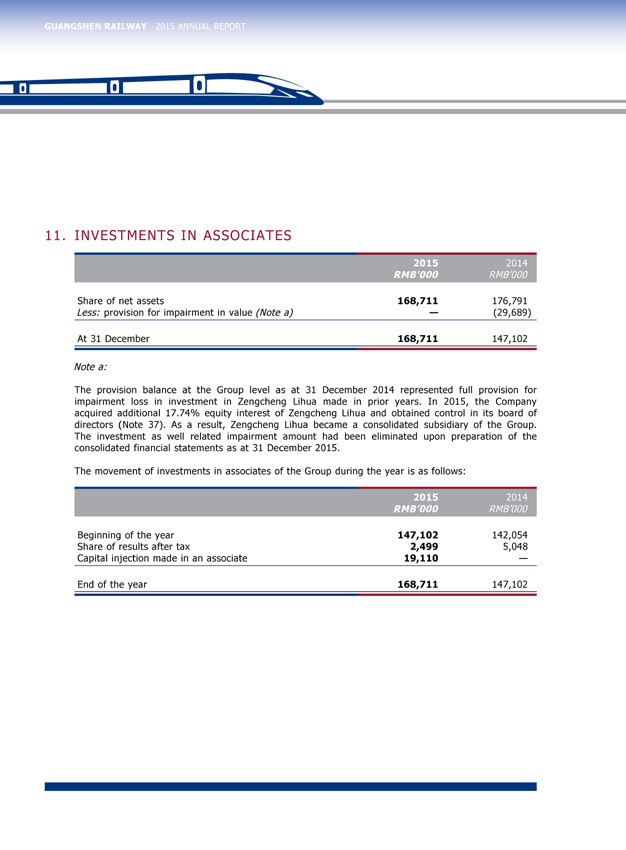
GUANGSHEN RAILWAY 2015 ANNUAL REPORT
11. |
| INVESTMENTS IN ASSOCIATES |
2015 2014
RMB’000 RMB’000
Share of net assets 168,711 176,791
Less: provision for impairment in value (Note a) — (29,689)
At 31 December 168,711 147,102
Note a:
The provision balance at the Group level as at 31 December 2014 represented full provision for impairment loss in investment in Zengcheng Lihua made in prior years. In 2015, the Company acquired additional 17.74% equity interest of Zengcheng Lihua and obtained control in its board of directors (Note 37). As a result, Zengcheng Lihua became a consolidated subsidiary of the Group. The investment as well related impairment amount had been eliminated upon preparation of the consolidated financial statements as at 31 December 2015.
The movement of investments in associates of the Group during the year is as follows:
2015 2014
RMB’000 RMB’000
Beginning of the year 147,102 142,054
Share of results after tax 2,499 5,048
Capital injection made in an associate 19,110 —
End of the year 168,711 147,102
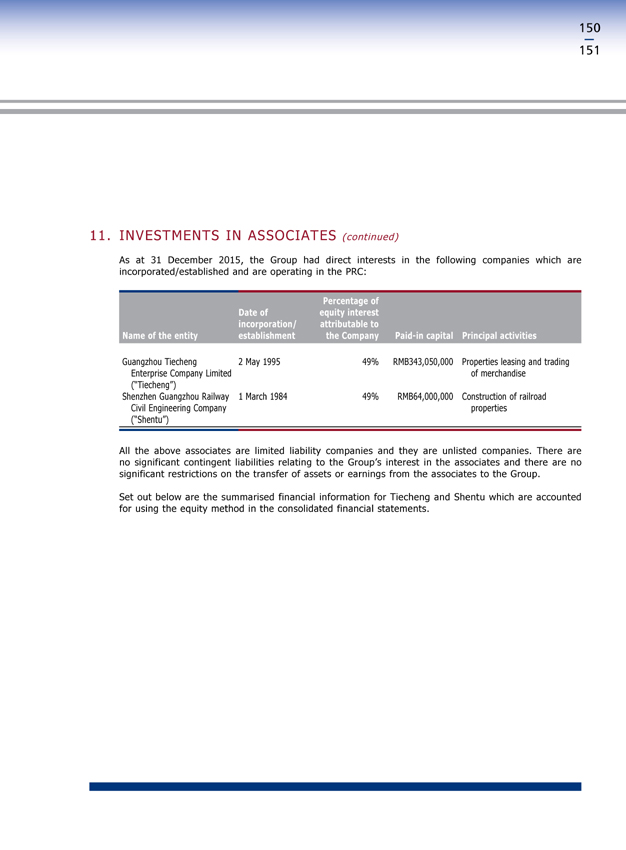
150
151
11. |
| INVESTMENTS IN ASSOCIATES (continued) |
As at 31 December 2015, the Group had direct interests in the following companies which are incorporated/established and are operating in the PRC:
Percentage of
Date of equity interest
incorporation/ attributable to
Name of the entity establishment the Company Paid-in capital Principal activities
Guangzhou Tiecheng 2 May 1995 49% RMB343,050,000 Properties leasing and trading
Enterprise Company Limited of merchandise
(“Tiecheng”)
Shenzhen Guangzhou Railway 1 March 1984 49% RMB64,000,000 Construction of railroad
Civil Engineering Company properties
(“Shentu”)
All the above associates are limited liability companies and they are unlisted companies. There are no significant contingent liabilities relating to the Group’s interest in the associates and there are no significant restrictions on the transfer of assets or earnings from the associates to the Group.
Set out below are the summarised financial information for Tiecheng and Shentu which are accounted for using the equity method in the consolidated financial statements.
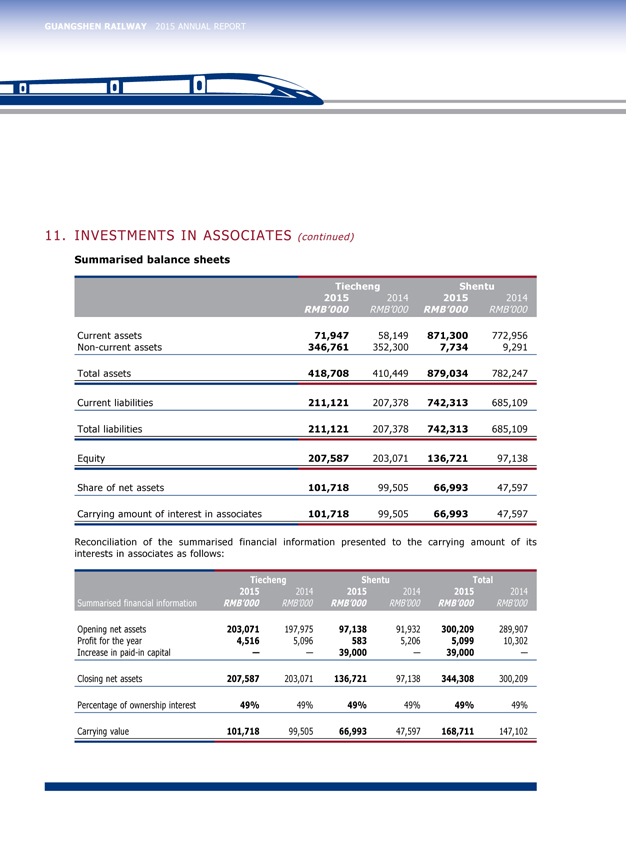
GUANGSHEN RAILWAY 2015 ANNUAL REPORT
11. |
| INVESTMENTS IN ASSOCIATES (continued) |
Summarised balance sheets
Tiecheng Shentu
2015 2014 2015 2014
RMB’000 RMB’000 RMB’000 RMB’000
Current assets 71,947 58,149 871,300 772,956
Non-current assets 346,761 352,300 7,734 9,291
Total assets 418,708 410,449 879,034 782,247
Current liabilities 211,121 207,378 742,313 685,109
Total liabilities 211,121 207,378 742,313 685,109
Equity 207,587 203,071 136,721 97,138
Share of net assets 101,718 99,505 66,993 47,597
Carrying amount of interest in associates 101,718 99,505 66,993 47,597
Reconciliation of the summarised financial information presented to the carrying amount of its interests in associates as follows:
Tiecheng Shentu Total
2015 2014 2015 2014 2015 2014
Summarised financial information RMB’000 RMB’000 RMB’000 RMB’000 RMB’000 RMB’000
Opening net assets 203,071 197,975 97,138 91,932 300,209 289,907
Profit for the year 4,516 5,096 583 5,206 5,099 10,302
Increase in paid-in capital — — 39,000 — 39,000 —
Closing net assets 207,587 203,071 136,721 97,138 344,308 300,209
Percentage of ownership interest 49% 49% 49% 49% 49% 49%
Carrying value 101,718 99,505 66,993 47,597 168,711 147,102
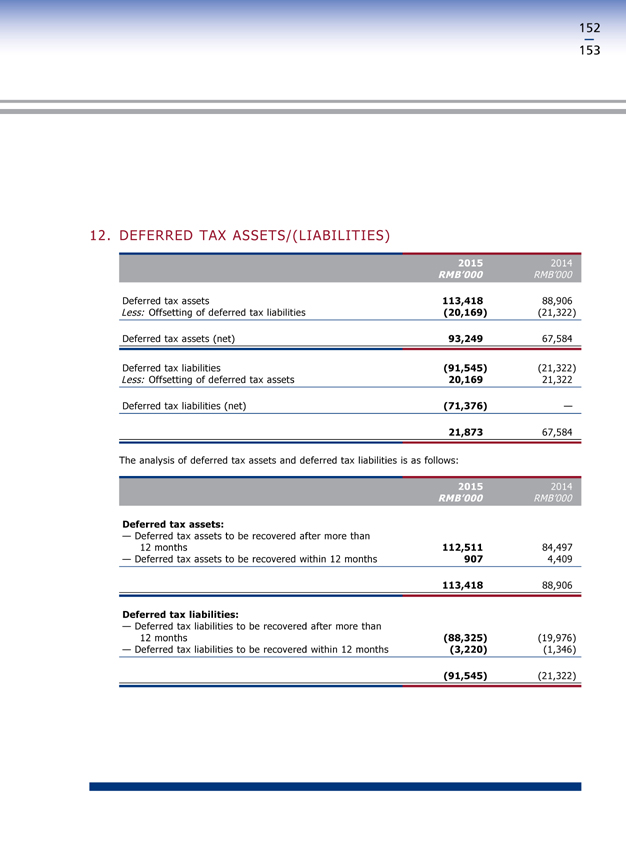
152
153
12. |
| DEFERRED TAX ASSETS/(LIABILITIES) |
2015 2014
RMB’000 RMB’000
Deferred tax assets 113,418 88,906
Less: Offsetting of deferred tax liabilities (20,169) (21,322)
Deferred tax assets (net) 93,249 67,584
Deferred tax liabilities (91,545) (21,322)
Less: Offsetting of deferred tax assets 20,169 21,322
Deferred tax liabilities (net) (71,376) —
21,873 67,584
The analysis of deferred tax assets and deferred tax liabilities is as follows:
2015 2014
RMB’000 RMB’000
Deferred tax assets:
— Deferred tax assets to be recovered after more than
12 months 112,511 84,497
— Deferred tax assets to be recovered within 12 months 907 4,409
113,418 88,906
Deferred tax liabilities:
— Deferred tax liabilities to be recovered after more than
12 months (88,325) (19,976)
— Deferred tax liabilities to be recovered within 12 months (3,220) (1,346)
(91,545) (21,322)
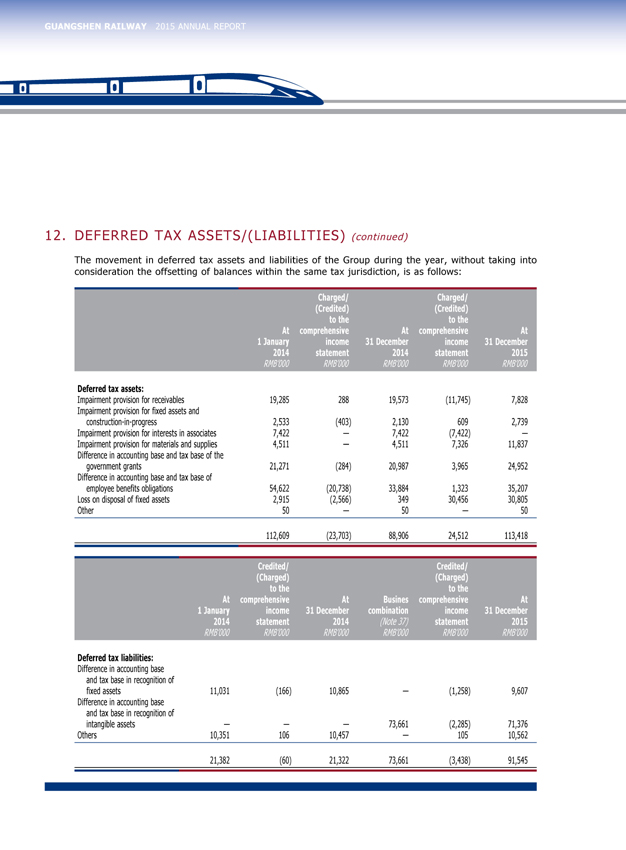
GUANGSHEN RAILWAY 2015 ANNUAL REPORT
12. |
| DEFERRED TAX ASSETS/(LIABILITIES) (continued) |
The movement in deferred tax assets and liabilities of the Group during the year, without taking into consideration the offsetting of balances within the same tax jurisdiction, is as follows:
Charged/ Charged/
(Credited) (Credited)
to the to the
At comprehensive At comprehensive At
1 |
| January income 31 December income 31 December |
2014 statement 2014 statement 2015
RMB’000 RMB’000 RMB’000 RMB’000 RMB’000
Deferred tax assets:
Impairment provision for receivables 19,285 288 19,573 (11,745) 7,828
Impairment provision for fixed assets and
construction-in-progress 2,533 (403) 2,130 609 2,739
Impairment provision for interests in associates 7,422 — 7,422 (7,422) —
Impairment provision for materials and supplies 4,511 — 4,511 7,326 11,837
Difference in accounting base and tax base of the
government grants 21,271 (284) 20,987 3,965 24,952
Difference in accounting base and tax base of
employee benefits obligations 54,622 (20,738) 33,884 1,323 35,207
Loss on disposal of fixed assets 2,915 (2,566) 349 30,456 30,805
Other 50 — 50 — 50
112,609 (23,703) 88,906 24,512 113,418
Credited/ Credited/
(Charged) (Charged)
to the to the
At comprehensive At Busines comprehensive At
1 |
| January income 31 December combination income 31 December |
2014 statement 2014 (Note 37) statement 2015
RMB’000 RMB’000 RMB’000 RMB’000 RMB’000 RMB’000
Deferred tax liabilities:
Difference in accounting base
and tax base in recognition of
fixed assets 11,031 (166) 10,865 — (1,258) 9,607
Difference in accounting base
and tax base in recognition of
intangible assets — — — 73,661 (2,285) 71,376
Others 10,351 106 10,457 — 105 10,562
21,382 (60) 21,322 73,661 (3,438) 91,545
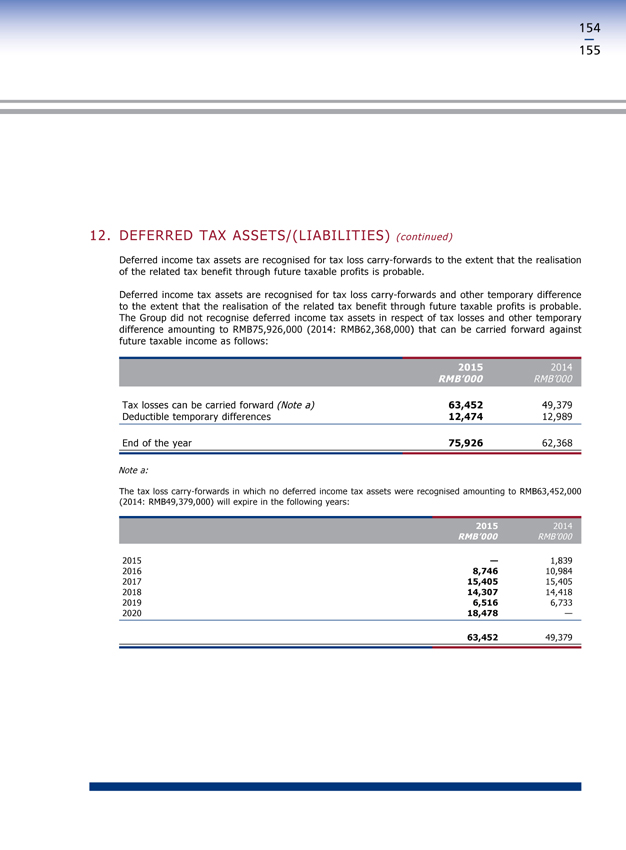
154 155
12. |
| DEFERRED TAX ASSETS/(LIABILITIES) (continued) |
Deferred income tax assets are recognised for tax loss carry-forwards to the extent that the realisation of the related tax benefit through future taxable profits is probable.
Deferred income tax assets are recognised for tax loss carry-forwards and other temporary difference to the extent that the realisation of the related tax benefit through future taxable profits is probable. The Group did not recognise deferred income tax assets in respect of tax losses and other temporary difference amounting to RMB75,926,000 (2014: RMB62,368,000) that can be carried forward against future taxable income as follows:
2015 2014
RMB’000 RMB’000
Tax losses can be carried forward (Note a) 63,452 49,379
Deductible temporary differences 12,474 12,989
End of the year 75,926 62,368
Note a:
The tax loss carry-forwards in which no deferred income tax assets were recognised amounting to RMB63,452,000 (2014: RMB49,379,000) will expire in the following years:
2015 2014
RMB’000 RMB’000
2015 — 1,839
2016 8,746 10,984
2017 15,405 15,405
2018 14,307 14,418
2019 6,516 6,733
2020 18,478 —
63,452 49,379
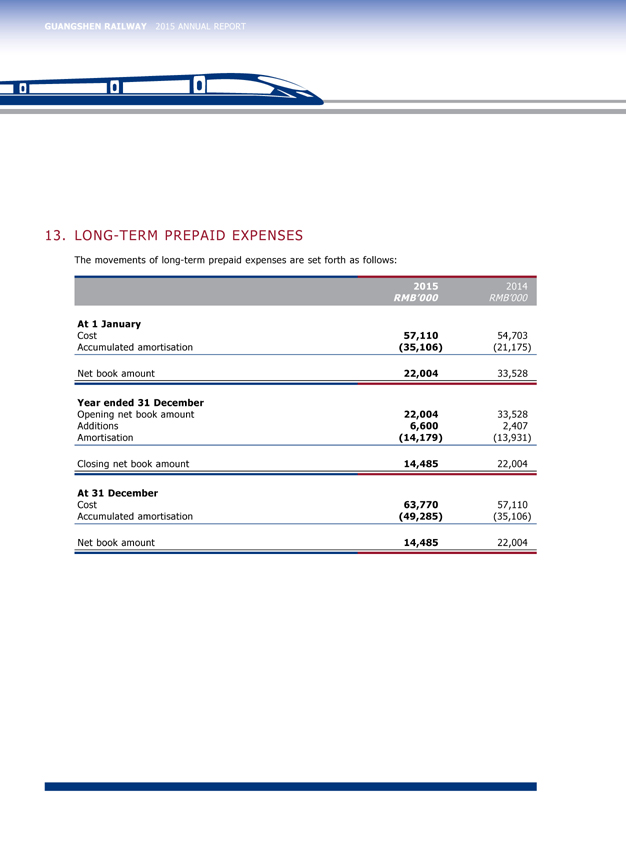
GUANGSHEN RAILWAY 2015 ANNUAL REPORT
13. |
| LONG-TERM PREPAID EXPENSES |
The movements of long-term prepaid expenses are set forth as follows:
2015 2014
RMB’000 RMB’000
At 1 January
Cost 57,110 54,703
Accumulated amortisation (35,106) (21,175)
Net book amount 22,004 33,528
Year ended 31 December
Opening net book amount 22,004 33,528
Additions 6,600 2,407
Amortisation (14,179) (13,931)
Closing net book amount 14,485 22,004
At 31 December
Cost 63,770 57,110
Accumulated amortisation (49,285) (35,106)
Net book amount 14,485 22,004
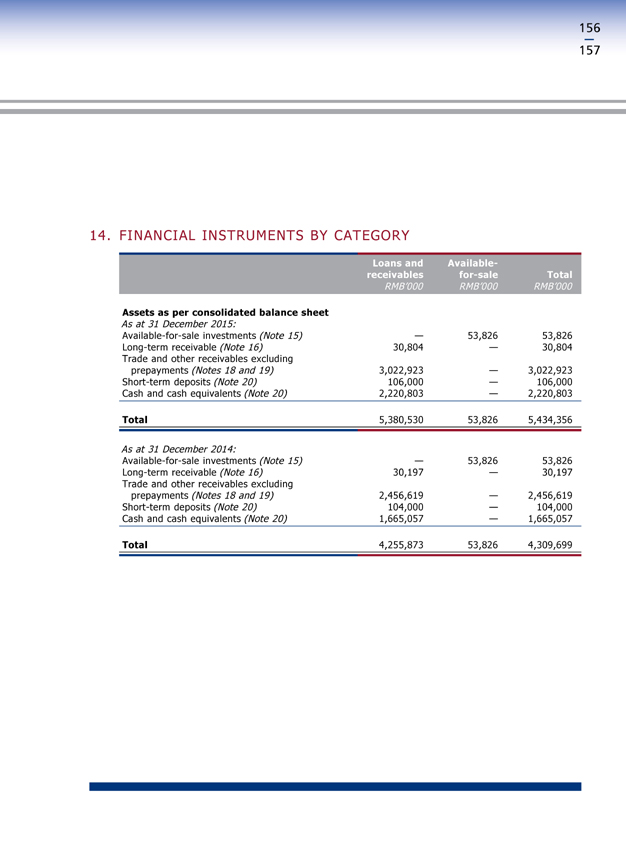
156
157
14. |
| FINANCIAL INSTRUMENTS BY CATEGORY |
Loans and Available-
receivables for-sale Total
RMB’000 RMB’000 RMB’000
Assets as per consolidated balance sheet
As at 31 December 2015:
Available-for-sale investments (Note 15) — 53,826 53,826
Long-term receivable (Note 16) 30,804 — 30,804
Trade and other receivables excluding
prepayments (Notes 18 and 19) 3,022,923 — 3,022,923
Short-term deposits (Note 20) 106,000 — 106,000
Cash and cash equivalents (Note 20) 2,220,803 — 2,220,803
Total 5,380,530 53,826 5,434,356
As at 31 December 2014:
Available-for-sale investments (Note 15) — 53,826 53,826
Long-term receivable (Note 16) 30,197 — 30,197
Trade and other receivables excluding
prepayments (Notes 18 and 19) 2,456,619 — 2,456,619
Short-term deposits (Note 20) 104,000 — 104,000
Cash and cash equivalents (Note 20) 1,665,057 — 1,665,057
Total 4,255,873 53,826 4,309,699
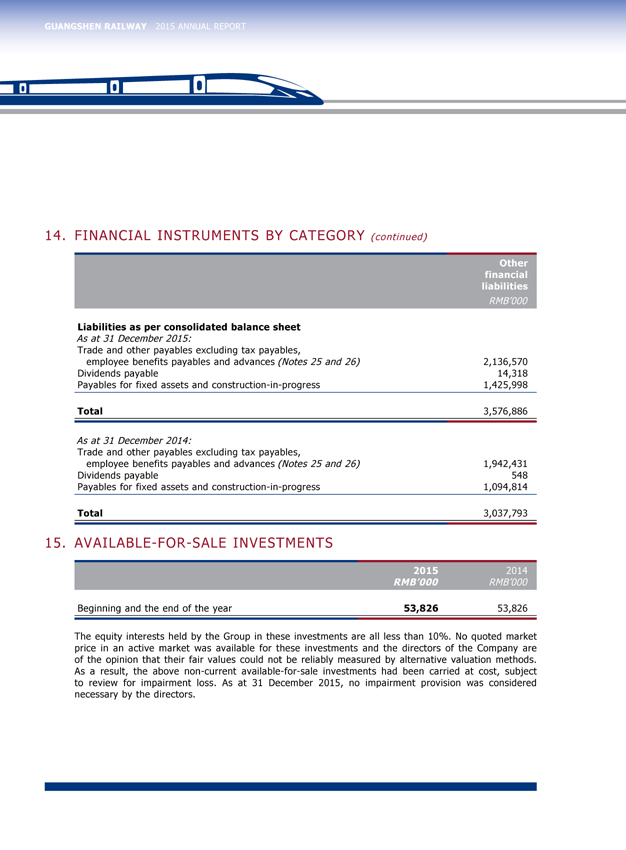
GUANGSHEN RAILWAY 2015 ANNUAL REPORT
14. |
| FINANCIAL INSTRUMENTS BY CATEGORY (continued) |
Other
financial
liabilities
RMB’000
Liabilities as per consolidated balance sheet
As at 31 December 2015:
Trade and other payables excluding tax payables,
employee benefits payables and advances (Notes 25 and 26) 2,136,570
Dividends payable 14,318
Payables for fixed assets and construction-in-progress 1,425,998
Total 3,576,886
As at 31 December 2014:
Trade and other payables excluding tax payables,
employee benefits payables and advances (Notes 25 and 26) 1,942,431
Dividends payable 548
Payables for fixed assets and construction-in-progress 1,094,814
Total 3,037,793
15. |
| AVAILABLE-FOR-SALE INVESTMENTS |
15 2014
RMB’000 RMB’000
Beginning and the end of the year 53,826 53,826
The equity interests held by the Group in these investments are all less than 10%. No quoted market price in an active market was available for these investments and the directors of the Company are of the opinion that their fair values could not be reliably measured by alternative valuation methods. As a result, the above non-current available-for-sale investments had been carried at cost, subject to review for impairment loss. As at 31 December 2015, no impairment provision was considered necessary by the directors.
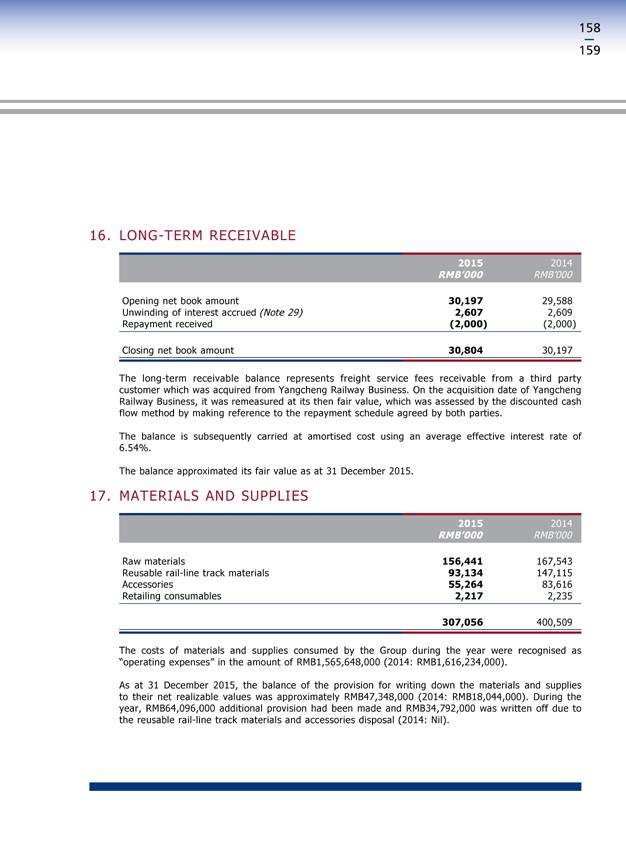
158
159
16. |
| LONG-TERM RECEIVABLE |
2015 2014
RMB’000 RMB’000
Opening net book amount 30,197 29,588
Unwinding of interest accrued (Note 29) 2,607 2,609
Repayment received (2,000) (2,000)
Closing net book amount 30,804 30,197
The long-term receivable balance represents freight service fees receivable from a third party customer which was acquired from Yangcheng Railway Business. On the acquisition date of Yangcheng Railway Business, it was remeasured at its then fair value, which was assessed by the discounted cash flow method by making reference to the repayment schedule agreed by both parties.
The balance is subsequently carried at amortised cost using an average effective interest rate of 6.54%.
The balance approximated its fair value as at 31 December 2015.
17. |
| MATERIALS AND SUPPLIES |
2015 2014
RMB’000 RMB’000
Raw materials 156,441 167,543
Reusable rail-line track materials 93,134 147,115
Accessories 55,264 83,616
Retailing consumables 2,217 2,235
307,056 400,509
The costs of materials and supplies consumed by the Group during the year were recognised as “operating expenses” in the amount of RMB1,565,648,000 (2014: RMB1,616,234,000).
As at 31 December 2015, the balance of the provision for writing down the materials and supplies to their net realizable values was approximately RMB47,348,000 (2014: RMB18,044,000). During the year, RMB64,096,000 additional provision had been made and RMB34,792,000 was written off due to the reusable rail-line track materials and accessories disposal (2014: Nil).
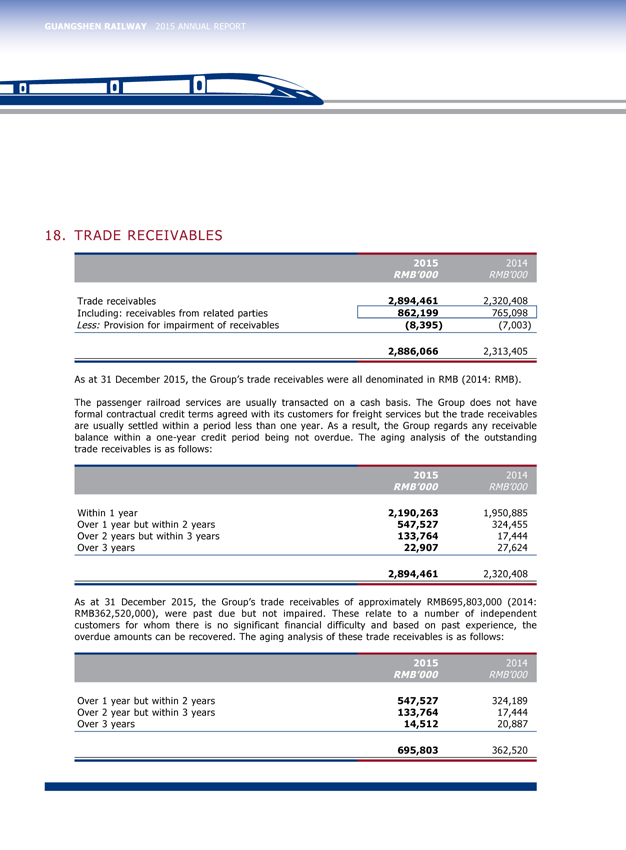
GUANGSHEN RAILWAY 2015 ANNUAL REPORT
18. |
| TRADE RECEIVABLES |
2015 2014
RMB’000 RMB’000
Trade receivables 2,894,461 2,320,408
Including: receivables from related parties 862,199 765,098
Less: Provision for impairment of receivables(8,395)(7,003)
2,886,066 2,313,405
As at 31 December 2015, the Group’s trade receivables were all denominated in RMB (2014: RMB).
The passenger railroad services are usually transacted on a cash basis. The Group does not have formal contractual credit terms agreed with its customers for freight services but the trade receivables are usually settled within a period less than one year. As a result, the Group regards any receivable balance within a one-year credit period being not overdue. The aging analysis of the outstanding trade receivables is as follows:
2015 2014
RMB’000 RMB’000
Within 1 year 2,190,263 1,950,885
Over 1 year but within 2 years 547,527 324,455
Over 2 years but within 3 years 133,764 17,444
Over 3 years 22,907 27,624
2,894,461 2,320,408
As at 31 December 2015, the Group’s trade receivables of approximately RMB695,803,000 (2014: RMB362,520,000), were past due but not impaired. These relate to a number of independent customers for whom there is no significant financial difficulty and based on past experience, the overdue amounts can be recovered. The aging analysis of these trade receivables is as follows:
2015 2014
RMB’000 RMB’000
Over 1 year but within 2 years 547,527 324,189
Over 2 year but within 3 years 133,764 17,444
Over 3 years 14,512 20,887
695,803 362,520

160
161
18. |
| TRADE RECEIVABLES (continued) |
As at 31 December 2015, the Group’s trade receivables of approximately RMB8,395,000 (2014: RMB7,003,000), had been impaired and provided for. The amount of the provision made by the Group was approximately RMB8,395,000 as at 31 December 2015 (2014: RMB7,003,000). The impaired receivable balances were mainly related to the provision of freight transportation services. The related customers were in unexpected difficult financial conditions. The aging analysis of these receivables is as follows:
2015 2014
RMB’000 RMB’000
Over 1 year but within 2 years — 266
Over 3 years 8,395 6,737
8,395 7,003
Movements on the provision for impairment of trade receivables are as follows:
2015 2014
RMB’000 RMB’000
At 1 January 7,003 6,195
Provision for impairment loss 3,305 808
Reversal(127) —
Written-off(1,786) —
At 31 December 8,395 7,003
The creation and release of provision for impaired receivables have been included in operating expenses in the comprehensive income statement. Amounts charged to the allowance account are generally written off against the gross accounts receivable balances when there is no expectation of recovering additional cash.
The maximum exposure to credit risk at the reporting date is the carrying value mentioned above. The Group does not hold any collateral as security.

GUANGSHEN RAILWAY 2015 ANNUAL REPORT
19. |
| PREPAYMENTS AND OTHER RECEIVABLES |
2015 2014
RMB’000 RMB’000
Due from third parties 134,825 141,843
Due from other related parties 7,788 47,733
142,613 189,576
2015 2014
RMB’000 RMB’000
Other receivables 150,234 205,274
Less: Provision for impairment loss(13,377)(62,060)
Other receivables, net (Note (a)) 136,857 143,214
Prepayments (Note (b)) 5,756 46,362
142,613 189,576
(a) Other receivables mainly represent miscellaneous deposits and receivables arising from the course of provision of non-railway transportation services by the Group.
(b) Prepayments mainly represent amounts paid in advance to the suppliers for utilities and other operating expenses of the Group.
Movements on the provision for impairment of other receivables are as follows:
2015 2014
RMB’000 RMB’000
At 1 January 62,060 61,718
Provision for impairment loss 62 346
Reversal of impairment loss provision(7,699)(4)
Written-off(28,734) —
Elimination arising from business combination
(Note 37)(12,312) —
At 31 December 13,377 62,060
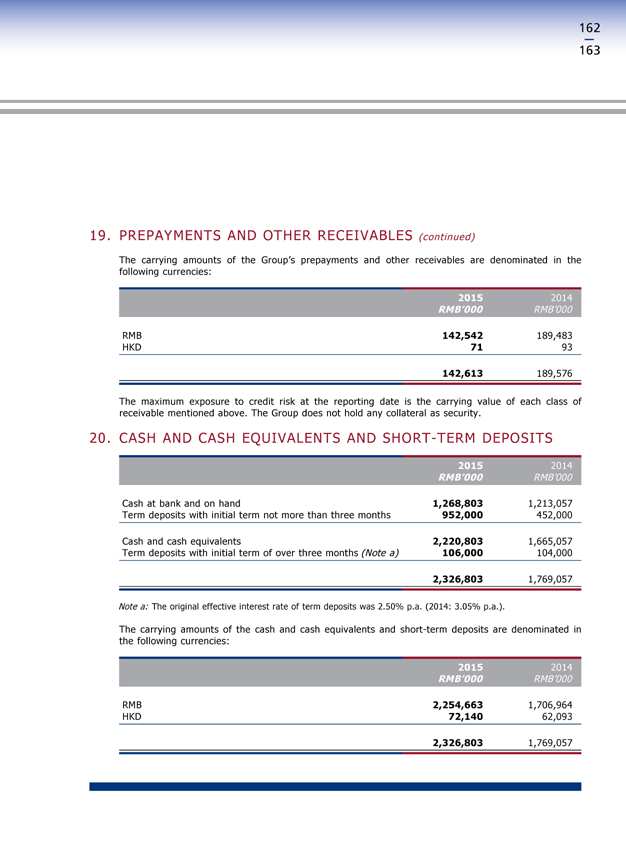
162
163
19. |
| PREPAYMENTS AND OTHER RECEIVABLES (continued) |
The carrying amounts of the Group’s prepayments and other receivables are denominated in the following currencies:
2015 2014
RMB’000 RMB’000
RMB 142,542 189,483
HKD 71 93
142,613 189,576
The maximum exposure to credit risk at the reporting date is the carrying value of each class of receivable mentioned above. The Group does not hold any collateral as security.
20. |
| CASH AND CASH EQUIVALENTS AND SHORT-TERM DEPOSITS |
2015 2014
RMB’000 RMB’000
Cash at bank and on hand 1,268,803 1,213,057
Term deposits with initial term not more than three months 952,000 452,000
Cash and cash equivalents 2,220,803 1,665,057
Term deposits with initial term of over three months (Note a) 106,000 104,000
2,326,803 1,769,057
Note a: The original effective interest rate of term deposits was 2.50% p.a. (2014: 3.05% p.a.).
The carrying amounts of the cash and cash equivalents and short-term deposits are denominated in the following currencies:
015 2014
RMB’000 RMB’000
RMB 2,254,663 1,706,964
HKD 72,140 62,093
2,326,803 1,769,057
GUANGSHEN RAILWAY 2015 ANNUAL REPORT
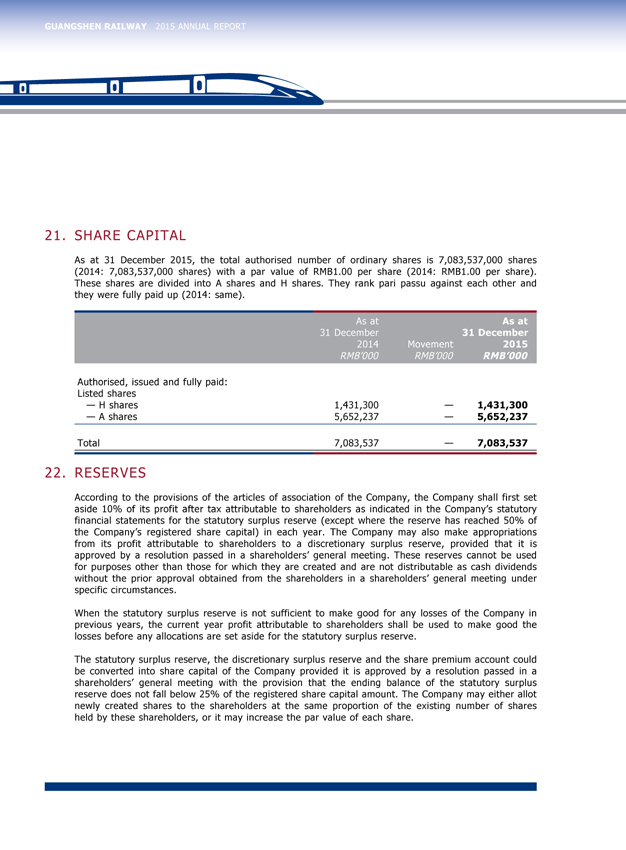
21. |
| SHARE CAPITAL |
As at 31 December 2015, the total authorised number of ordinary shares is 7,083,537,000 shares (2014: 7,083,537,000 shares) with a par value of RMB1.00 per share (2014: RMB1.00 per share). These shares are divided into A shares and H shares. They rank pari passu against each other and they were fully paid up (2014: same).
at As at
31 December 31 December
2014 Movement 2015
RMB’000 RMB’000 RMB’000
Authorised, issued and fully paid:
Listed shares
— H shares 1,431,300 — 1,431,300
— A shares 5,652,237 — 5,652,237
Total 7,083,537 — 7,083,537
22. |
| RESERVES |
According to the provisions of the articles of association of the Company, the Company shall first set aside 10% of its profit after tax attributable to shareholders as indicated in the Company’s statutory financial statements for the statutory surplus reserve (except where the reserve has reached 50% of the Company’s registered share capital) in each year. The Company may also make appropriations from its profit attributable to shareholders to a discretionary surplus reserve, provided that it is approved by a resolution passed in a shareholders’ general meeting. These reserves cannot be used for purposes other than those for which they are created and are not distributable as cash dividends without the prior approval obtained from the shareholders in a shareholders’ general meeting under specific circumstances.
When the statutory surplus reserve is not sufficient to make good for any losses of the Company in previous years, the current year profit attributable to shareholders shall be used to make good the losses before any allocations are set aside for the statutory surplus reserve.
The statutory surplus reserve, the discretionary surplus reserve and the share premium account could be converted into share capital of the Company provided it is approved by a resolution passed in a shareholders’ general meeting with the provision that the ending balance of the statutory surplus reserve does not fall below 25% of the registered share capital amount. The Company may either allot newly created shares to the shareholders at the same proportion of the existing number of shares held by these shareholders, or it may increase the par value of each share.
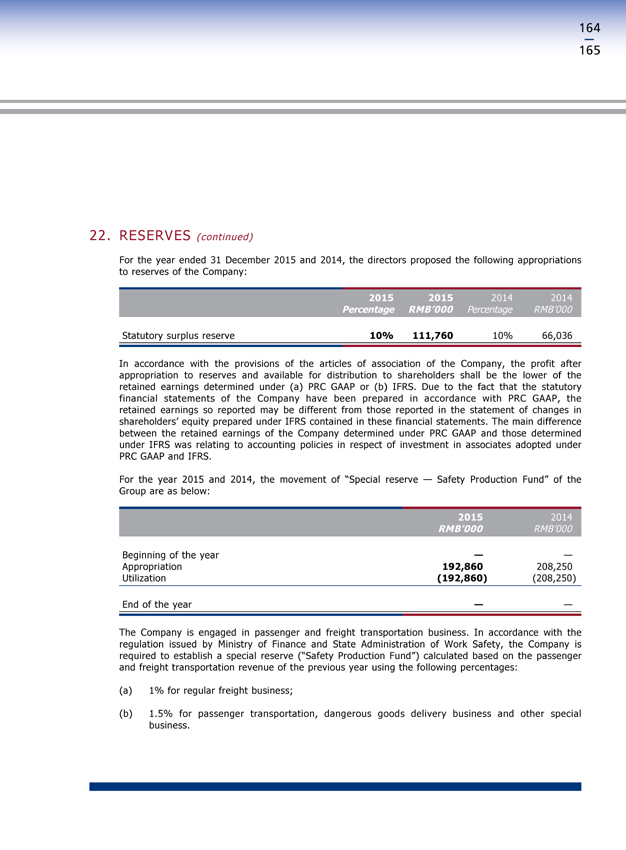
164 165
22. |
| RESERVES (continued) |
For the year ended 31 December 2015 and 2014, the directors proposed the following appropriations to reserves of the Company:
2015 2015 2014 2014
Percentage RMB’000 Percentage RMB’000
Statutory surplus reserve 10% 111,760 10% 66,036
In accordance with the provisions of the articles of association of the Company, the profit after appropriation to reserves and available for distribution to shareholders shall be the lower of the retained earnings determined under (a) PRC GAAP or (b) IFRS. Due to the fact that the statutory financial statements of the Company have been prepared in accordance with PRC GAAP, the retained earnings so reported may be different from those reported in the statement of changes in shareholders’ equity prepared under IFRS contained in these financial statements. The main difference between the retained earnings of the Company determined under PRC GAAP and those determined under IFRS was relating to accounting policies in respect of investment in associates adopted under PRC GAAP and IFRS.
For the year 2015 and 2014, the movement of “Special reserve — Safety Production Fund” of the Group are as below:
2015 2014
RMB’000 RMB’000
Beginning of the year — —
Appropriation 192,860 208,250
Utilization(192,860)(208,250)
End of the year — —
The Company is engaged in passenger and freight transportation business. In accordance with the regulation issued by Ministry of Finance and State Administration of Work Safety, the Company is required to establish a special reserve (“Safety Production Fund”) calculated based on the passenger and freight transportation revenue of the previous year using the following percentages:
(a) |
| 1% for regular freight business; |
(b) |
| 1.5% for passenger transportation, dangerous goods delivery business and other special business. |
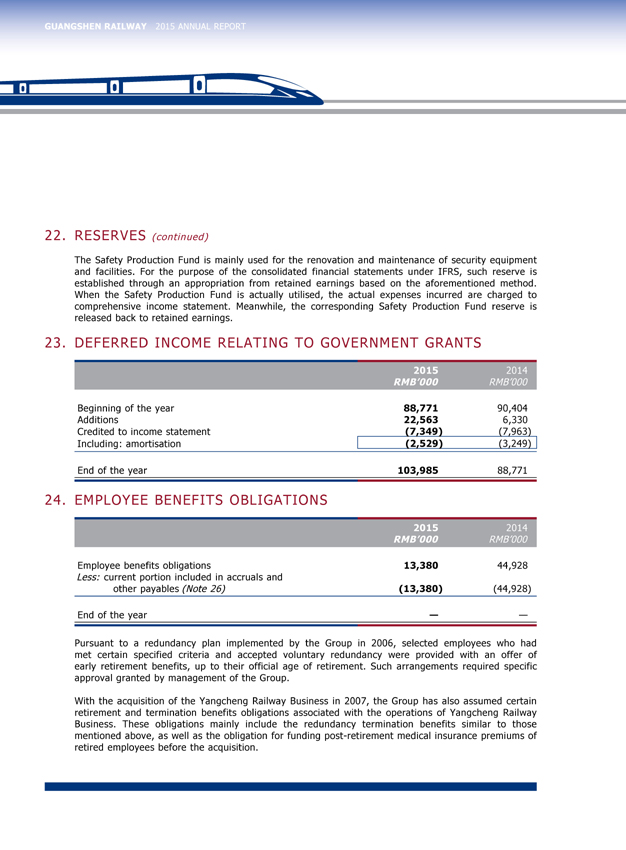
GUANGSHEN RAILWAY 2015 ANNUAL REPORT
22. |
| RESERVES (continued) |
The Safety Production Fund is mainly used for the renovation and maintenance of security equipment and facilities. For the purpose of the consolidated financial statements under IFRS, such reserve is established through an appropriation from retained earnings based on the aforementioned method. When the Safety Production Fund is actually utilised, the actual expenses incurred are charged to comprehensive income statement. Meanwhile, the corresponding Safety Production Fund reserve is released back to retained earnings.
23. |
| DEFERRED INCOME RELATING TO GOVERNMENT GRANTS |
2015 2014
RMB’000 RMB’000
Beginning of the year 88,771 90,404
Additions 22,563 6,330
Credited to income statement (7,349) (7,963)
Including: amortisation (2,529) (3,249)
End of the year 103,985 88,771
24. |
| EMPLOYEE BENEFITS OBLIGATIONS |
2015 2014
RMB’000 RMB’000
Employee benefits obligations 13,380 44,928
Less: current portion included in accruals and
other payables (Note 26) (13,380) (44,928)
End of the year — —
Pursuant to a redundancy plan implemented by the Group in 2006, selected employees who had met certain specified criteria and accepted voluntary redundancy were provided with an offer of early retirement benefits, up to their official age of retirement. Such arrangements required specific approval granted by management of the Group.
With the acquisition of the Yangcheng Railway Business in 2007, the Group has also assumed certain retirement and termination benefits obligations associated with the operations of Yangcheng Railway Business. These obligations mainly include the redundancy termination benefits similar to those mentioned above, as well as the obligation for funding post-retirement medical insurance premiums of retired employees before the acquisition.
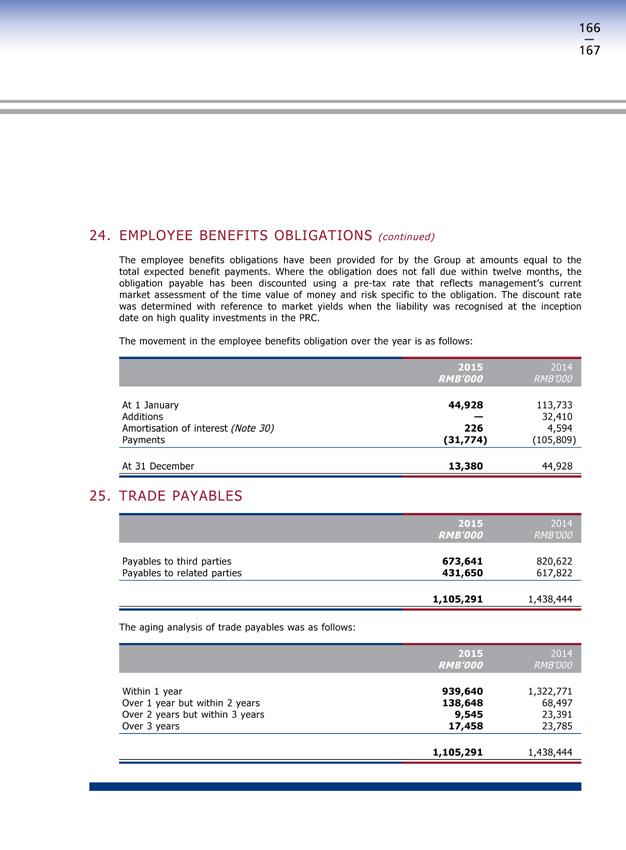
166
167
24. |
| EMPLOYEE BENEFITS OBLIGATIONS (continued) |
The employee benefits obligations have been provided for by the Group at amounts equal to the total expected benefit payments. Where the obligation does not fall due within twelve months, the obligation payable has been discounted using a pre-tax rate that reflects management’s current market assessment of the time value of money and risk specific to the obligation. The discount rate was determined with reference to market yields when the liability was recognised at the inception date on high quality investments in the PRC.
The movement in the employee benefits obligation over the year is as follows:
2015 2014
RMB’000 RMB’000
At 1 January 44,928 113,733
Additions — 32,410
Amortisation of interest (Note 30) 226 4,594
Payments (31,774) (105,809)
At 31 December 13,380 44,928
25. |
| TRADE PAYABLES |
2015 2014
RMB’000 RMB’000
Payables to third parties 673,641 820,622
Payables to related parties 431,650 617,822
1,105,291 1,438,444
The aging analysis of trade payables was as follows:
2015 2014
RMB’000 RMB’000
Within 1 year 939,640 1,322,771
Over 1 year but within 2 years 138,648 68,497
Over 2 years but within 3 years 9,545 23,391
Over 3 years 17,458 23,785
1,105,291 1,438,444
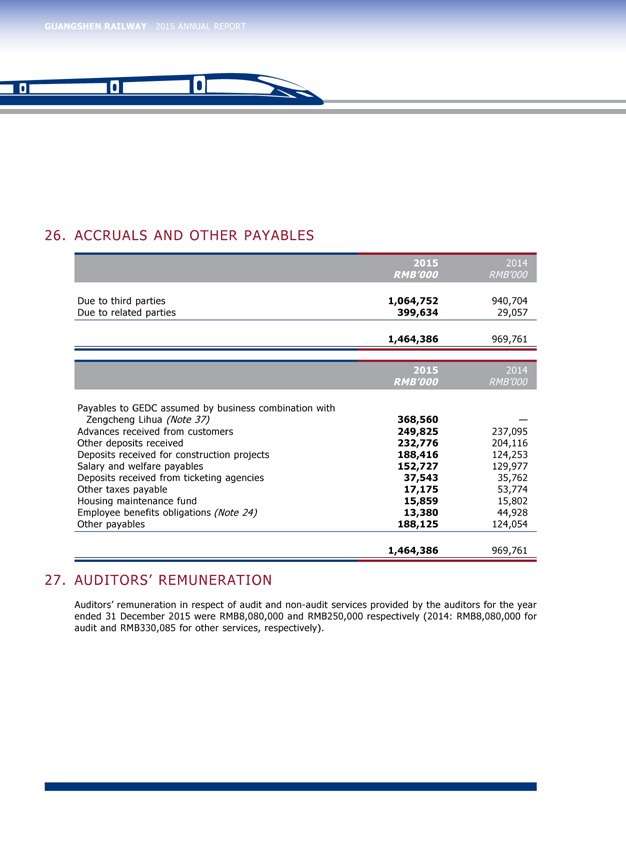
GUANGSHEN RAILWAY 2015 ANNUAL REPORT
26. |
| ACCRUALS AND OTHER PAYABLES |
2015 2014
RMB’000 RMB’000
Due to third parties 1,064,752 940,704
Due to related parties 399,634 29,057
1,464,386 969,761
2015 2014
RMB’000 RMB’000
Payables to GEDC assumed by business combination with
Zengcheng Lihua (Note 37) 368,560 —
Advances received from customers 249,825 237,095
Other deposits received 232,776 204,116
Deposits received for construction projects 188,416 124,253
Salary and welfare payables 152,727 129,977
Deposits received from ticketing agencies 37,543 35,762
Other taxes payable 17,175 53,774
Housing maintenance fund 15,859 15,802
Employee benefits obligations (Note 24) 13,380 44,928
Other payables 188,125 124,054
1,464,386 969,761
27. |
| AUDITORS’ REMUNERATION |
Auditors’ remuneration in respect of audit and non-audit services provided by the auditors for the year ended 31 December 2015 were RMB8,080,000 and RMB250,000 respectively (2014: RMB8,080,000 for audit and RMB330,085 for other services, respectively).
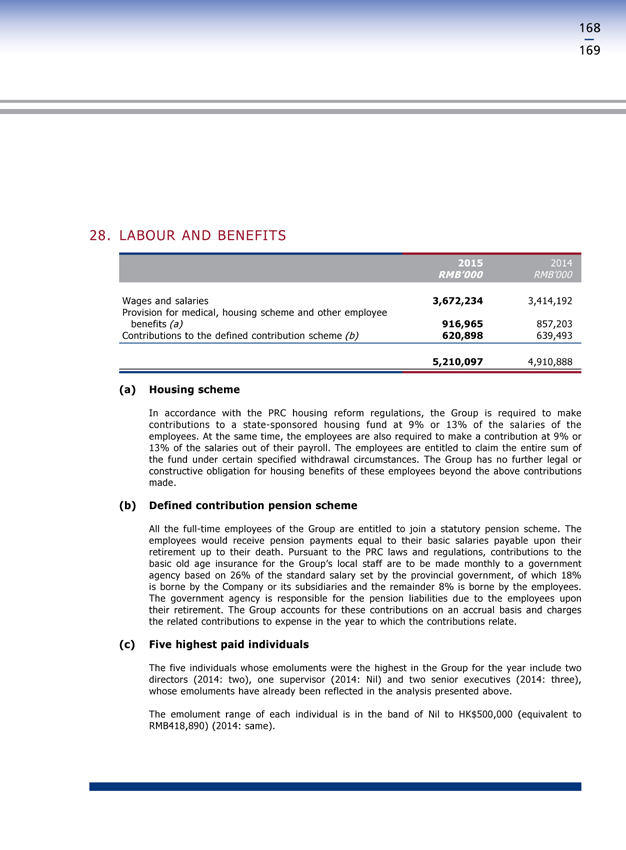
168
169
28. |
| LABOUR AND BENEFITS |
2015 2014
RMB’000 RMB’000
Wages and salaries 3,672,234 3,414,192
Provision for medical, housing scheme and other employee
benefits (a) 916,965 857,203
Contributions to the defined contribution scheme (b) 620,898 639,493
5,210,097 4,910,888
(a) |
| Housing scheme |
In accordance with the PRC housing reform regulations, the Group is required to make contributions to a state-sponsored housing fund at 9% or 13% of the salaries of the employees. At the same time, the employees are also required to make a contribution at 9% or 13% of the salaries out of their payroll. The employees are entitled to claim the entire sum of the fund under certain specified withdrawal circumstances. The Group has no further legal or constructive obligation for housing benefits of these employees beyond the above contributions made.
(b) |
| Defined contribution pension scheme |
All the full-time employees of the Group are entitled to join a statutory pension scheme. The employees would receive pension payments equal to their basic salaries payable upon their retirement up to their death. Pursuant to the PRC laws and regulations, contributions to the basic old age insurance for the Group’s local staff are to be made monthly to a government agency based on 26% of the standard salary set by the provincial government, of which 18% is borne by the Company or its subsidiaries and the remainder 8% is borne by the employees. The government agency is responsible for the pension liabilities due to the employees upon their retirement. The Group accounts for these contributions on an accrual basis and charges the related contributions to expense in the year to which the contributions relate.
(c) |
| Five highest paid individuals |
The five individuals whose emoluments were the highest in the Group for the year include two directors (2014: two), one supervisor (2014: Nil) and two senior executives (2014: three), whose emoluments have already been reflected in the analysis presented above.
The emolument range of each individual is in the band of Nil to HK$500,000 (equivalent to RMB418,890) (2014: same).
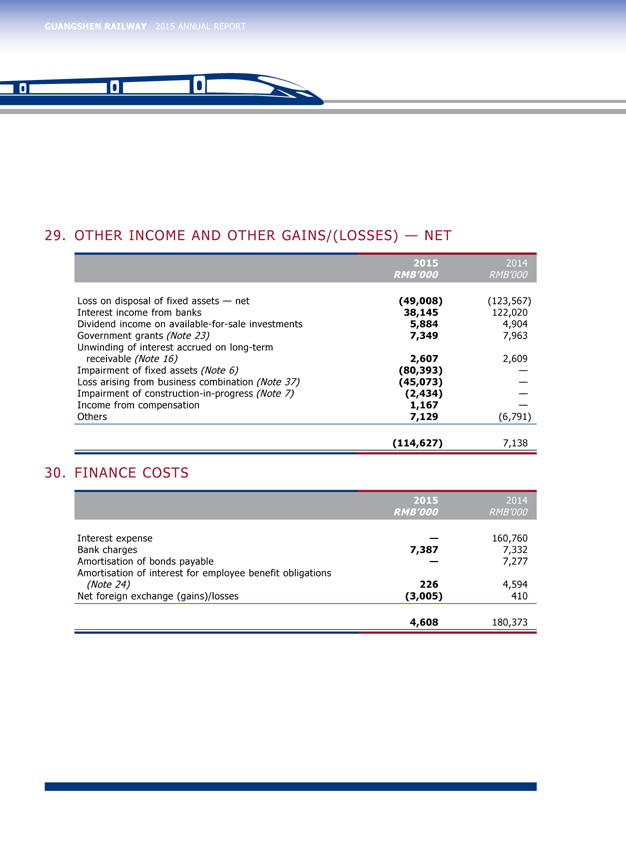
GUANGSHEN RAILWAY 2015 ANNUAL REPORT
29. |
| OTHER INCOME AND OTHER GAINS/(LOSSES) — NET |
2015 2014
RMB’000 RMB’000
Loss on disposal of fixed assets — net (49,008) (123,567)
Interest income from banks 38,145 122,020
Dividend income on available-for-sale investments 5,884 4,904
Government grants (Note 23) 7,349 7,963
Unwinding of interest accrued on long-term
receivable (Note 16) 2,607 2,609
Impairment of fixed assets (Note 6) (80,393) —
Loss arising from business combination (Note 37) (45,073) —
Impairment of construction-in-progress (Note 7) (2,434) —
Income from compensation 1,167 —
Others 7,129 (6,791)
(114,627) 7,138
30. |
| FINANCE COSTS |
015 2014
RMB’000 RMB’000
Interest expense — 160,760
Bank charges 7,387 7,332
Amortisation of bonds payable — 7,277
Amortisation of interest for employee benefit obligations
(Note 24) 226 4,594
Net foreign exchange (gains)/losses (3,005) 410
4,608 180,373
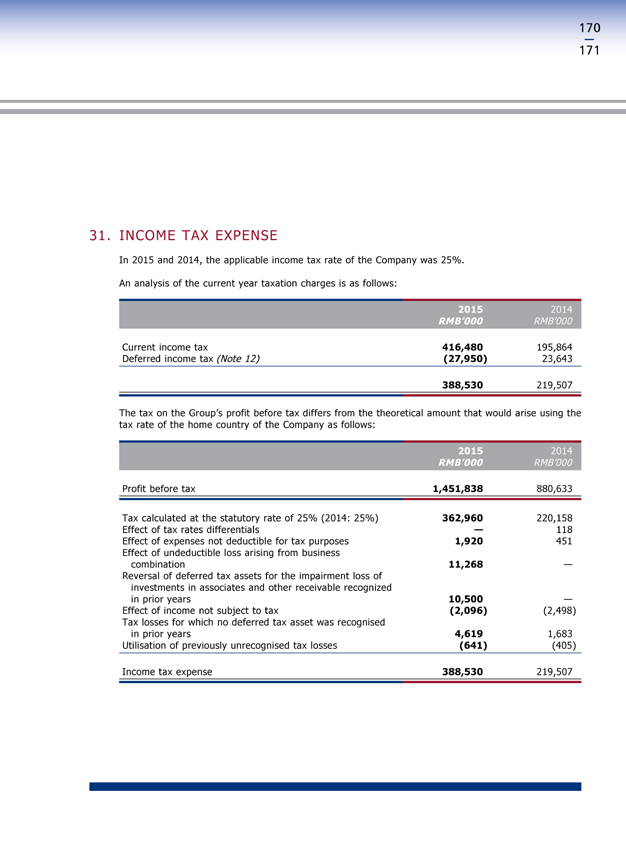
170
171
31. |
| INCOME TAX EXPENSE |
In 2015 and 2014, the applicable income tax rate of the Company was 25%.
An analysis of the current year taxation charges is as follows:
015 2014
RMB’000 RMB’000
Current income tax 416,480 195,864
Deferred income tax (Note 12) (27,950) 23,643
388,530 219,507
The tax on the Group’s profit before tax differs from the theoretical amount that would arise using the tax rate of the home country of the Company as follows:
2015 2014
RMB’000 RMB’000
Profit before tax 1,451,838 880,633
Tax calculated at the statutory rate of 25% (2014: 25%) 362,960 220,158
Effect of tax rates differentials — 118
Effect of expenses not deductible for tax purposes 1,920 451
Effect of undeductible loss arising from business
combination 11,268 —
Reversal of deferred tax assets for the impairment loss of
investments in associates and other receivable recognized
in prior years 10,500 —
Effect of income not subject to tax (2,096) (2,498)
Tax losses for which no deferred tax asset was recognised
in prior years 4,619 1,683
Utilisation of previously unrecognised tax losses (641) (405)
Income tax expense 388,530 219,507
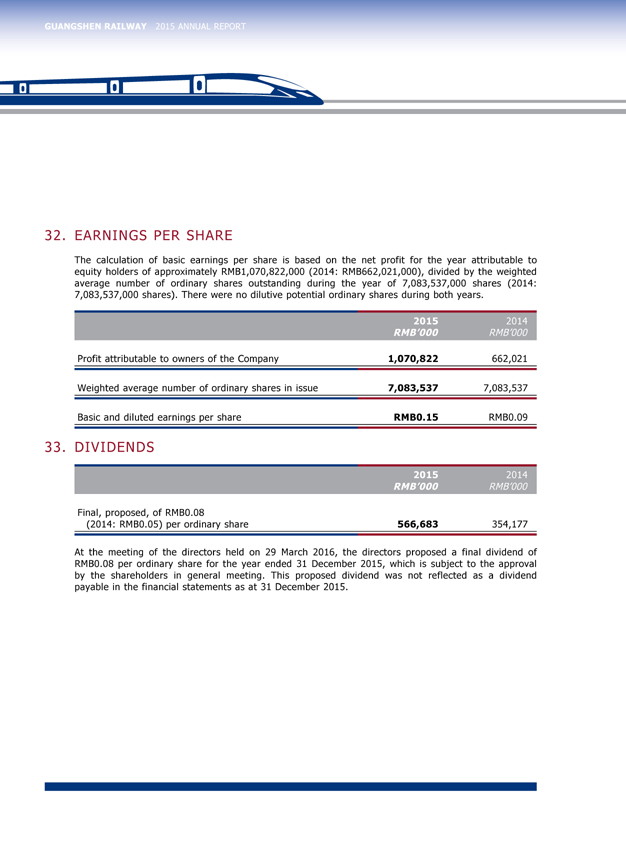
GUANGSHEN RAILWAY 2015 ANNUAL REPORT
32. |
| EARNINGS PER SHARE |
The calculation of basic earnings per share is based on the net profit for the year attributable to equity holders of approximately RMB1,070,822,000 (2014: RMB662,021,000), divided by the weighted average number of ordinary shares outstanding during the year of 7,083,537,000 shares (2014: 7,083,537,000 shares). There were no dilutive potential ordinary shares during both years.
2015 2014
RMB’000 RMB’000
Profit attributable to owners of the Company 1,070,822 662,021
Weighted average number of ordinary shares in issue 7,083,537 7,083,537
Basic and diluted earnings per share RMB0.15 RMB0.09
33. |
| DIVIDENDS |
015 2014
RMB’000 RMB’000
Final, proposed, of RMB0.08
(2014: RMB0.05) per ordinary share 566,683 354,177
At the meeting of the directors held on 29 March 2016, the directors proposed a final dividend of RMB0.08 per ordinary share for the year ended 31 December 2015, which is subject to the approval by the shareholders in general meeting. This proposed dividend was not reflected as a dividend payable in the financial statements as at 31 December 2015.
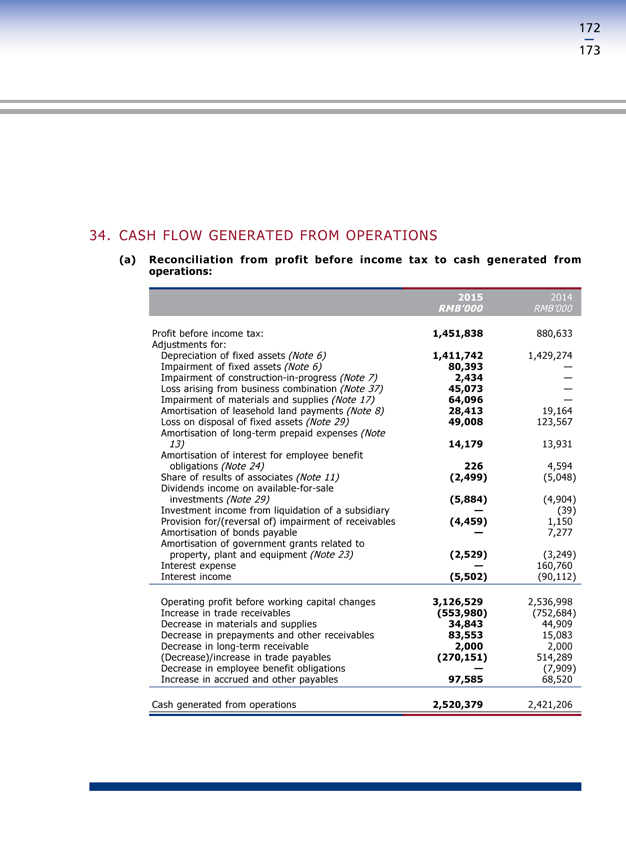
172
173
34. |
| CASH FLOW GENERATED FROM OPERATIONS |
(a) |
| Reconciliation operations: from profit before income tax to cash generated from |
2015 2014
RMB’000 RMB’000
Profit before income tax: 1,451,838 880,633
Adjustments for:
Depreciation of fixed assets (Note 6) 1,411,742 1,429,274
Impairment of fixed assets (Note 6) 80,393 —
Impairment of construction-in-progress (Note 7) 2,434 —
Loss arising from business combination (Note 37) 45,073 —
Impairment of materials and supplies (Note 17) 64,096 —
Amortisation of leasehold land payments (Note 8) 28,413 19,164
Loss on disposal of fixed assets (Note 29) 49,008 123,567
Amortisation of long-term prepaid expenses (Note
13) 14,179 13,931
Amortisation of interest for employee benefit
obligations (Note 24) 226 4,594
Share of results of associates (Note 11) (2,499) (5,048)
Dividends income on available-for-sale
investments (Note 29) (5,884) (4,904)
Investment income from liquidation of a subsidiary — (39)
Provision for/(reversal of) impairment of receivables (4,459) 1,150
Amortisation of bonds payable — 7,277
Amortisation of government grants related to
property, plant and equipment (Note 23) (2,529) (3,249)
Interest expense — 160,760
Interest income (5,502) (90,112)
Operating profit before working capital changes 3,126,529 2,536,998
Increase in trade receivables (553,980) (752,684)
Decrease in materials and supplies 34,843 44,909
Decrease in prepayments and other receivables 83,553 15,083
Decrease in long-term receivable 2,000 2,000
(Decrease)/increase in trade payables (270,151) 514,289
Decrease in employee benefit obligations — (7,909)
Increase in accrued and other payables 97,585 68,520
Cash generated from operations 2,520,379 2,421,206
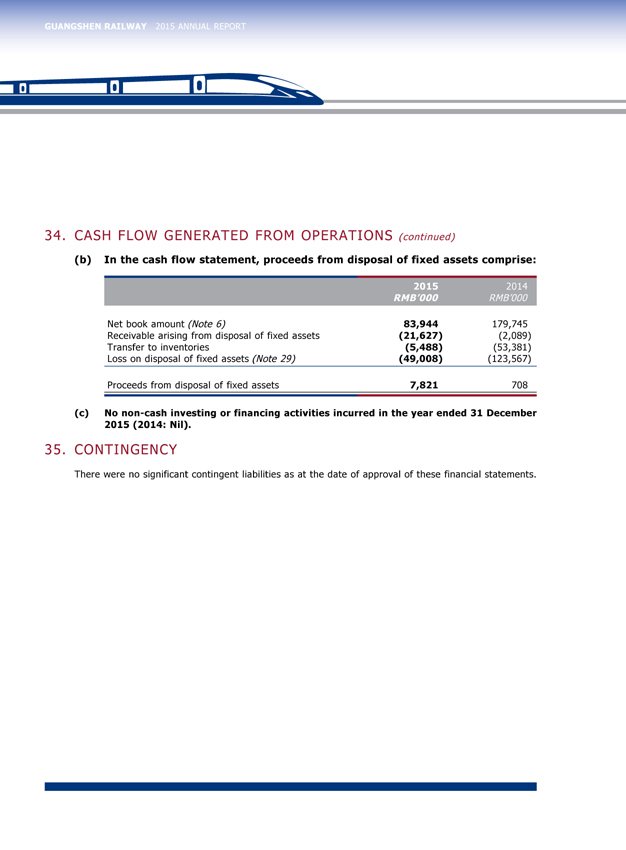
GUANGSHEN RAILWAY 2015 ANNUAL REPORT
CASH FLOW GENERATED FROM OPERATIONS (continued)
(b) |
| In the cash flow statement, proceeds from disposal of fixed assets comprise: |
2015 2014
RMB’000 RMB’000
Net book amount (Note 6) 83,944 179,745
Receivable arising from disposal of fixed assets (21,627) (2,089)
Transfer to inventories (5,488) (53,381)
Loss on disposal of fixed assets (Note 29) (49,008) (123,567)
Proceeds from disposal of fixed assets 7,821 708
(c) |
| No non-cash investing or financing activities incurred in the year ended 31 December 2015 (2014: Nil). |
35. |
| CONTINGENCY |
There were no significant contingent liabilities as at the date of approval of these financial statements.
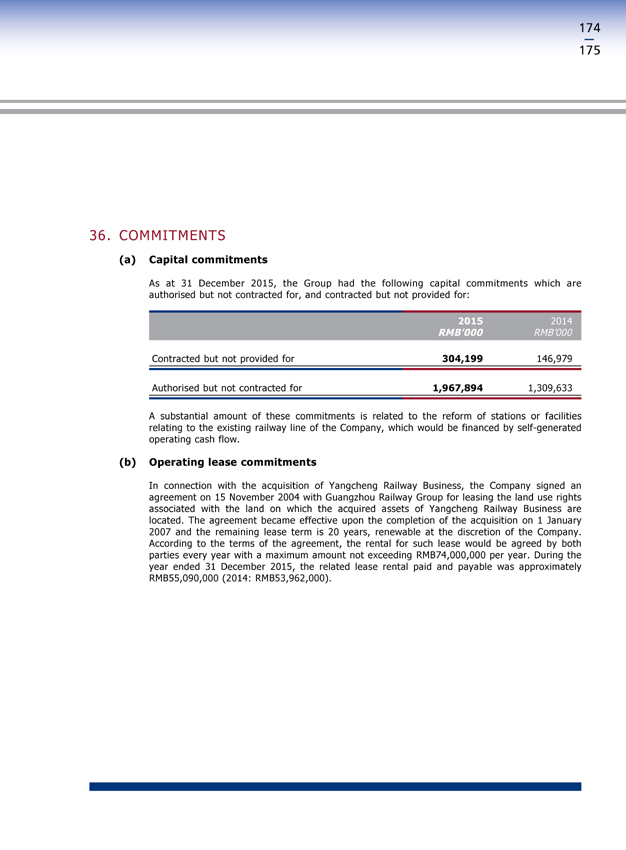
174
175
36. |
| COMMITMENTS |
(a) |
| Capital commitments |
As at 31 December 2015, the Group had the following capital commitments which are authorised but not contracted for, and contracted but not provided for:
2015 2014
RMB’000 RMB’000
Contracted but not provided for 304,199 146,979
Authorised but not contracted for 1,967,894 1,309,633
A substantial amount of these commitments is related to the reform of stations or facilities relating to the existing railway line of the Company, which would be financed by self-generated operating cash flow.
(b) |
| Operating lease commitments |
In connection with the acquisition of Yangcheng Railway Business, the Company signed an agreement on 15 November 2004 with Guangzhou Railway Group for leasing the land use rights associated with the land on which the acquired assets of Yangcheng Railway Business are located. The agreement became effective upon the completion of the acquisition on 1 January 2007 and the remaining lease term is 20 years, renewable at the discretion of the Company. According to the terms of the agreement, the rental for such lease would be agreed by both parties every year with a maximum amount not exceeding RMB74,000,000 per year. During the year ended 31 December 2015, the related lease rental paid and payable was approximately RMB55,090,000 (2014: RMB53,962,000).
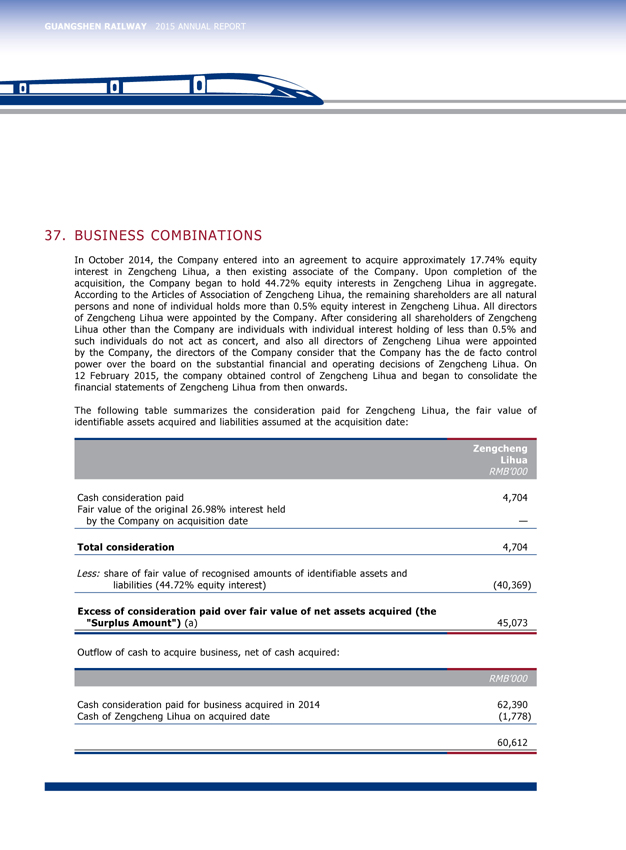
GUANGSHEN RAILWAY 2015 ANNUAL REPORT
37. |
| BUSINESS COMBINATIONS |
In October 2014, the Company entered into an agreement to acquire approximately 17.74% equity interest in Zengcheng Lihua, a then existing associate of the Company. Upon completion of the acquisition, the Company began to hold 44.72% equity interests in Zengcheng Lihua in aggregate. According to the Articles of Association of Zengcheng Lihua, the remaining shareholders are all natural persons and none of individual holds more than 0.5% equity interest in Zengcheng Lihua. All directors of Zengcheng Lihua were appointed by the Company. After considering all shareholders of Zengcheng Lihua other than the Company are individuals with individual interest holding of less than 0.5% and such individuals do not act as concert, and also all directors of Zengcheng Lihua were appointed by the Company, the directors of the Company consider that the Company has the de facto control power over the board on the substantial financial and operating decisions of Zengcheng Lihua. On
12 February 2015, the company obtained control of Zengcheng Lihua and began to consolidate the financial statements of Zengcheng Lihua from then onwards.
The following table summarizes the consideration paid for Zengcheng Lihua, the fair value of identifiable assets acquired and liabilities assumed at the acquisition date:
Zengcheng
Lihua
RMB’000
Cash consideration paid 4,704
Fair value of the original 26.98% interest held
by the Company on acquisition date —
Total consideration 4,704
Less: share of fair value of recognised amounts of identifiable assets and
liabilities (44.72% equity interest) (40,369)
Excess of consideration paid over fair value of net assets acquired (the
“Surplus Amount”) (a)
45,073
Outflow of cash to acquire business, net of cash acquired:
RMB’000
Cash consideration paid for business acquired in 2014 62,390
Cash of Zengcheng Lihua on acquired date (1,778)
60,612
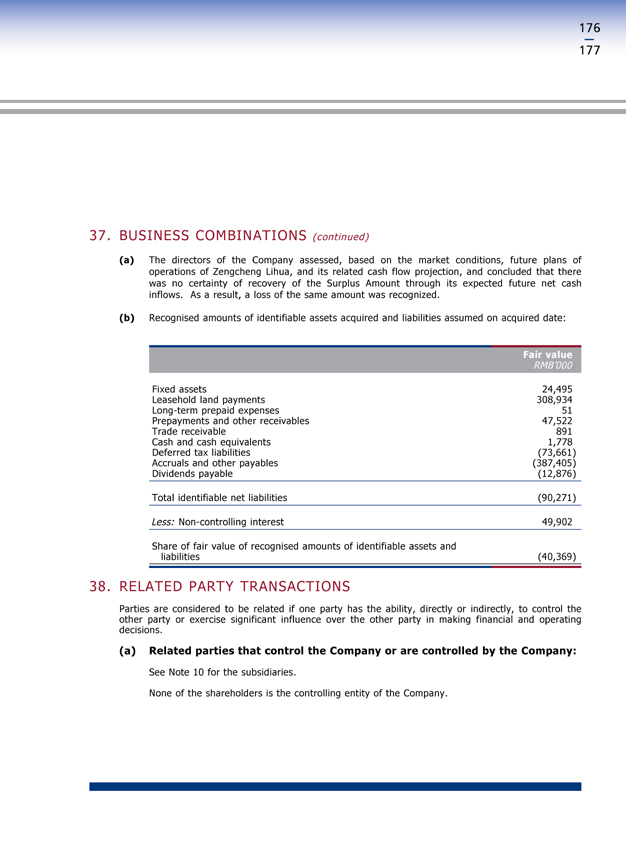
176
177
37. |
| BUSINESS COMBINATIONS (continued) |
(a) The directors of the Company assessed, based on the market conditions, future plans of operations of Zengcheng Lihua, and its related cash flow projection, and concluded that there was no certainty of recovery of the Surplus Amount through its expected future net cash inflows. As a result, a loss of the same amount was recognized.
(b) |
| Recognised amounts of identifiable assets acquired and liabilities assumed on acquired date: |
Fair value
RMB’000
Fixed assets 24,495
Leasehold land payments 308,934
Long-term prepaid expenses 51
Prepayments and other receivables 47,522
Trade receivable 891
Cash and cash equivalents 1,778
Deferred tax liabilities (73,661)
Accruals and other payables (387,405)
Dividends payable (12,876)
Total identifiable net liabilities (90,271)
Less: Non-controlling interest 49,902
Share of fair value of recognised amounts of identifiable assets and
liabilities (40,369)
38. |
| RELATED PARTY TRANSACTIONS |
Parties are considered to be related if one party has the ability, directly or indirectly, to control the other party or exercise significant influence over the other party in making financial and operating decisions.
(a) |
| Related parties that control the Company or are controlled by the Company: |
See Note 10 for the subsidiaries.
None of the shareholders is the controlling entity of the Company.
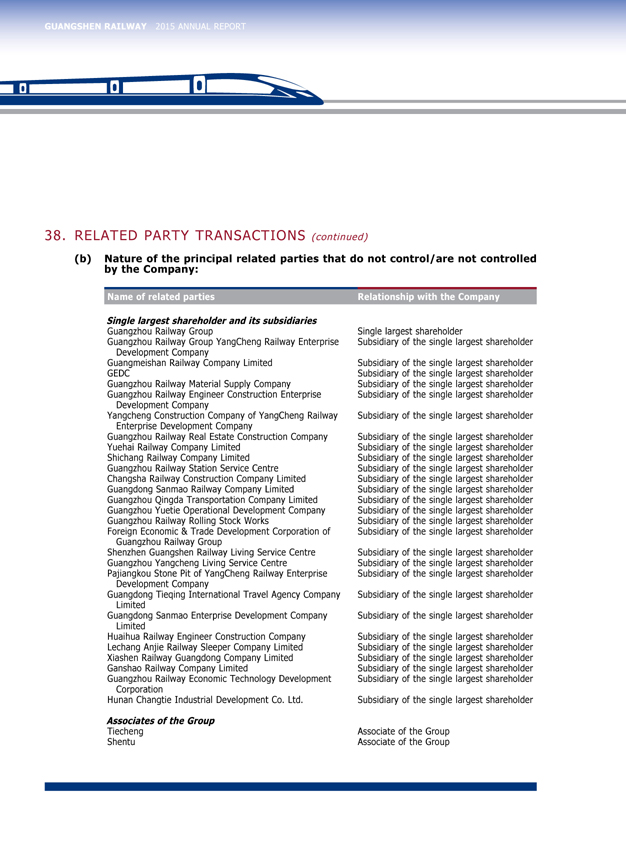
GUANGSHEN RAILWAY 2015 ANNUAL REPORT
RELATED PARTY TRANSACTIONS (continued)
Nature of the principal related parties that do not control/are not controlled by the Company:
Name of related parties Relationship with the Company
Single largest shareholder and its subsidiaries
Guangzhou Railway Group Single largest shareholder
Guangzhou Railway Group YangCheng Railway Enterprise Subsidiary of the single largest shareholder
Development Company
Guangmeishan Railway Company Limited Subsidiary of the single largest shareholder
GEDC Subsidiary of the single largest shareholder
Guangzhou Railway Material Supply Company Subsidiary of the single largest shareholder
Guangzhou Railway Engineer Construction Enterprise Subsidiary of the single largest shareholder
Development Company
Yangcheng Construction Company of YangCheng Railway Subsidiary of the single largest shareholder
Enterprise Development Company
Guangzhou Railway Real Estate Construction Company Subsidiary of the single largest shareholder
Yuehai Railway Company Limited Subsidiary of the single largest shareholder
Shichang Railway Company Limited Subsidiary of the single largest shareholder
Guangzhou Railway Station Service Centre Subsidiary of the single largest shareholder
Changsha Railway Construction Company Limited Subsidiary of the single largest shareholder
Guangdong Sanmao Railway Company Limited Subsidiary of the single largest shareholder
Guangzhou Qingda Transportation Company Limited Subsidiary of the single largest shareholder
Guangzhou Yuetie Operational Development Company Subsidiary of the single largest shareholder
Guangzhou Railway Rolling Stock Works Subsidiary of the single largest shareholder
Foreign Economic & Trade Development Corporation of Subsidiary of the single largest shareholder
Guangzhou Railway Group
Shenzhen Guangshen Railway Living Service Centre Subsidiary of the single largest shareholder
Guangzhou Yangcheng Living Service Centre Subsidiary of the single largest shareholder
Pajiangkou Stone Pit of YangCheng Railway Enterprise Subsidiary of the single largest shareholder
Development Company
Guangdong Tieqing International Travel Agency Company Subsidiary of the single largest shareholder
Limited
Guangdong Sanmao Enterprise Development Company Subsidiary of the single largest shareholder
Limited
Huaihua Railway Engineer Construction Company Subsidiary of the single largest shareholder
Lechang Anjie Railway Sleeper Company Limited Subsidiary of the single largest shareholder
Xiashen Railway Guangdong Company Limited Subsidiary of the single largest shareholder
Ganshao Railway Company Limited Subsidiary of the single largest shareholder
Guangzhou Railway Economic Technology Development Subsidiary of the single largest shareholder
Corporation
Hunan Changtie Industrial Development Co. Ltd. Subsidiary of the single largest shareholder
Associates of the Group
Tiecheng Associate of the Group
Shentu Associate of the Group
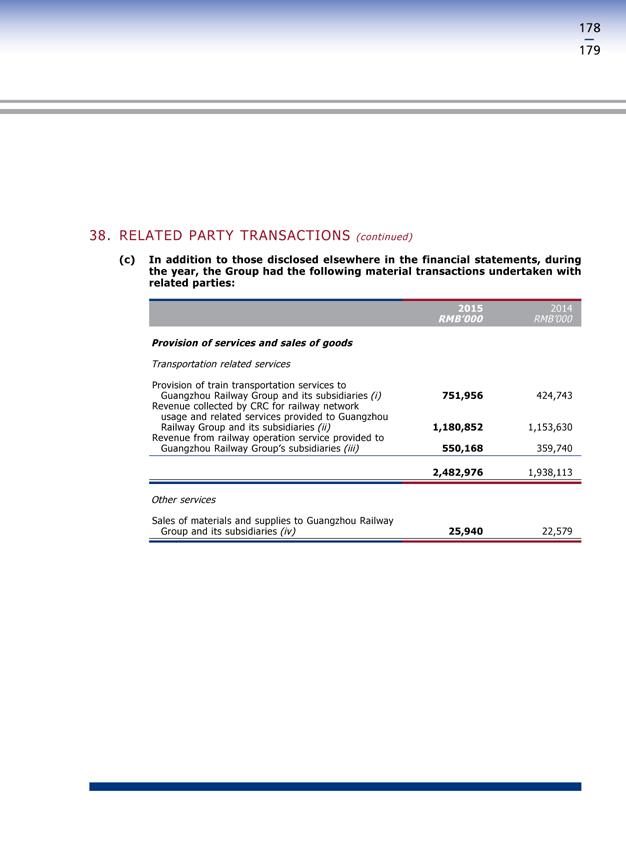
178
179
38. |
| RELATED PARTY TRANSACTIONS (continued) |
(c) the In addition year, the to Group those had disclosed the following elsewhere material in the transactions financial statements, undertaken during with related parties:
2015 2014
RMB’000 RMB’000
Provision of services and sales of goods
Transportation related services
Provision of train transportation services to
Guangzhou Railway Group and its subsidiaries (i) 751,956 424,743
Revenue collected by CRC for railway network
usage and related services provided to Guangzhou
Railway Group and its subsidiaries (ii) 1,180,852 1,153,630
Revenue from railway operation service provided to
Guangzhou Railway Group’s subsidiaries (iii) 550,168 359,740
2,482,976 1,938,113
Other services
Sales of materials and supplies to Guangzhou Railway
Group and its subsidiaries (iv) 25,940 22,579
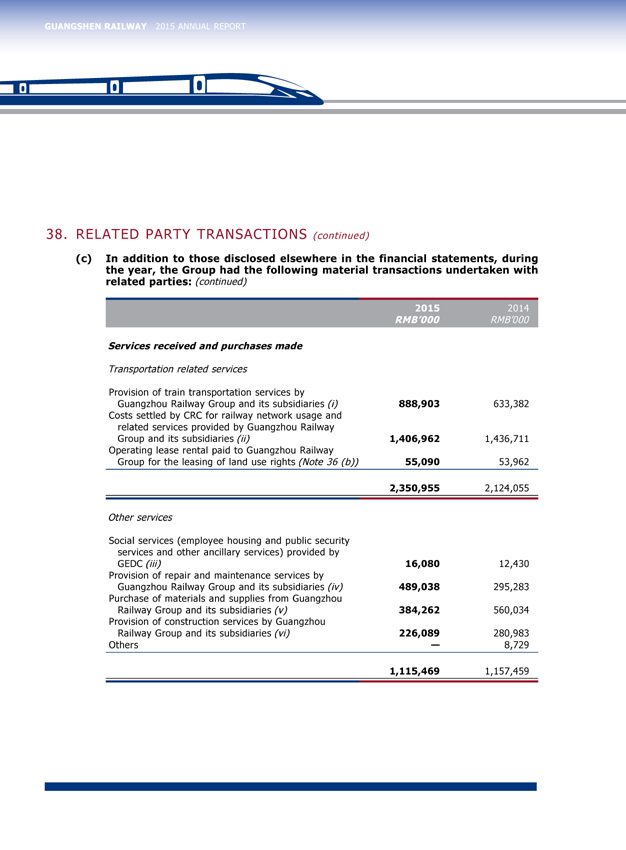
GUANGSHEN RAILWAY 2015 ANNUAL REPORT
38. |
| RELATED PARTY TRANSACTIONS (continued) |
(c) the In addition year, the to Group those had disclosed the following elsewhere material in the transactions financial statements, undertaken during with related parties: (continued)
2015 2014
RMB’000 RMB’000
Services received and purchases made
Transportation related services
Provision of train transportation services by
Guangzhou Railway Group and its subsidiaries (i) 888,903 633,382
Costs settled by CRC for railway network usage and
related services provided by Guangzhou Railway
Group and its subsidiaries (ii) 1,406,962 1,436,711
Operating lease rental paid to Guangzhou Railway
Group for the leasing of land use rights (Note 36 (b)) 55,090 53,962
2,350,955 2,124,055
Other services
Social services (employee housing and public security
services and other ancillary services) provided by
GEDC (iii) 16,080 12,430
Provision of repair and maintenance services by
Guangzhou Railway Group and its subsidiaries (iv) 489,038 295,283
Purchase of materials and supplies from Guangzhou
Railway Group and its subsidiaries (v) 384,262 560,034
Provision of construction services by Guangzhou
Railway Group and its subsidiaries (vi) 226,089 280,983
Others — 8,729
1,115,469 1,157,459
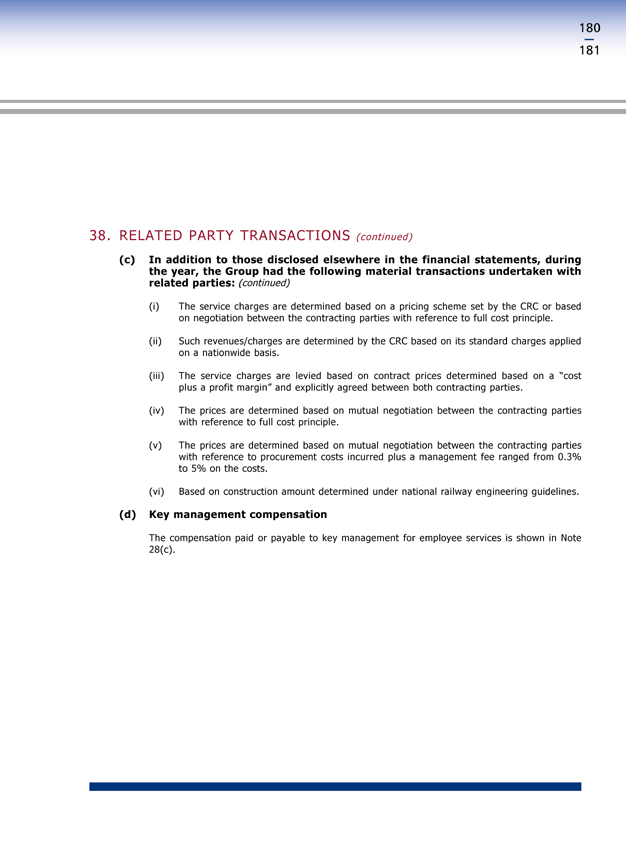
180
181
38. |
| RELATED PARTY TRANSACTIONS (continued) |
(c) the In addition year, the to Group those had disclosed the following elsewhere material in the transactions financial statements, undertaken during with related parties: (continued)
(i) The service charges are determined based on a pricing scheme set by the CRC or based on negotiation between the contracting parties with reference to full cost principle.
(ii) Such revenues/charges are determined by the CRC based on its standard charges applied on a nationwide basis.
(iii) The service charges are levied based on contract prices determined based on a “cost plus a profit margin” and explicitly agreed between both contracting parties.
(iv) The prices are determined based on mutual negotiation between the contracting parties with reference to full cost principle.
(v) The prices are determined based on mutual negotiation between the contracting parties with reference to procurement costs incurred plus a management fee ranged from 0.3% to 5% on the costs.
(vi) Based on construction amount determined under national railway engineering guidelines.
(d) |
| Key management compensation |
The compensation paid or payable to key management for employee services is shown in Note 28(c).
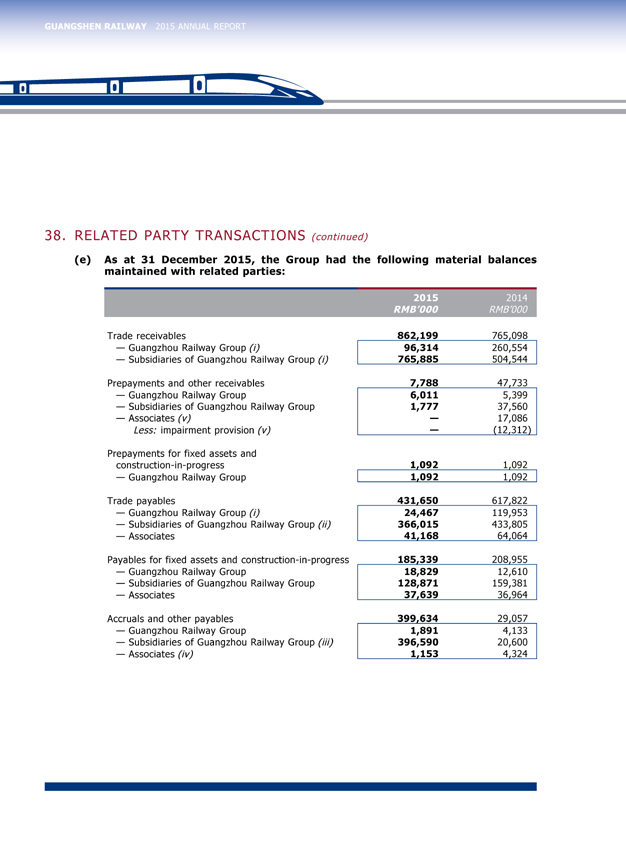
GUANGSHEN RAILWAY 2015 ANNUAL REPORT
38. |
| RELATED PARTY TRANSACTIONS (continued) |
(e) |
| As maintained at 31 December with related 2015, parties: the Group had the following material balances |
2015 2014
RMB’000 RMB’000
Trade receivables 862,199 765,098
— Guangzhou Railway Group (i) 96,314 260,554
— Subsidiaries of Guangzhou Railway Group (i) 765,885 504,544
Prepayments and other receivables 7,788 47,733
— Guangzhou Railway Group 6,011 5,399
— Subsidiaries of Guangzhou Railway Group 1,777 37,560
— Associates (v) — 17,086
Less: impairment provision (v) — (12,312)
Prepayments for fixed assets and
construction-in-progress 1,092 1,092
— Guangzhou Railway Group 1,092 1,092
Trade payables 431,650 617,822
— Guangzhou Railway Group (i) 24,467 119,953
— Subsidiaries of Guangzhou Railway Group (ii) 366,015 433,805
— Associates 41,168 64,064
Payables for fixed assets and construction-in-progress 185,339 208,955
— Guangzhou Railway Group 18,829 12,610
— Subsidiaries of Guangzhou Railway Group 128,871 159,381
— Associates 37,639 36,964
Accruals and other payables 399,634 29,057
— Guangzhou Railway Group 1,891 4,133
— Subsidiaries of Guangzhou Railway Group (iii) 396,590 20,600
— Associates (iv) 1,153 4,324
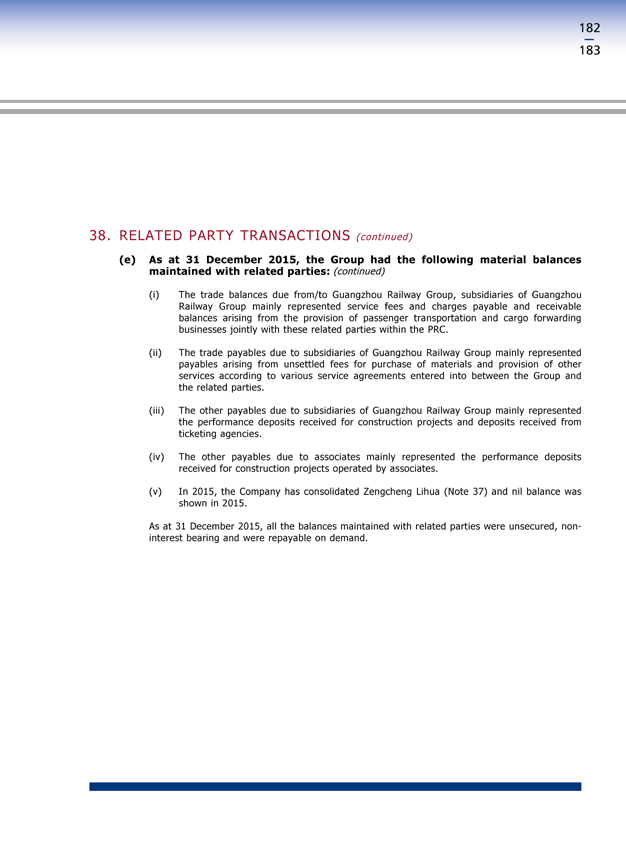
182
183
38. |
| RELATED PARTY TRANSACTIONS (continued) |
(e) |
| As at 31 December 2015, the Group had the following material balances maintained with related parties: (continued) |
(i) The trade balances due from/to Guangzhou Railway Group, subsidiaries of Guangzhou Railway Group mainly represented service fees and charges payable and receivable balances arising from the provision of passenger transportation and cargo forwarding businesses jointly with these related parties within the PRC.
(ii) The trade payables due to subsidiaries of Guangzhou Railway Group mainly represented payables arising from unsettled fees for purchase of materials and provision of other services according to various service agreements entered into between the Group and the related parties.
(iii) The other payables due to subsidiaries of Guangzhou Railway Group mainly represented the performance deposits received for construction projects and deposits received from ticketing agencies.
(iv) The other payables due to associates mainly represented the performance deposits received for construction projects operated by associates.
(v) |
| In 2015, the Company has consolidated Zengcheng Lihua (Note 37) and nil balance was shown in 2015. |
As at 31 December 2015, all the balances maintained with related parties were unsecured, non-interest bearing and were repayable on demand.
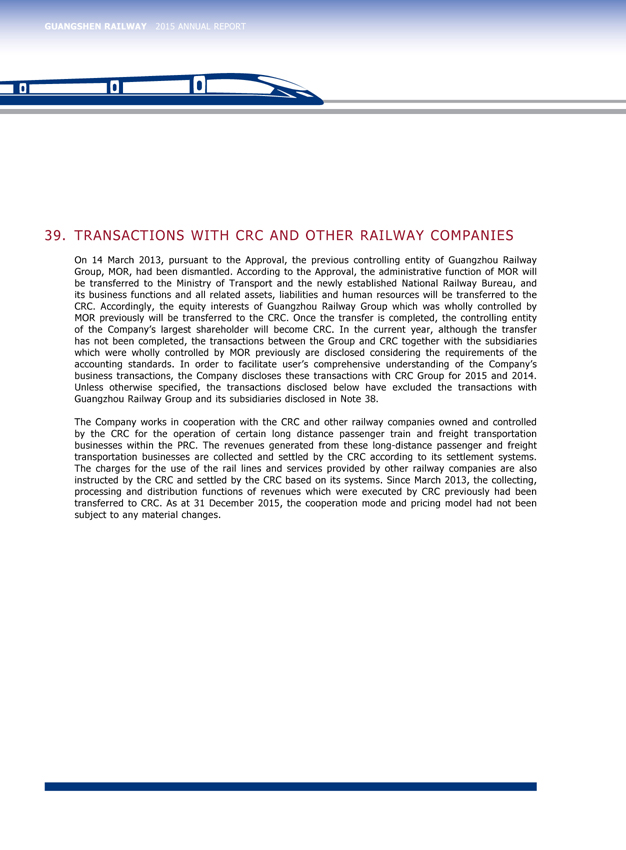
GUANGSHEN RAILWAY 2015 ANNUAL REPORT
39. |
| TRANSACTIONS WITH CRC AND OTHER RAILWAY COMPANIES |
On 14 March 2013, pursuant to the Approval, the previous controlling entity of Guangzhou Railway Group, MOR, had been dismantled. According to the Approval, the administrative function of MOR will be transferred to the Ministry of Transport and the newly established National Railway Bureau, and its business functions and all related assets, liabilities and human resources will be transferred to the CRC. Accordingly, the equity interests of Guangzhou Railway Group which was wholly controlled by MOR previously will be transferred to the CRC. Once the transfer is completed, the controlling entity of the Company’s largest shareholder will become CRC. In the current year, although the transfer has not been completed, the transactions between the Group and CRC together with the subsidiaries which were wholly controlled by MOR previously are disclosed considering the requirements of the accounting standards. In order to facilitate user’s comprehensive understanding of the Company’s business transactions, the Company discloses these transactions with CRC Group for 2015 and 2014. Unless otherwise specified, the transactions disclosed below have excluded the transactions with Guangzhou Railway Group and its subsidiaries disclosed in Note 38.
The Company works in cooperation with the CRC and other railway companies owned and controlled by the CRC for the operation of certain long distance passenger train and freight transportation businesses within the PRC. The revenues generated from these long-distance passenger and freight transportation businesses are collected and settled by the CRC according to its settlement systems. The charges for the use of the rail lines and services provided by other railway companies are also instructed by the CRC and settled by the CRC based on its systems. Since March 2013, the collecting, processing and distribution functions of revenues which were executed by CRC previously had been transferred to CRC. As at 31 December 2015, the cooperation mode and pricing model had not been subject to any material changes.
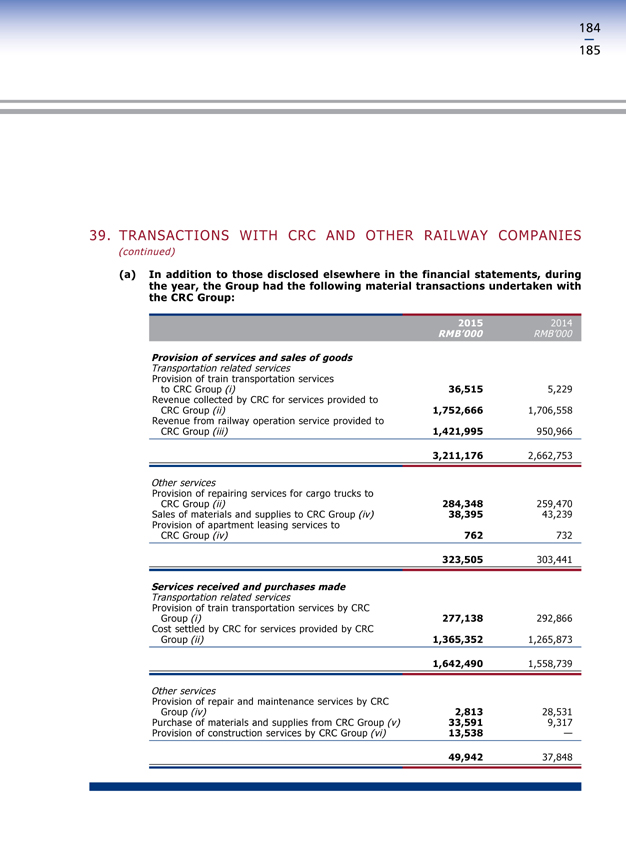
184
185
39. |
| TRANSACTIONS WITH CRC AND OTHER RAILWAY COMPANIES |
(continued)
(a) the In addition year, the to Group those had disclosed the following elsewhere material in the transactions financial statements, undertaken during with the CRC Group:
2015 2014
RMB’000 RMB’000
Provision of services and sales of goods
Transportation related services
Provision of train transportation services
to CRC Group (i) 36,515 5,229
Revenue collected by CRC for services provided to
CRC Group (ii) 1,752,666 1,706,558
Revenue from railway operation service provided to
CRC Group (iii) 1,421,995 950,966
3,211,176 2,662,753
Other services
Provision of repairing services for cargo trucks to
CRC Group (ii) 284,348 259,470
Sales of materials and supplies to CRC Group (iv) 38,395 43,239
Provision of apartment leasing services to
CRC Group (iv) 762 732
323,505 303,441
Services received and purchases made
Transportation related services
Provision of train transportation services by CRC
Group (i) 277,138 292,866
Cost settled by CRC for services provided by CRC
Group (ii) 1,365,352 1,265,873
1,642,490 1,558,739
Other services
Provision of repair and maintenance services by CRC
Group (iv) 2,813 28,531
Purchase of materials and supplies from CRC Group (v) 33,591 9,317
Provision of construction services by CRC Group (vi) 13,538 —
49,942 37,848
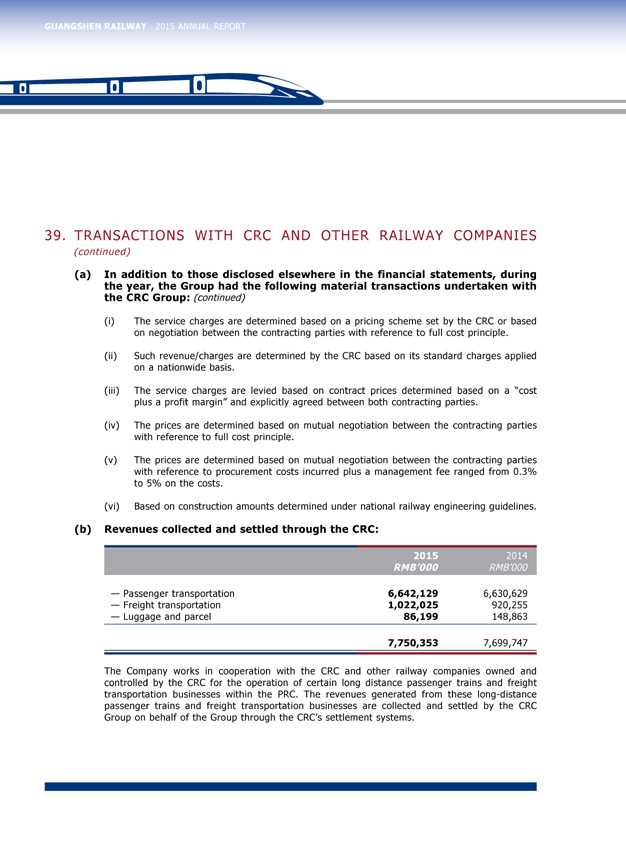
GUANGSHEN RAILWAY 2015 ANNUAL REPORT
39. |
| TRANSACTIONS WITH CRC AND OTHER RAILWAY COMPANIES |
(continued)
(a) the In addition year, the to Group those had disclosed the following elsewhere material in the transactions financial statements, undertaken during with the CRC Group: (continued)
(i) The service charges are determined based on a pricing scheme set by the CRC or based on negotiation between the contracting parties with reference to full cost principle.
(ii) Such revenue/charges are determined by the CRC based on its standard charges applied on a nationwide basis.
(iii) The service charges are levied based on contract prices determined based on a “cost plus a profit margin” and explicitly agreed between both contracting parties.
(iv) The prices are determined based on mutual negotiation between the contracting parties with reference to full cost principle.
(v) The prices are determined based on mutual negotiation between the contracting parties with reference to procurement costs incurred plus a management fee ranged from 0.3% to 5% on the costs.
(vi) Based on construction amounts determined under national railway engineering guidelines.
(b) |
| Revenues collected and settled through the CRC: |
2015 2014
RMB’000 RMB’000
— Passenger transportation 6,642,129 6,630,629
— Freight transportation 1,022,025 920,255
— Luggage and parcel 86,199 148,863
7,750,353 7,699,747
The Company works in cooperation with the CRC and other railway companies owned and controlled by the CRC for the operation of certain long distance passenger trains and freight transportation businesses within the PRC. The revenues generated from these long-distance passenger trains and freight transportation businesses are collected and settled by the CRC Group on behalf of the Group through the CRC’s settlement systems.
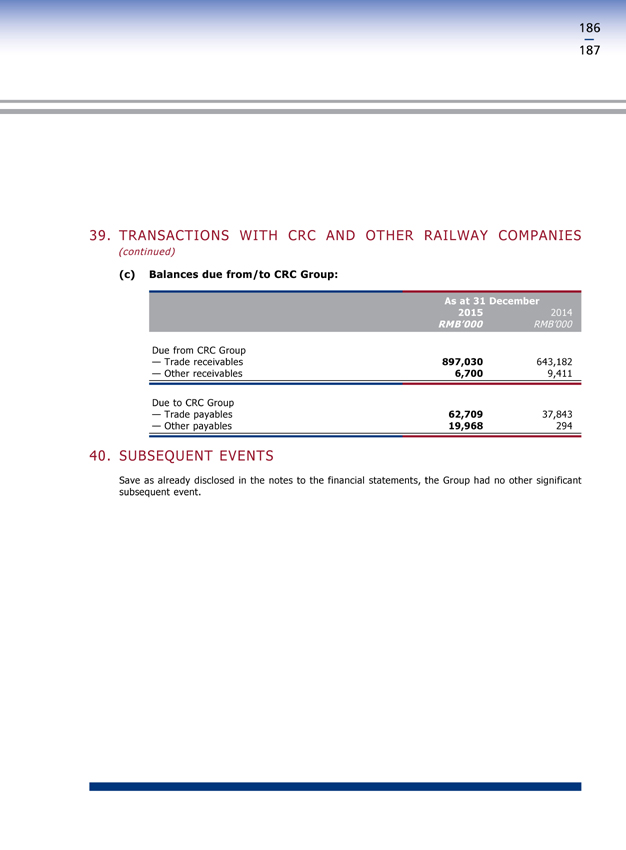
186
187
39. |
| TRANSACTIONS WITH CRC AND OTHER RAILWAY COMPANIES |
(continued)
(c) |
| Balances due from/to CRC Group: |
As at 31 December
2015 2014
RMB’000 RMB’000
Due from CRC Group
— Trade receivables 897,030 643,182
— Other receivables 6,700 9,411
Due to CRC Group
— Trade payables 62,709 37,843
— Other payables 19,968 294
40. |
| SUBSEQUENT EVENTS |
Save as already disclosed in the notes to the financial statements, the Group had no other significant subsequent event.
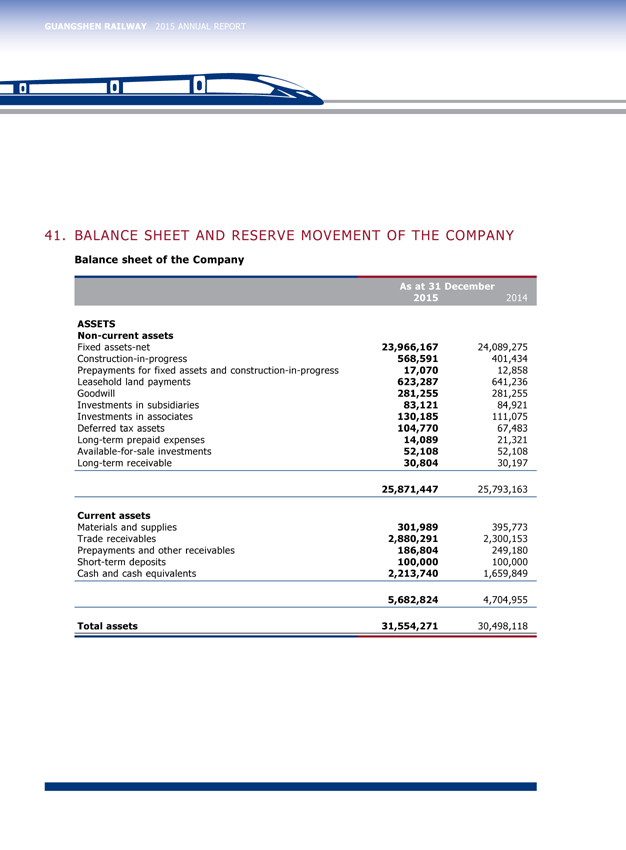
GUANGSHEN RAILWAY 2015 ANNUAL REPORT
41. |
| BALANCE SHEET AND RESERVE MOVEMENT OF THE COMPANY |
Balance sheet of the Company
As at 31 December
2015 2014
ASSETS
Non-current assets
Fixed assets-net 23,966,167 24,089,275
Construction-in-progress 568,591 401,434
Prepayments for fixed assets and construction-in-progress 17,070 12,858
Leasehold land payments 623,287 641,236
Goodwill 281,255 281,255
Investments in subsidiaries 83,121 84,921
Investments in associates 130,185 111,075
Deferred tax assets 104,770 67,483
Long-term prepaid expenses 14,089 21,321
Available-for-sale investments 52,108 52,108
Long-term receivable 30,804 30,197
25,871,447 25,793,163
Current assets
Materials and supplies 301,989 395,773
Trade receivables 2,880,291 2,300,153
Prepayments and other receivables 186,804 249,180
Short-term deposits 100,000 100,000
Cash and cash equivalents 2,213,740 1,659,849
5,682,824 4,704,955
Total assets 31,554,271 30,498,118
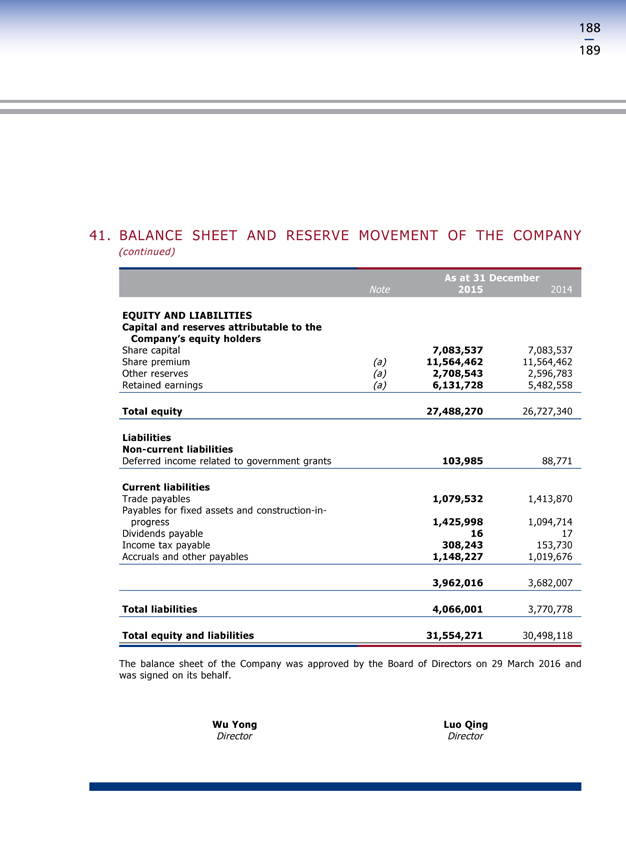
188
189
41. |
| BALANCE SHEET AND RESERVE MOVEMENT OF THE COMPANY |
(continued)
As at 31 December
Note 2015 2014
EQUITY AND LIABILITIES
Capital and reserves attributable to the
Company’s equity holders
Share capital 7,083,537 7,083,537
Share premium (a) 11,564,462 11,564,462
Other reserves (a) 2,708,543 2,596,783
Retained earnings (a) 6,131,728 5,482,558
Total equity 27,488,270 26,727,340
Liabilities
Non-current liabilities
Deferred income related to government grants 103,985 88,771
Current liabilities
Trade payables 1,079,532 1,413,870
Payables for fixed assets and construction-in-
progress 1,425,998 1,094,714
Dividends payable 16 17
Income tax payable 308,243 153,730
Accruals and other payables 1,148,227 1,019,676
3,962,016 3,682,007
Total liabilities 4,066,001 3,770,778
Total equity and liabilities 31,554,271 30,498,118
The balance sheet of the Company was approved by the Board of Directors on 29 March 2016 and was signed on its behalf.
Wu Yong Luo Qing
Director Director
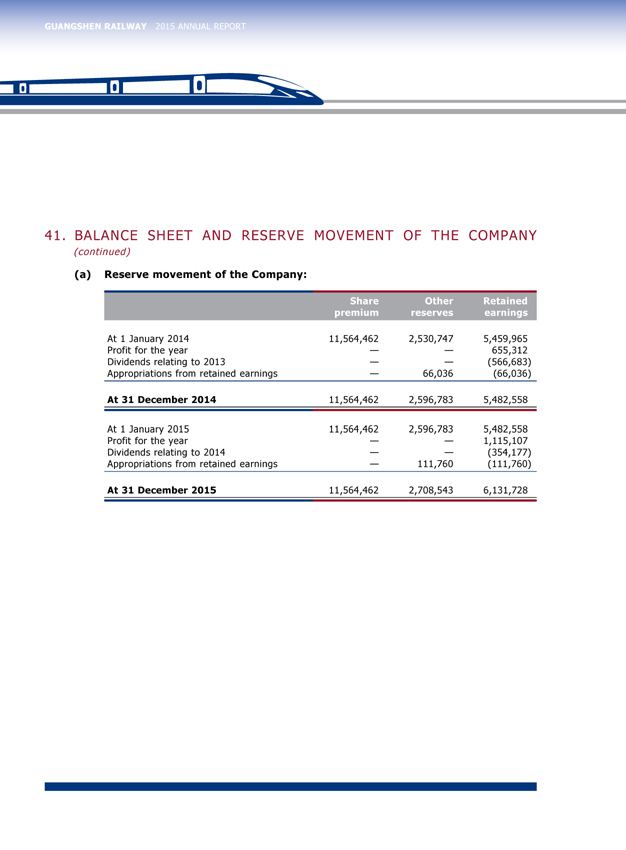
GUANGSHEN RAILWAY 2015 ANNUAL REPORT
41. |
| BALANCE SHEET AND RESERVE MOVEMENT OF THE COMPANY |
(continued)
(a) |
| Reserve movement of the Company: |
Share Other Retained
premium reserves earnings
At 1 January 2014 11,564,462 2,530,747 5,459,965
Profit for the year — — 655,312
Dividends relating to 2013 — — (566,683)
Appropriations from retained earnings — 66,036 (66,036)
At 31 December 2014 11,564,462 2,596,783 5,482,558
At 1 January 2015 11,564,462 2,596,783 5,482,558
Profit for the year — — 1,115,107
Dividends relating to 2014 — — (354,177)
Appropriations from retained earnings — 111,760 (111,760)
At 31 December 2015 11,564,462 2,708,543 6,131,728
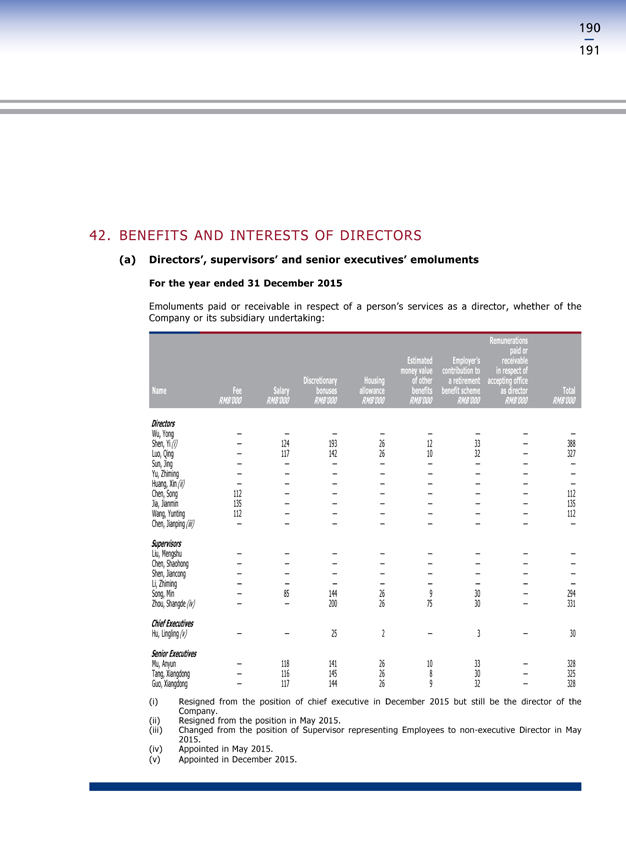
190
191
42. |
| BENEFITS AND INTERESTS OF DIRECTORS |
(a) |
| Directors’, supervisors’ and senior executives’ emoluments |
For the year ended 31 December 2015
Emoluments paid or receivable in respect of a person’s services as a director, whether of the Company or its subsidiary undertaking:
Remunerations
paid or
Estimated Employer’s receivable
money value contribution to in respect of
Discretionary Housing of other a retirement accepting office
Name Fee Salary bonuses allowance benefits benefit scheme as director Total
RMB’000 RMB’000 RMB’000 RMB’000 RMB’000 RMB’000 RMB’000 RMB’000
Directors
Wu, Yong — — — — — — — —
Shen, Yi (i) — 124 193 26 12 33 — 388
Luo, Qing — 117 142 26 10 32 — 327
Sun, Jing — — — — — — — —
Yu, Zhiming — — — — — — — —
Huang, Xin (ii) — — — — — — — —
Chen, Song 112 — — — — — — 112
Jia, Jianmin 135 — — — — — — 135
Wang, Yunting 112 — — — — — — 112
Chen, Jianping (iii) — — — — — — — —
Supervisors
Liu, Mengshu — — — — — — — —
Chen, Shaohong — — — — — — — —
Shen, Jiancong — — — — — — — —
Li, Zhiming — — — — — — — —
Song, Min — 85 144 26 9 30 — 294
Zhou, Shangde (iv) — — 200 26 75 30 — 331
Chief Executives
Hu, Lingling (v) — — 25 2 — 3 — 30
Senior Executives
Mu, Anyun — 118 141 26 10 33 — 328
Tang, Xiangdong — 116 145 26 8 30 — 325
Guo, Xiangdong — 117 144 26 9 32 — 328
(i) |
| Resigned from the position of chief executive in December 2015 but still be the director of the Company. |
(ii) Resigned from the position in May 2015.
(iii) Changed from the position of Supervisor representing Employees to non-executive Director in May 2015.
(iv) Appointed in May 2015. (v) Appointed in December 2015.
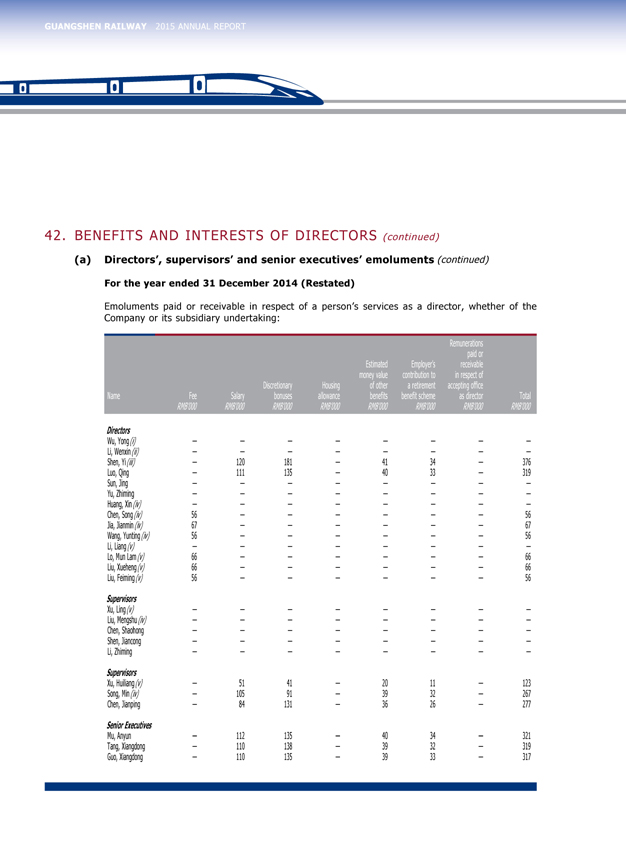
GUANGSHEN RAILWAY 2015 ANNUAL REPORT
42. |
| BENEFITS AND INTERESTS OF DIRECTORS (continued) |
(a) |
| Directors’, supervisors’ and senior executives’ emoluments (continued) |
For the year ended 31 December 2014 (Restated)
Emoluments paid or receivable in respect of a person’s services as a director, whether of the Company or its subsidiary undertaking:
Remunerations
paid or
Estimated Employer’s receivable
money value contribution to in respect of
Discretionary Housing of other a retirement accepting office
Name Fee Salary bonuses allowance benefits benefit scheme as director Total
RMB’000 RMB’000 RMB’000 RMB’000 RMB’000 RMB’000 RMB’000 RMB’000
Directors
Wu, Yong (i) — — — — — — — —
Li, Wenxin (ii) — — — — — — — —
Shen, Yi (iii) — 120 181 — 41 34 — 376
Luo, Qing — 111 135 — 40 33 — 319
Sun, Jing — — — — — — — —
Yu, Zhiming — — — — — — — —
Huang, Xin (iv) — — — — — — — —
Chen, Song (iv) 56 — — — — — — 56
Jia, Jianmin (iv) 67 — — — — — — 67
Wang, Yunting (iv) 56 — — — — — — 56
Li, Liang (v) — — — — — — — —
Lo, Mun Lam (v) 66 — — — — — — 66
Liu, Xueheng (v) 66 — — — — — — 66
Liu, Feiming (v) 56 — — — — — — 56
Supervisors
Xu, Ling (v) — — — — — — — —
Liu, Mengshu (iv) — — — — — — — —
Chen, Shaohong — — — — — — — —
Shen, Jiancong — — — — — — — —
Li, Zhiming — — — — — — — —
Supervisors
Xu, Huiliang (v) — 51 41 — 20 11 — 123
Song, Min (iv) — 105 91 — 39 32 — 267
Chen, Jianping — 84 131 — 36 26 — 277
Senior Executives
Mu, Anyun — 112 135 — 40 34 — 321
Tang, Xiangdong — 110 138 — 39 32 — 319
Guo, Xiangdong — 110 135 — 39 33 — 317
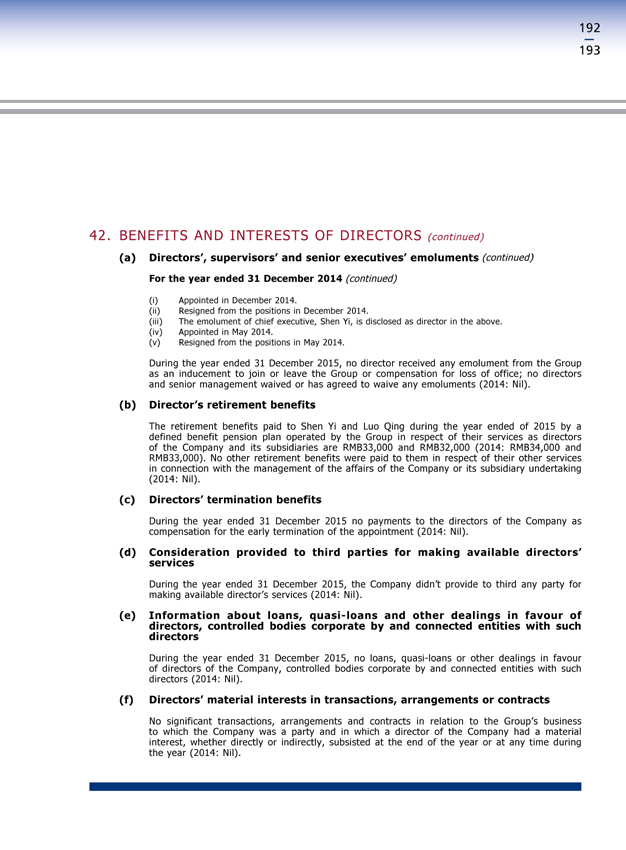
192
193
42. |
| BENEFITS AND INTERESTS OF DIRECTORS (continued) |
(a) |
| Directors’, supervisors’ and senior executives’ emoluments (continued) |
For the year ended 31 December 2014 (continued)
(i) |
| Appointed in December 2014. |
(ii) Resigned from the positions in December 2014.
(iii) The emolument of chief executive, Shen Yi, is disclosed as director in the above. (iv) Appointed in May 2014.
(v) |
| Resigned from the positions in May 2014. |
During the year ended 31 December 2015, no director received any emolument from the Group as an inducement to join or leave the Group or compensation for loss of office; no directors and senior management waived or has agreed to waive any emoluments (2014: Nil).
(b) |
| Director’s retirement benefits |
The retirement benefits paid to Shen Yi and Luo Qing during the year ended of 2015 by a defined benefit pension plan operated by the Group in respect of their services as directors of the Company and its subsidiaries are RMB33,000 and RMB32,000 (2014: RMB34,000 and RMB33,000). No other retirement benefits were paid to them in respect of their other services in connection with the management of the affairs of the Company or its subsidiary undertaking (2014: Nil).
(c) |
| Directors’ termination benefits |
During the year ended 31 December 2015 no payments to the directors of the Company as compensation for the early termination of the appointment (2014: Nil).
(d) |
| Consideration provided to third parties for making available directors’ services |
During the year ended 31 December 2015, the Company didn’t provide to third any party for making available director’s services (2014: Nil).
(e) Information about loans, quasi-loans and other dealings in favour of directors, controlled bodies corporate by and connected entities with such directors
During the year ended 31 December 2015, no loans, quasi-loans or other dealings in favour of directors of the Company, controlled bodies corporate by and connected entities with such directors (2014: Nil).
(f) |
| Directors’ material interests in transactions, arrangements or contracts |
No significant transactions, arrangements and contracts in relation to the Group’s business to which the Company was a party and in which a director of the Company had a material interest, whether directly or indirectly, subsisted at the end of the year or at any time during the year (2014: Nil).
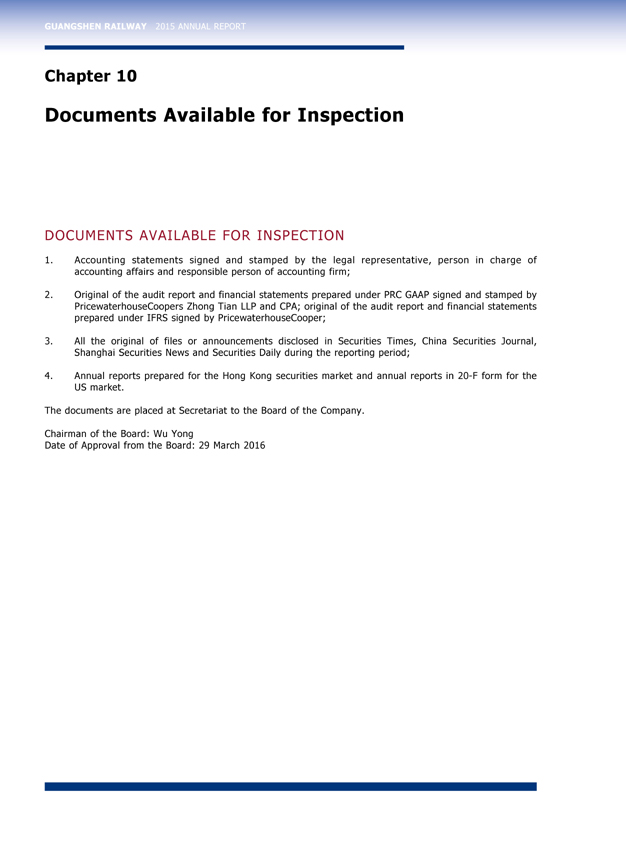
GUANGSHEN RAILWAY 2015 ANNUAL REPORT
Chapter 10
Documents Available for Inspection
DOCUMENTS AVAILABLE FOR INSPECTION
1. Accounting statements signed and stamped by the legal representative, person in charge of accounting affairs and responsible person of accounting firm;
2. Original of the audit report and financial statements prepared under PRC GAAP signed and stamped by PricewaterhouseCoopers Zhong Tian LLP and CPA; original of the audit report and financial statements prepared under IFRS signed by PricewaterhouseCooper;
3. All the original of files or announcements disclosed in Securities Times, China Securities Journal, Shanghai Securities News and Securities Daily during the reporting period;
4. Annual reports prepared for the Hong Kong securities market and annual reports in 20-F form for the US market.
The documents are placed at Secretariat to the Board of the Company.
Chairman of the Board: Wu Yong
Date of Approval from the Board: 29 March 2016